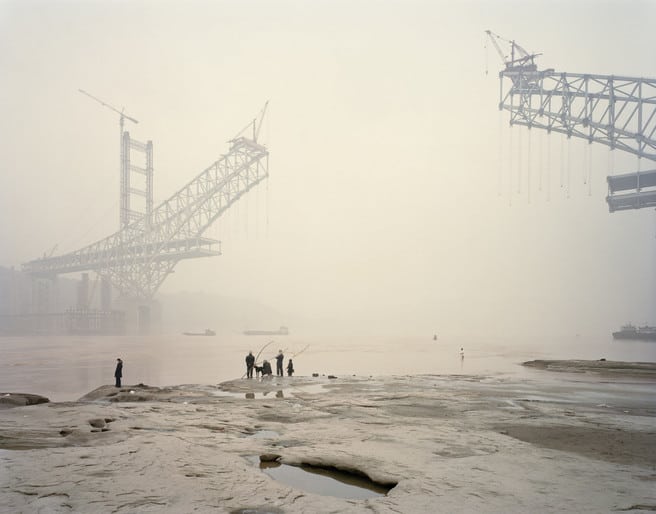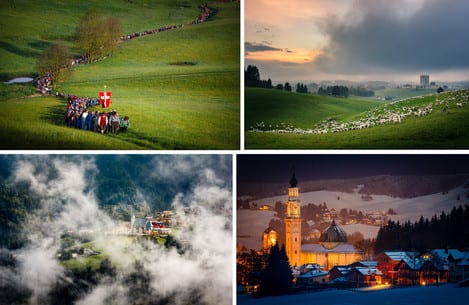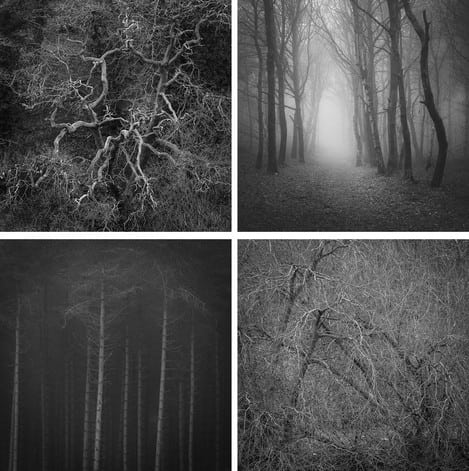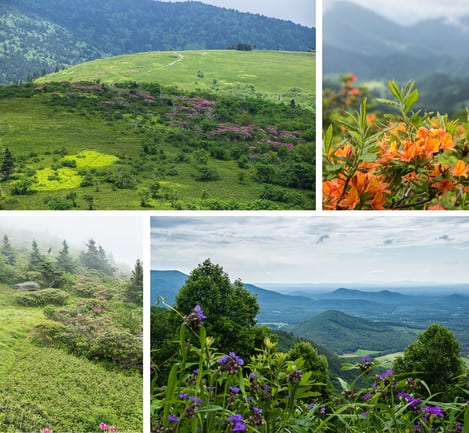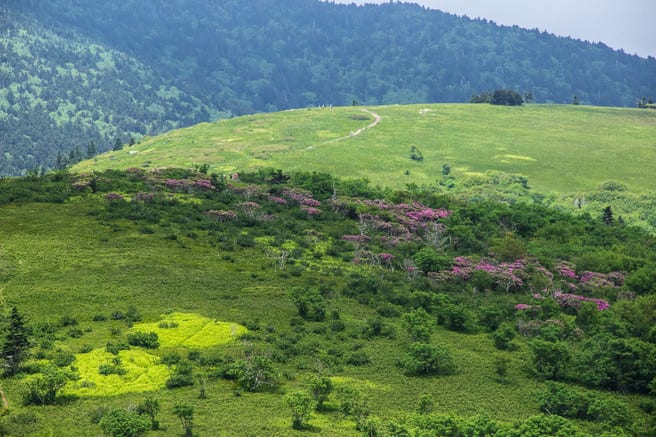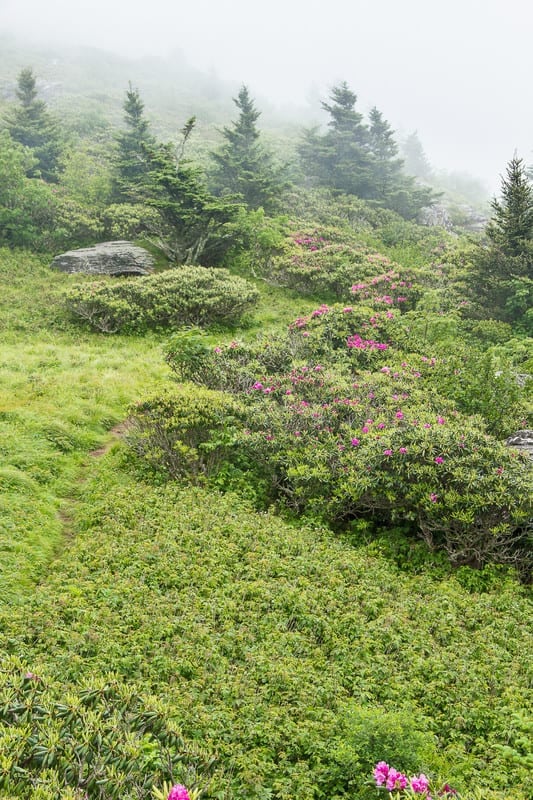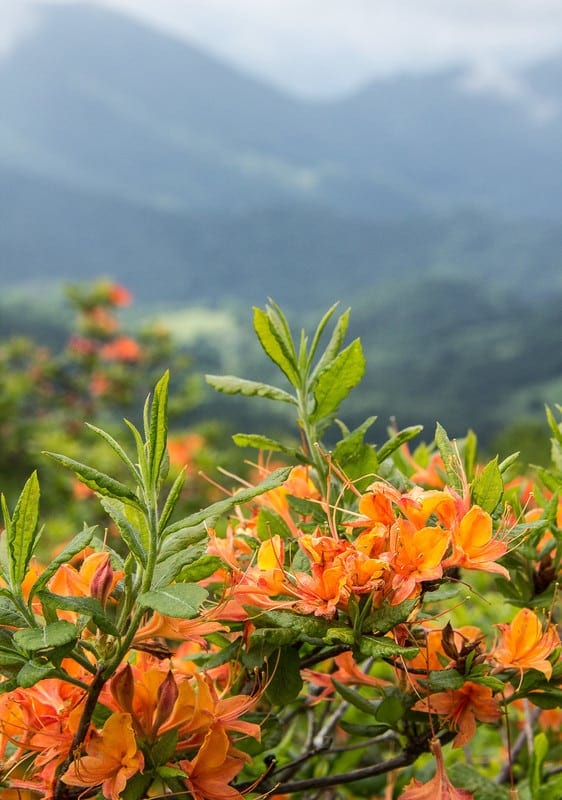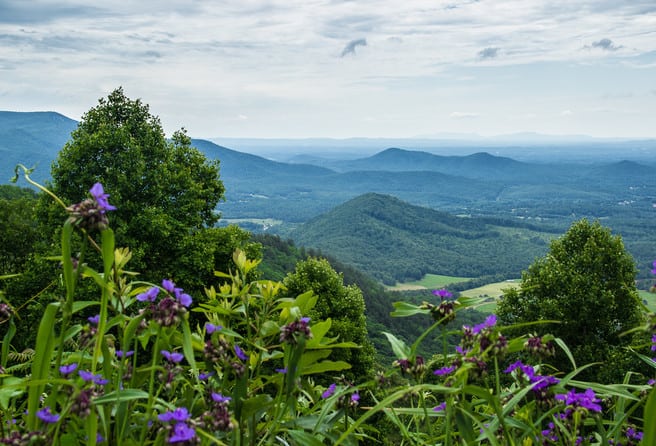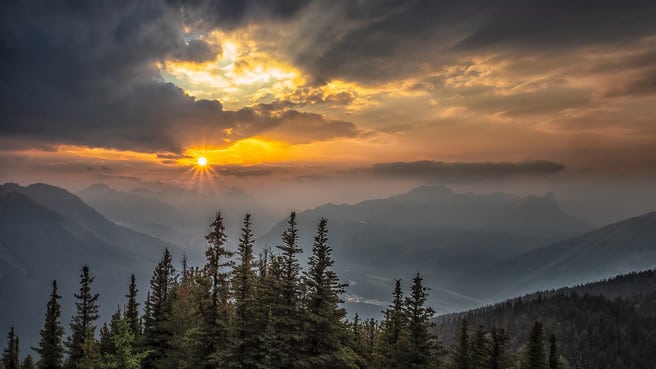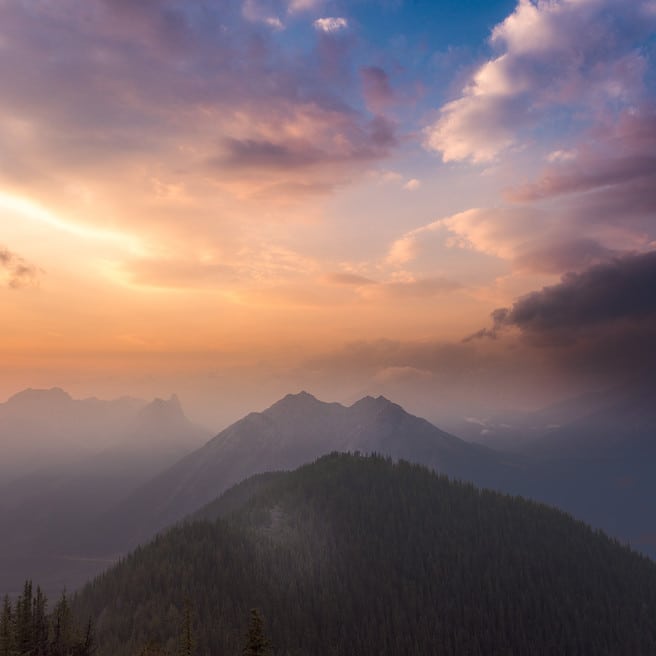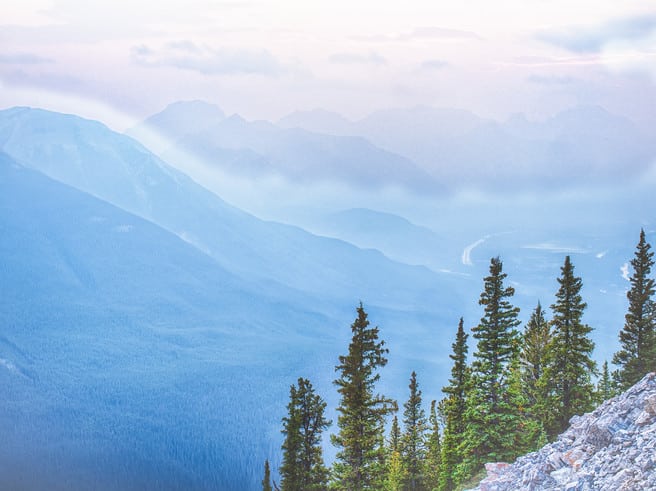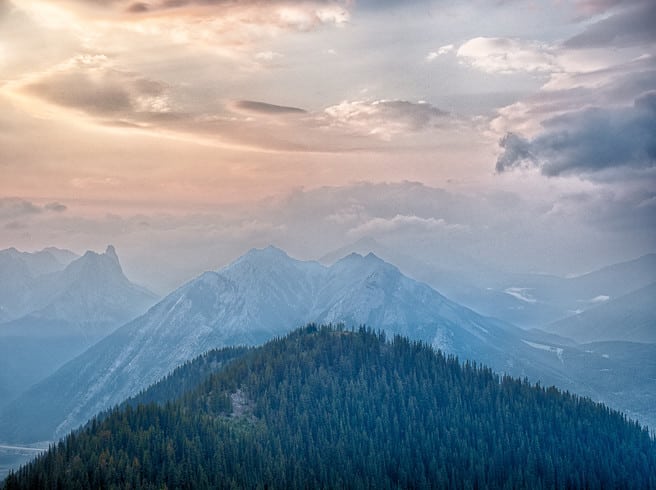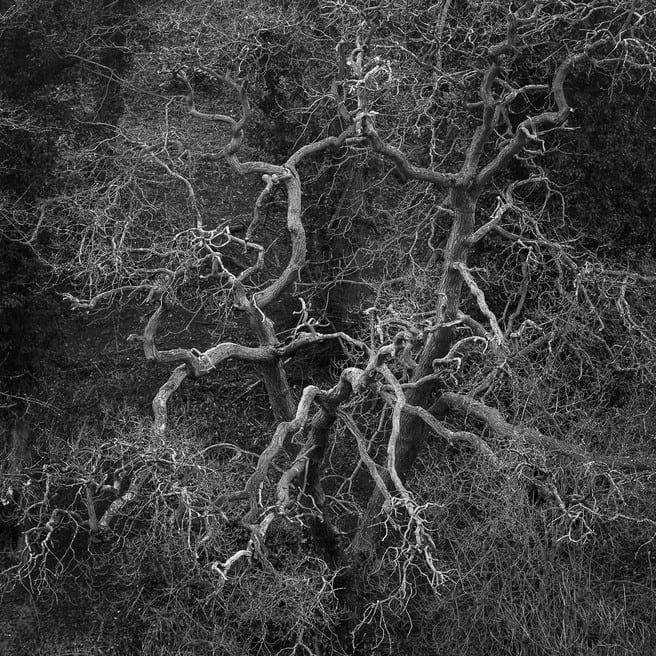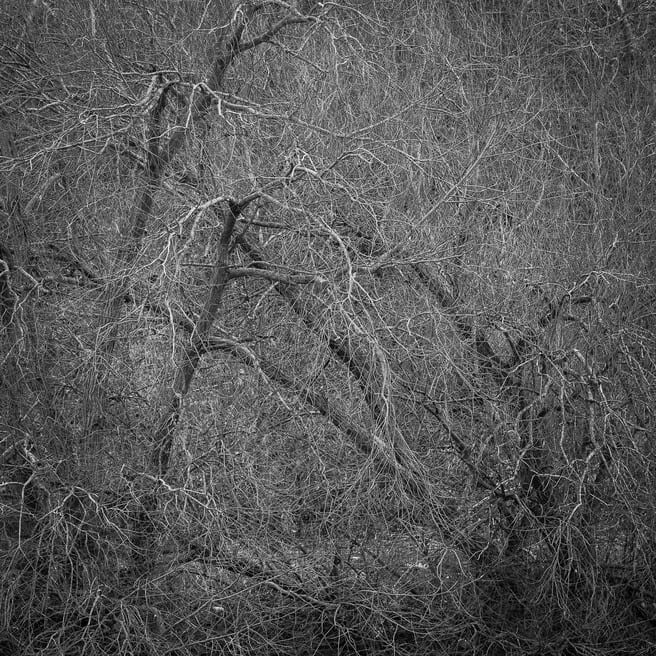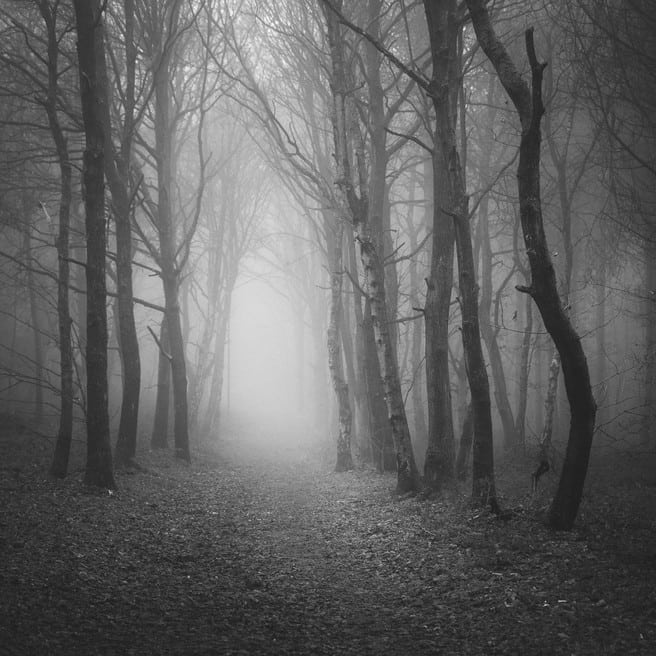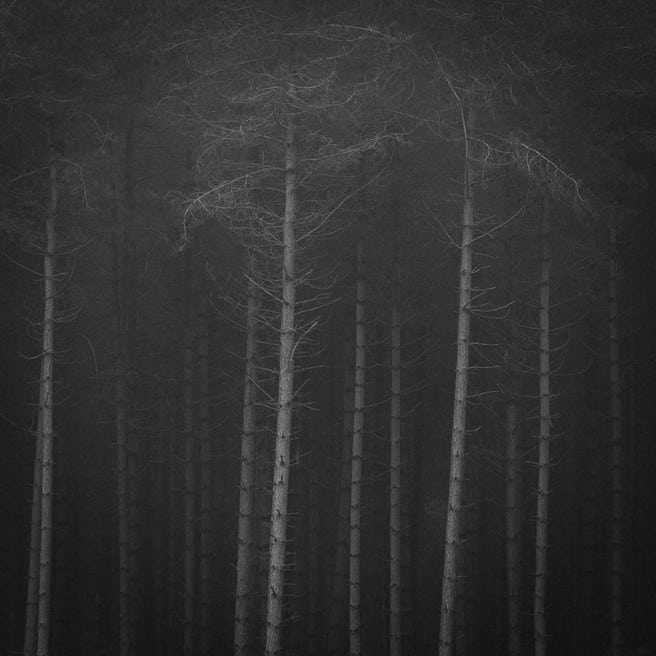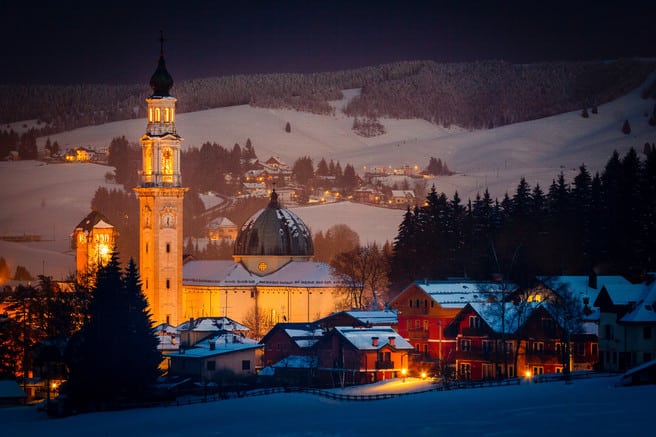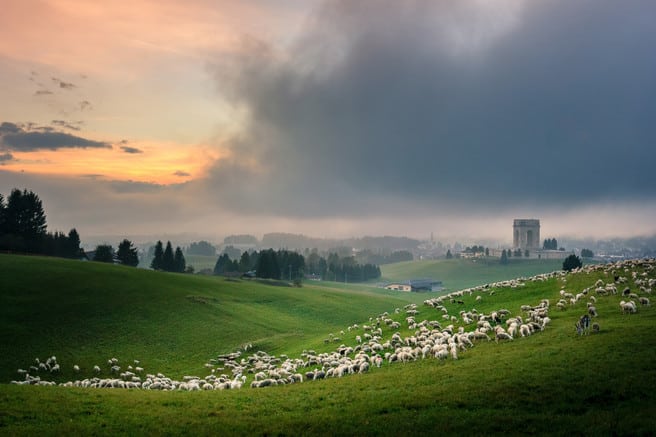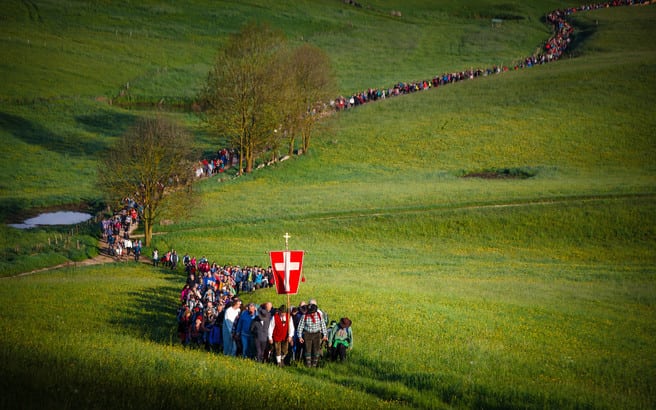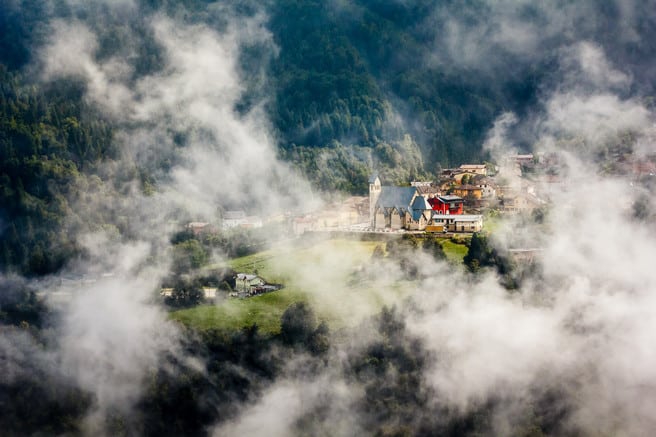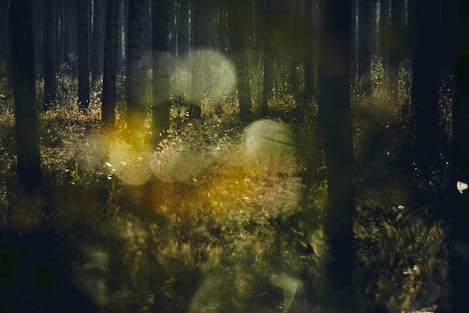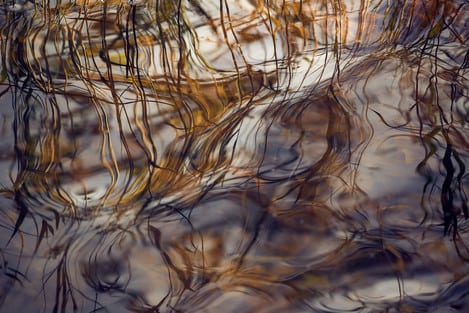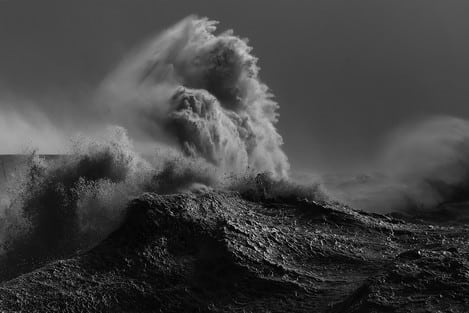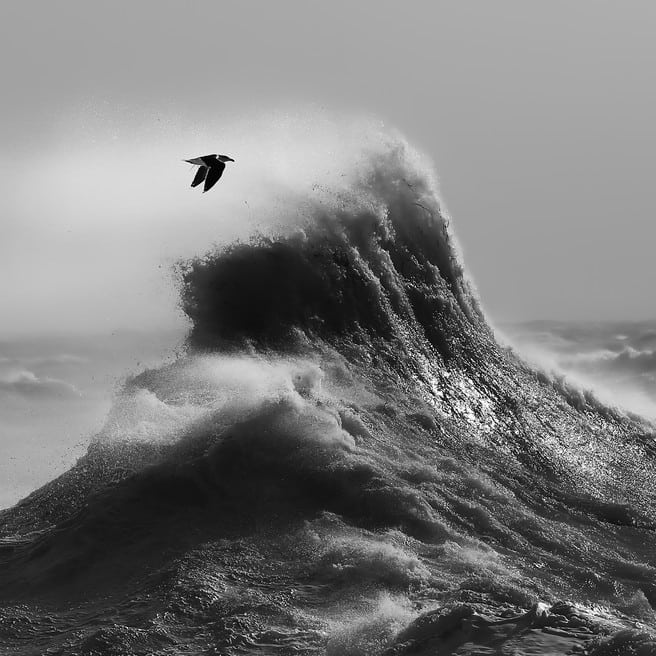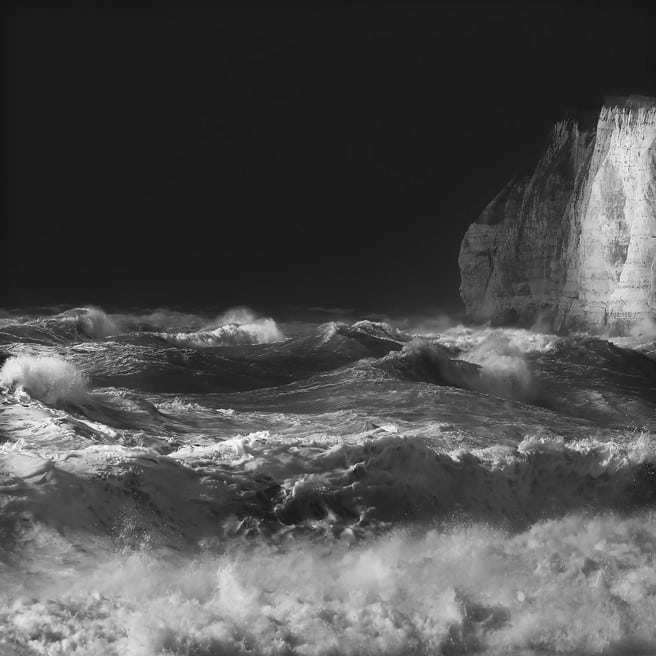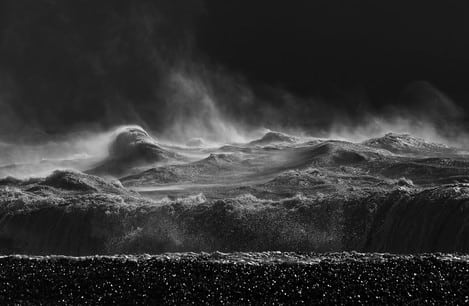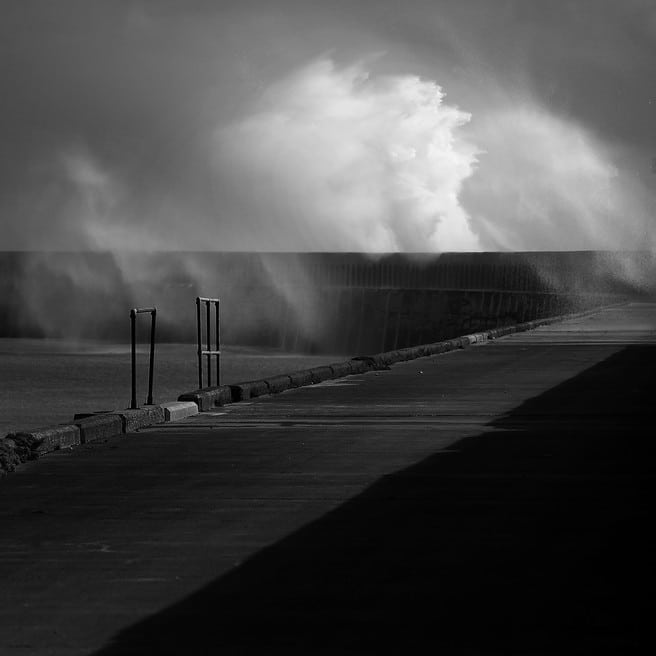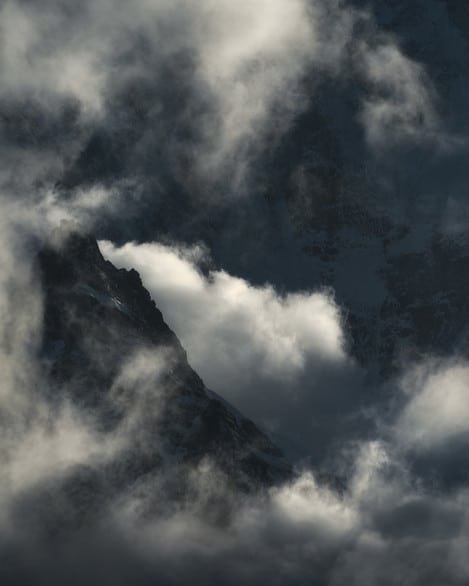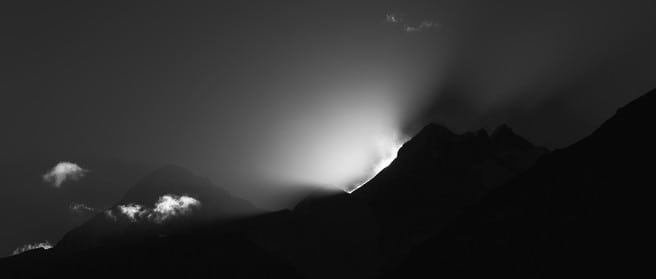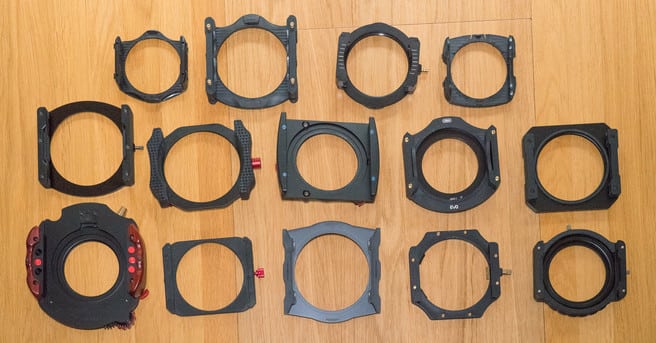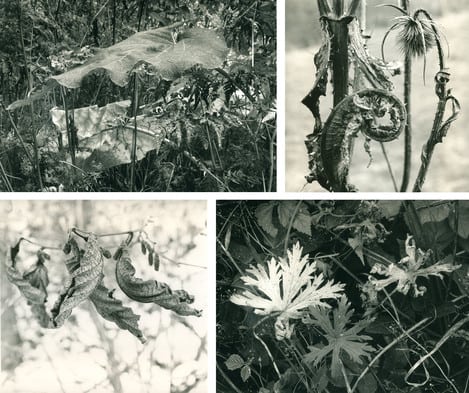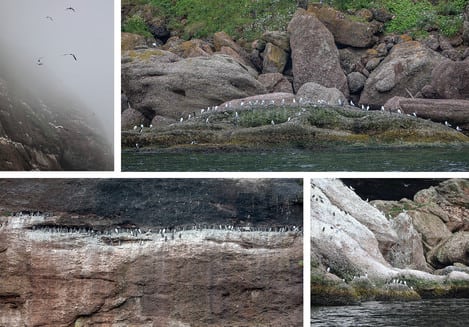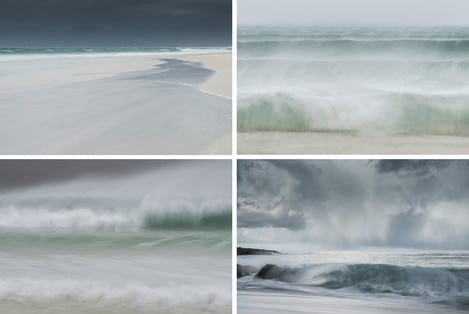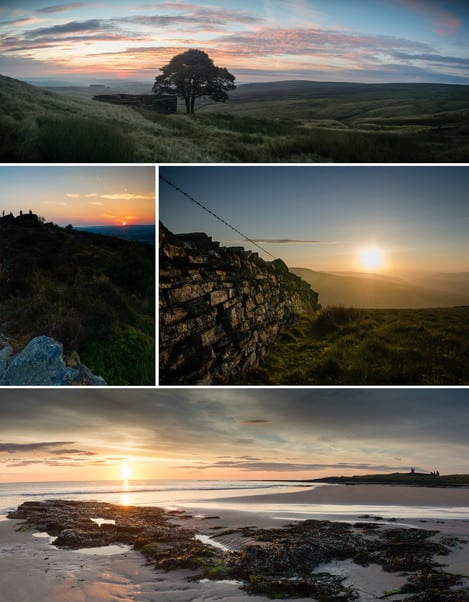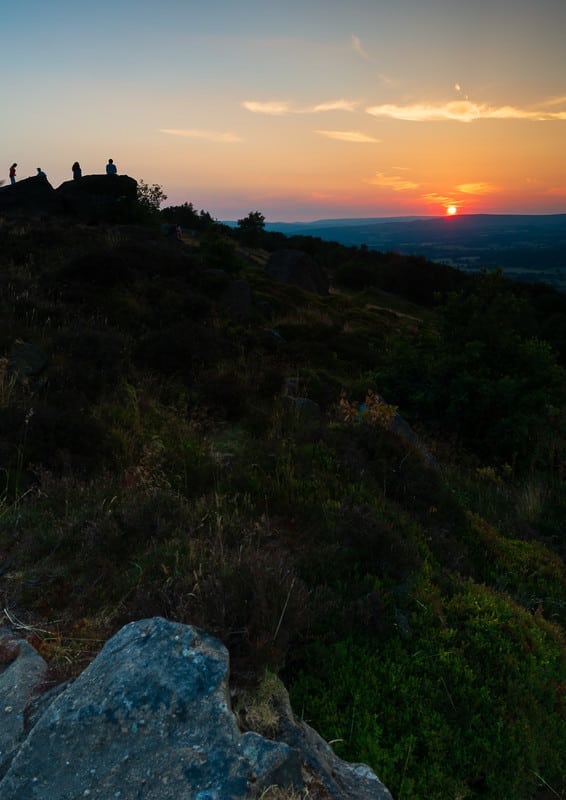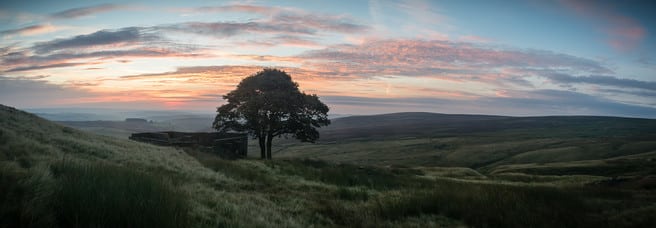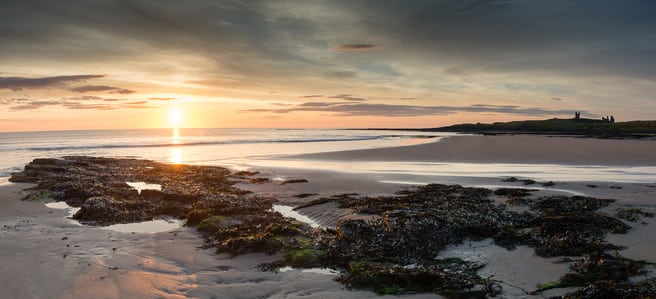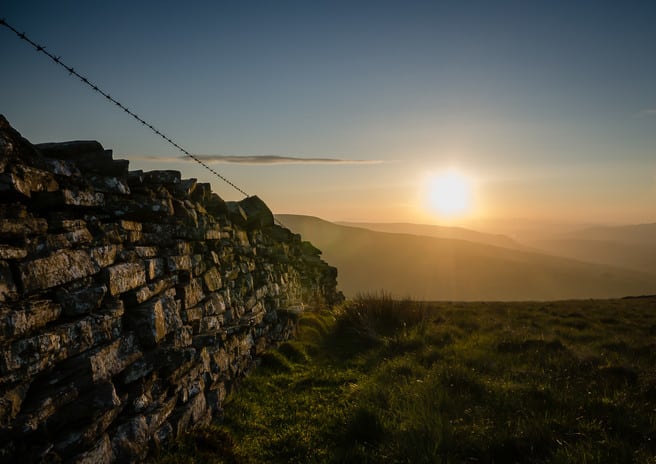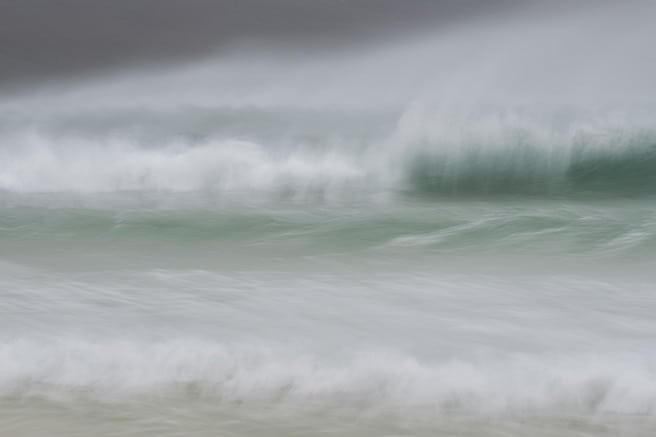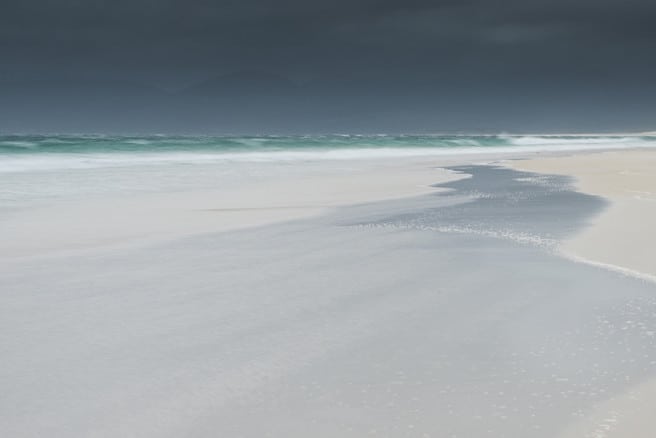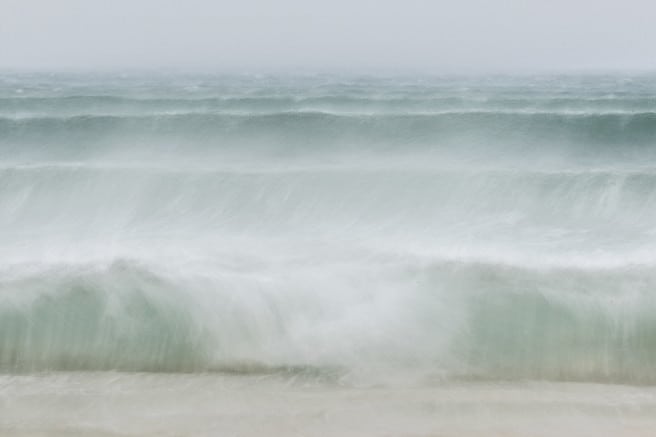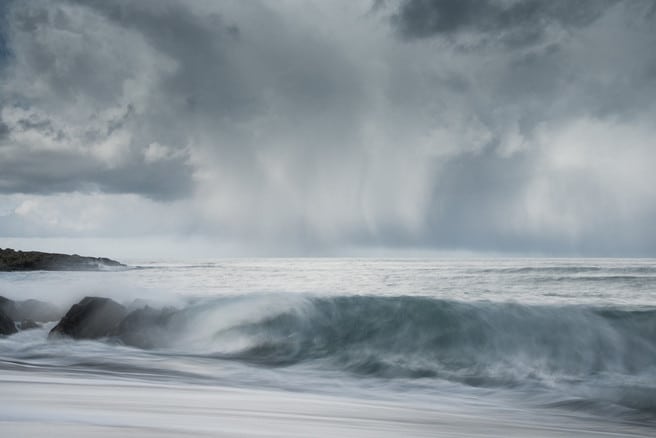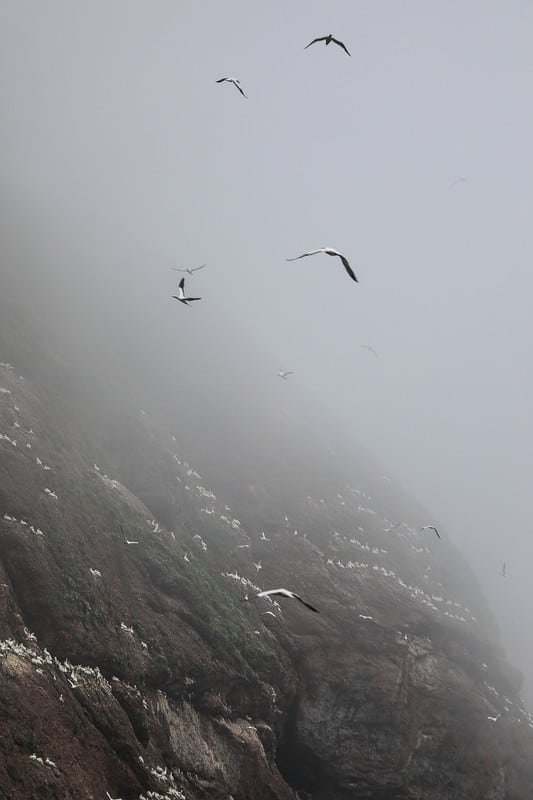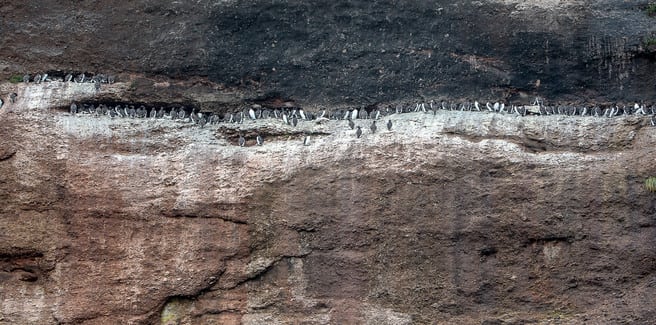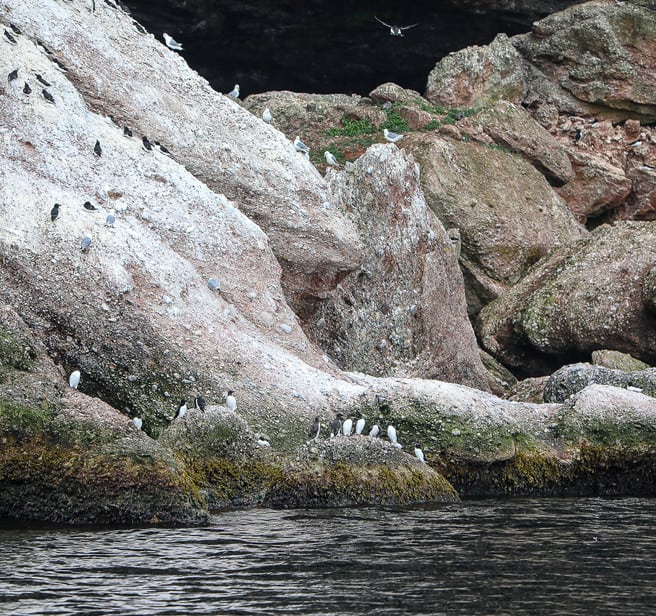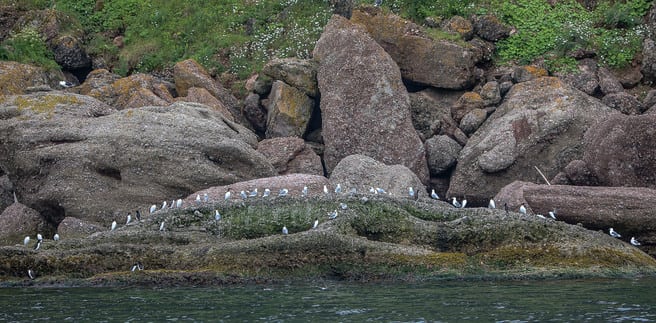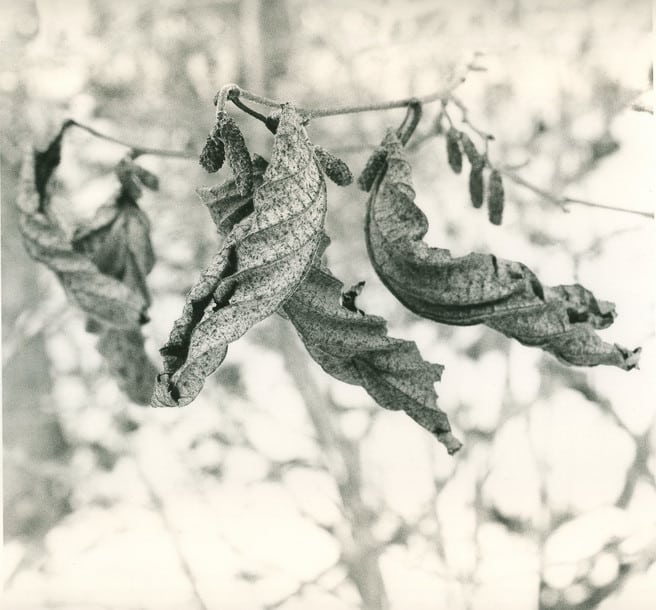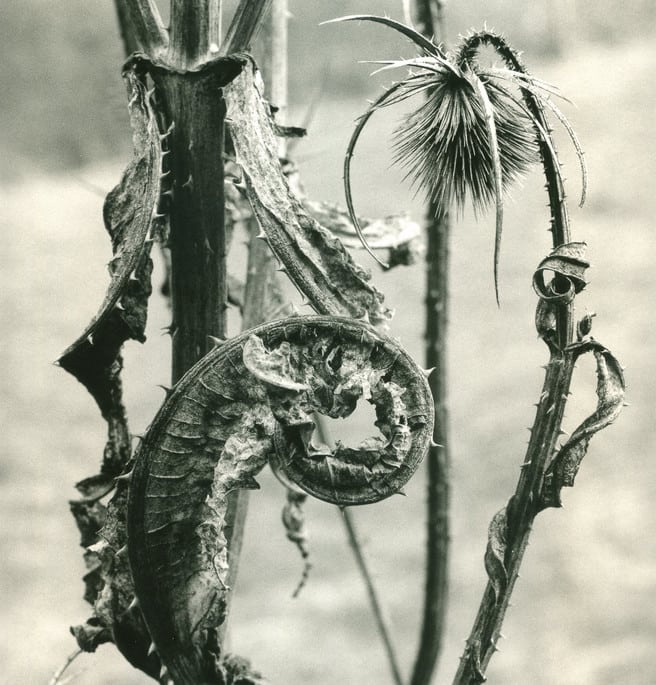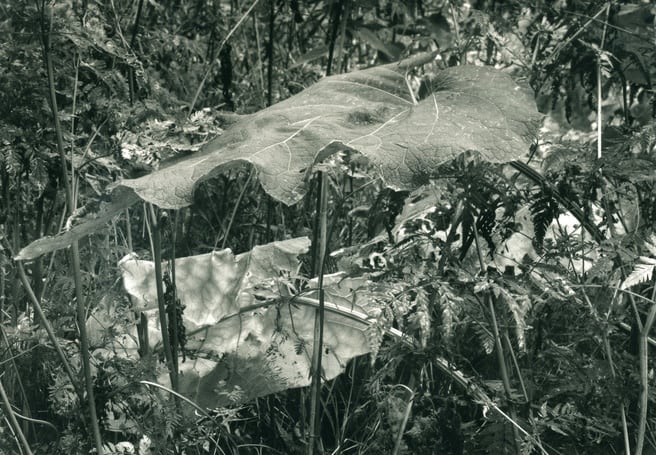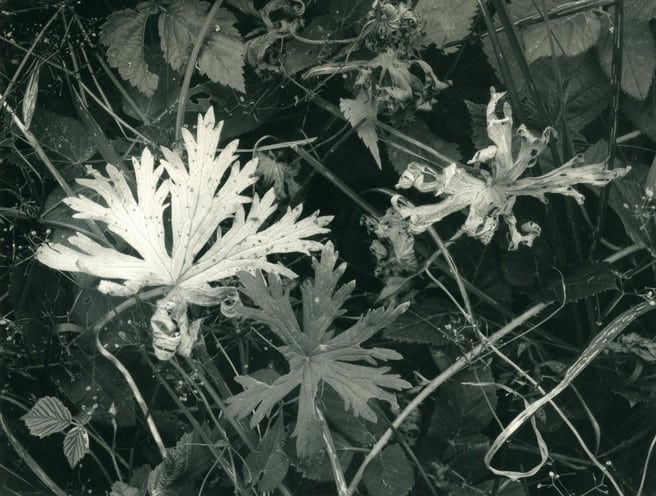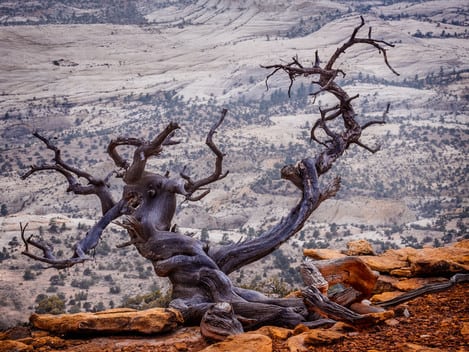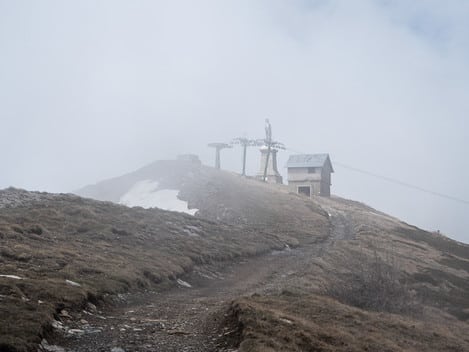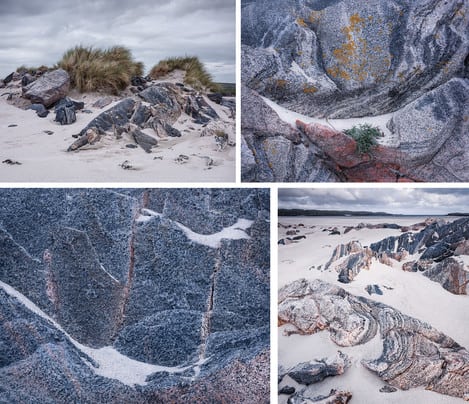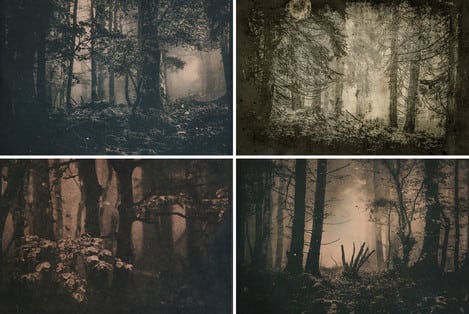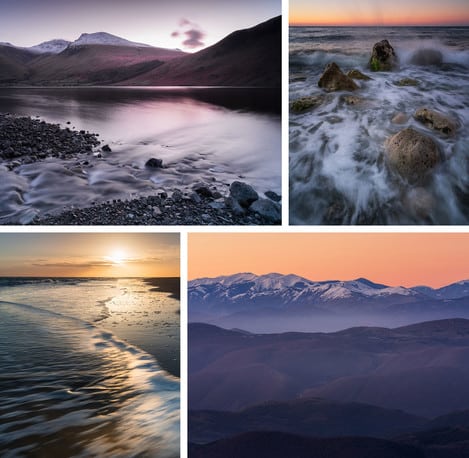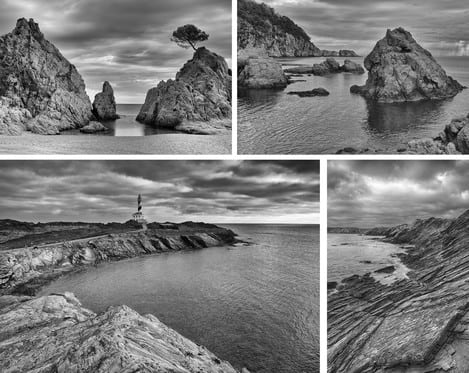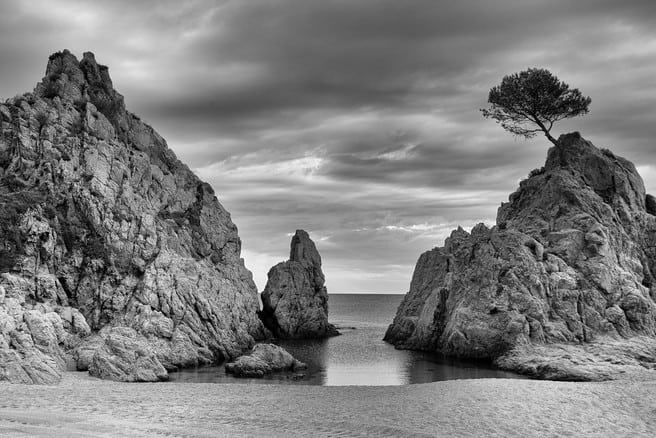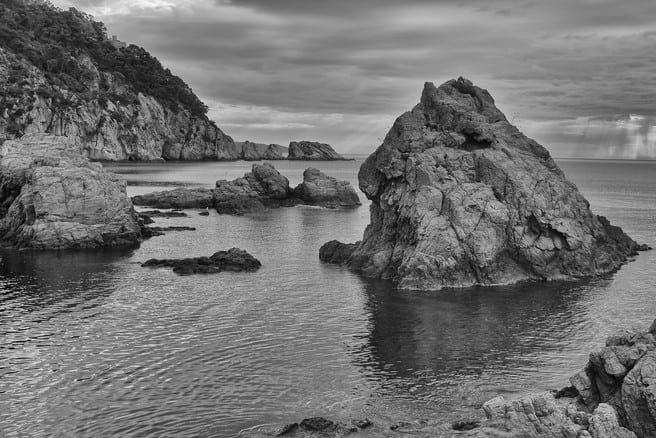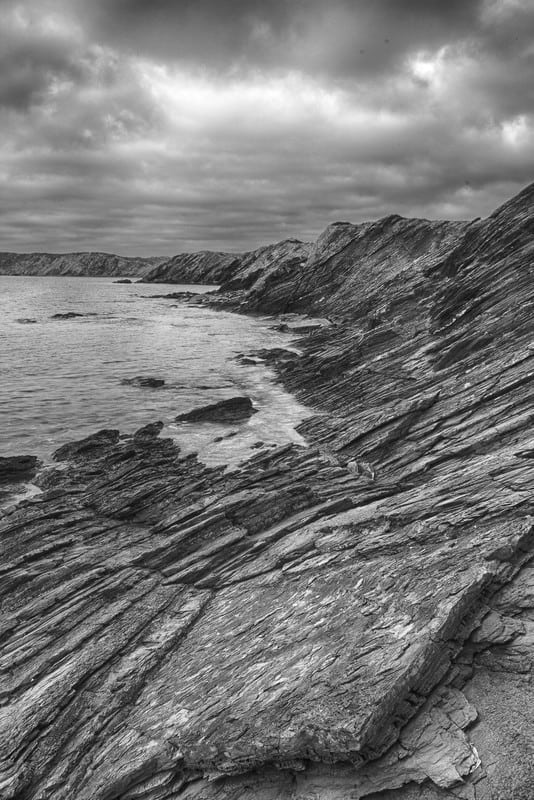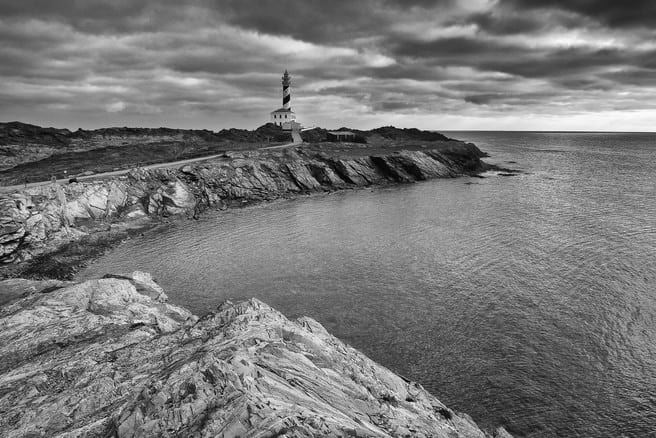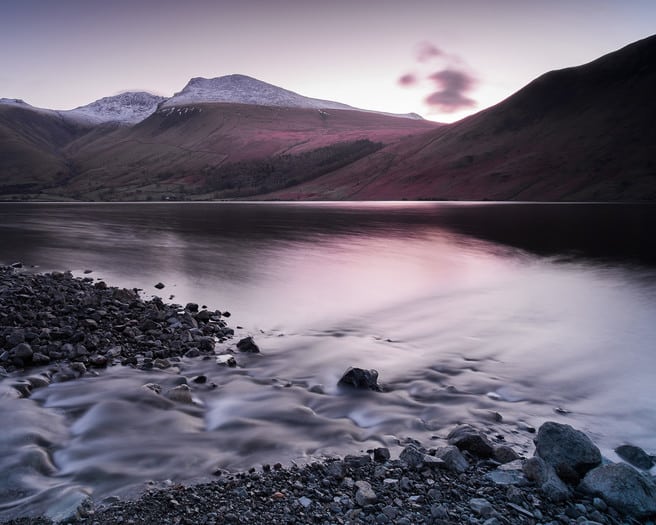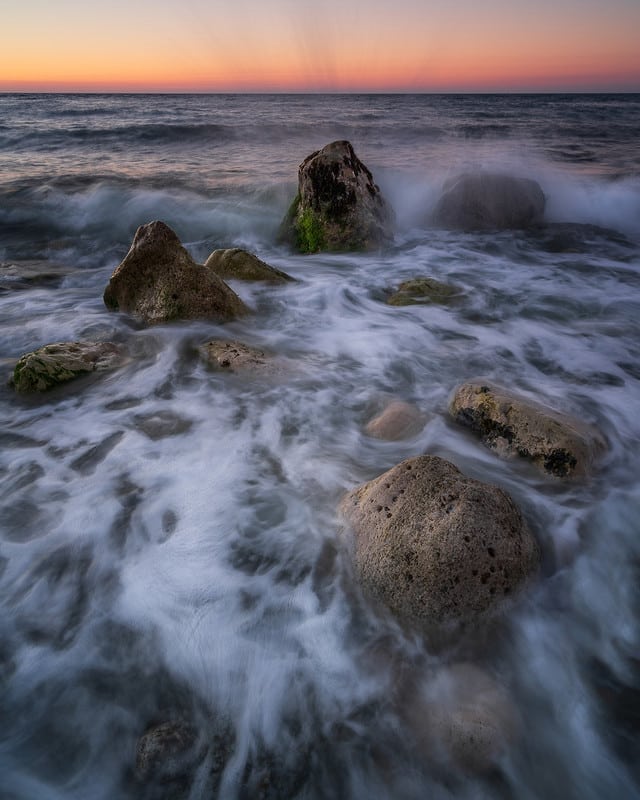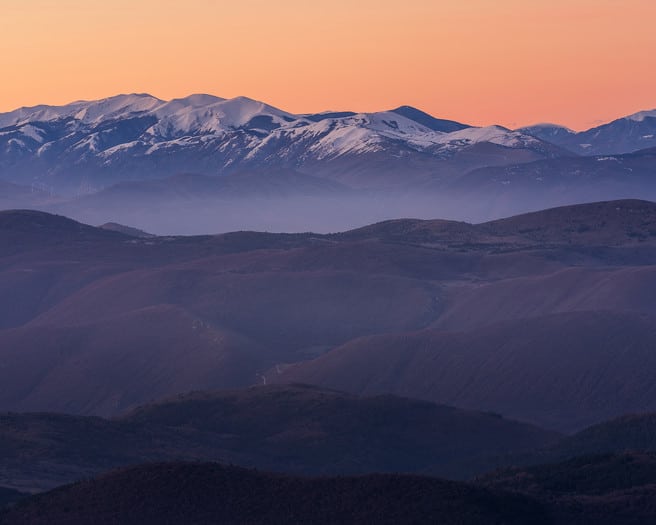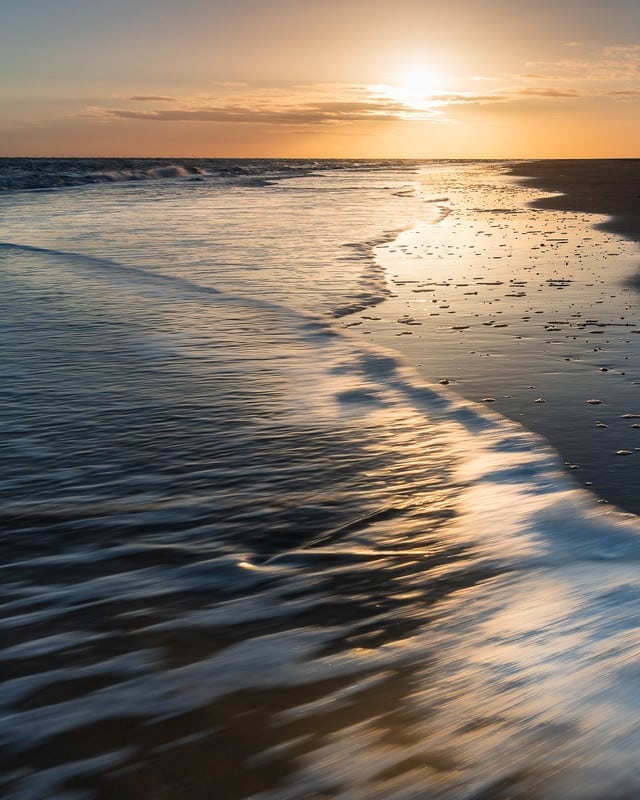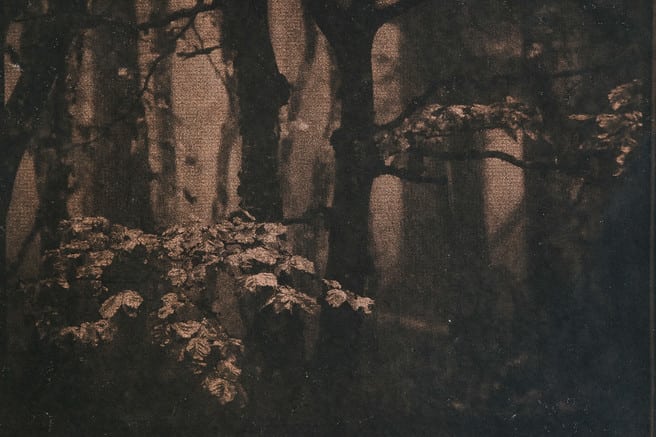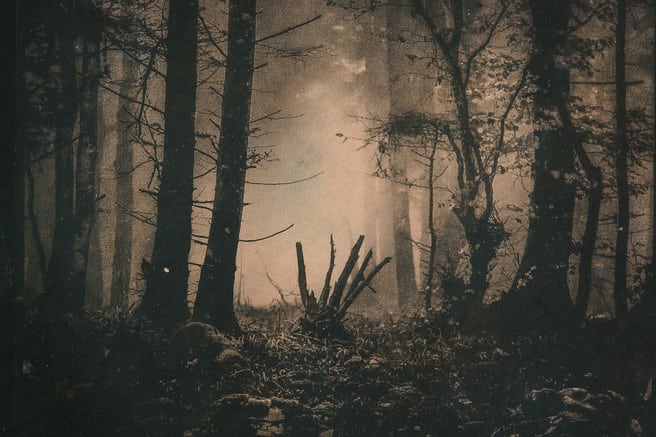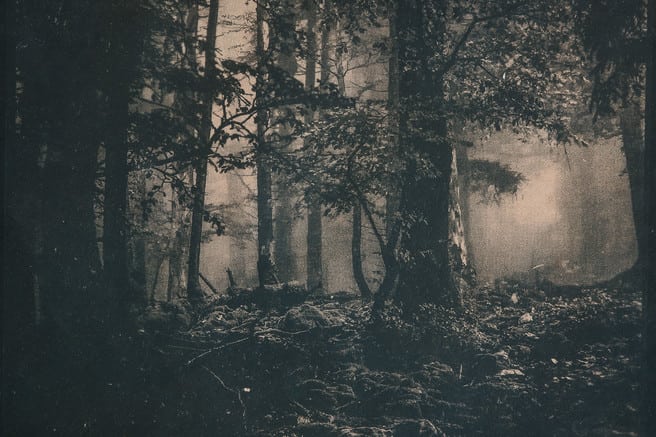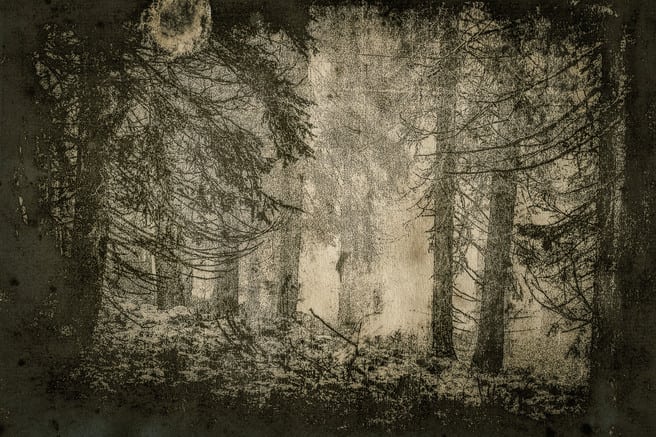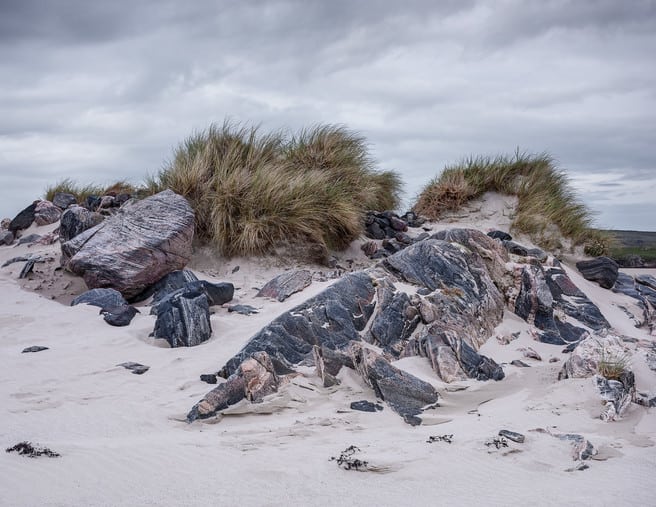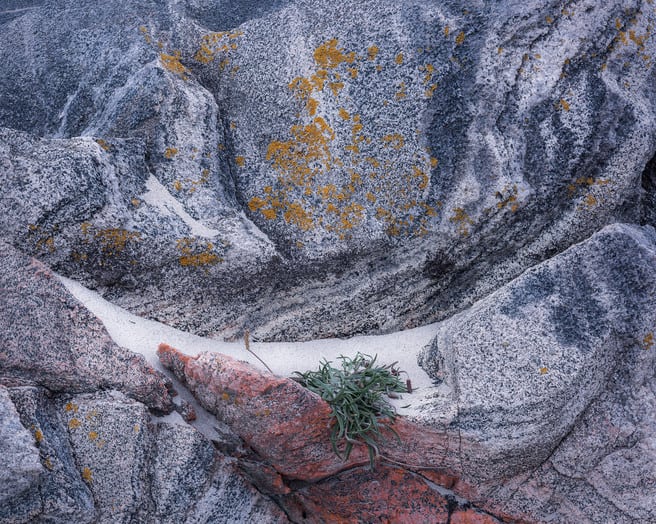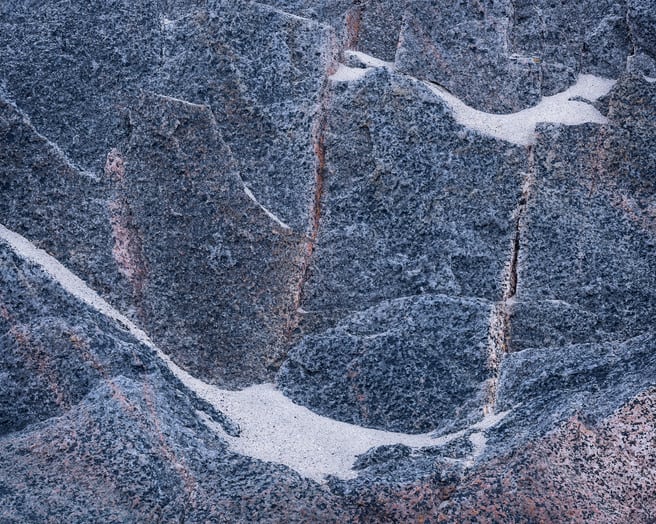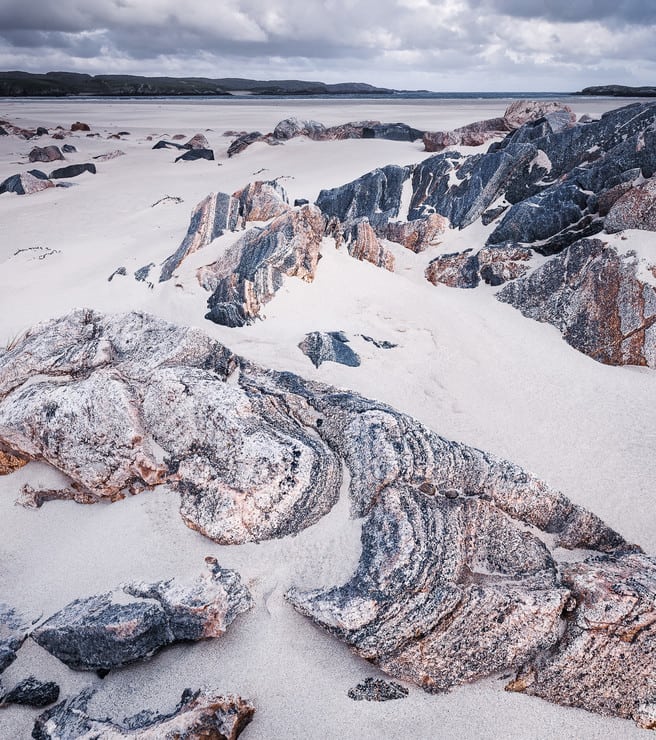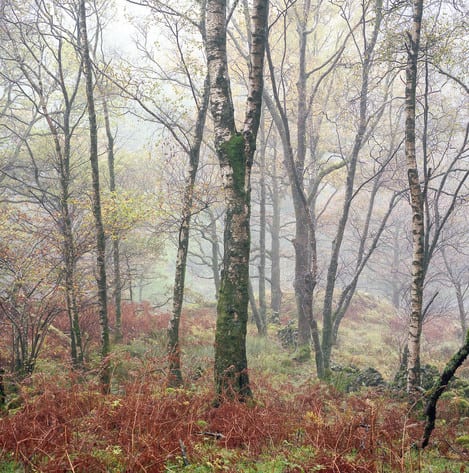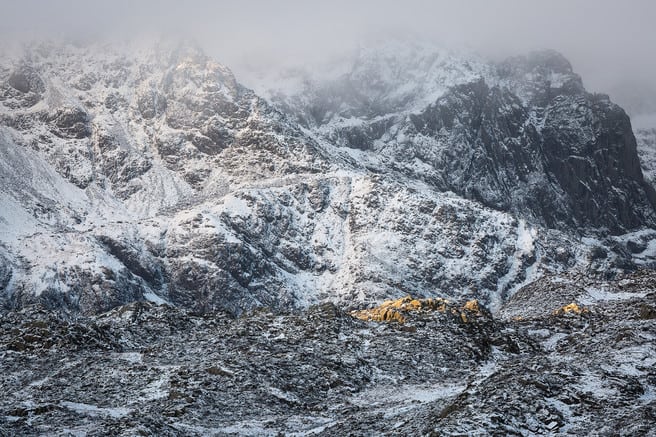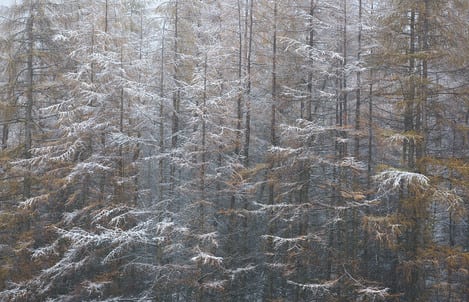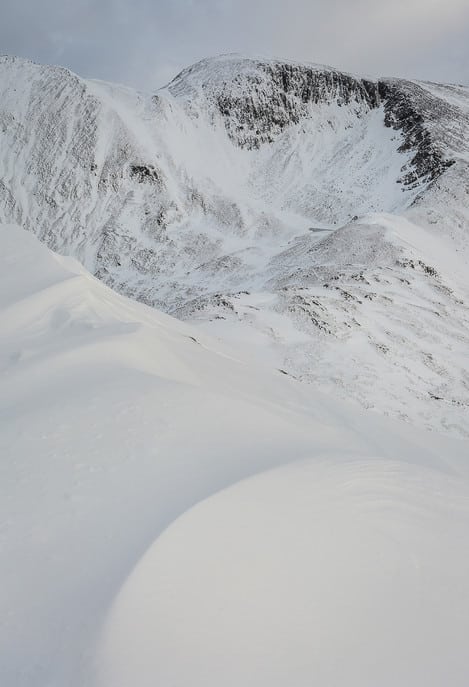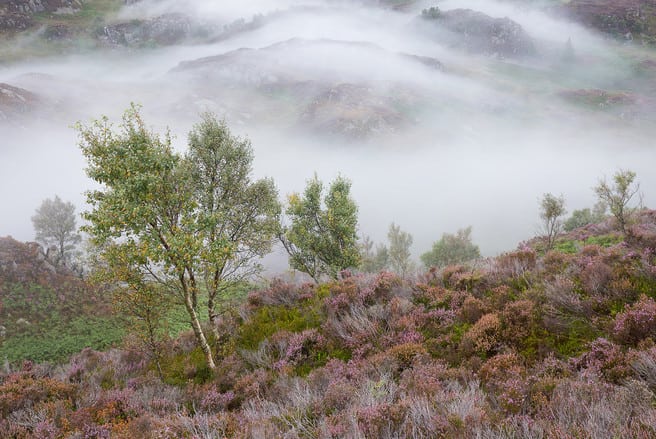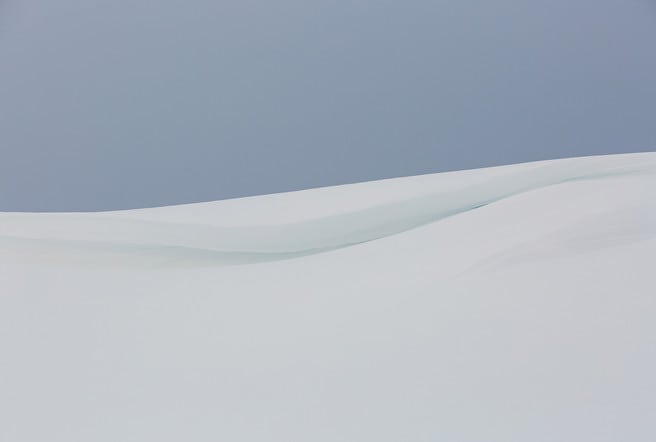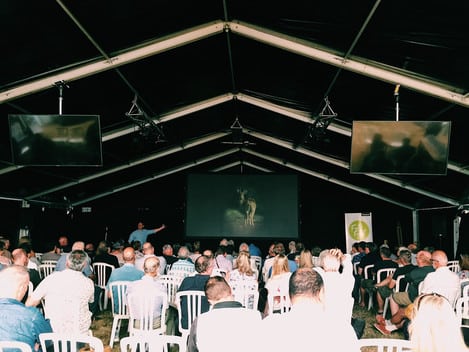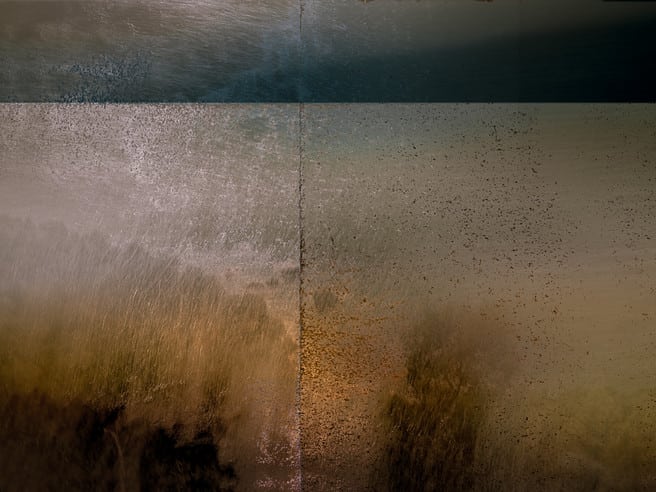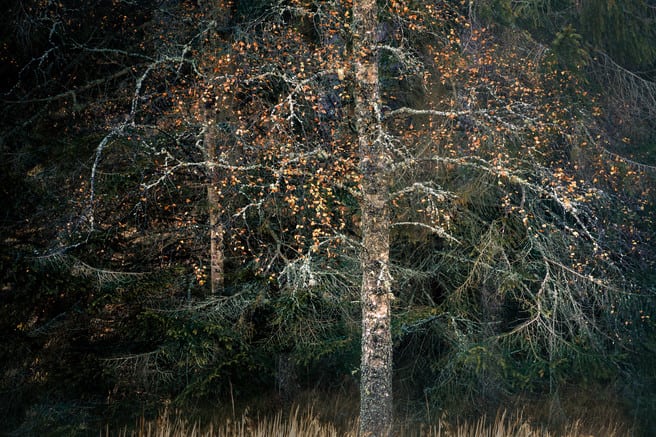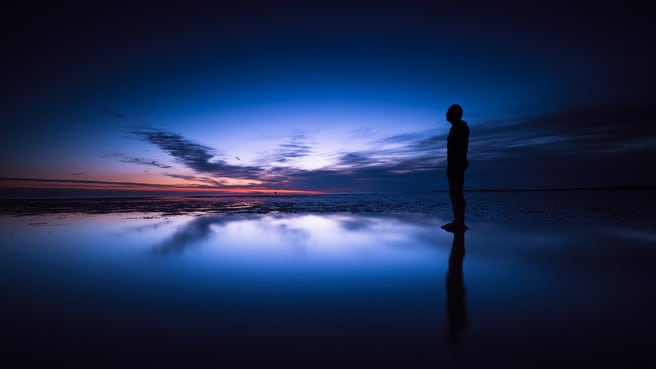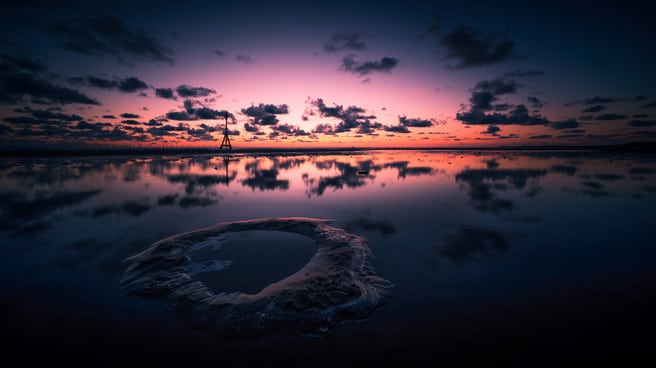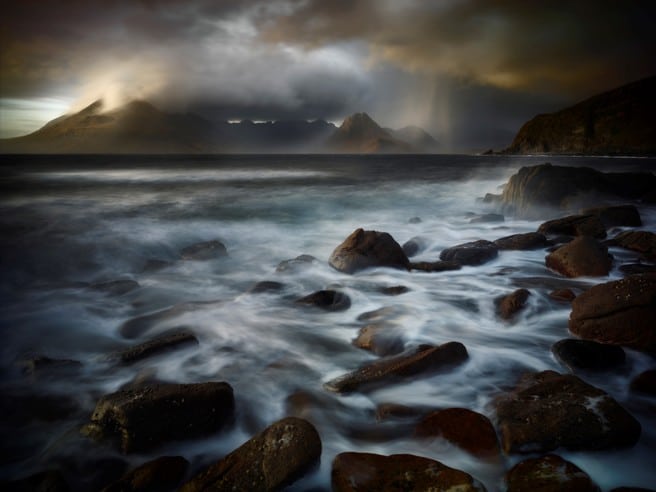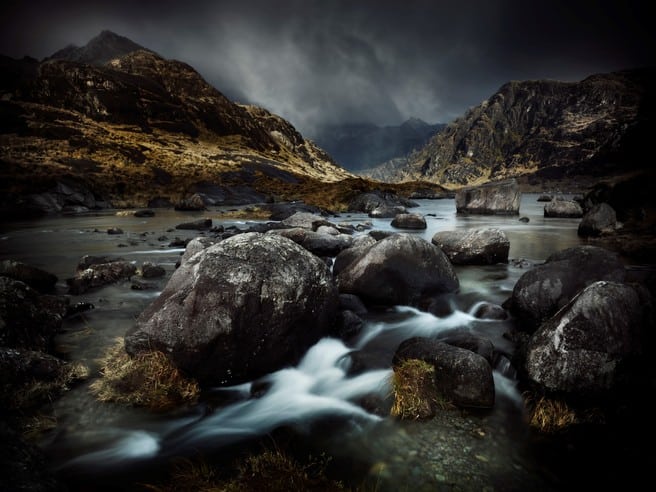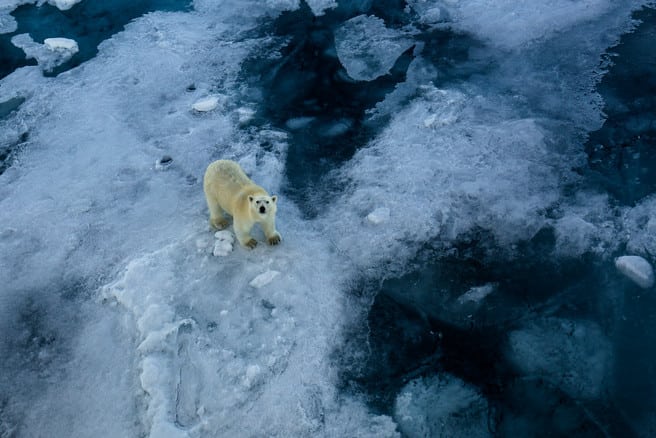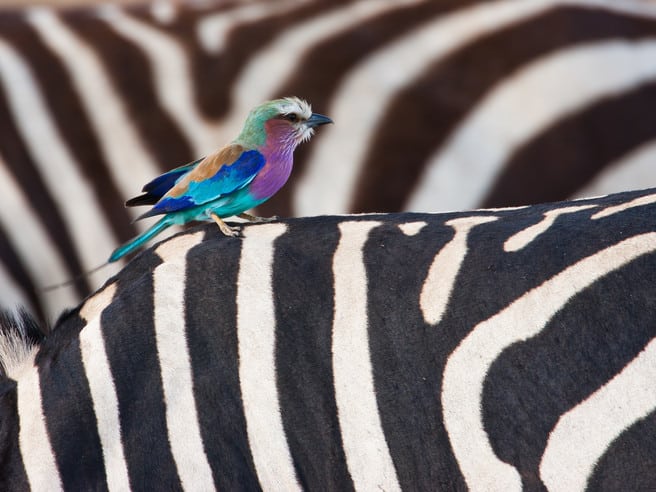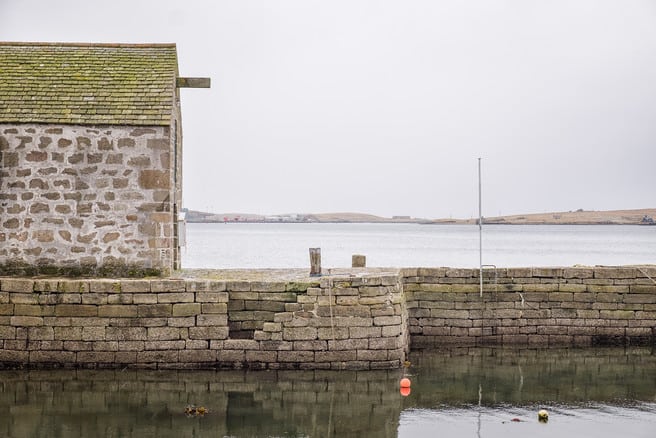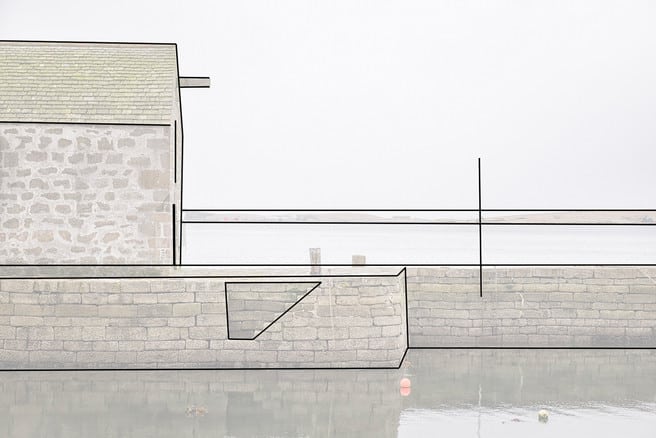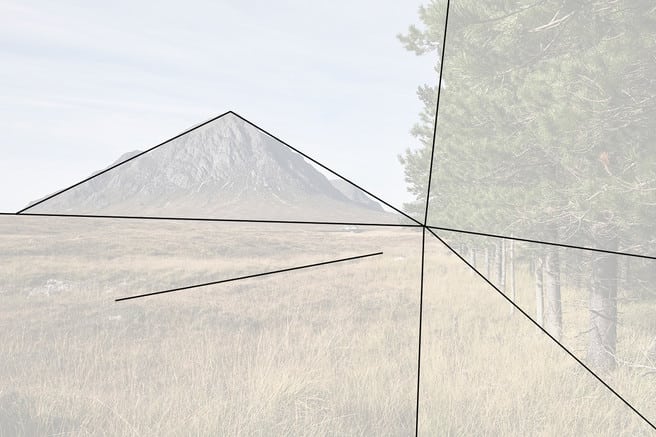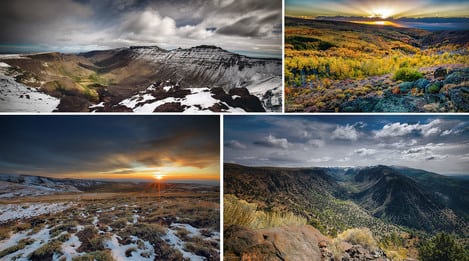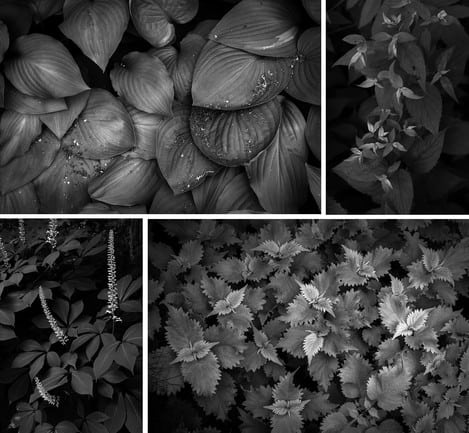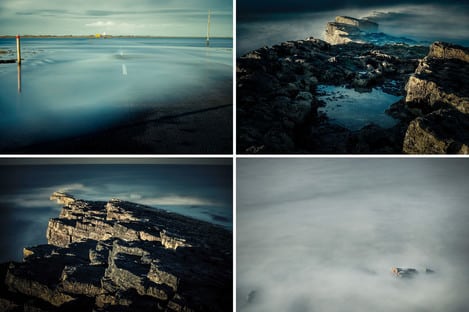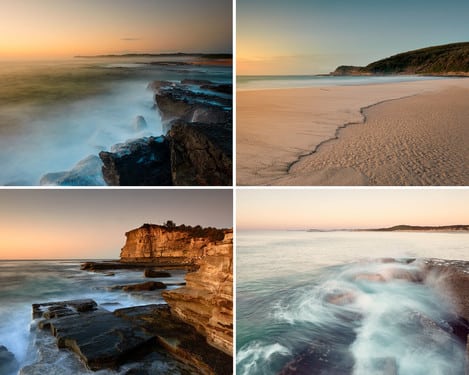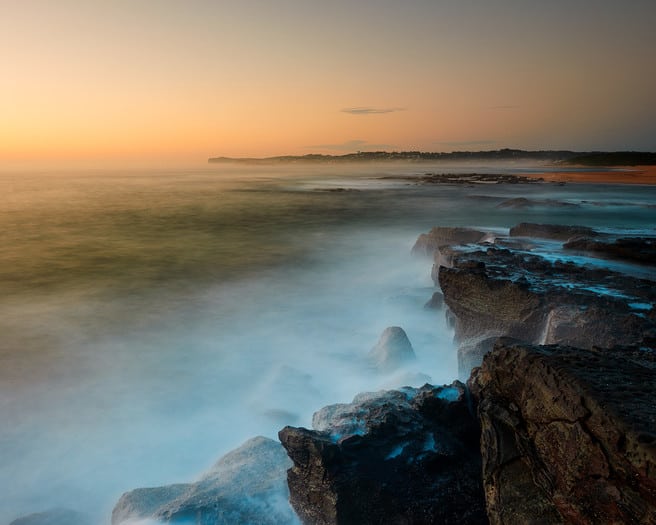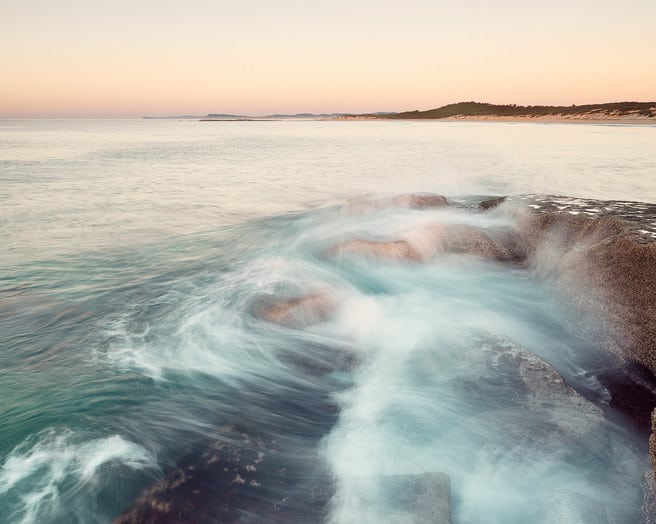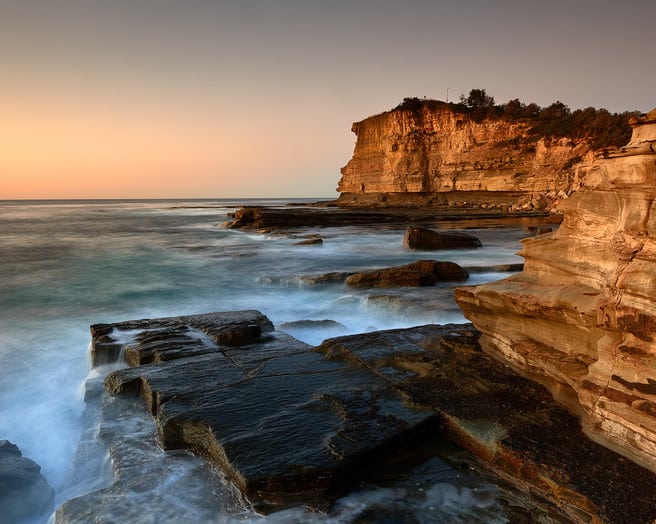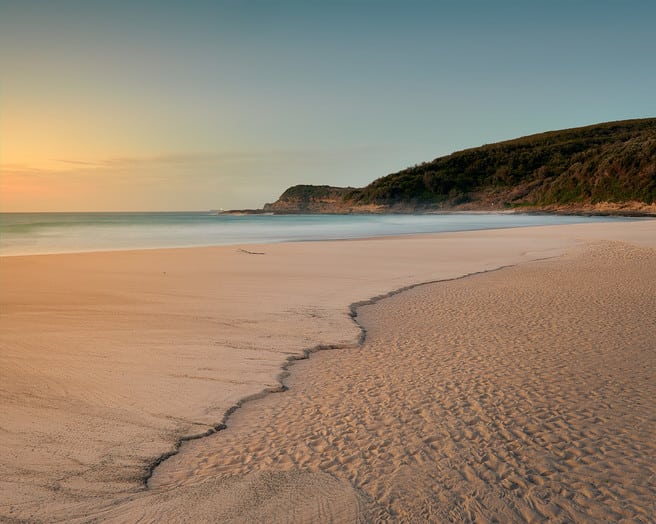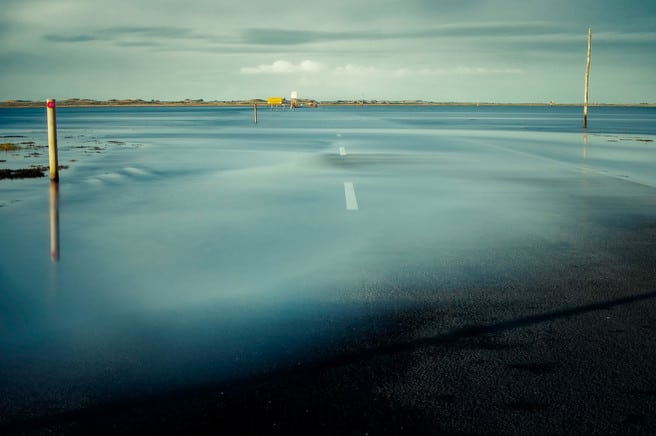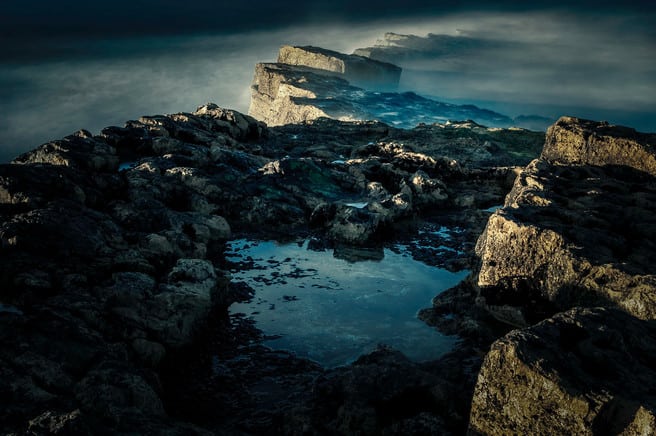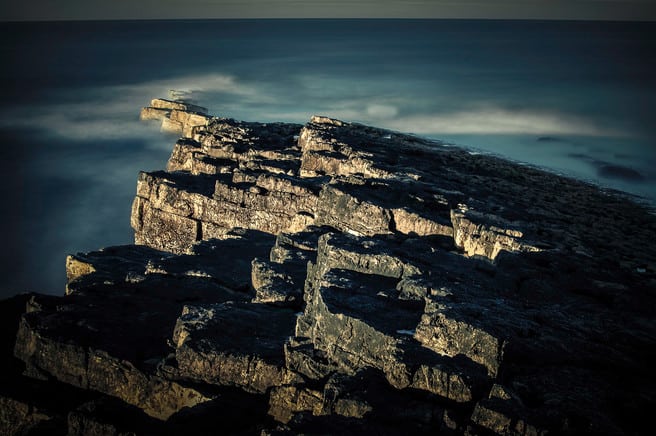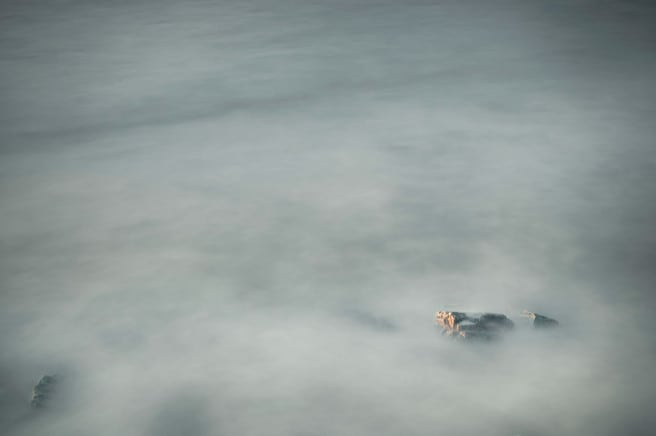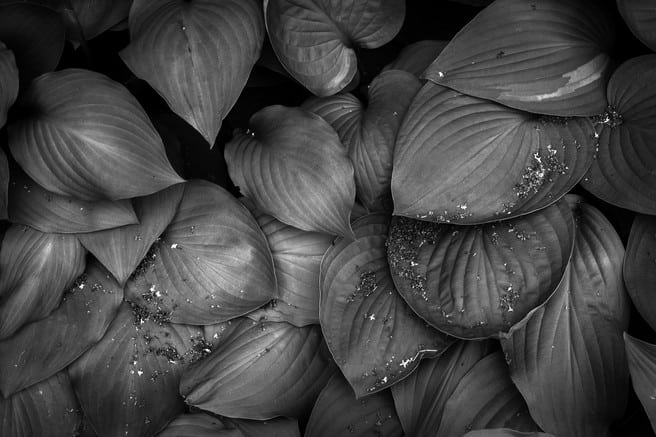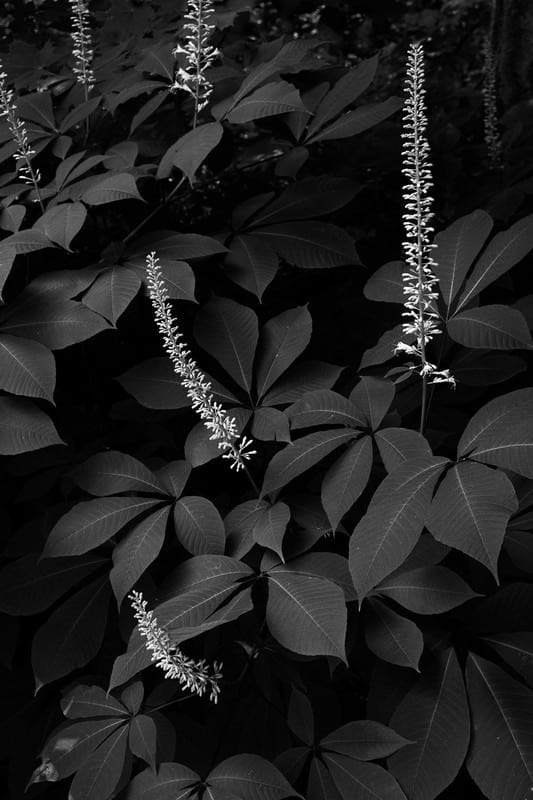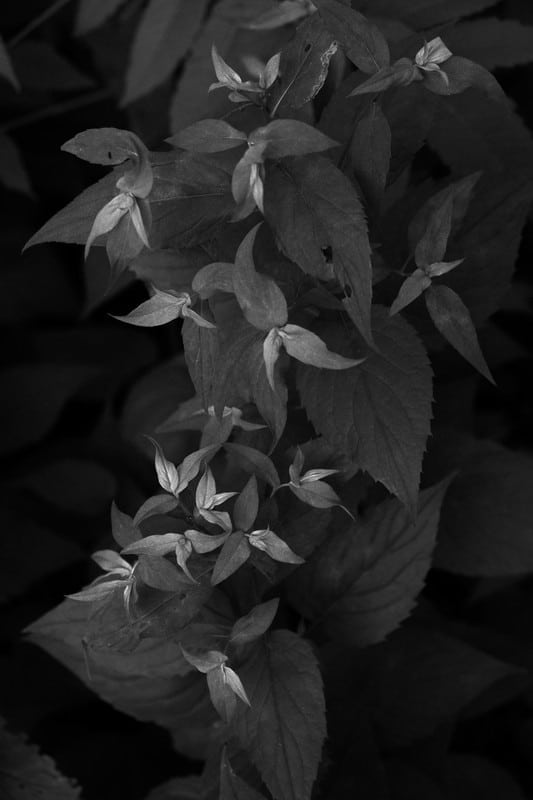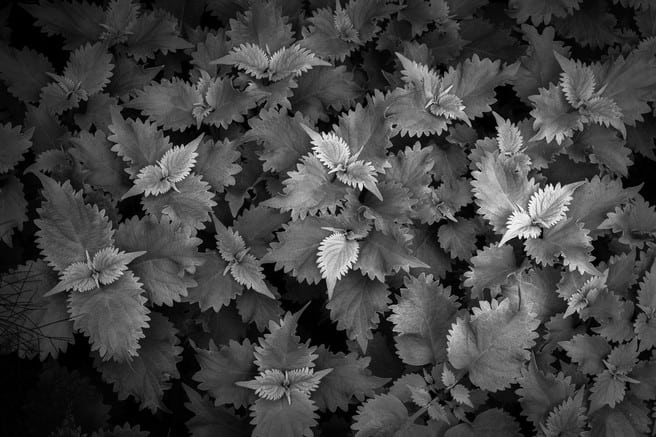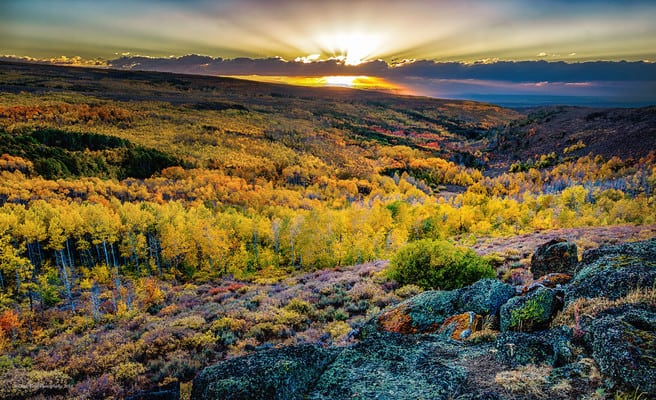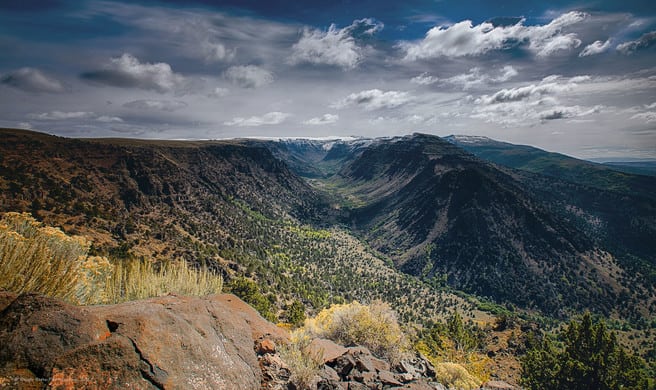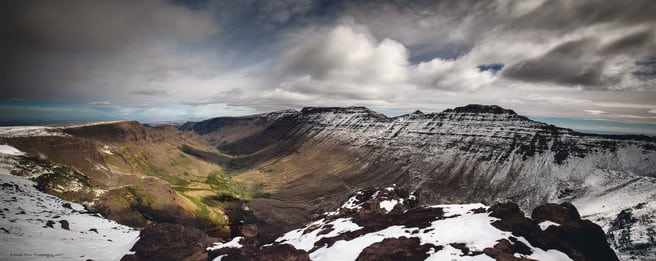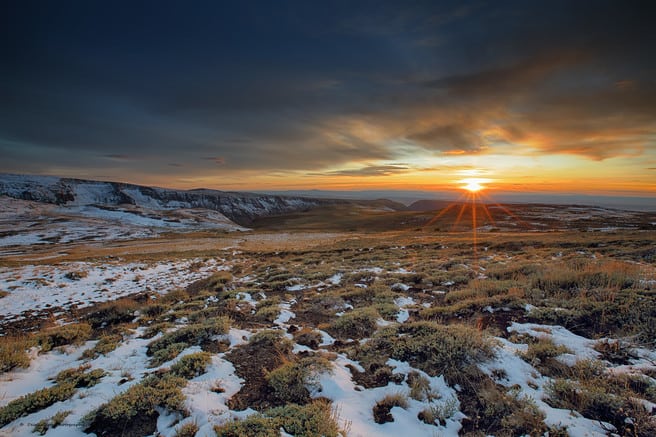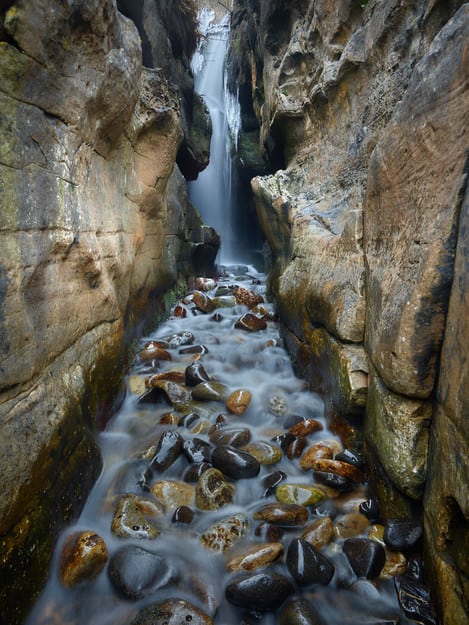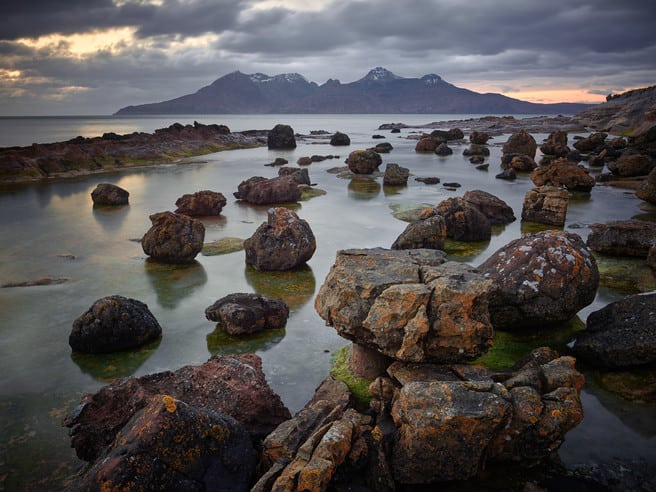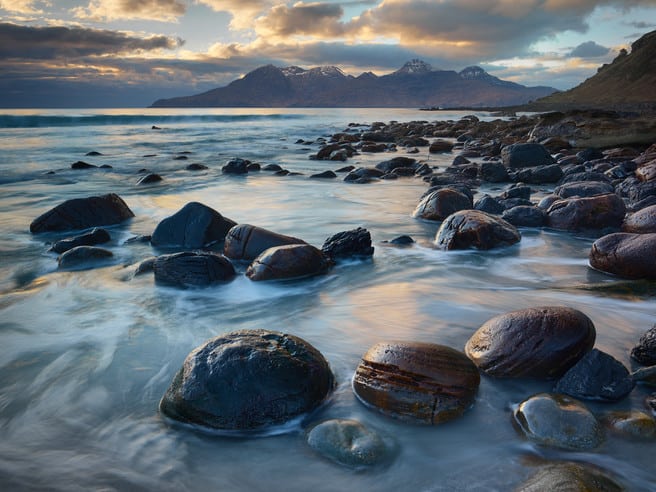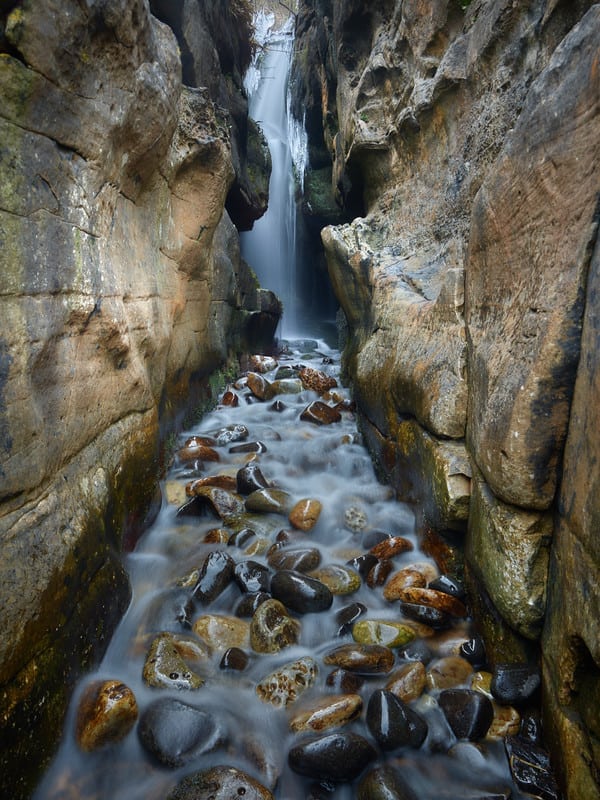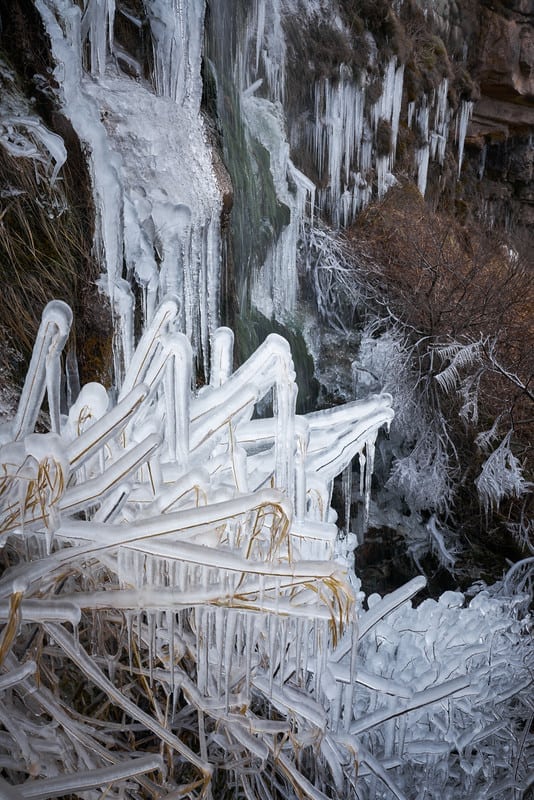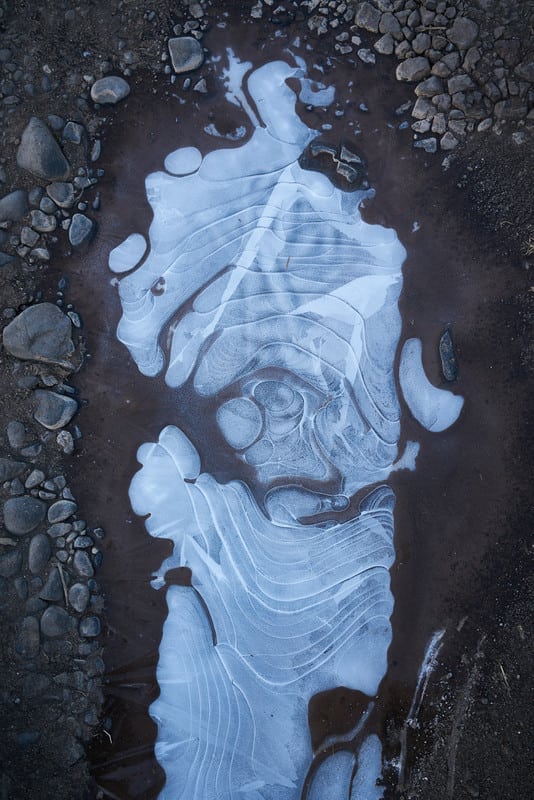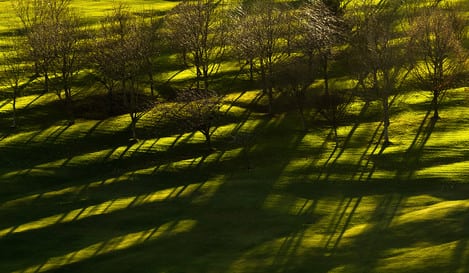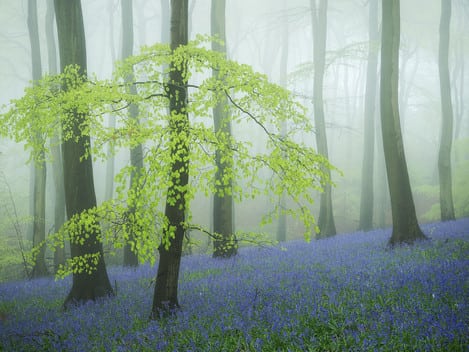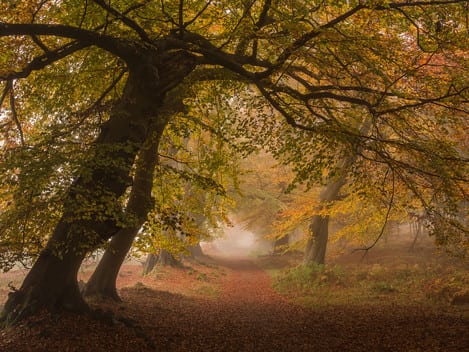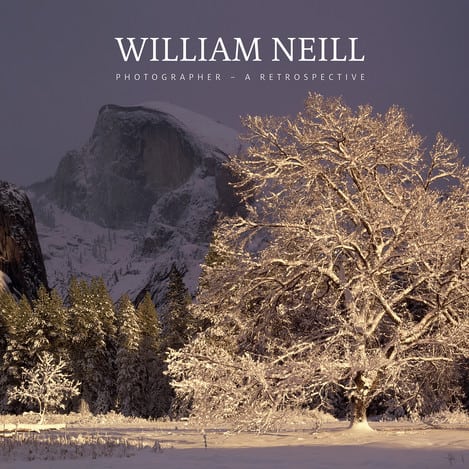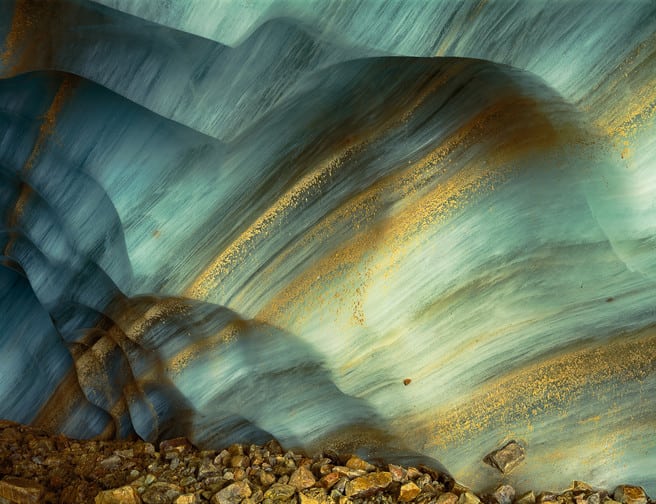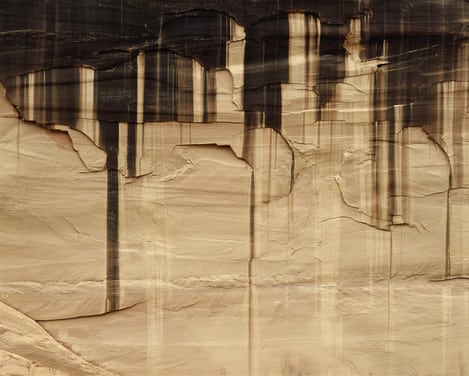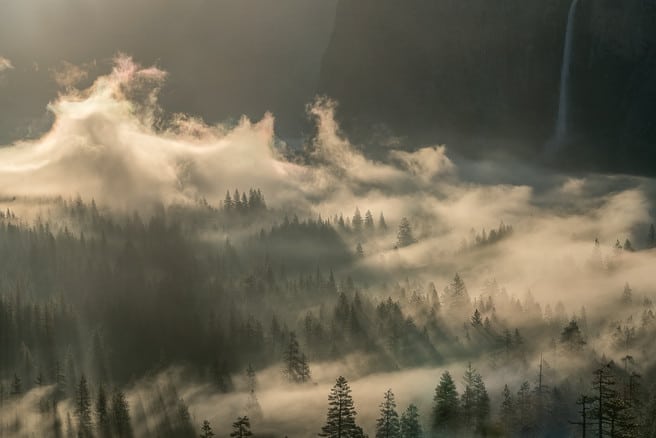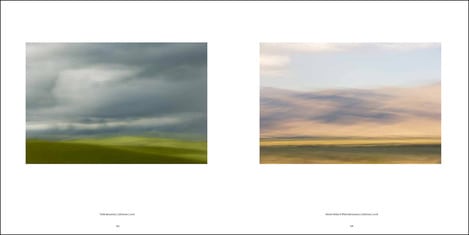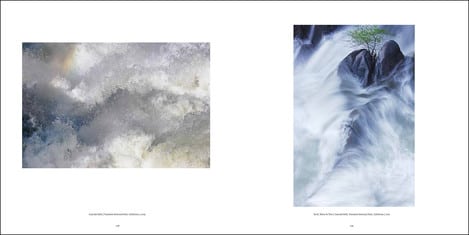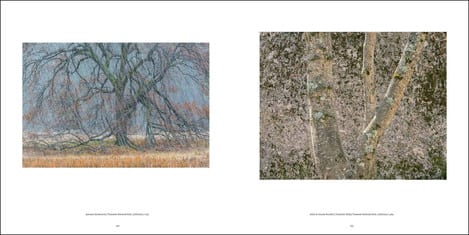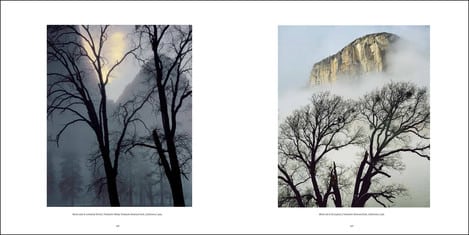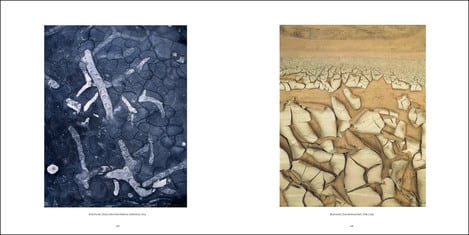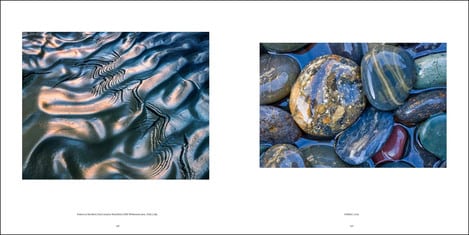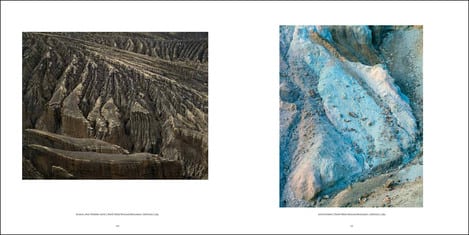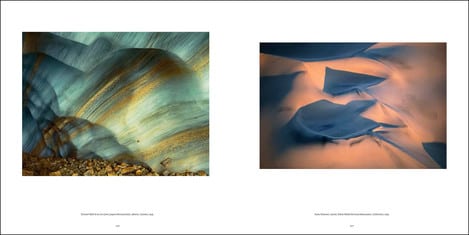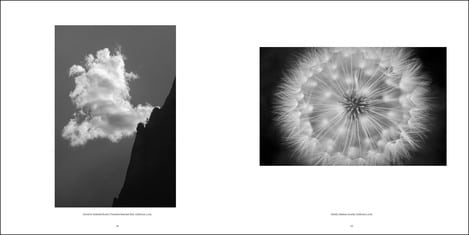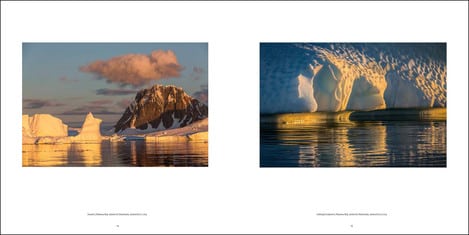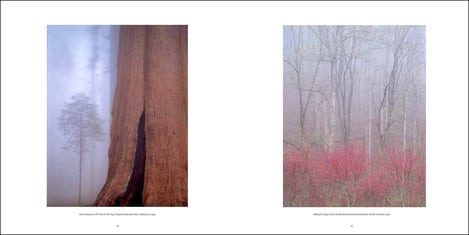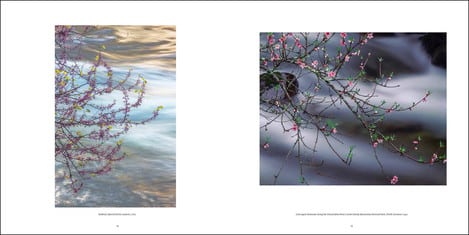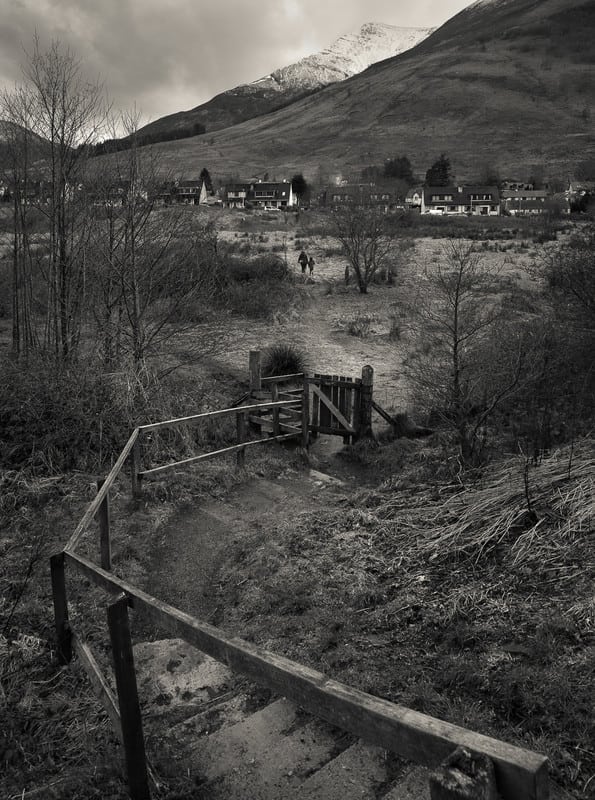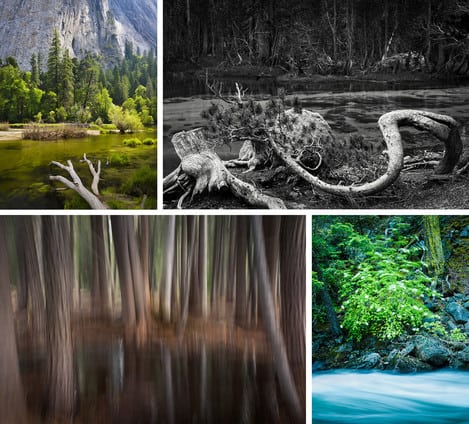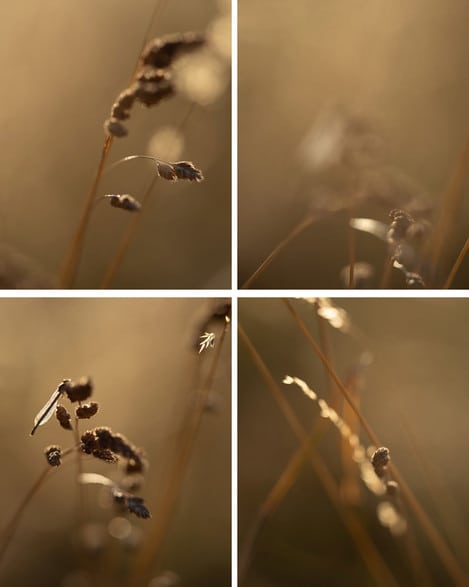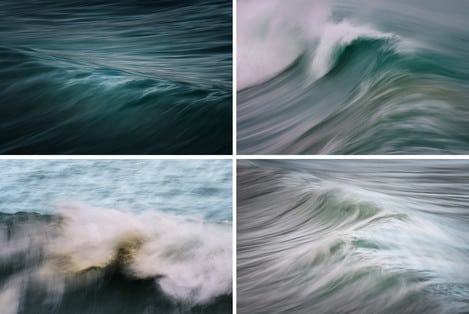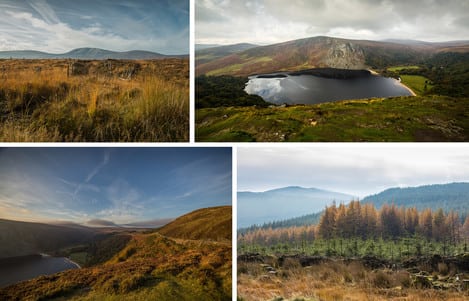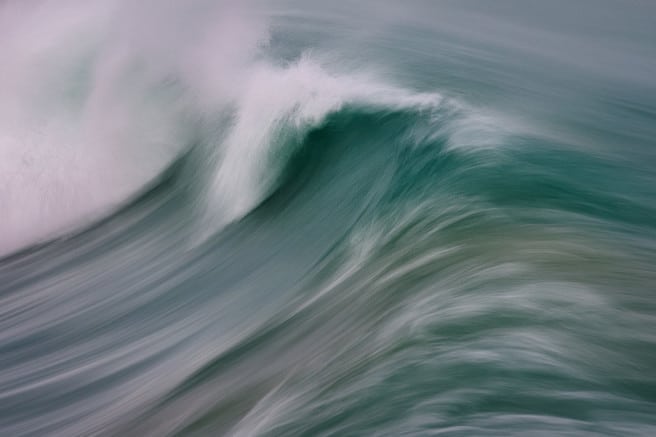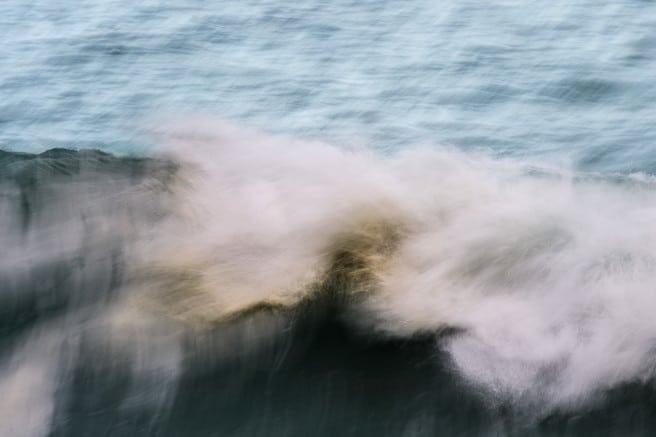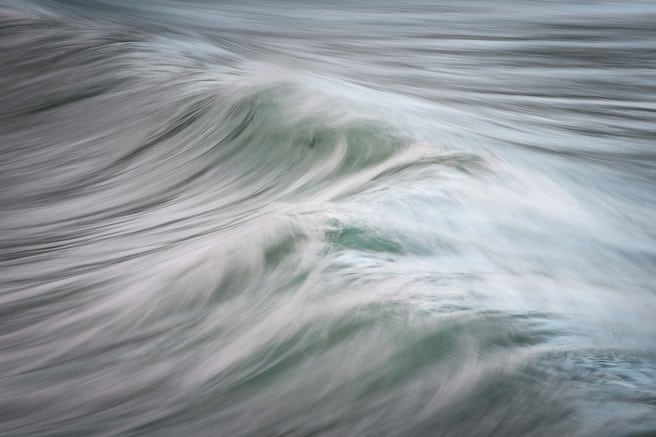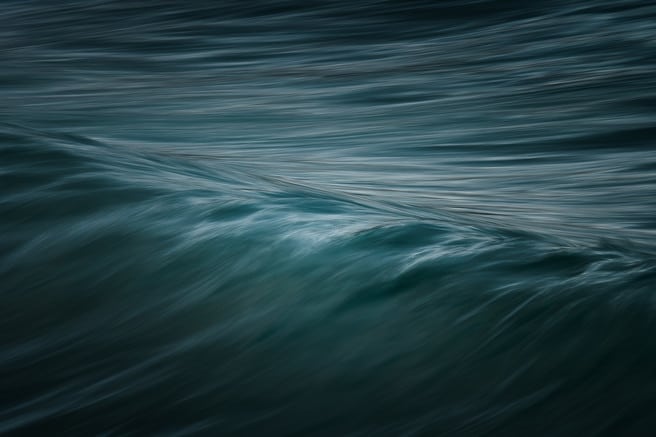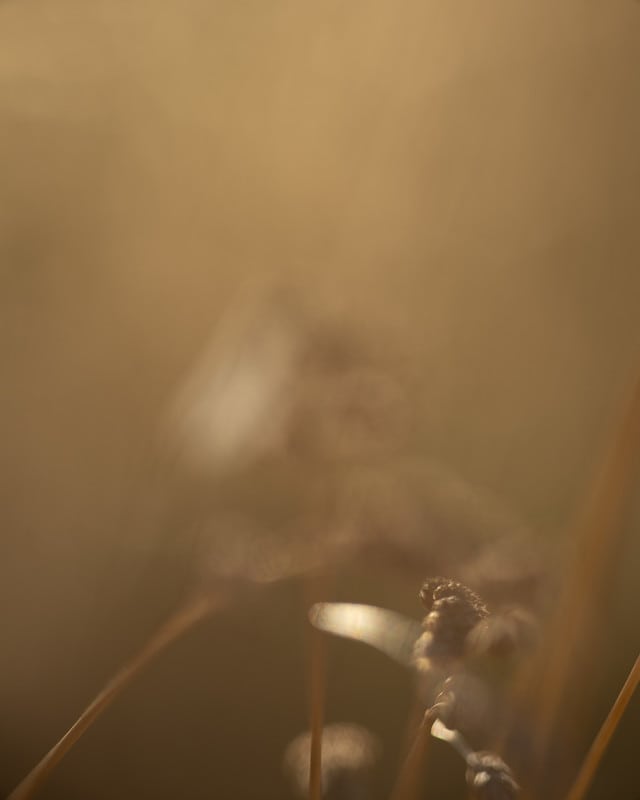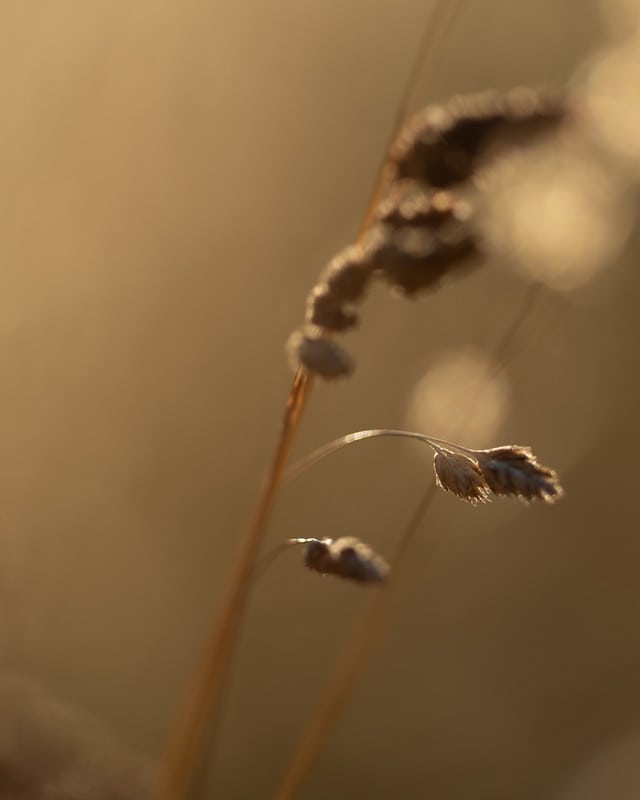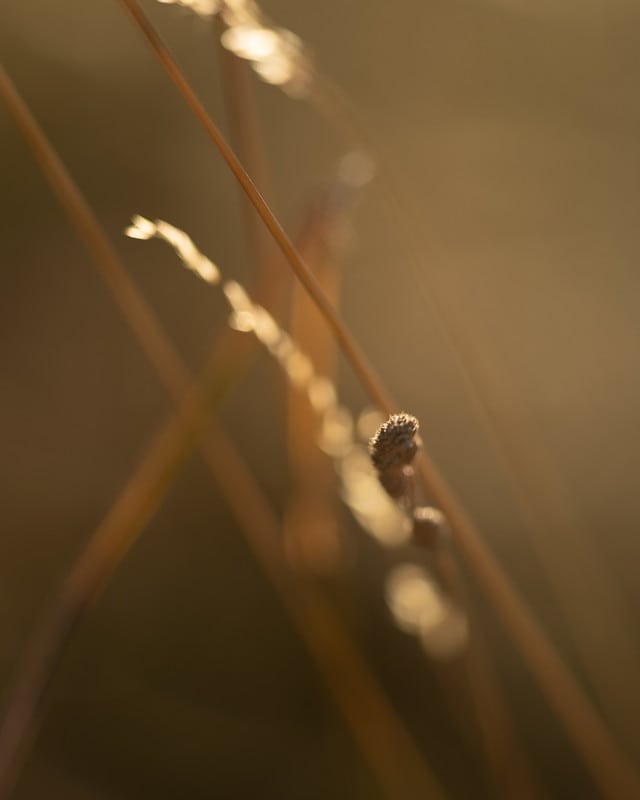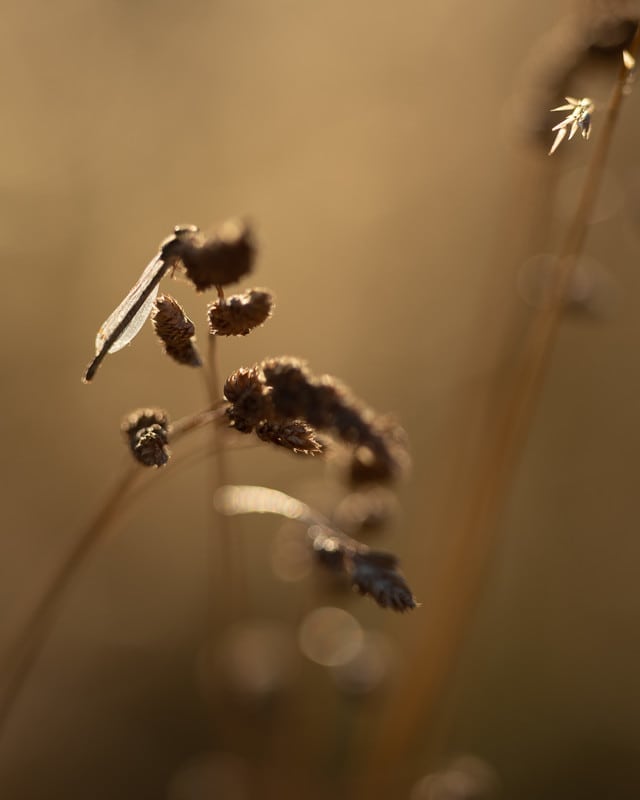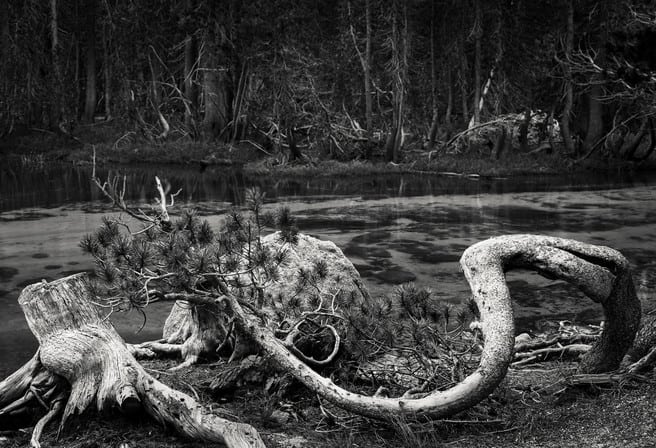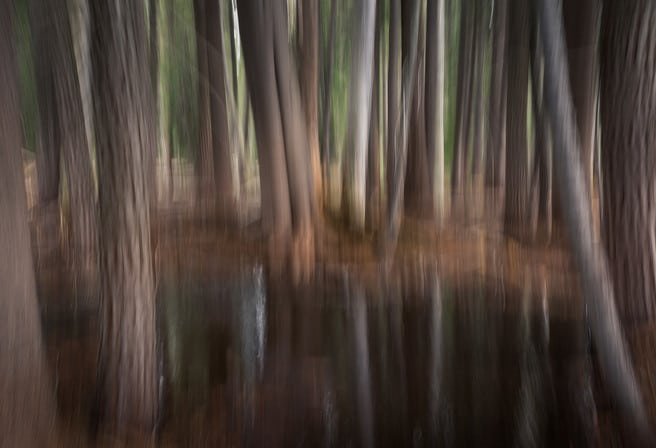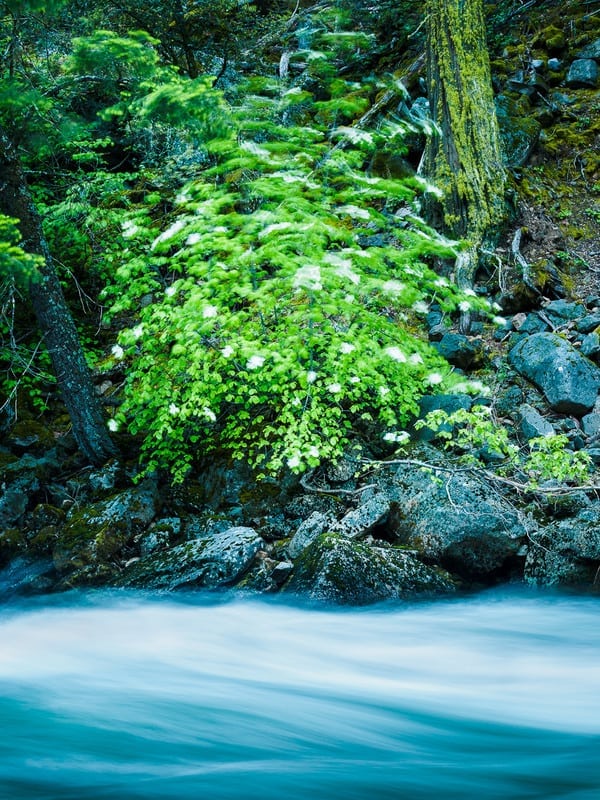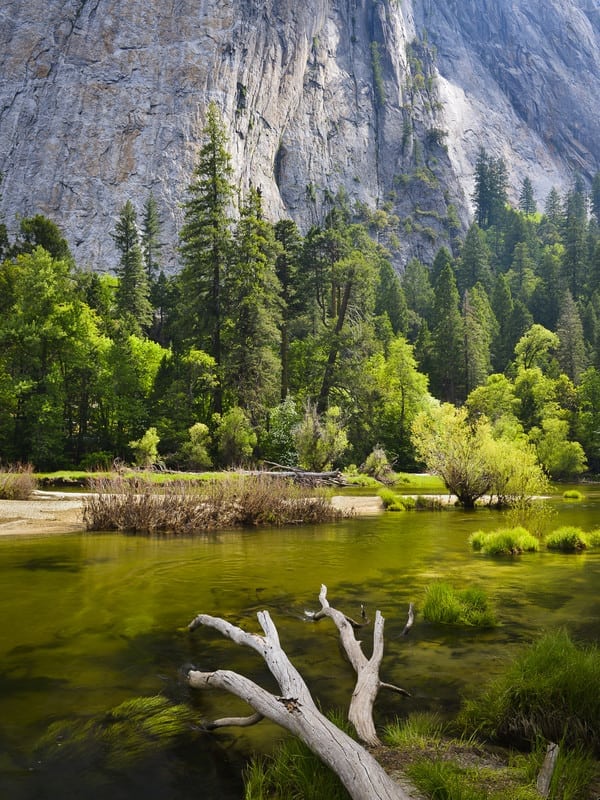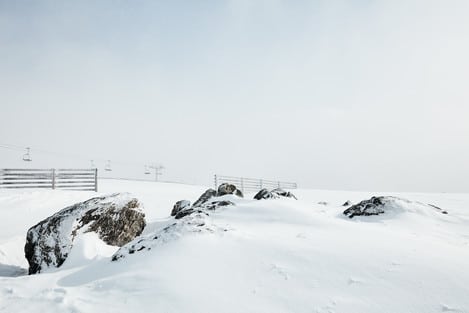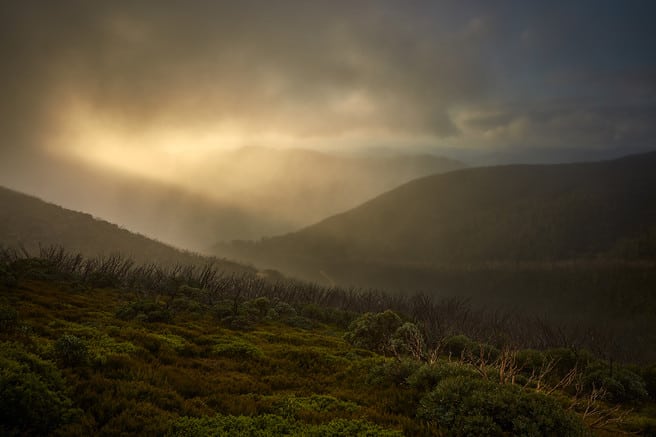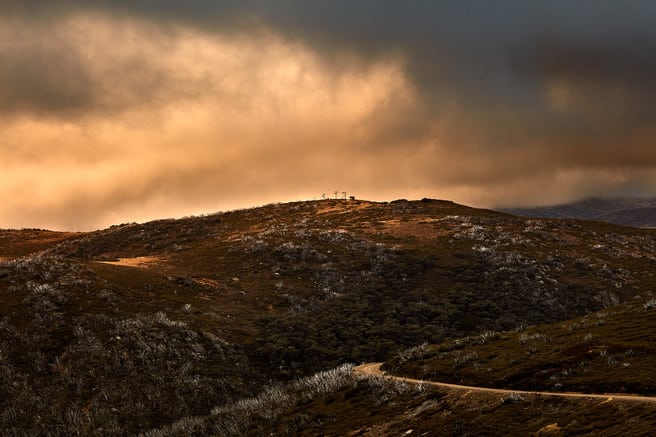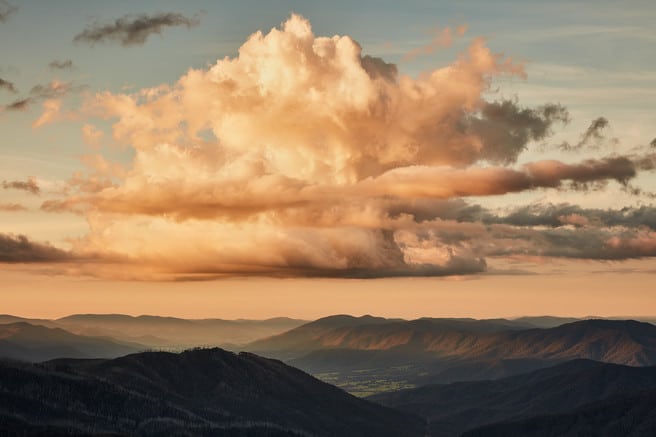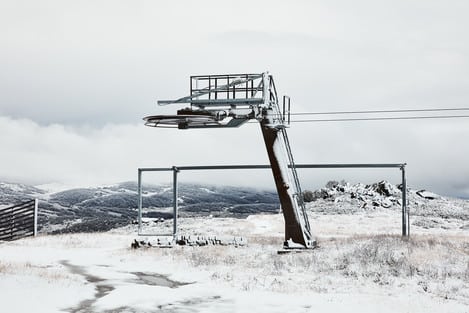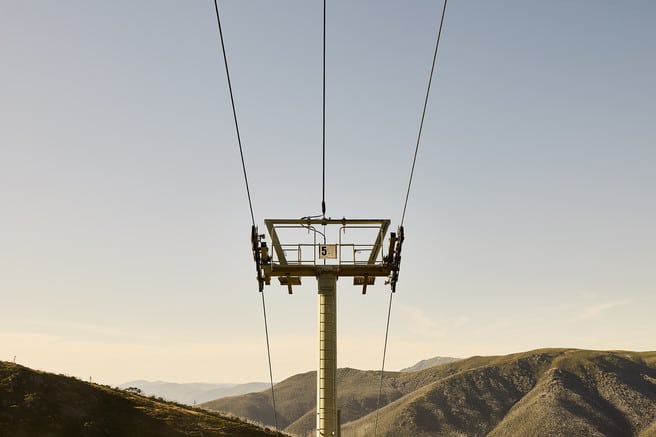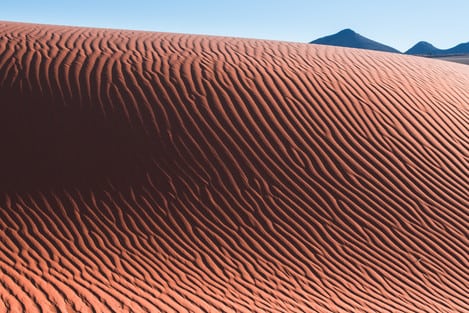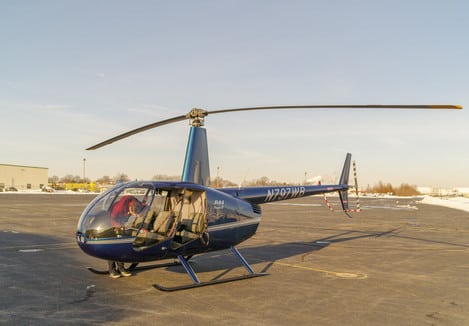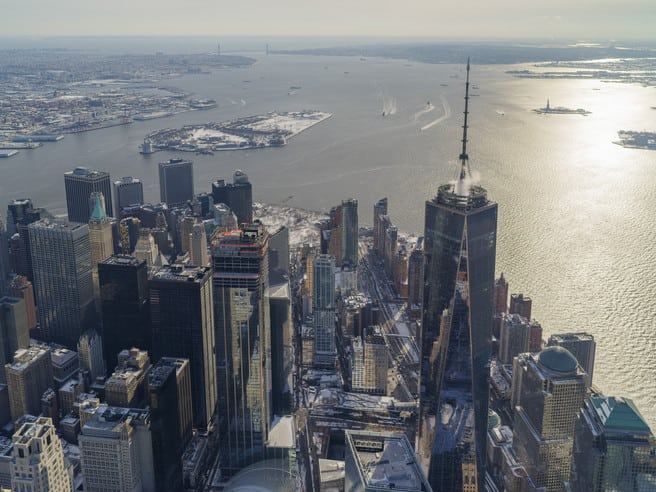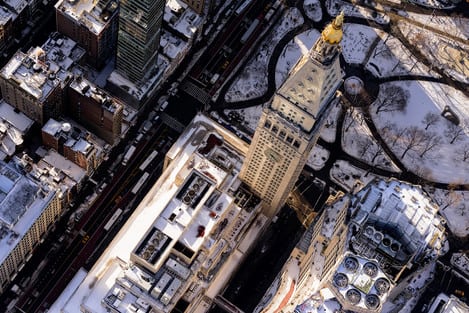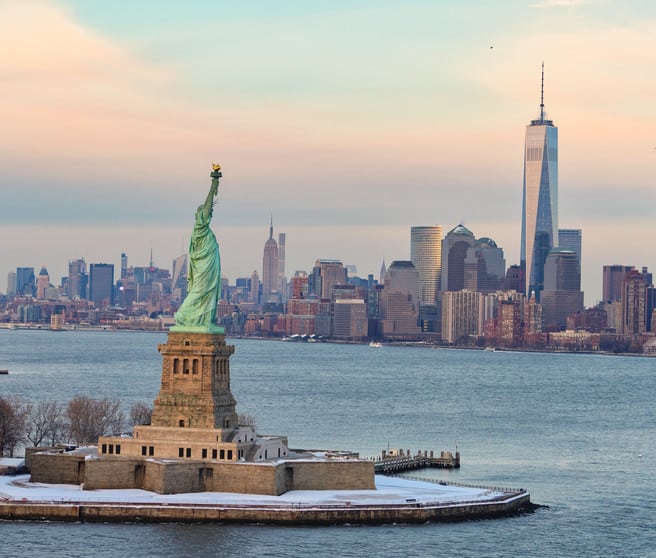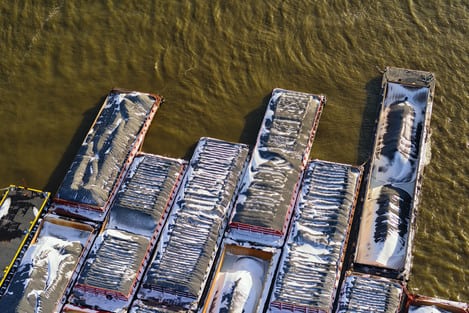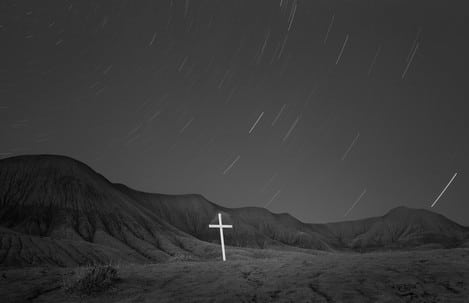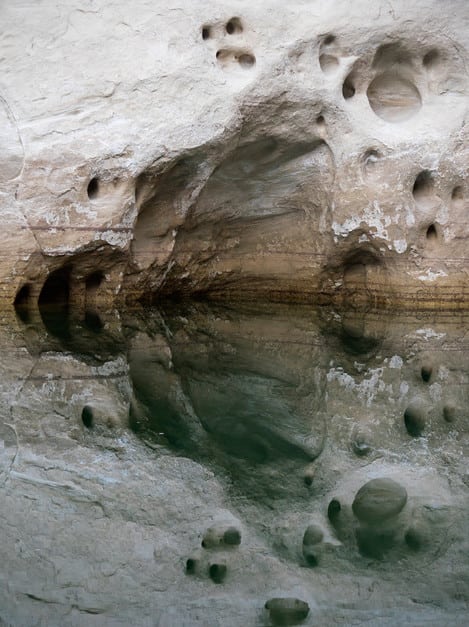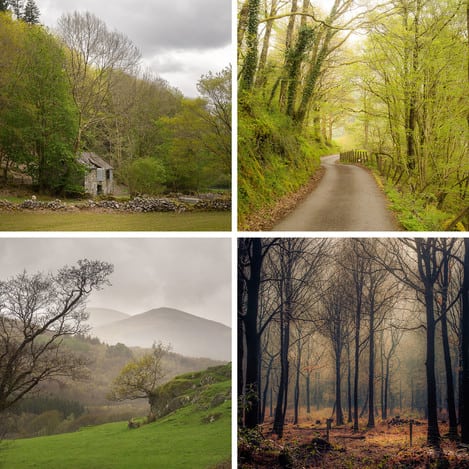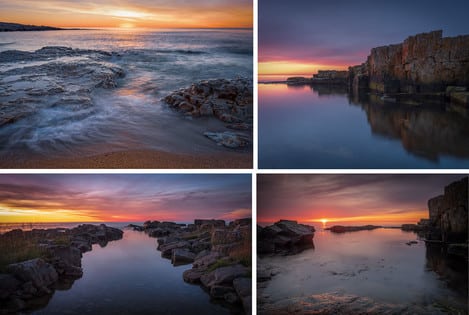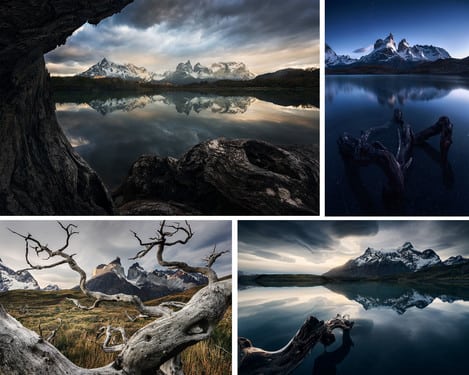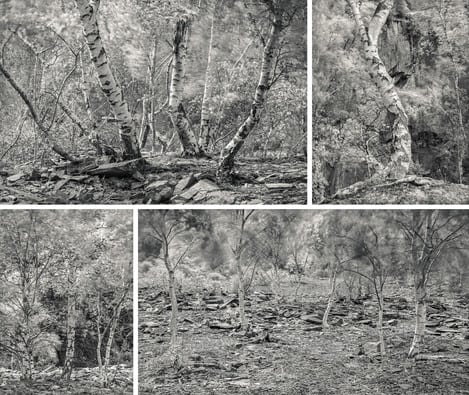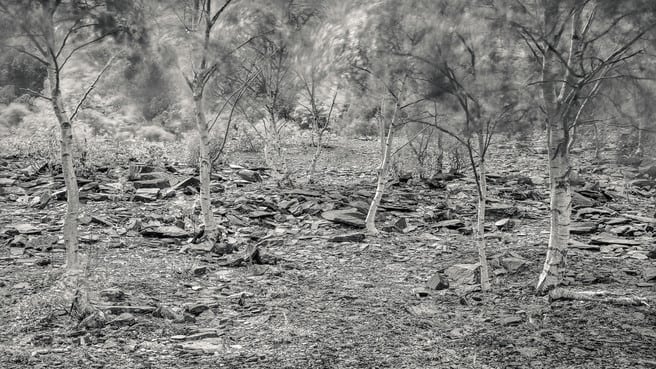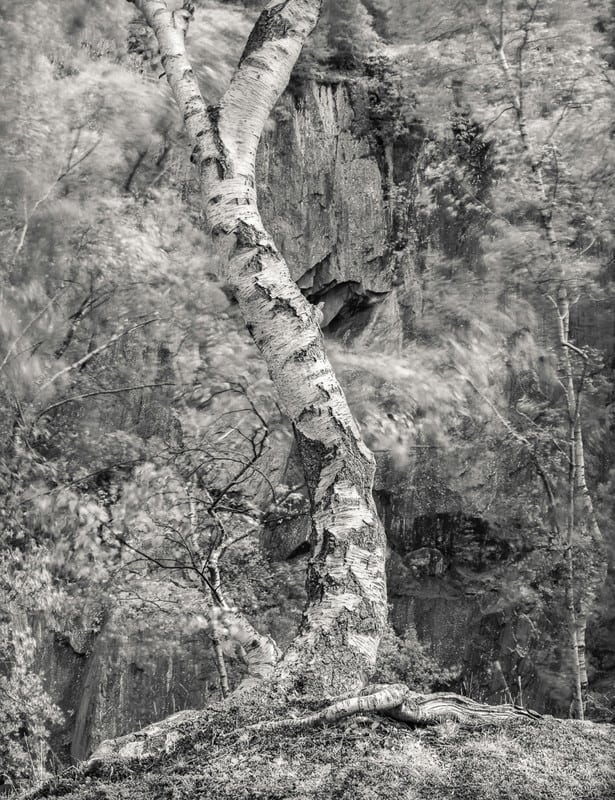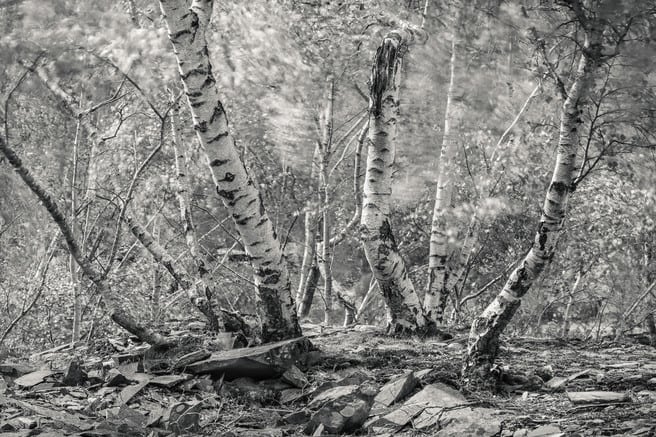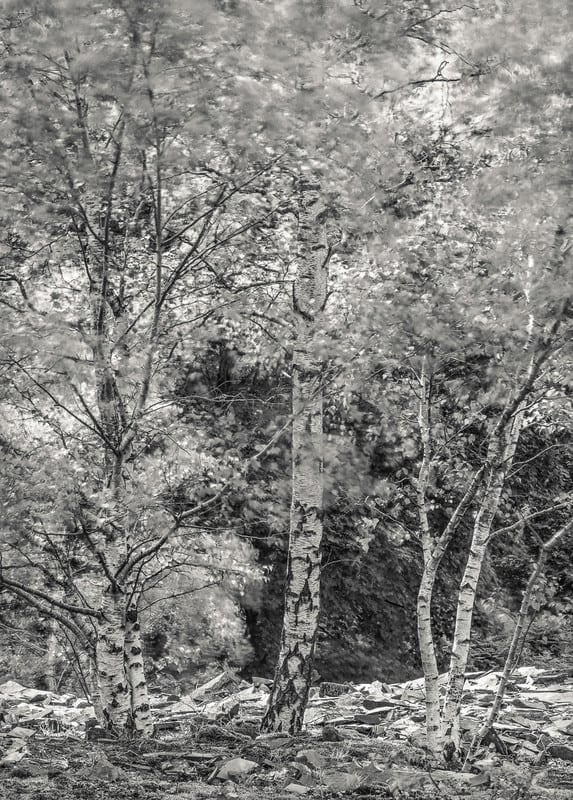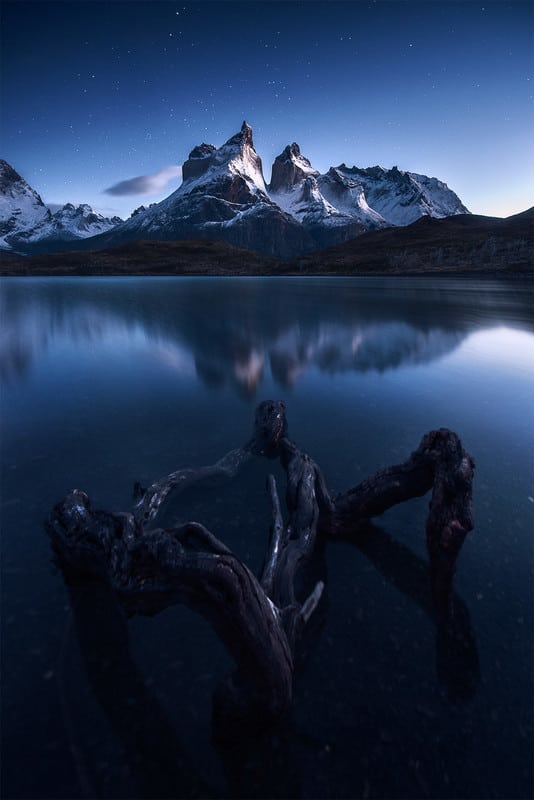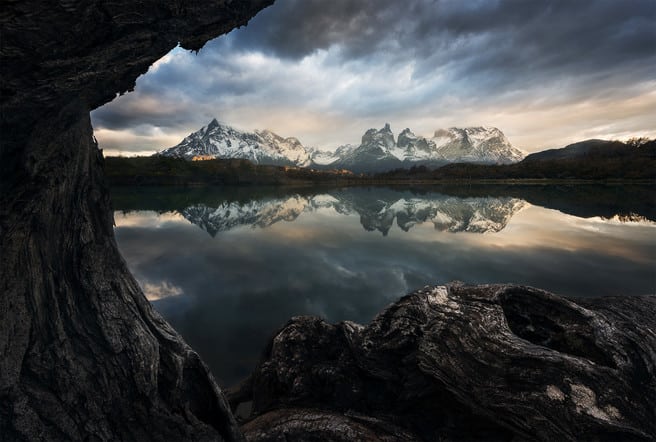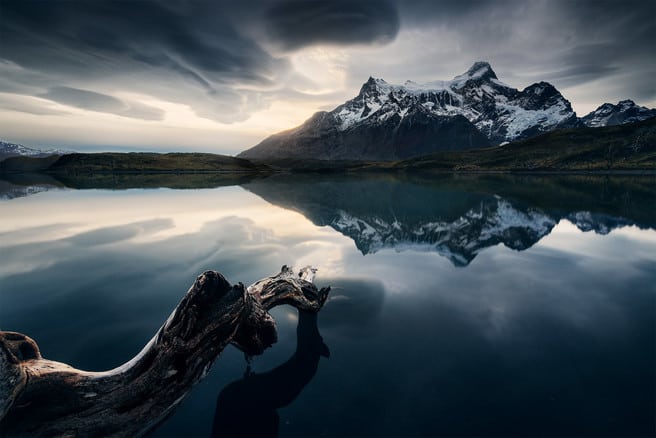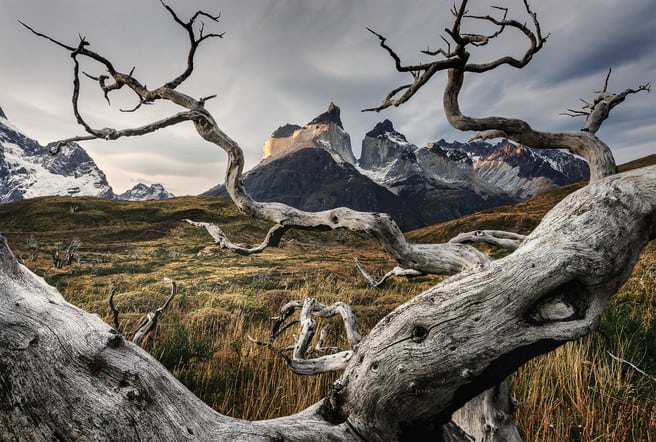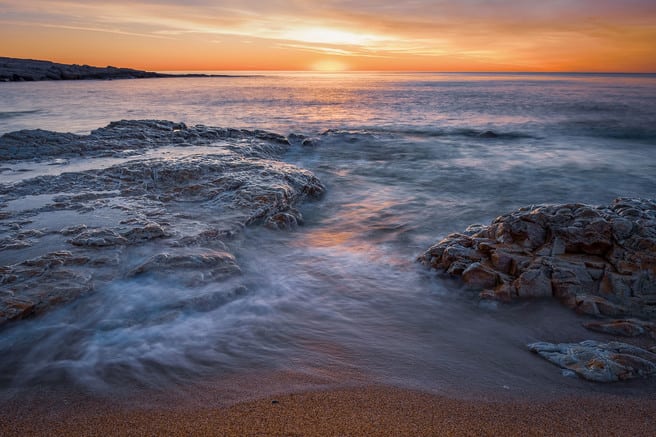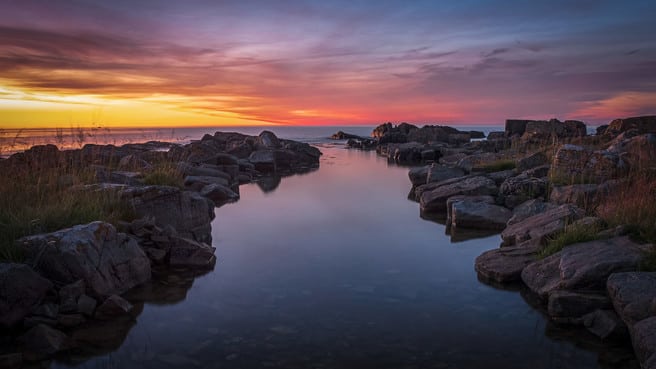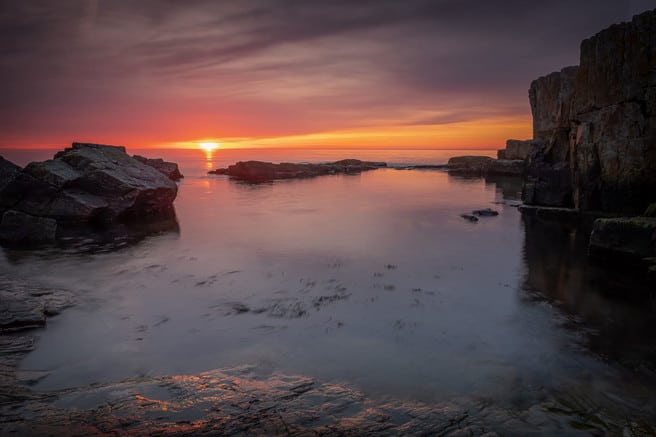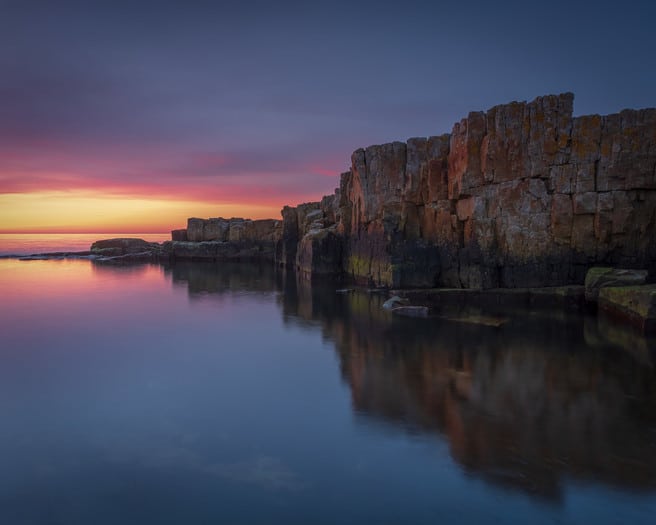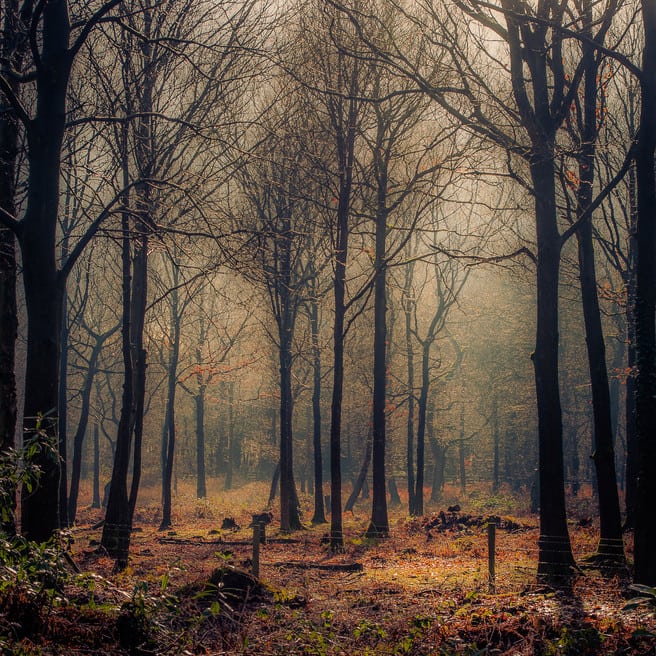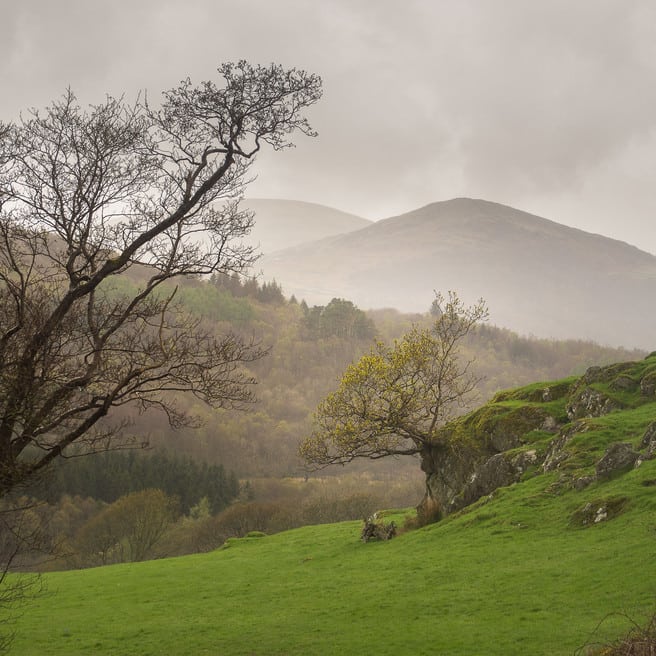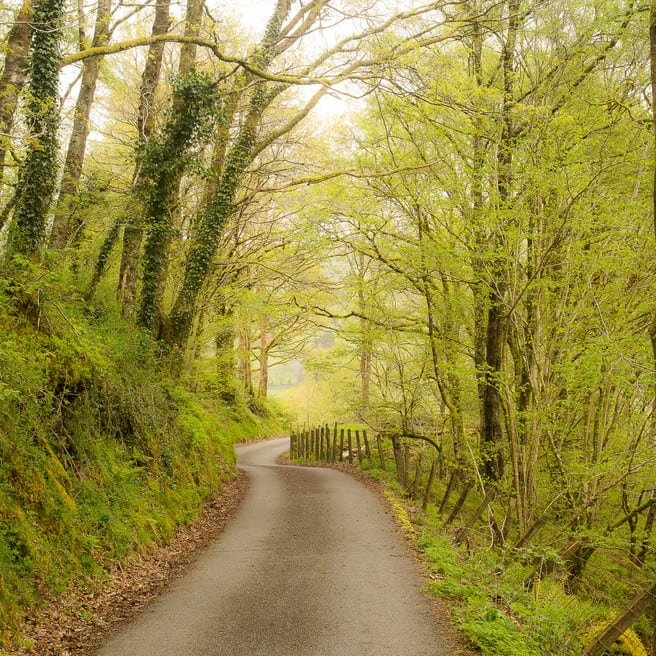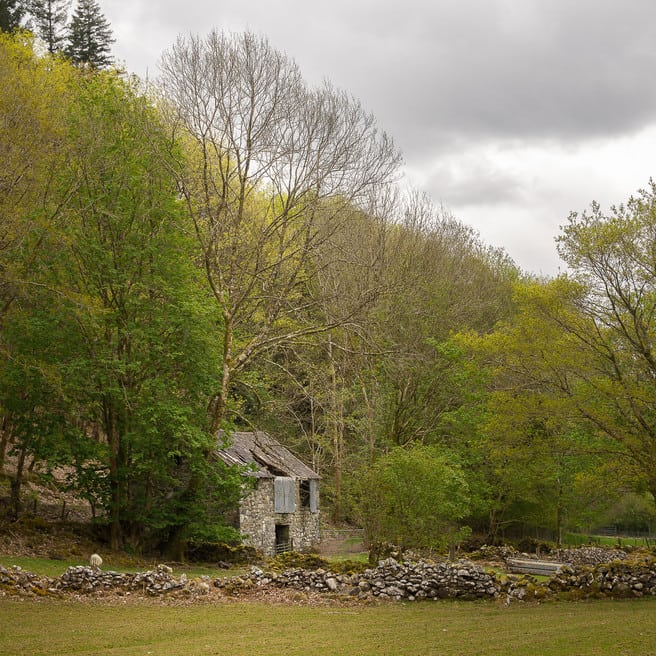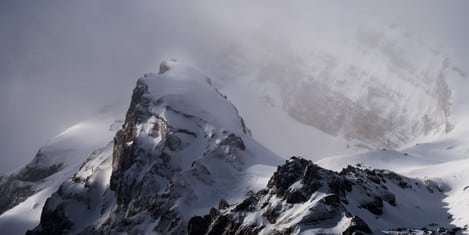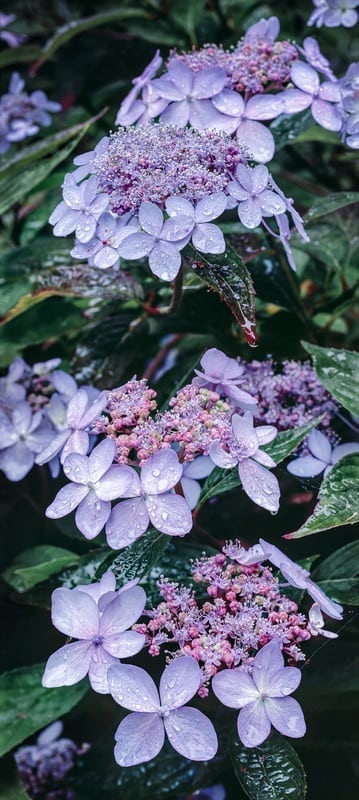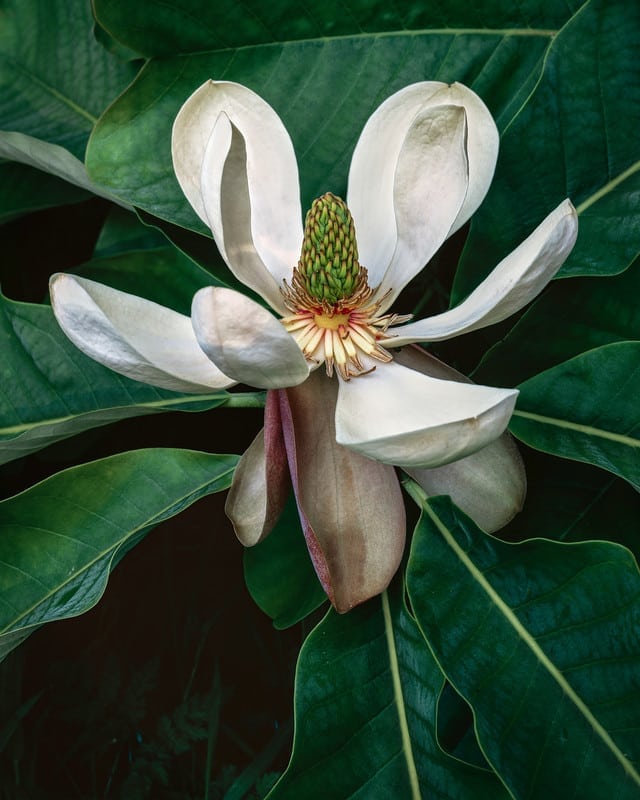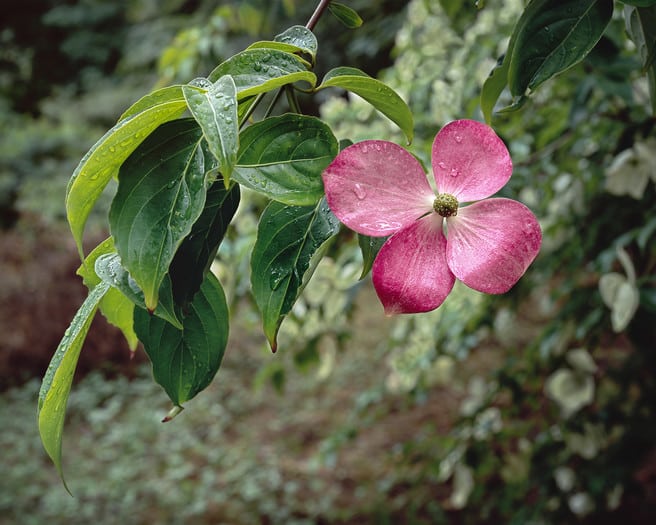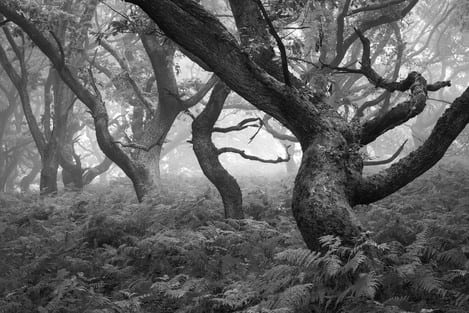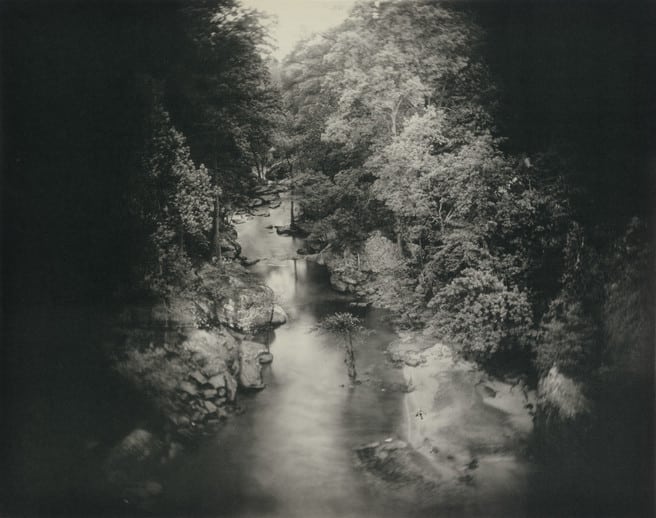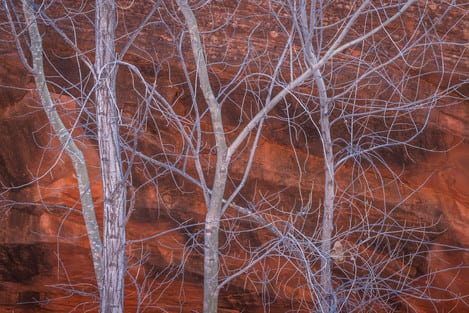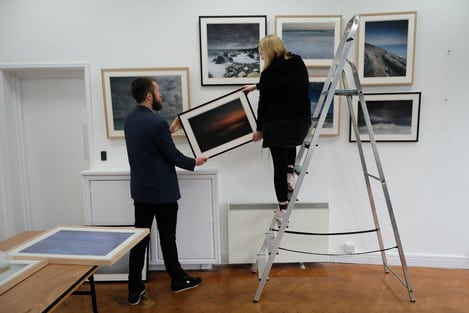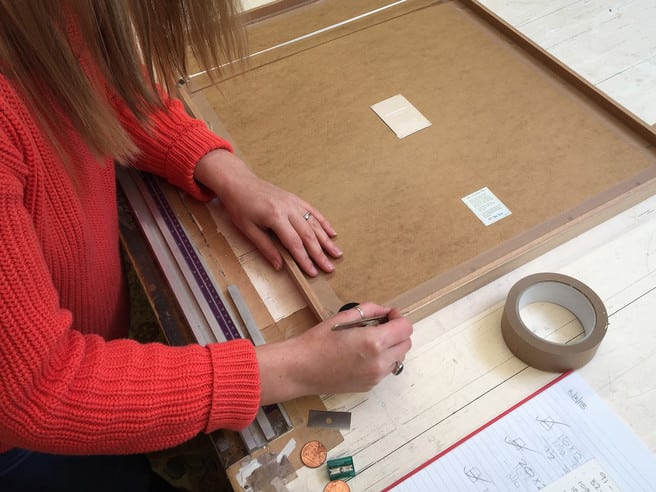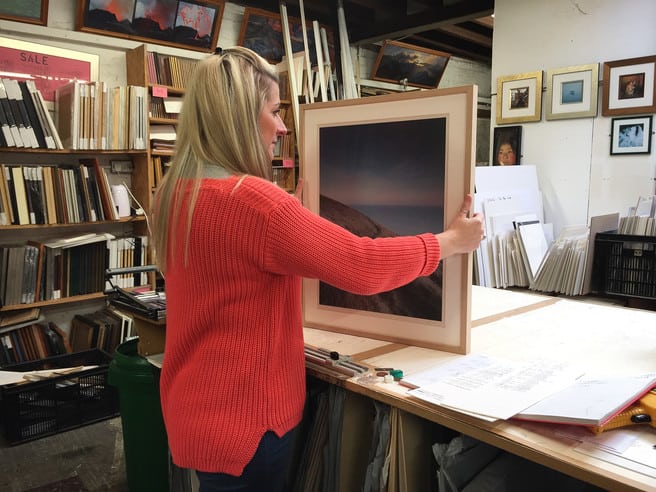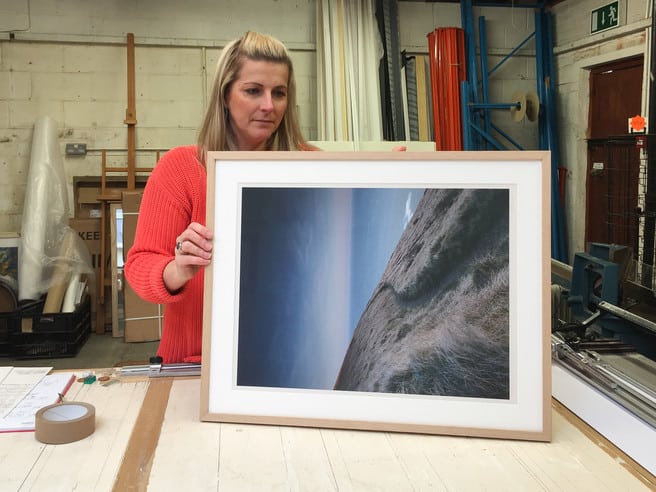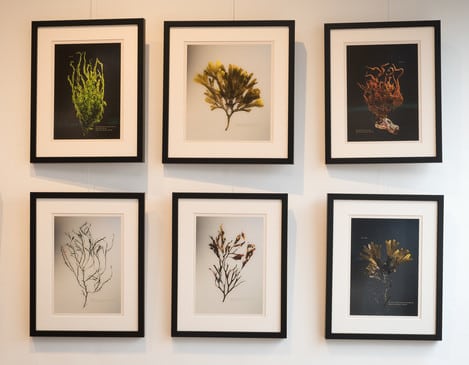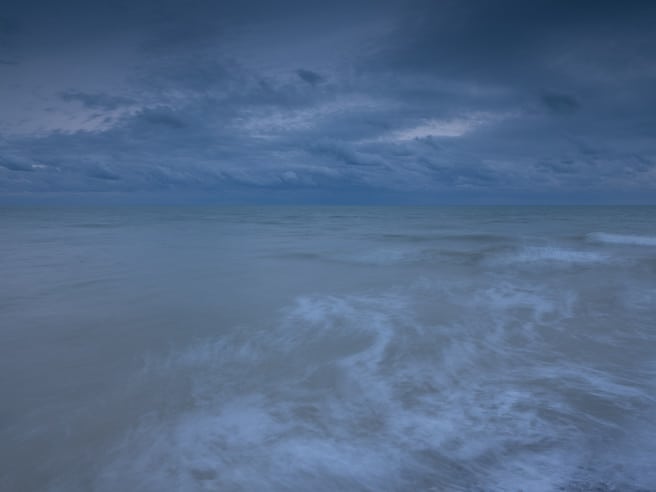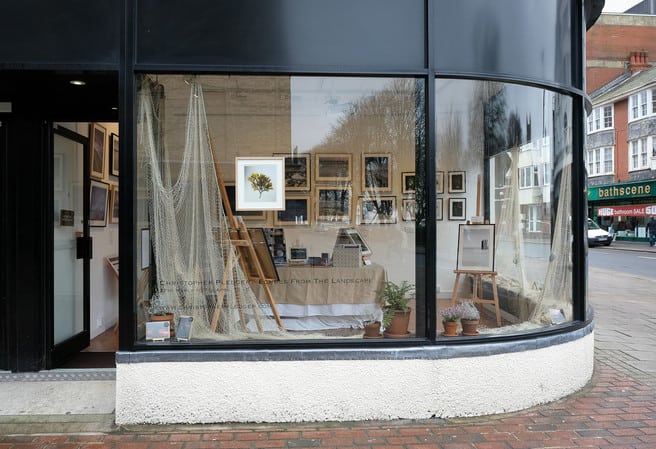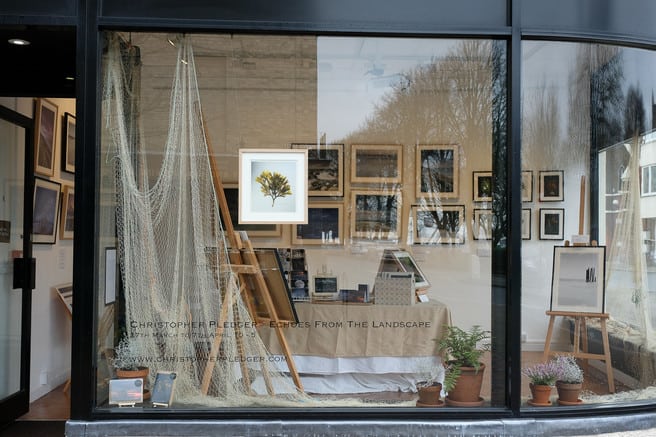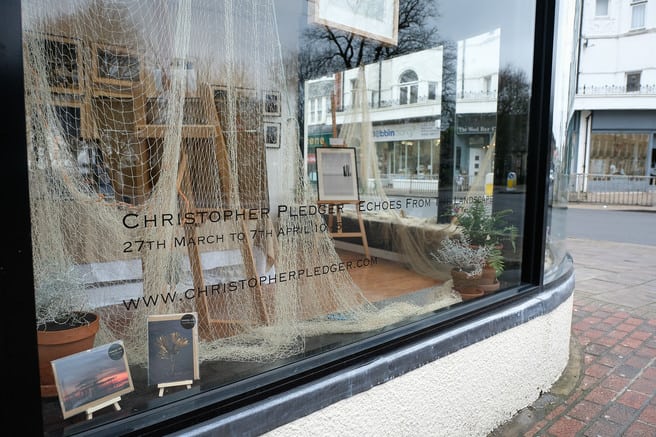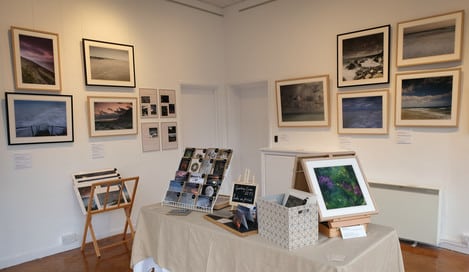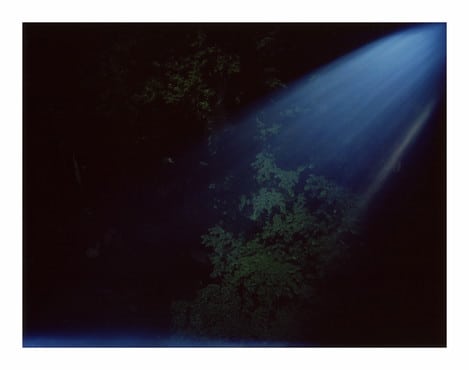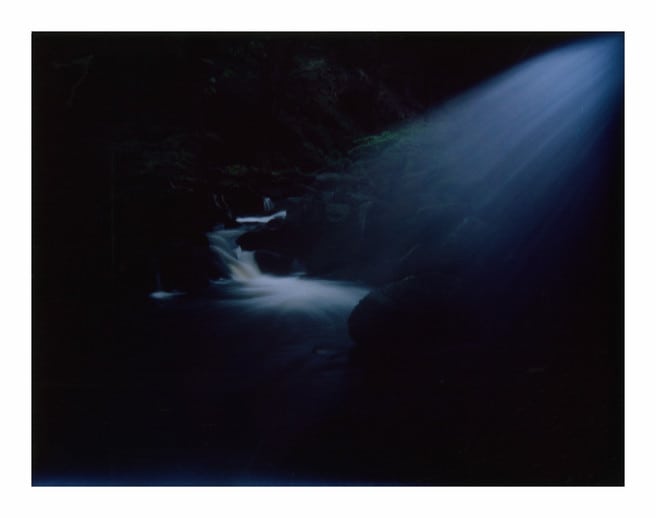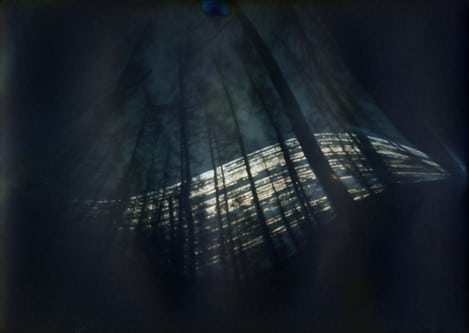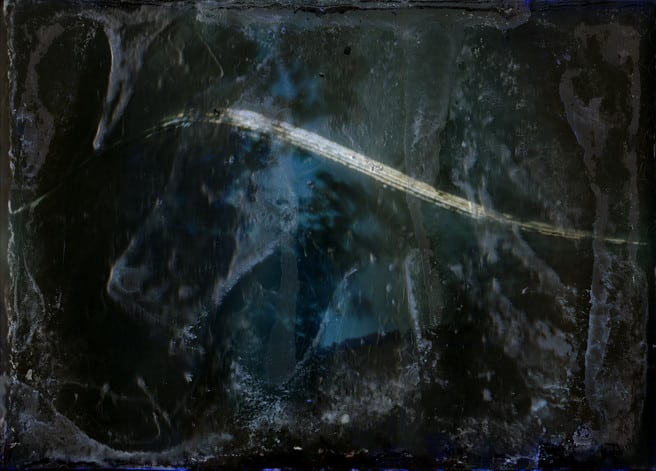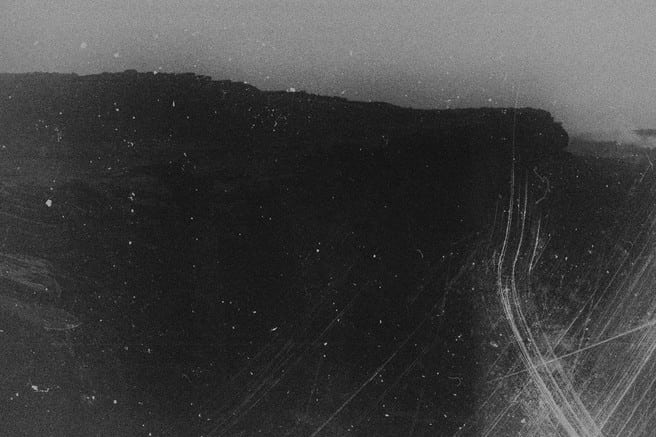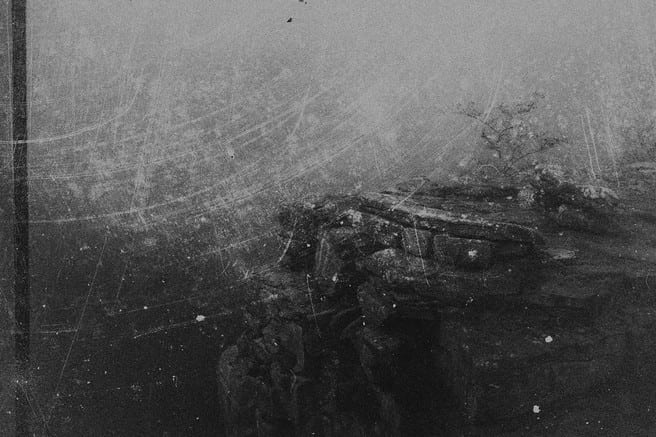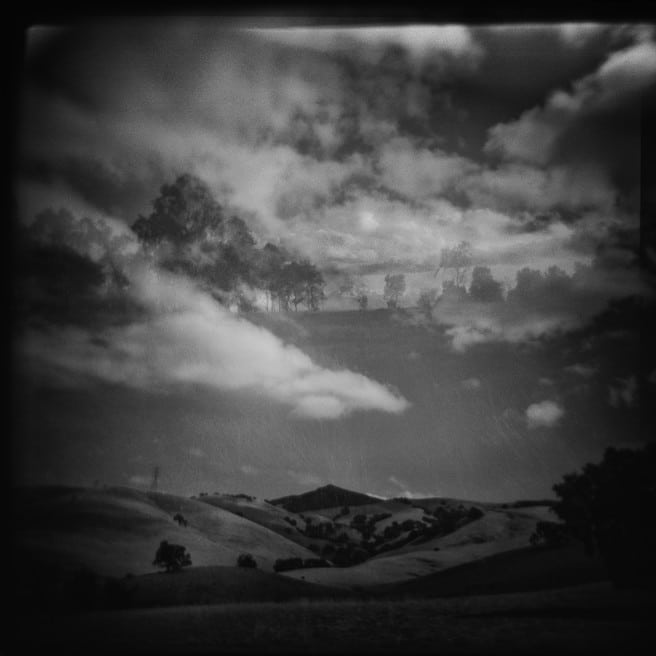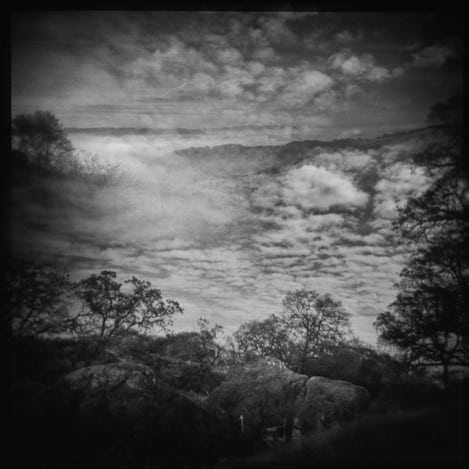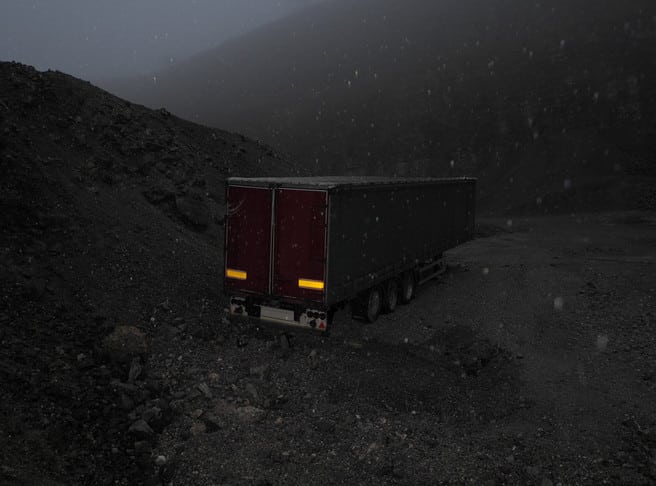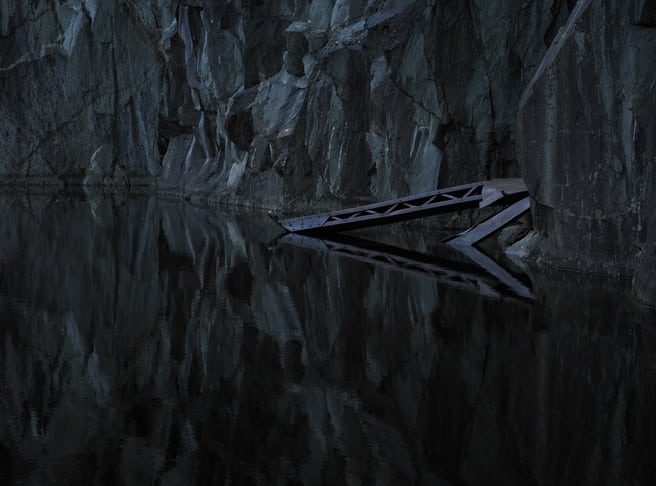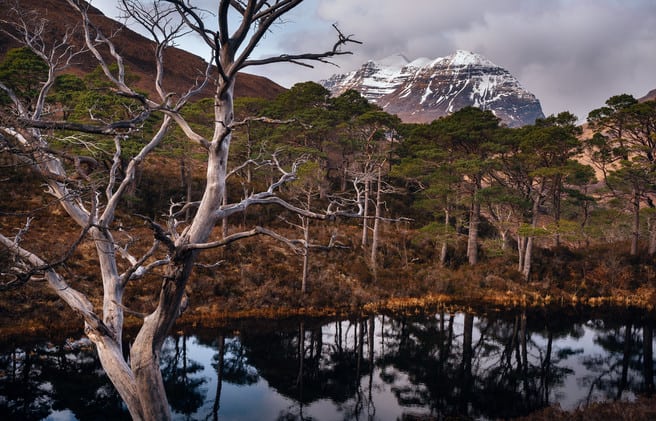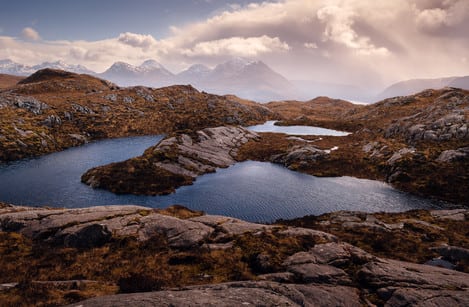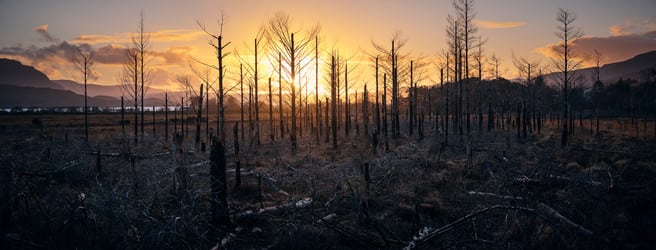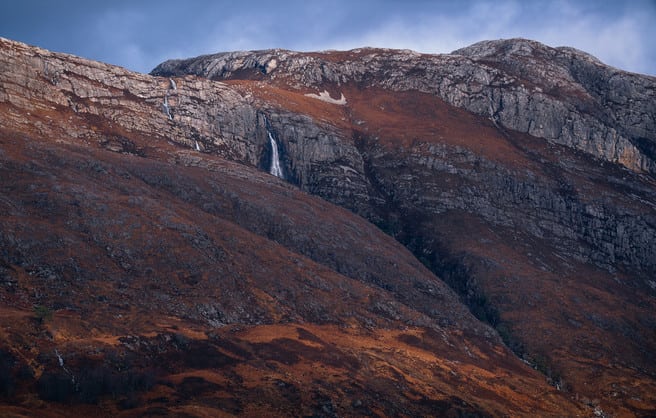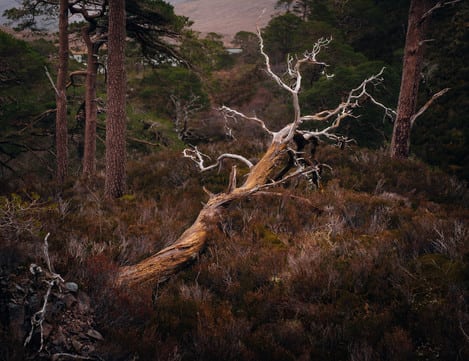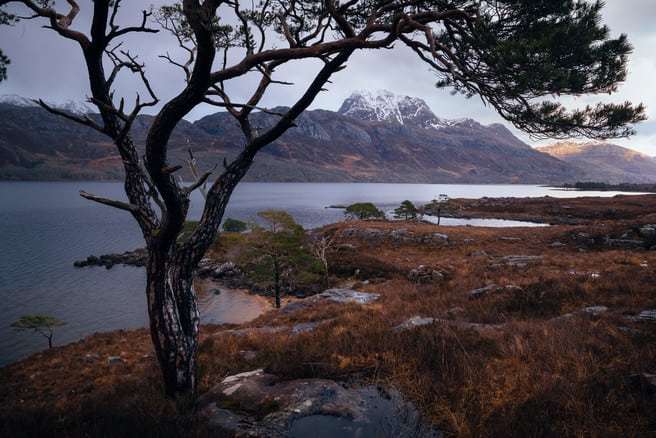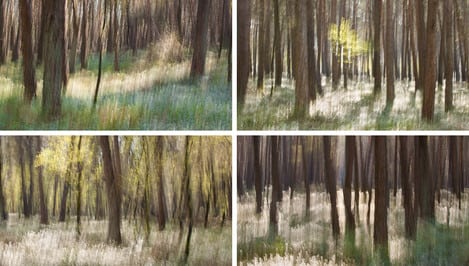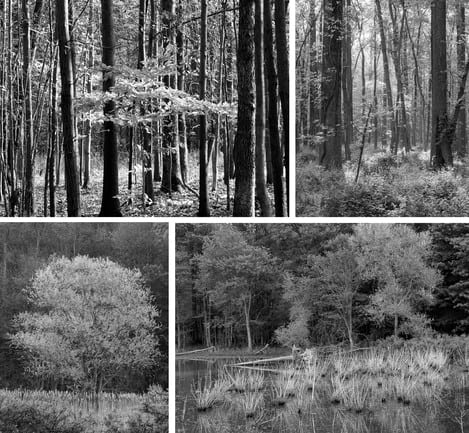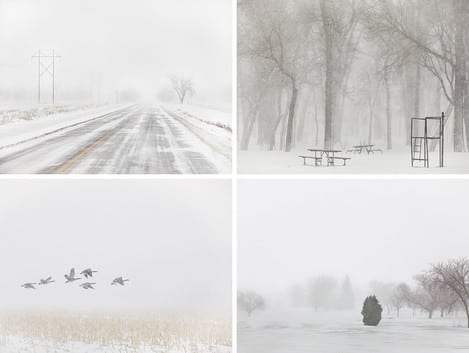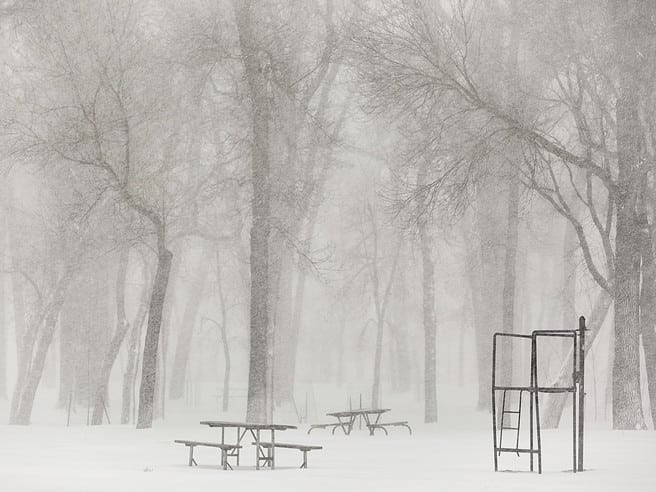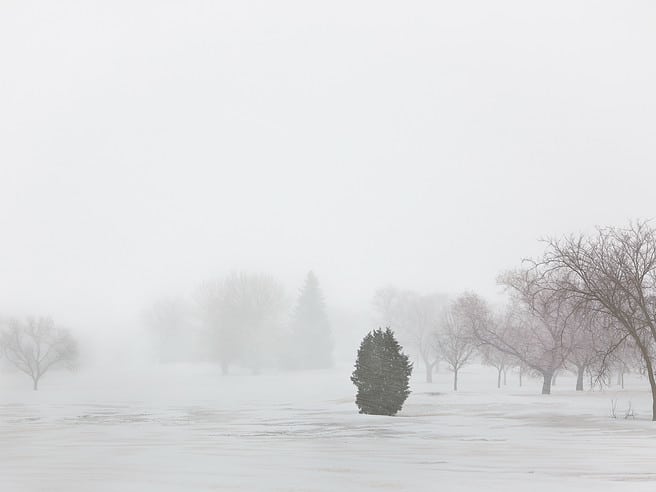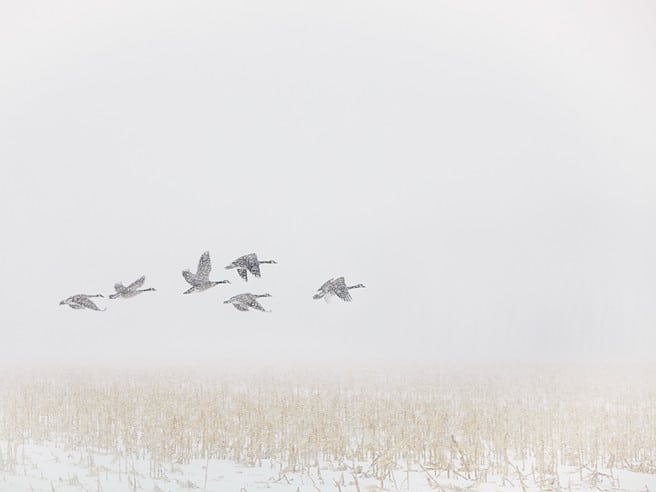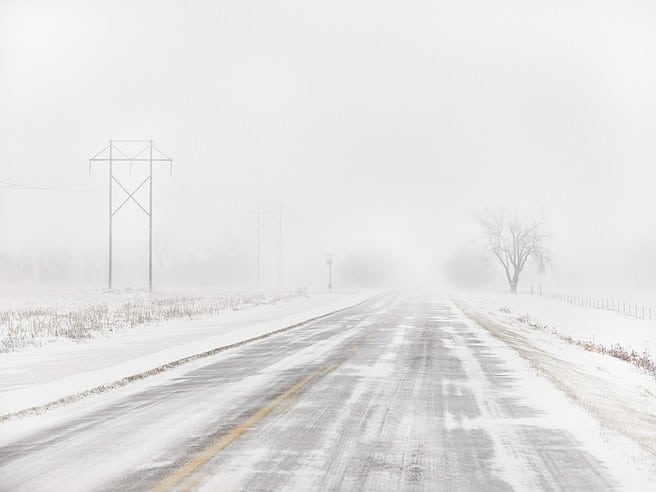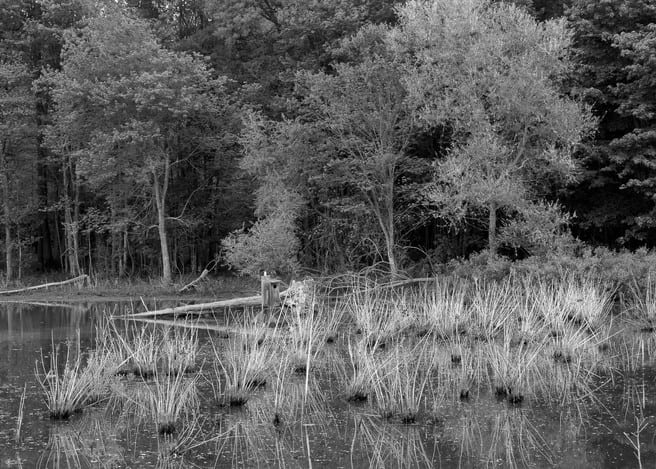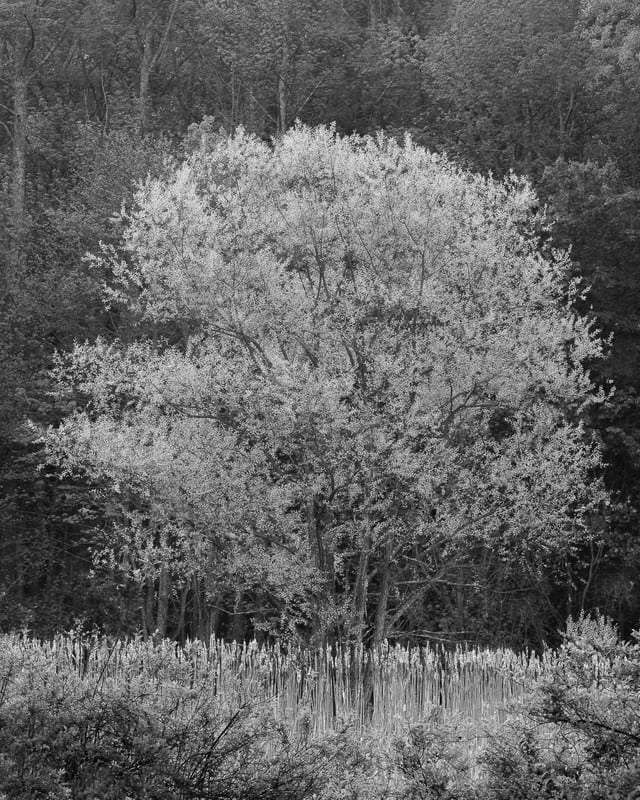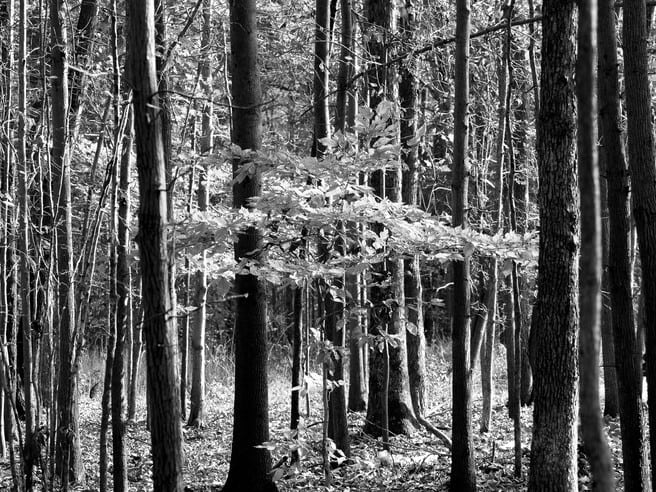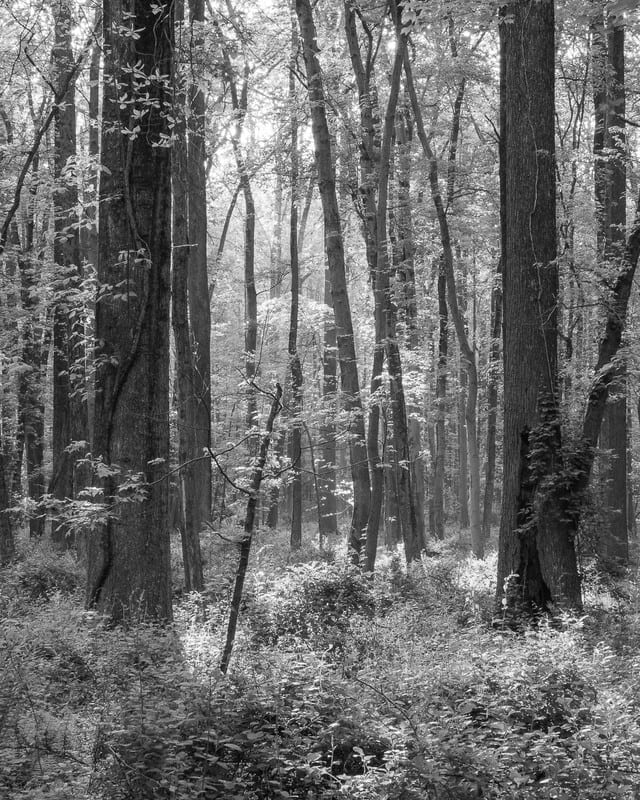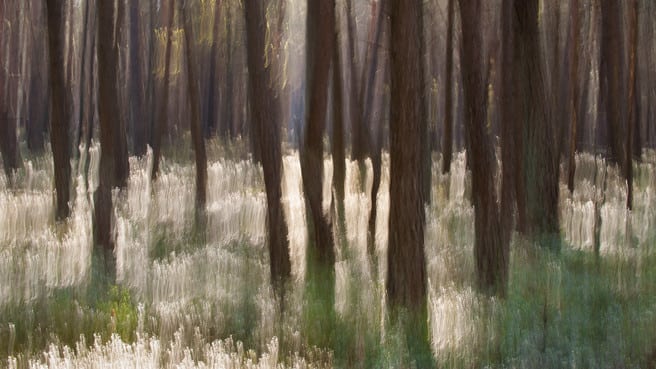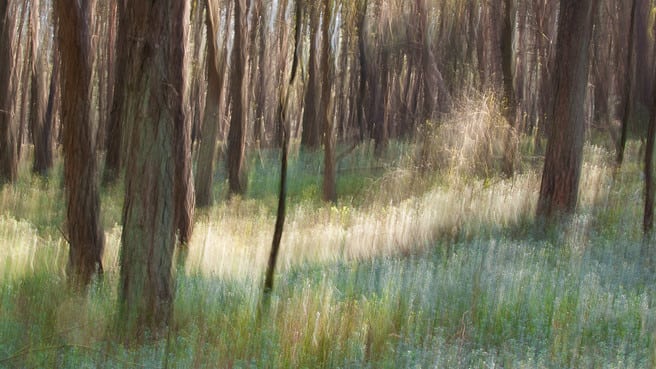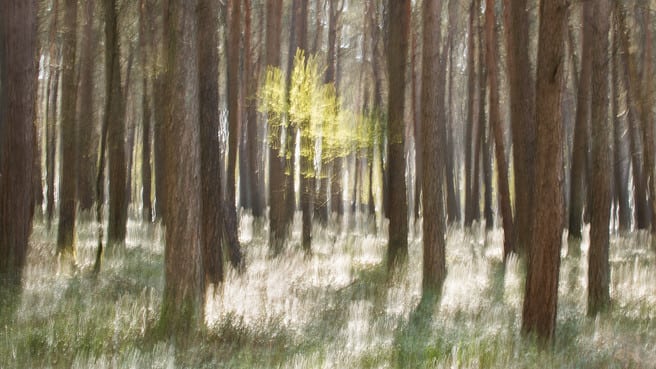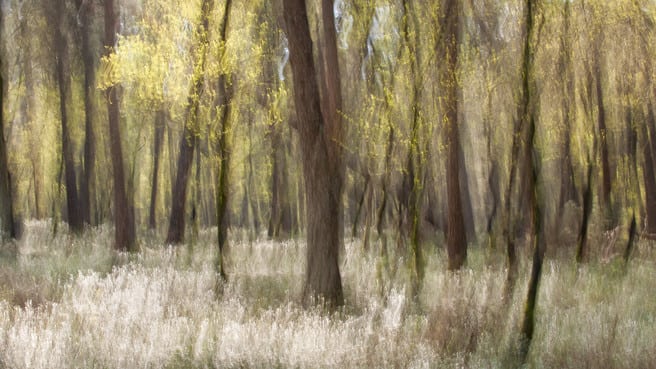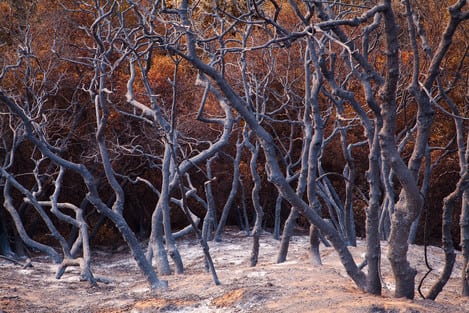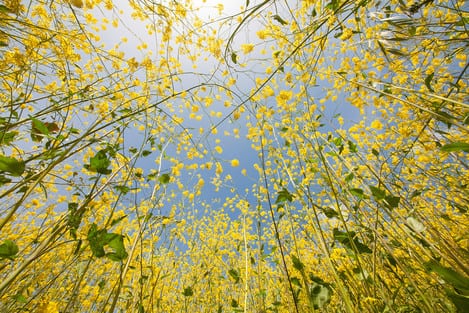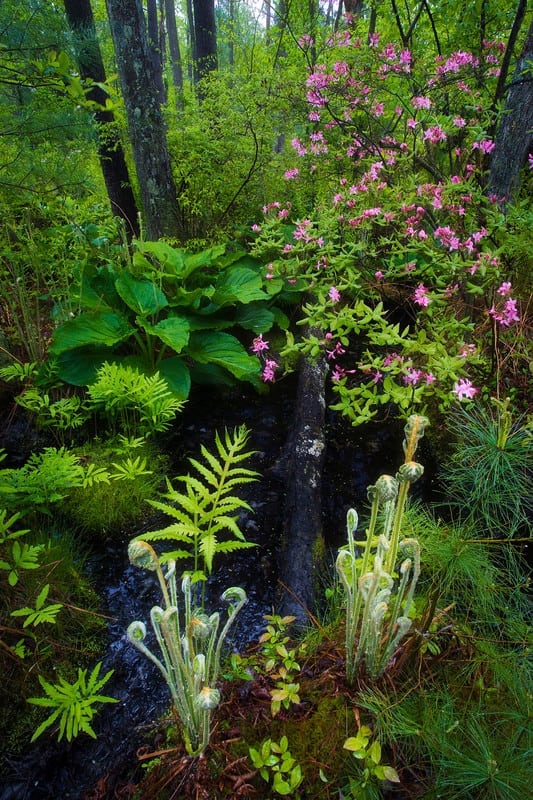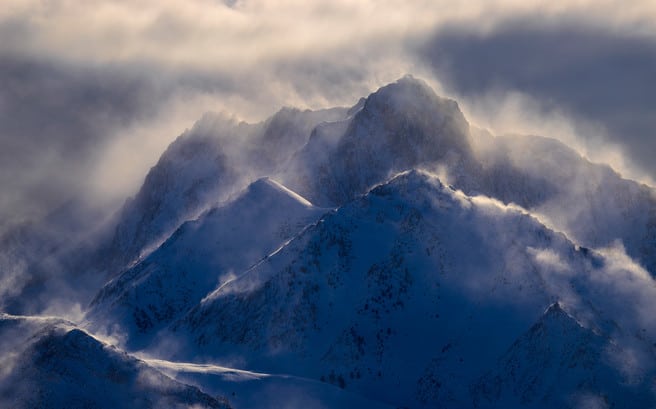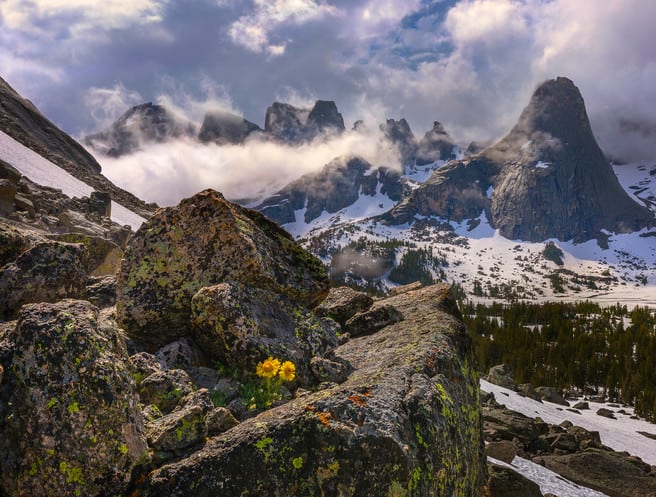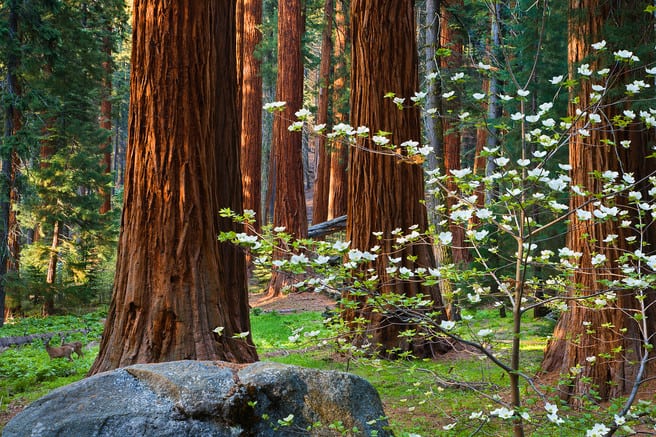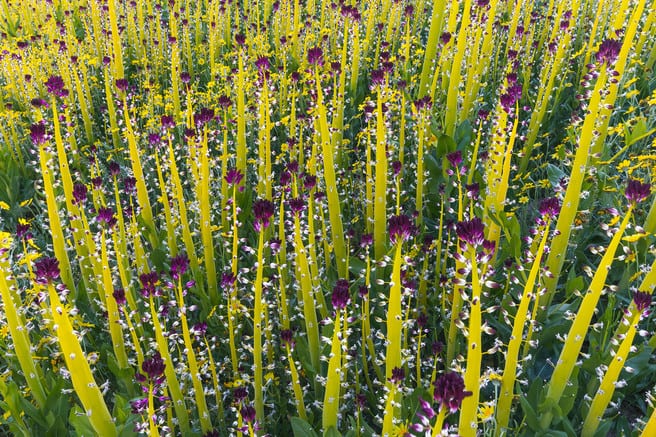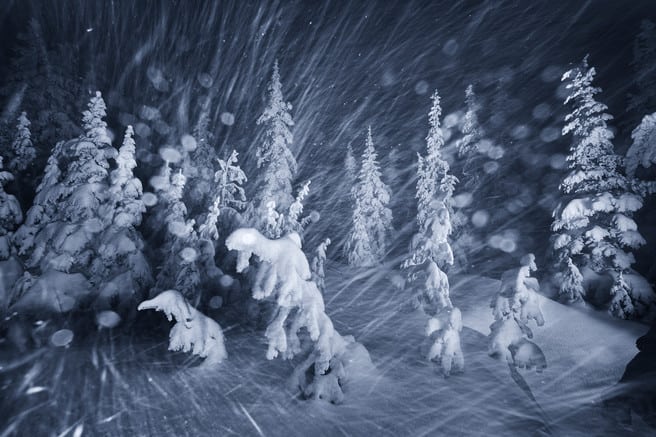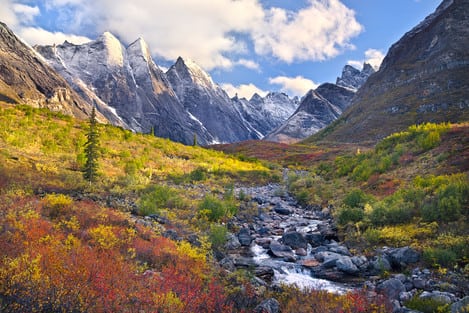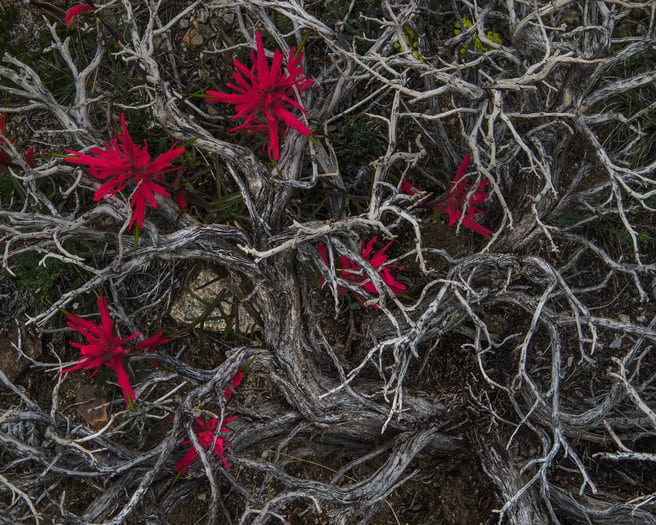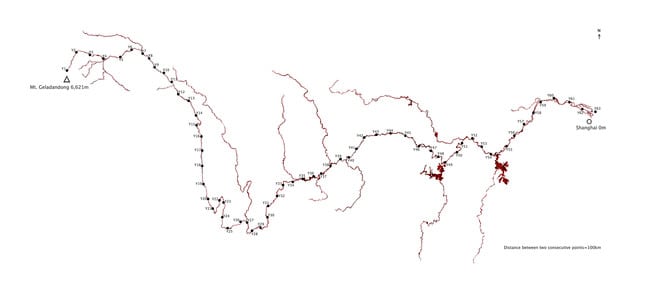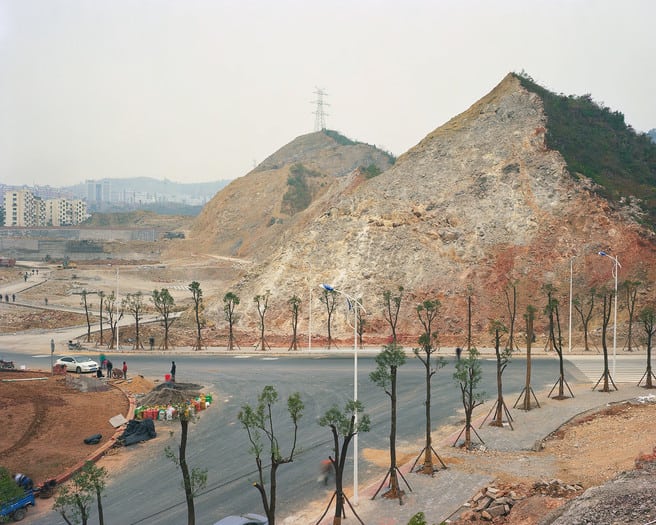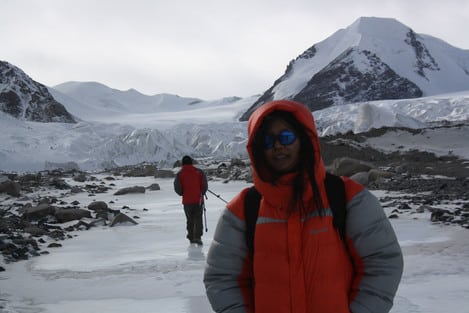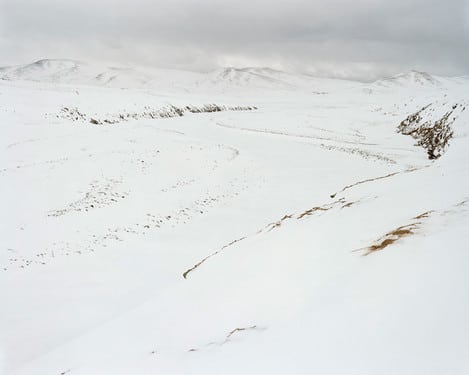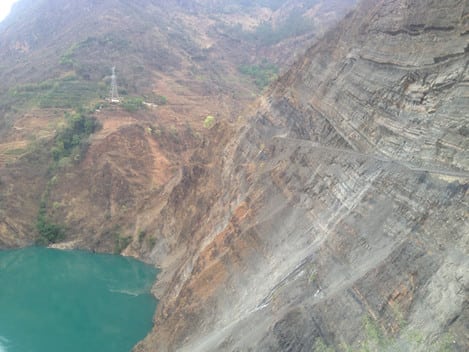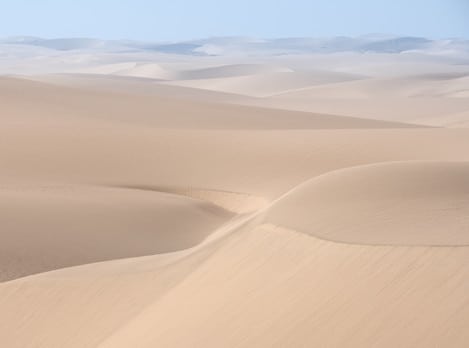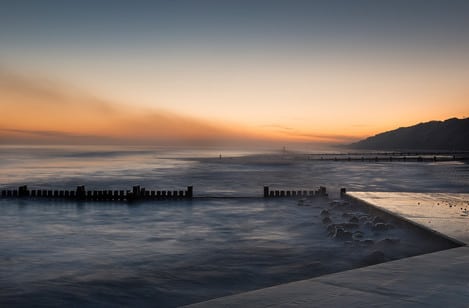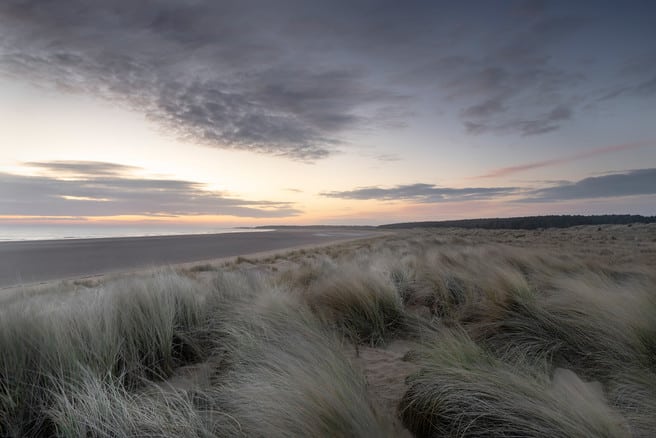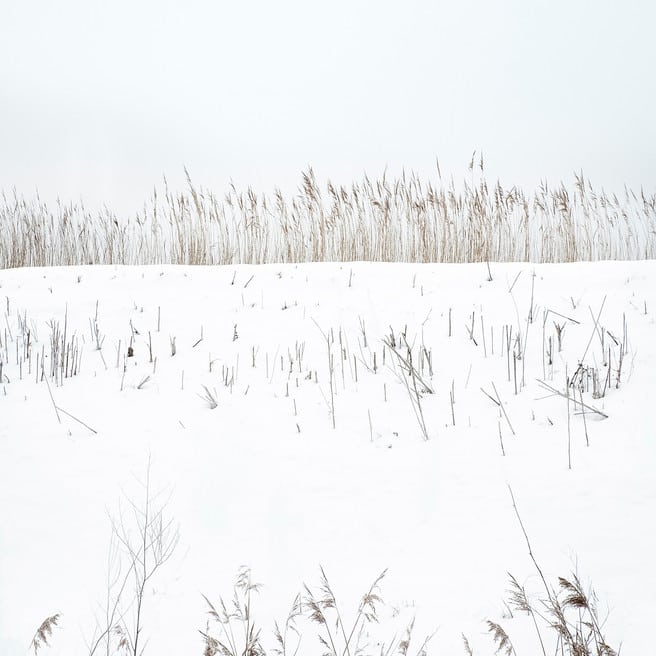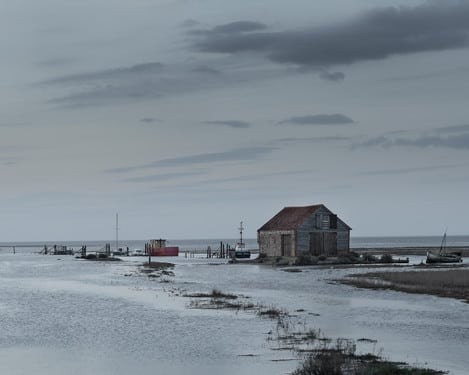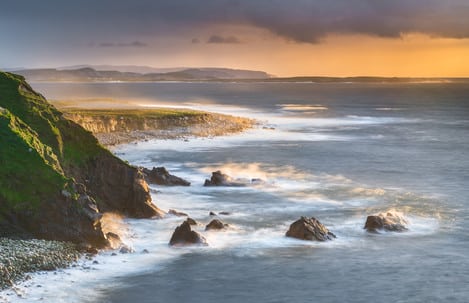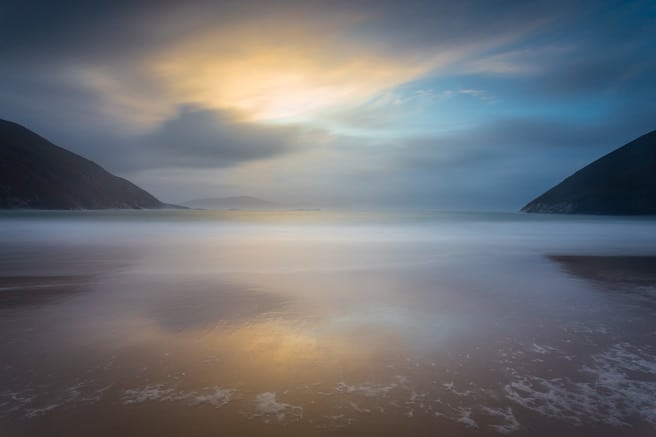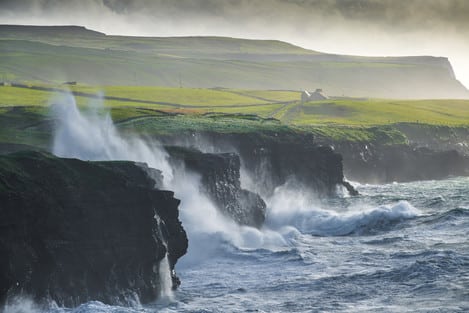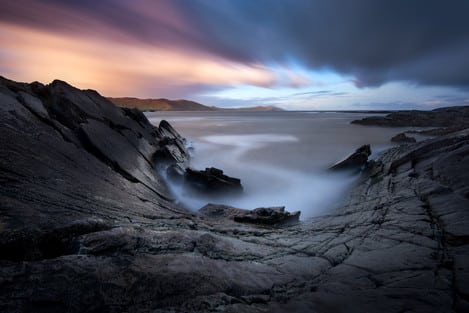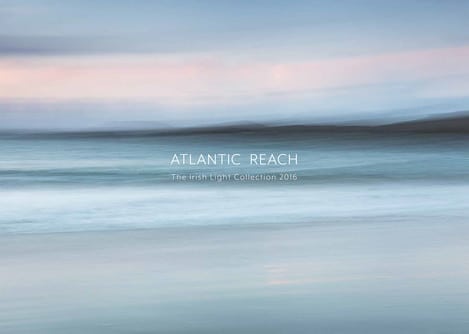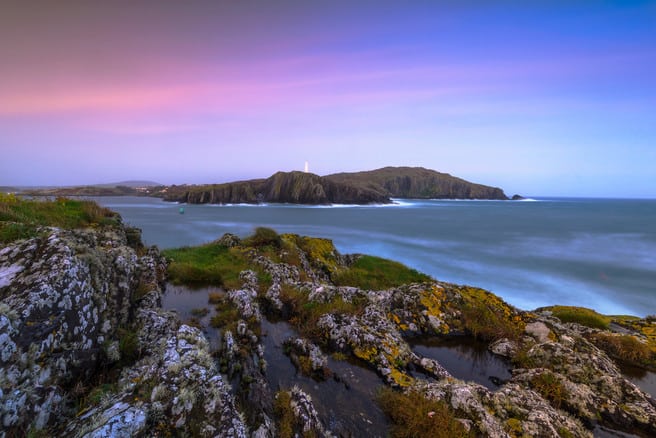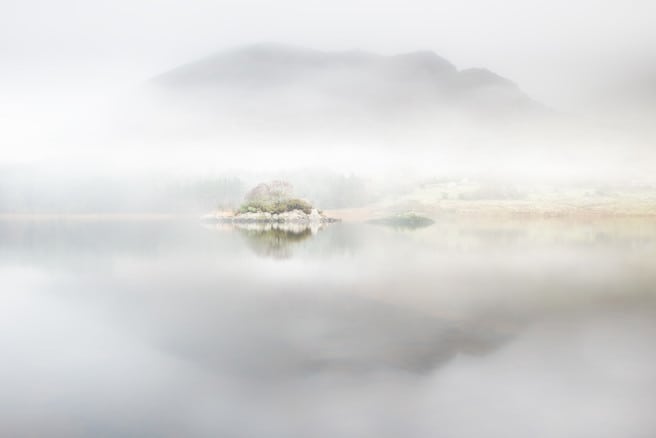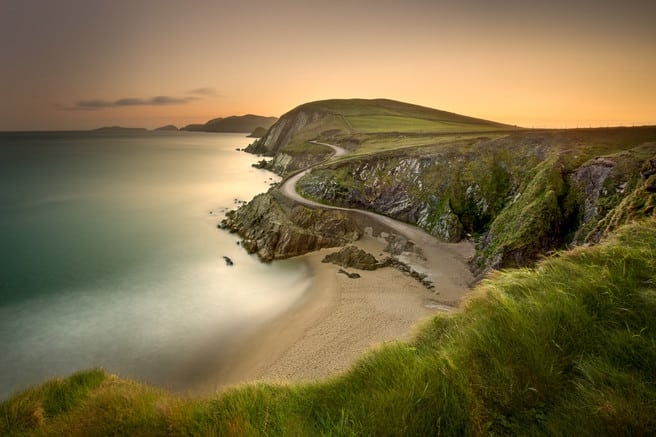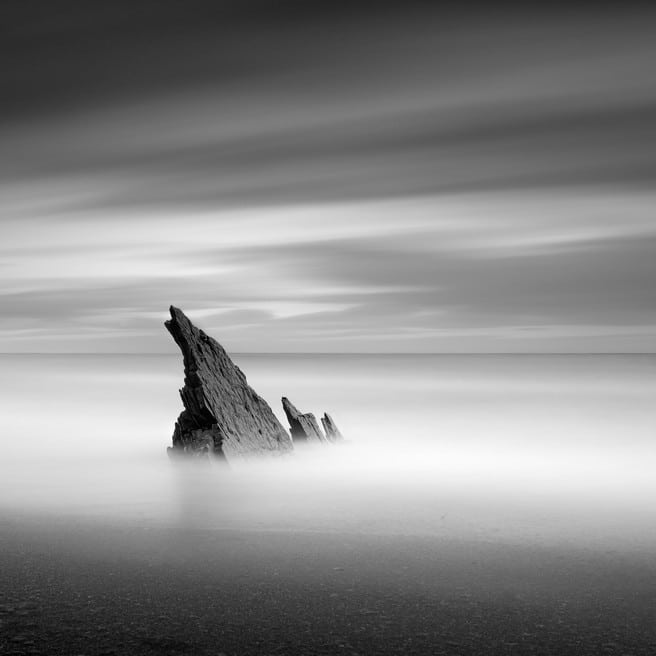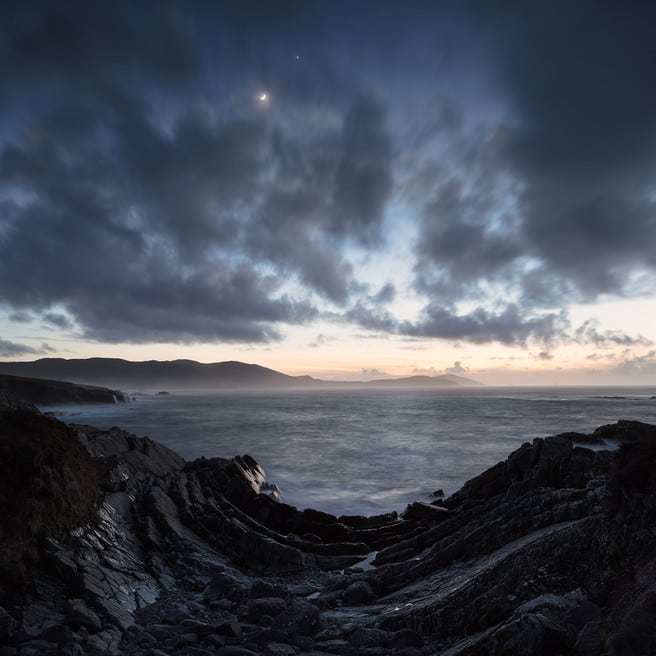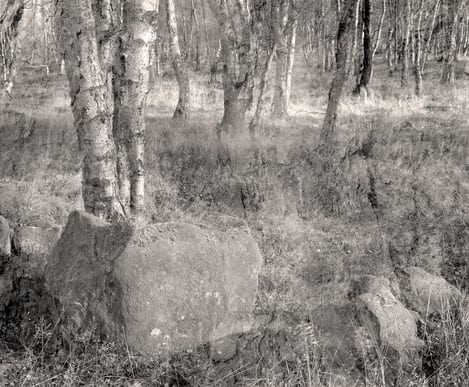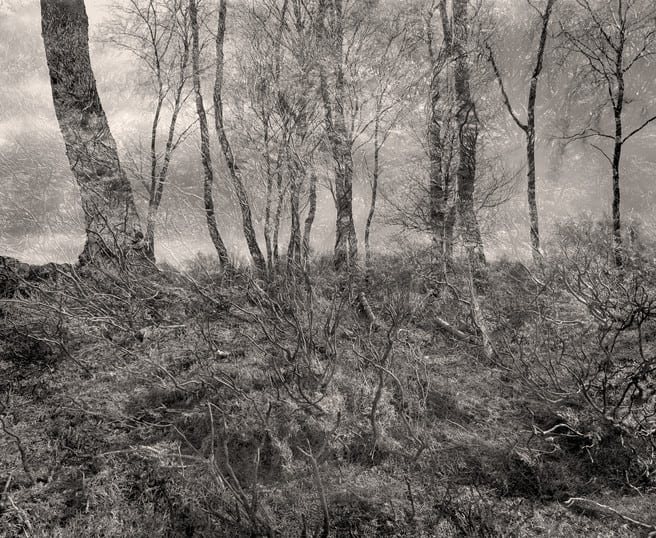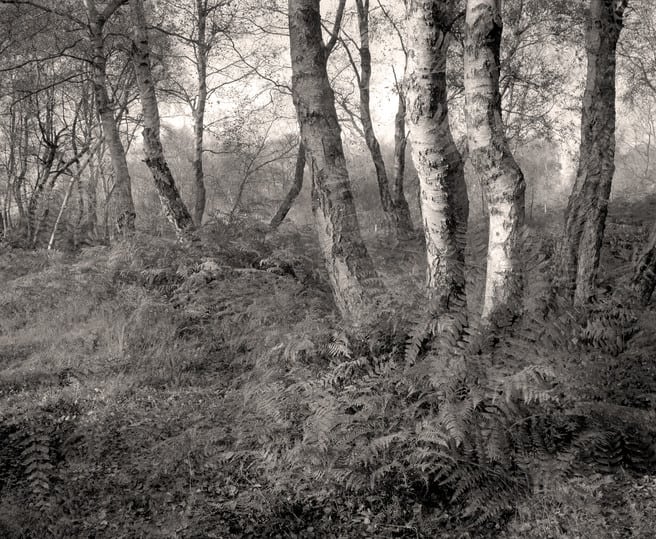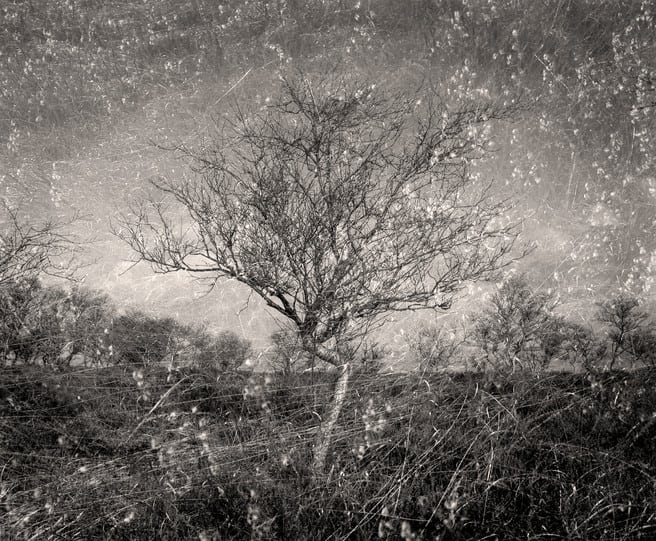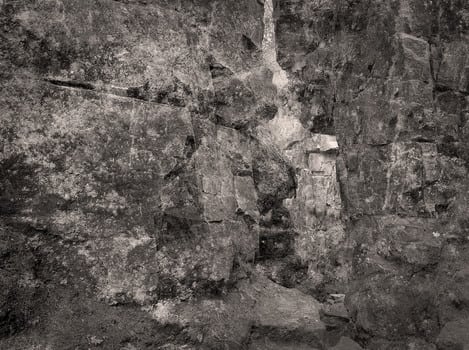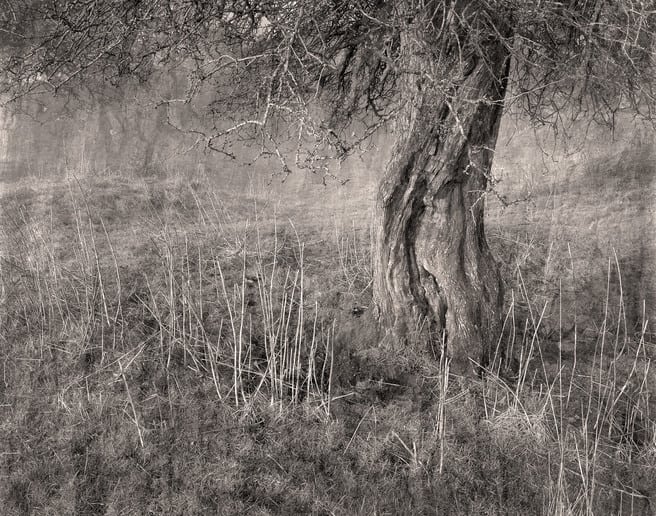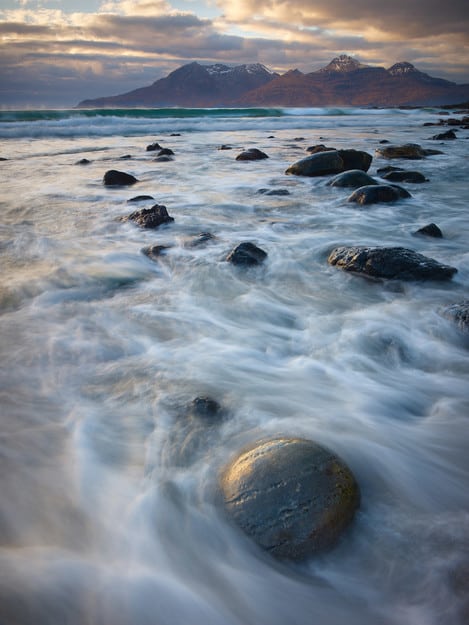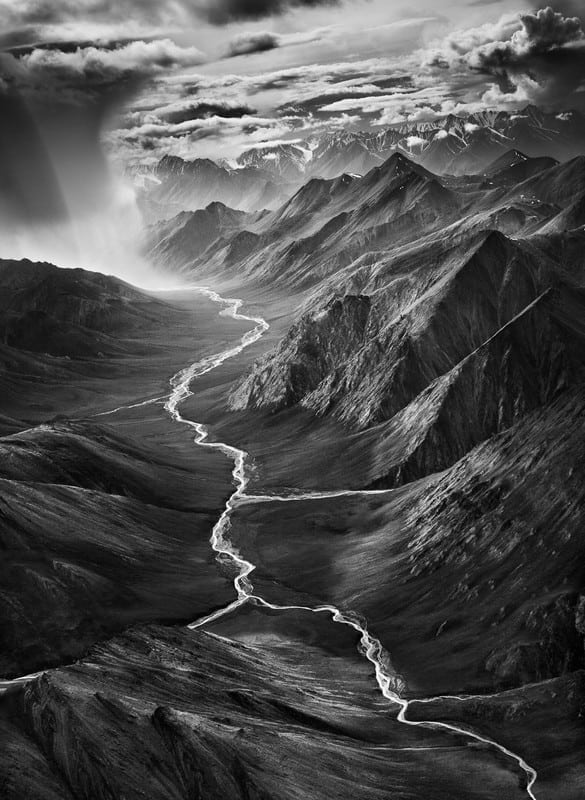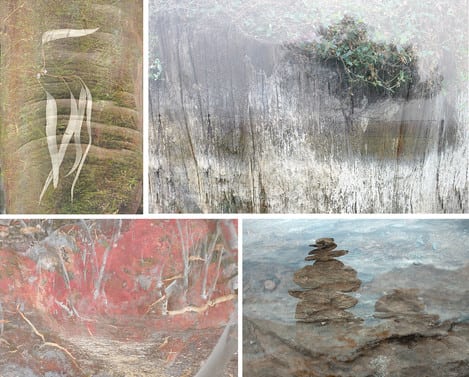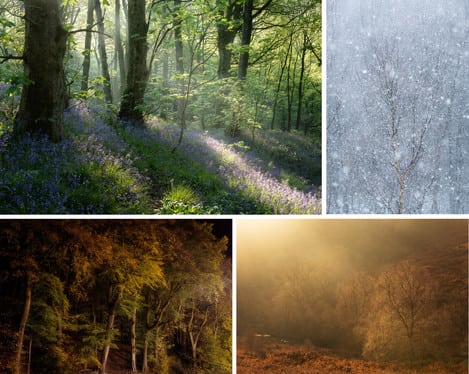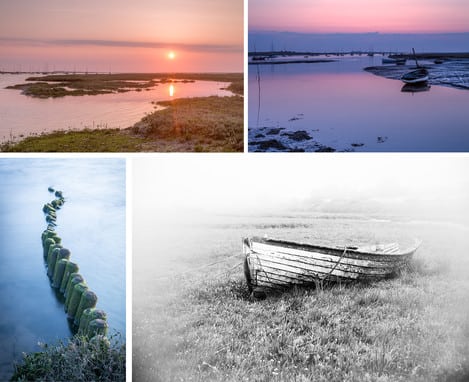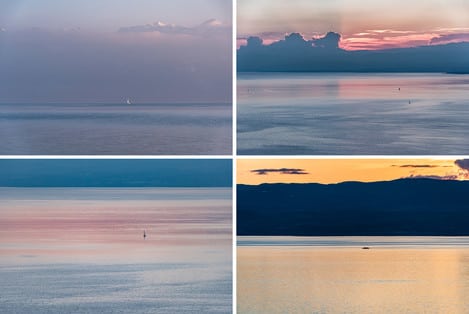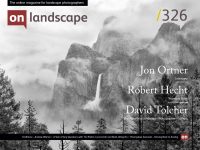End frame: Chongqing XI, Chongqing Municipality by Nadav Kander
Living in the beautiful Yorkshire Dales, a large part of what I shoot could be considered quite traditional landscape photography. When it comes to my favourite images of other photographers though and the works I find most awe inspiring my tastes are a little more eclectic. I find I am often drawn to images that have a cinematic quality, either in the tone or lighting, with atmospherics or the epic nature of the visual. But above all, what I think captures me is the narrative. Although I am drawn to a cinematic feel, I love the still image as it allows the viewer the freedom to create their own story from what is in the scene.
An image I believe demonstrates many of these qualities and a favourite of mine is ‘Chongqing XI, Chongqing Municipality’ by Nadav Kander. It is part of his award-winning series ‘Yangtze, The Long River’. Captured over several trips to China in 2006 and 2007, this body of work documents the people and landscapes along the banks of China’s largest and most significant river as he followed it upstream from the coast in the East to close to its source in Qinghai Province in the West.
A stunning composition, this photograph represents the powerlessness of the common people against the authority of the state and its continuous drive for development often at any cost.
In it we see several people, small in the frame, standing on a large rock slab by the edge of the water. In the background, huge cranes perch precariously on the unfinished arch of what I believe is the Chaotianmen Changjiang Bridge, dwarfed by its immense size. The river is so wide that the far bank has disappeared into the haze. The surface turbulence an indication of the sheer volume of water flowing by.
Looking closer at the foreground a series of pools in the rock draw the eye to the group of men fishing on the bank. The arc of their traditional nets mimics the arc of the bridge. Nets, the design of which has likely remained unchanged for generations, are juxtaposed against the new construction taking place in in the background. A woman stands alone staring off upstream. A mask covers her nose and mouth to protect her from the smog. In the distance, having left his clothes and shoes piled neatly on the shore a figure has waded out into the water with a small rod.
For these people, the landscape that they view today is so immensely different to the one their great grandparents would have seen. Like previous generations, they still use this historic river to provide sustenance but now they face a potential risk to their health due to the heavy pollution present in the water.
Nadav Kander is perhaps best known for his landscapes, portraits and nudes. He has taken portraits of many well-known people and celebrities possibly most notably his series ‘Obama’s People’ for the New York Times and his portrait of Donald Trump on the cover of Time for their ‘Person of the Year 2016’. He was born in Israel in 1961, and at an early age moved with his parents to Johannesburg, South Africa where he lived until his mid-twenties. It is also where he got his first camera and began to photograph. He left South Africa in 1985 for London where he still lives today.
Do you have an image that you want to write about? We'd love to hear from you! Please get in touch to chat further!
Subscribers 4×4 Portfolios
Welcome to our 4x4 feature which is a set of four mini landscape photography portfolios submitted from our subscribers. Each portfolios consisting of four images related in some way.
Submit Your 4x4 Portfolio
Interested in submitting your work? We're on the lookout for new portfolios for the next few issues, so please do get in touch!
If you would like to submit your 4x4 portfolio, please visit this page for submission information. You can view previous 4x4 portfolios here.
Adriana Benetti-Longhini
The Altopiano di Asiago
Chris Dale
Dark Woods
Sarah Strickler
Southern Highlands
Goran Prvulovi
Sunset Festival
Southern Highlands
I finally saw the native azaleas and rhododendrons blooming in the wilds of the southern Appalachians this past June. I travelled from my home in northern Virginia, just outside Washington, DC, about 400 miles southwest to where the borders of Virginia, North Carolina and Tennessee converge. Guided by members of the azalea and rhododendron societies, who have been visiting these mountains for a couple of decades to inventory and monitor the wild azaleas and rhododendrons, I was able to experience some of the magic of this landscape.
These images were taken in the Roan Highlands, straddling the North Carolina and Tennessee border, and from the Blue Ridge Parkway nearby. Roan is known for its Flame azaleas (Rhododendron calendulaceum), blooming pale yellow to deep orange, stands of purple Catawba rhododendrons (Rhododendron catawbiense) and open balds (high meadows) on mountain crests and ridges. The Blue Ridge Parkway is a beautiful 469-mile road of smoky-blue mountain vistas, winding southward from Rockfish Gap, west of Charlottesville, Virginia, to just past the Smoky Mountains in North Carolina.
Sunset Festival
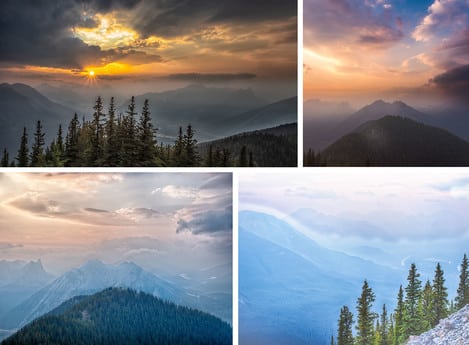
While the Canadian Rockies are known for their splendid vistas, few views are as beautiful as the top of Sulfur Mountain. Located in Banff National Park, Alberta and requiring a lengthy gondola ride to the top, the 7600 ft. elevation allows you to see some of the most beautiful sunsets that mountain range has to offer. For the past couple of months, the Sunset Festival has been a special celebration of Banff’s remarkable sunsets, with the entire facility atop of Sulfur Mountain getting renovated and transformed into the ultimate viewing pleasure.
A struggle I had to deal with was the raging forest fires burning in Western Canada throughout the whole summer, leading to poor visibility and a general haziness that made shooting almost impossible. On our way to Banff, everything seemed to take a turn for the worst as, in addition to the smoke, it started to rain. I wasn’t sure what to expect nor did I keep my hopes up, but miraculously, when we arrived at the mountain top, the clouds parted and a sliver of the beautiful sunset managed to shine through, just begging to be captured. Although normally the smoke alongside the mountains would prove a hindrance, the perfect combination of sunshine and elevation ended up producing some pictures that would be impossible to take otherwise.
Although stormy weather threatened to ruin my trip, the perfect opportunity presented itself, and for the next few minutes, there was a beautiful, peaceful serenity on the mountain top – punctuated only by the shuttering of my camera.
Dark Woods
I've been a lover of woodland photography for several years now, a lot of this has been quite representative colour scenes, but more recently have favoured a darker, mono aesthetic as well as looking closer at detail heavy and more graphical compositions, often with a long lens at a distance to flatten the image.
These dark woodland squares have become an ongoing theme which I'm always on the lookout for when out with my camera.
Altopiano di Asiago
The Altopiano di Asiago or Altopiano dei Sette Comuni, (Plateau of Asiago) is situated in the Veneto region of North Eastern Italy and is a large plateau near the border of the Trentino-Alto Adige/Südtirol regions in the foothills of the Alps.
Asiago is the principal town with a population of roughly 6,500. The town was the site of a battle between Austrian and Italian forces on the Alpine Front of World War I. The Asiago War Memorial seen in my photo of the sheep transhumance, is a World War I memorial located on the outskirts of the town and houses the remains of over 50,000 Italian and Austro-Hungarian soldiers. In Italy the memorial is typically called Sacrario Militare di Asiago or Sacrario Militare del Leiten. Leiten is the name of the hill on which the memorial sits.
There are many traditions on the Altopiano that are fiercely protected by the local population. The most important one being the annual religious rite of the “Grande Rogazione” A tradition handed down for centuries, for over four hundred years. This ritual is celebrated precisely forty days after Easter and consists of a procession that lasts a whole day, in which prayers and thanksgiving songs are performed in Cimbro, the original language of the Asiago plateau.
The region is the origin of the world famous Asiago cheese and is a major Italian DOP (Protected Designation of Origin) cheese. During the spring, summer and autumn seasons the Altopiano of Asiago is a spectacular area for walking, hiking and mountain biking, with more than 500 km of tracks available. During the winter months, snow conditions permitting, it becomes a destination for winter sports, particularly cross- country skiing.
Faroese Visions
The Faroe Islands, an archipelago of 18 self-governing islands but belonging to Denmark, are located at around 62 degrees N in the North Atlantic, approx. 300km north-west of Scotland and some 430km south-east of Iceland. Benefitting from the Gulf Stream, the climate is relatively mild but rather wet and at times very stormy. We certainly experienced some very windy times and when coupled with driving rain, photography was a challenge, to say the least! With a population of a little over 50,000, it’s not a crowded place.
The Faroese economy is about 98% fishing, which implies that tourism is still a very minor activity. Indeed as the tourist brochure says, when you consider the over 7 billion population on Earth, it’s a very small and exclusive group that have been to the Faroes! But in recent years, there’s been growing interest among photographers and some predict that it could experience strong growth as a photographic venue in the coming few years.
The islands are formed primarily from volcanic black basalt and hence as in Iceland, there are sharp jagged ridges and black sand beaches. Spectacular cliffs rise up steeply many hundreds of metres directly from the sea, while small uninhabited islands and sea stacks add to the other-worldly feel of the landscape; add to that stormy skies or colourful light at either end of the day and you have plenty of dramatic subject matter. But of course, seek and ye shall find and other, quietly anonymous cameos are available.
Back in summer 2017 five likely lads were considering where to go and play with our cameras. One of the group, Harvey Lloyd-Thomas, had visited the islands some years earlier and we quickly decided it would be worth visiting before it gets too crowded. Although landscape photography tends to be a solo pursuit, I for one really enjoy the social aspects and camaraderie of getting back in a group in the evenings, sharing experiences and perhaps looking at each others’ pictures on a screen of some sorts. The conversation, comments about composition and processing, seeing just what others have found as subjects all help me to formulate my own approach and extend my knowledge of photography and post-processing. But more than that, these “plenary sessions” also help me to open my personal boundaries on what constitutes subject matter – I’m more likely to go outside my comfort zone the next day.
We pooled our resources and after some research on the Web and seeing the hotel prices, a large AirBnB house seemed the best option for cost, flexibility and comfort. Given all our luggage and camera bags, even a large estate rental car would have been too small and renting a minibus proved to be better value than renting two saloon cars. This gave us plenty of room to comfortably spread out - a boon when sheltering from rain. I was surprised that even though we were booking some 8-9 months ahead, there was already restricted availability of accommodation and minibuses for rent.
In early May 2018 we found ourselves landing at Vagar airport and were soon on our way to Hoyvik, a small town close to the capital Torshavn on Streymoy, the main island. From here we had good access to many locations on Streymoy itself, also on the islands of Eysturoy and Vagar. And, most importantly, there was a well-stocked supermarket less than 10 minutes' walk from the house making domestic life very easy!
But what about the photography? Well, there are some very photogenic locations on these three islands and you can find plenty of images on the Web. The honey-pots certainly attract photographers but in early May the islands were generally very quiet. With the help of detailed maps, Google Earth and the geo-analytical skills in our party, we discovered several quiet spots where good images could be found that others, especially photo tours, might in all probability pass by as insufficiently iconic. In fact, only one location - the Mulafossur waterfall at Gasadalur - was busy with a photo-tour when we arrived, restricting our own image-making to a degree.
Apart from the fantastic coastline and inland mountains, there is plenty of choice with intimate landscapes and details, a good selection of boat houses with peeling paint, rusty corrugated roofs and various marine artefacts and village scenes and details. Whether you shoot colour or black-and-white, it is not difficult to find your own unique subjects. Oh and don't forget the waterfalls - both coastal and inland they come in various sizes and varieties.
The following selection of our "favourite four" as chosen by each of us, illustrates the variety of styles in our group, as well as the different subjects and locations that caught our attention.
Antipodean Adventures
Joe Cornish spent a few weeks travelling around Australia and New Zealand at the start of this year. Tim Parkin took the opportunity to ask him about a range of images taken during this trip.
Jaume Llorens
It’s always nice when, instead of pushing your own images on social media, you come across someone else’s. So a thumbs up for Instagram, which introduced me to Jaume Llorens. His images are a celebration of nature, and of place, with many derived from the area around his home close to the Lake of Banyoles in north-eastern Catalonia. And perhaps most importantly, they are a celebration of his own relationship with both.
Would you like begin by telling readers a little about yourself – where you grew up, your education and early interests, and what that led you to do as a career?
I was born and raised in a working class neighbourhood of Porqueres, a small village in Catalonia, about 120km north of Barcelona and next to the Lake of Banyoles, something that has had a very decisive influence on my fondness for photography.
The lake is an unbeatable laboratory where you can experiment with the camera and at the same time a friendly space where you can be in permanent contact with nature. And without the need to travel far. Now I live a few hundred of metres from its shore. A real privilege.
The annual open water swim across the lake is much celebrated. It is very popular – around two thousand swimmers take part – and I have participated in it since adolescence. During the 2.2km swim, your relationship with the natural environment acquires another dimension.
I'm married, with two teenage children. I have a degree in Psychology, but I’m not practising. I earn my living as a web designer.
Like any other aspect of my life, I imagine that education and my profession may have had some kind of influence on my work as a photographer. I think that probably we can use landscape photography to represent any kind of human emotions. The external landscape as a mirror of our own inner. In my case, I think I have some tendency to look for a range of emotions around may be a low mood, melancholy… loneliness... In fact, I have the impression that some of my landscape photographs are just intimate self-portraits. I can recognize myself in them. There are also repeated traces of my character reflected in my images. And I imagine that other people can also recognize themselves in them.
Lord of the Winds
A perfect storm by the Baltic Sea began - seagulls are tossed in the air like paper toys, yellow fishing boats are dwarfed by the waves, the wind is howling, stormy clouds are rolling in, and I can feel the first droplets of rain on my face. I am watching it all from a safe distance amidst the sand dunes. My bare legs are being repeatedly hit by the sharp marram grass and my hair is full of sand but I don’t mind…I am a bit frightened but fascinated and I want to know why and how the sea gets so angry. I have just learnt a new word, “Oceanography”. I am five years old.
Fast forward a few decades and yet again I am facing the angry sea. This time I am on the beach of Newhaven, Sussex. This small port town lies at the mouth of the River Ouse, on the coast of the English Channel, and is a ferry port for services to Dieppe in France. For photographers, this is “the place” for the waves, the really big waves, when hurricane-force winds merge with the high tide.
I promised myself that one day I would be taking images of the sea at its worst! The Newhaven breakwater draws crowds like a magnet during such storms. The cliffs behind the beach usually provide some protection from the elements, but not when the direction of the wind is from the south west. The western breakwater was constructed to arrest longshore drift and to cut off the supply of shingle to the spit. At the end of the breakwater, there is an imposing round white lighthouse made of cast iron. The breakwater in the past was very popular with fishermen and tourists. I wish I could walk the length of it to the lighthouse, but it is closed to the public as it is deemed to be unsafe. The beach within the breakwater is sandy, while the one on the western side of the breakwater is shingle. Walking on the shingle is reasonably easy, but walking there with the camera bag and a tripod when the shore is being lashed by gale force winds, is an arduous task.
While I appreciate that storms bring havoc to people’s lives, most photographers, me included, love them. I have a much greater understanding of waves and storms than when I was five-years old; waves are formed as a result of an interaction of the earth, moon and the sun. They are also formed by winds that create the motion of the sea. The waves generated away from the land in deep water intensify as they get closer to the shore. In shallow water, the lower part of the waves drags on the sea floor and forces the upper part to tilt forward and crash. That’s the scientific bit, but for me it is still all very magical. As in William Cullen Bryant poem “Hurricane”, I am dismayed, fearful yet spellbound by nature unleashing its forces.
Lord of the winds! I feel thee nigh,
I know thy breath in the burning sky!
And I wait, with a thrill in every vein,
For the coming of the hurricane!
And lo! on the wing of the heavy gales,
Through the boundless arch of heaven he sails;
Silent and slow, and terribly strong,
The mighty shadow is borne along,
Like the dark eternity to come;
While the world below, dismayed and dumb,
Through the calm of the thick hot atmosphere
Looks up at its gloomy folds with fear.
Nature churning seas into chaos, giant waves swelling up and engulfing Newhaven lighthouse and breakwater - all that fascinates me and creates perfect scenery for my photographs.
Powerful and beautiful, the waves are not easy to photograph, especially in heavy rain. There is nothing regular or predictable about them, and with no control over the sea, timing is everything. I concentrate on catching the decisive moment and including interesting shapes, textures and contrast into my composition. A glimmer of light breaking through the clouds, colliding breakers or a passing bird give the picture a strong focal point. Most of the images from my series “Sea Fury” are converted to black and white. I believe the classic noir approach best reflects the drama of the open water and its perpetual cycle of change.
Most photographers in stormy seas hold the camera by hand; I however use my tripod to steady my view on the scene. The tripod is important to me, as it eliminates the strain on my wrists, especially while using heavy zoom lenses. I use a fluid head though - just one lever enables quick movement of the camera in all directions and allows me to catch the decisive moment of the fleeting shapes of the waves. My favourite lens is 70-200mm zoom. My preferred aperture is f/9 as this ensures that more of the scene is in focus. The shutter speeds of 1/500 of a second and faster work well, but often I go as fast as 1/1000 or even 1/4000sec. Light during storms is notoriously unpredictable. The white crests of the waves make the camera think it is very bright so it occasionally under-exposes images. Even more challenging than the exposure is keeping the camera kit dry.
The best way to keep the lens dry in my experience, is to fit a deep lens hood and to use ultra-soft lens wipes from Specsavers or Boots followed by a quick wipe with a dry lens cloth. UV filter is useful to protect the lens from scratching and spray. Even though my camera is weather sealed, I protect it with an Optech camera waterproof cover.
There is no right or wrong place in Newhaven harbour to photograph from: up the hill from the distance - this ideal vantage point offers a wide and unobstructed field of view; closer to the shore allows for inclusion of the pebble beach into a shot and a lower perspective making the waves look more prominent; close to the breakwater entrance is perfect for including the now dilapidated and worn walls and watching struggling ferries entering the harbour, while standing further to the left, within the basin is perfect for photographing patterns that the swirling water creates.
During my trips to the coast, I never underestimate the power of the sea. Safety is very important to me, especially when dealing with extreme weather. Sometimes, overexcited by the spectacle in front of my eyes I get too close to the sea, but immediately step back reminding myself about the danger of the rogue waves. No picture is worth my life or anyone else’s. Let’s stay safe.
Diamonds and Sand
The word mindfulness has taken a dramatic surge in popular culture over the last few years. Everyone from Hollywood celebrities, Silicon Valley executives and athletes, to me and my 86 year old mum practice mindfulness meditation as a way to create a sense of equanimity in a frantic and often upsetting world. I’ll be honest, as a sceptic with a scientific background, even when we lived in the Tibetan Regions for 7 years, surrounded by monks, lamas and temples, I could never quite bring myself to meditate.
I am however an optimistic realist, and when scientific evidence begins to show the numerous benefits of a regular mindfulness meditation practice; from stress reduction, increased immune function, lowered blood pressure, increased attention and focus, lower anxiety levels and feelings of calm, I begin to listen (here's a link to the NHS NICE search on mindfulness - Ed). There is now sufficient evidence to show that neuroplasticity, the brain’s ability to rewire and reorganise itself, can reduce grey matter mass in the amygdala, a key stress responding region of the brain. Equally, increased mass in areas such as the Prefrontal Cortex, Hippocampus and Anterior Cingulate Cortex offer improvements in our abilities to plan, regulate emotions, deal with stress and increased cognitive flexibility.
All of that was enough to pique my interest, and early in 2018 I began to incorporate mindfulness meditation into my daily schedule. Within a matter of weeks I noticed significant differences in my outlook, stress levels and ability to focus and even received comments from family and friends who noticed these changes manifest in my behaviour.
It took me no time at all to start joining the dots between my career in landscape photography and the practice of mindfulness.
Landscape Photography is Mindfulness
As I began to notice thoughts, feelings and sensations while sitting, I realised I had been doing this for decades with a camera in my hand. My relationship with the landscape has always been one of retreat, escape from daily troubles in the city, or from a stressful career: In fact I actually started photography to de-stress. Those moments behind the lens are filled with engagement, focus, calmness and my new buzz words Creative Attention. The expression that photography is a Marriage of Art and Craft could be reworded justifiably as periods of Being and Doing. Without hijacking this article with a lengthy cul de sac of “why do we make photographs?” - I’m sure most of us would rather be out there with a camera in our hands than sat on a commuter train running 20 minutes late!
My second realisation was that while Landscape Photography in a state of Mindfulness may be a Utopian ideal, it often isn’t. My life with a camera in my hand certainly hasn’t always been blessed with a feeling of equanimity, and things get in the way that disrupt it, often leaving us with negative emotions of frustration, anger, low self-esteem and jealousy! Not good at all!
A good percentage of this year has been spent investigating what those barriers to mindfulness are and becoming, well, mindful of them. In short, taking back control of my motivations, expressive and creative output and peace of mind. Hmm, fresh realisation, mindful of being a control freak!
What is Mindfulness?
The practice of mindfulness has been around for many thousands of years, ever since a young Prince abandoned his life of privilege to go walk the land searching for truth. Buddhists and other faiths all incorporate various forms of meditation into their daily lives, keen to simplify existence and gain a better perspective on the troubles that personify the human experience.
Here’s a great definition.
“A mental state achieved by focusing one's awareness on the present moment, while calmly acknowledging and accepting one's feelings, thoughts, and bodily sensations, used as a therapeutic technique”
Issue 167 PDF
Filter Systems for NDs, Grads and Polarisers – Part One
It used to be that if you wanted to use a graduated filter, you had a choice between Lee or Cokin (or maybe Singh Ray if you were in the US). Over the last few years a whole range of new filter manufacturers have appeared and more recently, metal sputtered coating of glass has become cost-effective and this has resulted in a big range of new filters appearing. I originally thought that they would probably be the same filters but white labelled but, as our ND filter test showed, it looks like they are all custom (but possibly created in the same factory?).
Since the ND filter comparison, I've been trying to accumulate a good sample collection from each manufacturer and although it's taken nearly a year, I now have enough to do a fairly definitive test (although there are a couple of manufacturers I'd like to get samples from still - Singh Ray and Marumi H&Y - we'll add these when we can get them).
So far we have filters and systems from Kase, Benro, 84.5, Haida, Breakthrough, XC Source, Zomei, Wine Country, SRB, Cokin, Nisi, Lee, Progrey & Firecrest.
Because of the work involved and volume of information, we've split the article into three sections. The first is our initial impressions of all of the systems which includes a video showing how they work with myself offering my first thoughts.
The following article will look at the more scientific analysis of the filters with colour accuracy, gradation quality, transmissions spectra.
For the final article we will discuss how we got on with the systems out in the field and may include possible effects on sharpness, any flare or reflection issues, robustness (scratch resistance, drop resistance) and final conclusions.
Here is the video of my first impressions followed by a narrative overview.
End frame: East Branch, Middle Brook, Somerset County, New Jersey by William Neill
Two wrong assumptions about people and place bring me to my selection for End Frame. A selection that challenged me to think more closely about both and to put aside those assumptions to find out more.
When you think of New Jersey, you may well, like me, think of the heavy industry, the casinos of Atlantic City, the songs of Bruce Springsteen and maybe even “The Sopranos”. Coupled with its proximity to New York, if you didn’t know any better (as I don’t), you would assume that one of the most densely populated states in the United States is just urban sprawl, turnpikes and factories.
Pushing beyond my stereotype-like assumptions of New Jersey, a cursory glance at a map shows you it's actually quite green. In fact, it calls itself “The Garden State”. On closer investigation, aside from mountain ranges and forest, the state has an almost Venetian like a lagoon with some interesting salt marshes that I’m sure if I was more local I would be paying them some serious attention.
Subscribers 4×4 Portfolios
Welcome to our 4x4 feature which is a set of four mini landscape photography portfolios submitted from our subscribers. Each portfolios consisting of four images related in some way.
Submit Your 4x4 Portfolio
Interested in submitting your work? We're on the lookout for new portfolios for the next few issues, so please do get in touch!
If you would like to submit your 4x4 portfolio, please visit this page for submission information. You can view previous 4x4 portfolios here.
Hans-Ludwig Beinsen-Ruf
On my doorstep
Linda McKnight
Bonaventure Island, Quebec
Margaret Soraya
The Hebridean sea
Mark Hunneybell
Sunsets & Sunrises
Sunsets & Sunrises
Capturing the sunsets and sunrises is my favourite type of landscape photography as it is done at a peaceful time, no one is about and it also pushes my skills around composition and the technical side regarding the use of filters, camera setting etc. Some of the images presented here were captured whilst Wild Camping in the local area.
Wild camping nearby is a good way of being there for the Sunset and Sunrise without having to hike in the dark. Sometimes you get lucky, sometimes not. I think there is something special about the Sun setting and rising and picking a location that adds to drama also helps too.
The Hebridean sea
As a child, my earliest and most significant and happiest memories belong to days spent by the sea.
The sound of waves crashing, the smell of sea air, feel of the sand bring with them associations of contentment and an affinity with water. This has become the driving force behind much of my landscape photography.
I spend much of my time on the Scottish islands seeking out remote places and to create imagery. All of my most powerful images have been made in times of aloneness. It is solitude that allows me to be at my most creative. The images in this portfolio were all made on the beaches of the Isle of Harris during the winter months when the weather was wild and the beaches were empty.
Bonaventure Island, Quebec
Bonaventure Island (île Bonaventure) is an island in the Gulf of St. Lawrence off the coast of Percé, Quebec. The island is only 4.16 square kilometres, but it is the seasonal nesting site for more than 280,000 birds. The Northern gannet has the largest population, but there are also populations of up to 218 different species, such as black-legged kittiwakes, common murres, terns, black guillemots, razorbills, cormorants, and Atlantic puffins. The island became a migratory bird sanctuary with the signing of the 1916 Migratory Bird Convention between Canada and the United States.
I like to kayak, but the waters were a bit rough on the day we wanted to go to the island, so we took the ferry around the island instead. The ferry travelled fairly slowly, so I was able to get some good shots of the birds and the rocks. Still, one had to be quick to be able to see and shoot as the ferry moved. Sometimes the birds seemed to space themselves evenly over the rocks. It is a phenomenal place. The preceding day I had been photographing thousands of birds on their summer migration to the South. Staying together in a straight line, flying into the strong wind. Why are these birds flying south in July? Where did they start? Where will they end up? What caused this whole cycle of migration to begin with? It is awe-inspiring to see how hard these tiny creatures work to keep the species going.
Professionally, I have been a book designer (mostly visual books) and a designer for National Parks in the US. I got my first camera when I was 10 years old — a Brownie. I like to photograph the wondrous things in life whenever I see them — often we miss them.
On my doorstep
Near to our home, there is a small natural habitat, called Pflasterbergle, covering an area not larger than about 100 x 150 meters, I guess. Over the last two years, I´ve been visiting this place with my Linhof Kardan Color (4"x5") nearly every other day.
My motivation is not purely the documentation of the place, but the recording of the mood, my personal reception and interpretation. So I feel the autumnal leaves in pfb01 to be dancers, the thistles in pfb02 to perform a stage scene, the leaves in pbf04 showing different stages of life, and in pfb03 reminding on ray-fishes underwater.
Meet Your DMN
But it sometimes happens that I cannot easily shake off the village. The thought of some work will run in my head and I am not where my body is—I am out of my senses. In my walks I would fain return to my senses. What business have I in the woods, if I am thinking of something out of the woods? ~Henry David Thoreau
The practice of mindfulness meditation (indeed, even the very words) suffers from what some practitioners and scientists describe as, “a PR problem.” Some perceive (and consequently dismiss) meditation as a New Age fad, as westernised romanticised versions of mystical eastern rituals, or as a means to contrived “spirituality.” All are true in some cases. However, the scientific study of the effects of meditation is in fact a thriving area of research whose empirical conclusions are profoundly useful. Among the general (proven) benefits of mindfulness meditation, some are of particular interest to those pursuing creative work.
A bit of good news: the benefits of meditation can be had without ever sitting in the lotus position, without chanting mantras, and without seeking a path to enlightenment and freedom from the cycle of karma. In fact, you don’t even need to know what any of these things mean to benefit from meditation. To those sceptics not prone to fall for the hype, and who demand (paraphrasing Carl Sagan) extraordinary proof for extraordinary claims—rest assured, I am one of you. You’ve probably heard the hype. Allow me to fill in the science.
Paul Hart
Our collective view of the landscape has never really caught up with the industrialisation of agriculture and the extent to which this shapes the land. Paul’s work is in marked contrast to the Romanticism of much landscape photography – it has been described as sitting between documentary and landscape, and slipping into fine art (Elizabeth Roberts). Stillness and silence and a lack of people extend across his work, yet I can’t help but feel that his images could equally be described as portraits – of the land.
Paul concentrates on a precise geographical area, photographing intensively over a number of years. He is well known for his finely crafted silver gelatin prints and for the books he has produced to acclaim: TRUNCATED (2008) and FARMED (2016). A third – DRAINED – is out this autumn as well as the second edition of FARMED.
Firstly, congratulations on making The 250th Royal Academy Summer Exhibition 2018.
Thank you! I first exhibited at the RA Summer exhibition in 2012. Chris Orr RA shortlisted two pictures from my series TRUNCATED. Of these ‘Portal’ was hung in Gallery II, and ‘Alien’ was selected but wasn’t hung! I continued to apply for a couple of years after that but wasn’t lucky enough to have work chosen. The selection process involves so many thousands of different works and it’s only relatively recently that the RA has accepted photography, so you can’t predict the outcome. But, this year is the RA’s 250th Summer Exhibition and with Grayson Perry as curator, I decided to give it a go again. Needless to say, I was really delighted that ‘Caulton’s Cottage’ from FARMED was selected and hung in The Sackler Galleries… Somewhat amusing I thought considering that this year was billed to be ‘the most colourful Summer Exhibition’ and yet my black and white picture of a tiny cottage in the Fens made the selection!
My Favourite Image
Every photographer has an image that means a lot to them, even if it's not the most successful on social media or one that friends and family don't 'get'. Images that stretch the edges of compositional norms, that show well-known places in different ways or that reflect a moment that means so much personally in your progress as a photographer or just in life. When Ian Moore sent us this image, we thought it would be a good way to start a regular feature. So thanks Ian!
If you have a personal favourite photograph of yours and a story behind it and why it means so much, then why not share that with our community. Submit your favourite image here.
We have all been inspired by a unique moment defined by an unrepeatable image. For me it was Earthrise, the ‘Blue Planet’ photograph of Earth rising over the Moon’s surface, taken from lunar orbit by Bill Anders in 1968, during the Apollo 8 mission. (Galen Rowell said “it was the most influential environmental photograph ever taken”). The closest I have ever come to personally experiencing such an event occurred during a touring holiday in New Zealand, a few years ago. I was carrying only a small travel camera, so the resulting image is certainly not one of my best, but remains vividly imprinted in my memory for the reason of being in exactly the right place at the right time…..”..be there” as we say…
Whilst planning my three-month tour, I had researched NZ history and culture, especially the Maori legends. The image shown is of Mount Hikurangi which stands 80km north of Gisborne on the eastern coast of the north island of NZ, in the Raukumara range, and according to Maori mythology was the first place of their nation to rise from the seas, fished out of the ocean by Maui (a Maori cultural hero). It is revered by the Maori, and the summit of the mountain was chosen by one of the largest tribes as the place of celebration for the arrival of the new Millennium. As mountains go, it is not particularly striking in appearance and at 5748ft certainly not the highest in New Zealand.
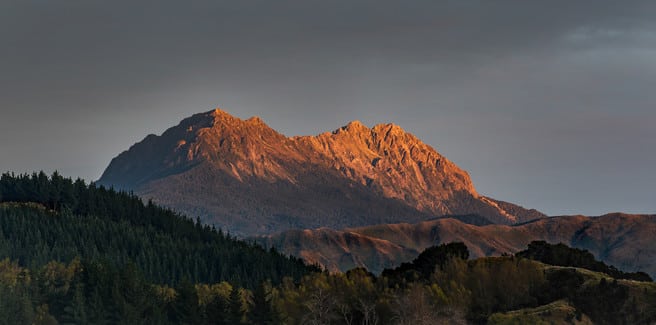
However, Hikurangi was of interest to me for a different reason. I had read that due to the tilt in the earth's axis and orbital pattern around the sun,
Visitors from the north island of NZ meeting Maori from the largest south island tribe, are apparently given a traditional greeting which translates as "Welcome O’ Sunrise," a coded reference to Hikurangi. We regard sunrise and sunset as the 'golden hours' of the day for making pictures, and some even measure the future by the number of sunrises left in a life. So, I decided to make the trek to the Waiapu Valley looking out onto Hikurangi, and, perhaps for the only occasion in my lifetime, be amongst the first on earth to witness the start of a new day. But standing alone on a remote windless hillside that morning, with no-one else in sight, no man-made sound, and only bellowing bulls and birdsong for company, looking out at Hikurangi, at 21 minutes past 7am local time, I realised I had a unique view, and like to believe that, however unlikely, I was the first and only witness to the start of a new day.
Limitations and constraints in photography
Many are the individuals who have praised the beneficial effects of limitations and constraints in the creative process.
The enemy of art is the absence of limitations. ~ Orson Wells
The more constraints one imposes, the more one frees one’s self. And the arbitrariness of the constraint serves only to obtain precision of execution ~ Igor Stravinsky
In the book “Wired to Create: Unravelling the Mysteries of the Creative Mind,” Scott Barry Kaufman mentions that creativity “Involves variability – different ways of doing things,” but also “involves constraints, which can either promote or preclude creativity”.
It might seem logical to think that an artist which plenty of tools, options, and possibilities will see his or her artistic output thrive. The reality seems to be just the opposite.
Even if it is true that a minimum of resources is needed to create, limitations and constraints reduce the overwhelming feeling triggered by too much freedom and channel creative energies, providing a framework and helping us focus our attention, energy, and work. All writers and painters dread the blank page or empty canvas syndrome. This effect is nothing but the consequence of the total absence of limitations and constraints. Right before the first word is written or the first brush stroke is laid on the canvas, all possibilities are there for the artist to grasp. The sheer amount of options available, theoretically infinite, can freeze the creative process even before it starts. As soon as the first few sentences are written, the story starts being channelled, and the options get progressively reduced. Constraints appear as the beginning of a plot begin to materialize. The painter experiences the same progressive liberation as paint disrupts the empty space. Each brush stroke informs the following one, and as the painting emerges on the canvas, the options get narrower and narrower, the idea clearer and more transparent and the actions more focused and determined.
Tales of a Wandering Photographer
As photographers, we are all on a journey. As with any journey, each is unique, the options unlimited and we each choose our own route. They all differ and there is no right or wrong. It’s a very personal thing. The journey can equally be a single project or portfolio or even cover an entire career. It can be very targeted or quite varied, but both are progressive. For many of us, at least at times, the journey can become confusing but if we have an idea as to our direction of travel, an objective, from the outset it can make the journey far easier.
When you look at the work of some of the great photographers you can often see a clear understanding of direction. A perfected expression of place combining vision, mood, technique, style and the individual eye to ultimately capture the soul of the location at a moment in time in an image. Their personalities are revealed by a subtly combined execution of many elements including format, subject, composition, lens, time, settings and post production and a profound understanding of light and how it reacts to the sensor or film. A personal reaction to place, light, season, weather, time of day. The ability to capture varying conditions that present themselves on any given day with respect to their personal style.
For others, the journey is more varied. My own has seen me travel down a variety of paths including the odd cul-de-sac, motorway dead end and some sublime single track roads. My travels have developed through traditional, impressionist, minimalist, contemporary monochromatic (though rarely black and white), etc. with each project informing the next as my knowledge grows and the journey continues. Each informs the last and I revisit roads previously travelled with the increased information gained from all that has gone before. But as I commenced my latest journey I was profoundly shaken as events required me to radically change my approach and perceived thinking on capturing landscapes to suit immediate and personal circumstances. The same journey but most definitely a new road. Let me explain.
Issue 166 PDF
End frame: Sea Mist, Iceland by Tim Rudman
I’m not sure what brought about the impulse that led to me responding to Tim’s recent appeal on Facebook for contributions to End Frame. I’ve often thought it would be good to write a short article for it but I’ve always debated what Image I would choose. This time I knew instantly what I wanted to write about, an image I was instantly drawn to, one I was prepared to put on the wall.
Iceland, for all that it is massively overexposed in photographic media and on the internet, is a compelling place photographically. Many excellent photographers have developed compelling bodies of work with Iceland as the sources of their inspiration. But the work I keep returning to is that of the master monochrome printer, Tim Rudman.
I was given the superb book Iceland: An Uneasy Calm back in 2015, a book full of haunting toned monochrome images. Many are strongly graphic images, with a very skilful use of line and contrast. But others are full of detail and delicacy. I don’t tire of looking at the images, but however good a reproduction is in a book they rarely hold up to seeing the prints for real (if you want to know why the master printers like Ansel Adams are so highly regarded, get to see an original print when you get the chance, they positively glow).
Subscribers 4×4 Portfolios
Welcome to our 4x4 feature which is a set of four mini landscape photography portfolios submitted from our subscribers. Each portfolios consisting of four images related in some way.
Submit Your 4x4 Portfolio
Interested in submitting your work? We're on the lookout for new portfolios for the next few issues, so please do get in touch!
If you would like to submit your 4x4 portfolio, please visit this page for submission information. You can view previous 4x4 portfolios here.
Alexander McIntosh Weir
The Significance of Time
Christine Lavanchy
Wild Forest
Ivan Di Marco
First Morning Lights
Xavier Arnau Bofarull
The Mediterranean Sea revisited
The Mediterranean Sea Revisited
For many years, I've sailed the little sea between the Costa Brava, on the northeast coast of the Iberian peninsula and the Balearic Islands, behind a steering wheel.
The more pleasant moments of the sailing were, at down or dusk, looking from the deck the cliffs, the capes, the lighthouses and the darkest entrances of the coves.
But that was long time ago. Today, sometimes I try to revisit – walking- these cliffs, capes, lighthouses and coves behind a camera. And always around down or dusk, or after the “llevantades” or “tramuntanades”, the heavy east or north winds that, sometimes, beaten these coasts.
The two photos from the Costa Brava were taken on the granitic part of the coast, an astonishing area of pink granite.
The two photos of Menorca, were taken on the Favaritx Cape area, a mysterious cape make up by black and grey slate and clay.
First Morning Lights
I picked those 4 images because all of them were taken at sunrise,
during the very first light of the morning, as the title of the set suggests.
As a landscape photographer I often avoid taking images during the
day, when the light could be too harsh and the shadows too dense.
Instead, I enjoy the incredible feeling of the early mornings, with no one
around and that particular cold, but soft light that starts to hit the land or
the coast.
I tried to include 4 completely different kind of locations that look at their
best when photographed at sunrise.
Wild Forest
Painting this world allows me to feel fully my belonging to it. The spectacle offered by nature is sublime and constantly renewed. It's my red thread and my fuel. Without him, I would be mute. Painting, photography, mixed media are just tools to let emerge this energy it has given me. I combine the techniques, the materials, the colors between them, by looking for this primitive vibratory energy. When I feel it, then I know I'm in the flow
This work presented here exactly shows this hybridization domain where starting from numeric photography, on can end up on paper using old photographic process, where original picture is used as a template for producing a negative for developing a cyanotype on watercolour paper. Then a tea staining is done, ending with a final drawing intervention!
Just treat picture as a cooking procedure, love that so much, really fun!
The Significance of Time
I read an article propounding that 'photography is all about space and time' - as a landscape photographer, my exposures generally fall in the range of tenths of a second through to 30 seconds; or if I'm feeling particularly creative, I have been known to set the shutter to 'bulb' for exposures of multiple minutes.
We can all relate to seconds, minutes, hours, days, weeks, months and years but beyond that our comprehension of 'time' becomes much more difficult. Whilst on the Isle of Lewis in the Outer Hebrides I took the opportunity to photograph the local rock formations. I don't know too much about geology but I do know that the beautifully structured Lewisian Gneiss is the oldest rock to be found in Britain and at 3 billion years old it is also one of the oldest (although not the oldest) rock forms found on Earth. Three billion years old; well I really cannot get my head around that scale of time; human life is no more than the single flutter of a hummingbird's wings as measured against such unfathomable time.
Social Media and Photography
Likes, shares, views, hits – are these the final bullets shot into the almost lifeless body of landscape photography? Is social media an insidious virus that will infect us all and cannot be cured? Are vloggers marching towards us like an army of the undead, insatiably overwhelming all those who dare not to join their horde? And have I, in my quest to draw your attention, used one analogy too many?
As landscape photographers I’m sure we all feel the pressure to post our images online, to share them across various social media sites. That nagging pressure of keeping up with everyone else, that thought that if you don’t post something people will forget about you and anything you’ve ever done. That urge to keep churning out work, to better what you did last year.
To be clear, I’m not attempting to dismiss social media as a whole. I think there are some really good aspects to it, with the two main ones for me being exposure to images and styles I would otherwise have not seen and the chance to make friends with like-minded people. But there is one aspect that is increasingly making me feel uncomfortable and it is this – the perceived position and status afforded to certain photographers based on their following online rather than the quality of their work.
To expand on this, my issue is not so much with the photographers themselves, but more with the way the industry appears to be using them as cheap advertising, as an easy way to access thousands of followers and viewers but at the expense of highlighting meaningful and important work. Integrity is being sacrificed on the altar of commercialism.
And when a travel company pays for a social media star to travel around a country taking pictures for them is it really the photos at the end of the trip they are interested in or is it just the number of times their company name gets mentioned in the videos?
If it was the photos they really cared about, would they not be better-paying someone who has built a career on producing quality photography rather than on how savvy they are online?
If magazines are really interested in educating and expanding our horizons on the medium should they not be seeking out the people making challenging and intriguing work, rather than just the people who create the most digital noise?
I know what my answers are. And in fact, when I look at some of the photographers I respect the most quite often they have very little social media presence at all.
At this point, though I imagine some of you are thinking one of two responses (or both) – that’s just how business works and you’re just jealous.
To address the second one first, this is often the response I see when people dare raise their heads above the parapet and ask these questions, but it really couldn’t be further from the truth for me. And the danger is it’s used as a tool for avoiding actually answering the questions.
However, I think the first response holds more weight as magazines, websites, brands etc all need to make money. Ultimately they are businesses and can’t just indulge in things that are not profitable.
But I do think they have a certain responsibility to value the medium itself and not just chase after the latest craze. Photography existed a long time before social media did so there is no reason why it now needs to be held to ransom by it. As well I think a distinction between content that is produced for entertainment and content that is photography focused would also be helpful. Both have their place, my issue is more when the two get confused.
So what should we do in response? Well, you might totally disagree with me and therefore conclude nothing needs to be done. But if something in this resonates with you then I think there are a few things we can do. Firstly a few simple suggestions are these – continue to produce your best work and continue to champion those photographers you think are producing great work.
Secondly, I think we should be more selective with our time and money. So next time a big photography show is coming up and one of the main speakers is a social media star, ask yourself are they there because of their photography or are they there because they get lots of hits online? Similarly, with magazines and websites. Are you getting value for money?
And thirdly I think we should probably all spend a lot less time on social media.
PS Please be sure to share this article on Twitter, Facebook, Instagram and maybe make a vlog about it.
Fotospeed’s Foto Fest South
This September, Fotospeed’s Foto Fest South is returning for the third year running, bringing together 4 of Britain’s best photographers and big name brands for a day of photography inspiration and a celebration of the printed image. This year, Valda Bailey, Julian Calverley, Terry Donnelly, and Paul Goldstein are taking to the stage to share their photographic journeys and expert insights.
Making it in the Midlands
What you missed at the first ever Foto Fest Central
This summer saw the inaugural Foto Fest Central event, which saw Fotospeed extended the event to the Midlands after the success of the annual South festival, which was launched in 2016. Speaking on the decision to extend the festival, Toby Herlinger, Sales and Marketing Director at Fotospeed said, “The best thing about the photography community, to us, is the strong desire to help others learn and be inspired, so we were thrilled to be able to bring Foto Fest to more people.”
Foto Fest Central saw talks from several leading landscape and wildlife photographers. Landscape photographer Mark Littlejohn‘s talks focused around ‘atmosphere’, and how being selective in your composition can help create a sense of intrigue within the viewer, while Ted Leeming and Morag Paterson, spoke about the creative process of collaboration, and how working with other photographers can help you to explore different styles. Leading photographer Charlie Waite’s talk asked some probing questions about the origins and future of landscape photography, as well as addressing the question ‘where does the impulse and compulsion to want to photograph originate?’. Wildlife photographer Tom Way answered questions about what it takes to be a wildlife photographer, including details on the importance of light and composition when trying to compose a sellable image.
Each of the talks were designed not only to give an insight into the way each photographer captured some of their most important images, but to encourage photographers to learn new skills and try new techniques. “What I would like to think,” said Mark Littlejohn, “is that people will listen to me, listen to Tom, listen to Charlie, listen to Morag and Ted, and pick out the bits that apply to them. It’s about doing what’s right for you. What I do suits me, it might not suit you. But there might be a small aspect of what I do that suits you.”
“It doesn’t matter at all that they’re in a different discipline,” added Morag Paterson, “because although that might not be what you’re interested in, or the way you work, it’s the thinking behind what they do and how they execute those photos … it’s all so helpful to hear. And it’s inspiring for us as well.”
What to expect at Foto Fest South
An opportunity to get hands-on
As well as a programme of inspirational talks, this year’s Foto Fest South sees the launch of the brand new Capture to Output station, where you can try out some of the latest photography products, take away top tips, and create your very own printed image to take home.
Your chance to be inspired at Fotospeed Talks
Valda Bailey
 In her talk ‘Photographic Impressionism’, Valda Bailey explains how and why to look beyond the obvious approach in landscape photography. Her top tip for creating alternative landscape images.
In her talk ‘Photographic Impressionism’, Valda Bailey explains how and why to look beyond the obvious approach in landscape photography. Her top tip for creating alternative landscape images.
The secret, she says is time. “Spend time in a place,” she says. Rather than rush from location to location, really get to know a small area. I believe creativity thrives on boundaries.”
Terry Donnelly
 Terry Donnelly will share his thoughts on capturing the personality of a subject in a photograph in his talk ‘An Approach to People Portraits’.
Terry Donnelly will share his thoughts on capturing the personality of a subject in a photograph in his talk ‘An Approach to People Portraits’.
“My talk will include my approach to shooting portraits, including my thought process before, during and after the shoot, as well as a look at how to use different types of lighting setups and lens selections to achieve your desired look.”
Julian Calverley
 ‘A Journey in Landscape Photography’ will see prolific landscape photographer Julian Calverley take you through his advertising photography, how that led to his love of landscape work, and how he ended up making pictures entirely on an iPhone, including his top tips for creating images for social media.
‘A Journey in Landscape Photography’ will see prolific landscape photographer Julian Calverley take you through his advertising photography, how that led to his love of landscape work, and how he ended up making pictures entirely on an iPhone, including his top tips for creating images for social media.
*Spoiler alert* Julian says that squinting is his top tip for smartphone photography; “start off with simple graphic compositions that lead the eye in and avoid overly busy compositions or scenes, where the detail would be lost when viewed at a small size. Squinting aids the simplification of the composition and breaks the image down into fewer elements,” he says.
Paul Goldstein
Paul Goldstein describes his talk as “the pursuit of the perfect wildlife image, a tortuous and amusing quest for the unobtainable”.
Join him for ‘Catching the Moment’ and hear his experiences, touching on the pinnacles and pitfalls of many years of eventful photography in Kenya, Antarctica, and beyond.
Event details
Where: The University of Bath, The Edge
When: 9th September 2018
Time: 9:30am – 5:00pm
Entry to talks: £40
Entry to Market Place: Free
Anything else?: Free parking on site, all day
For more information and to register for Foto Fest South 2018, click here.
Featured Photographer
When I started my research for this interview I knew of several Nialls – nature photographer, author, co-founder of Wild Wonders of Europe, workshop leader, passionate advocate for enhanced knowledge of and connection with the nature on our doorsteps, yet it is only in preparing my questions that I start to fully register the breadth and depth of Niall’s interests and work.
Most people recognise that professional photographers need a variety of income streams to survive these days, but this is possibly the broadest and most carefully considered portfolio of commercial and personal work that I have come across to date, and beautifully presented to boot. Niall has referred to what he does as “Nature photography with creative intent”. Tell us more!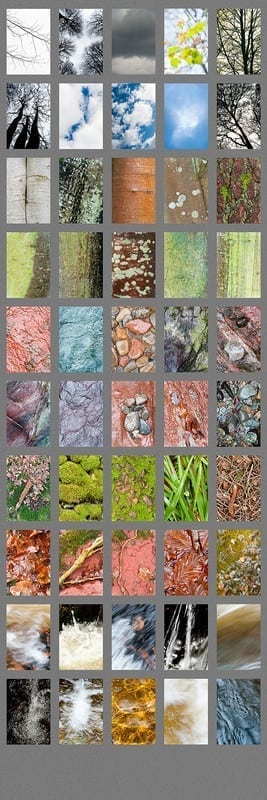
Would you like to begin by telling readers a little about yourself – where you grew up, your education and early interests, and what that led you to?
Well, my name is Niall Benvie (as in “kneel”) and I’m an Angus man. Our family has a long association with this part of eastern Scotland. I grew up on the small farm my parents bought in 1948 when Dad left the army. These were the days when you could make a good living off just 80 acres of land and allow your children to dream. Dad’s real passion was breeding Australian parakeets and finches and he was very successful in this field, exporting birds all around Europe. But he was also a fine naturalist (and planted trees on the farm just because he thought it was the right thing to do) and greatly encouraged my obsession with birds from about 10 onwards.
As the only person in my secondary school actively interested in the natural world, I learned to plough my own furrow pretty early on.
Perceiving landscapes in Two-dimensions
Every now and again I get sent an email from a reader with a question about a way of working, technical advice, an opinion on an exhibition, etc. I usually try to help and/or put them in touch with someone I know who may be better placed to give an informed reply. I recently thought it would be a good idea to share some of these with our readers and ask for their advice.
If you have any questions you'd like to share with our readers, please send them to submissions@onlandscape.co.uk and we'll post some every couple of issues.
Neil McCoubrey's question about seeing in two dimensions had me thinking about whether this is a learned capacity or something innate that some people have. I also used to think that covering one eye would drop everything into two dimensions but unless you stand extremely still, the parallax during movement makes everything pop back into three dimensions.
Please respond to Neil's thoughts on the 3D process, and also on his playing with the effect using post-processing, in the comments section below.
Tim Parkin (Editor)
I am a researcher at Edinburgh Napier University studying the intuitive practices of a landscape photographer and I hope that On Landscape photographers may be able to help me.
Occasionally, I will instantaneously perceive a landscape scene in just 2-dimensions, not three. This occurs when the scene has few or only weak depth cues and especially if it is largely monochromatic. This effect only lasts a few seconds until my brain catches up with reality, but it leaves a very strong impression. Recently, I have been trying to capture and even reinforce the 2D impression in my images and this has raised two questions that I hope On Landscape readers may be able to help with.
First, I understand this effect of initially perceiving in 2D which is then modified to 3D once the brain has caught up has been studied by others, but I have been unable to locate any papers or articles describing such research. Even having a name for the effect would be a good starting point.
Secondly, as photographers, whilst our images are inherently 2D most of us want to reinforce the impression of 3D. For this type of image, I want to achieve the opposite. I would like to enhance the 2D impression that I initially saw such that others may be encouraged to see it as well. Any ideas or pointers to others who have attempted this would help.
Here are a couple of examples
Lerwick Harbour
This is the scene in Lerwick harbour that I photographed
However, I initially perceived it as a series of strong lines and geometrical shapes that are all on the same plane. I have deliberately desaturated the image to emphasise the monochromatic nature of my perception.
Buachaille Etive Mor
This next image of The Buachaille Etive Mor is unusual in that is has strong colours, yet I still saw it in 2D, as a set of strong triangles rotating around a single point.
Here is the scene as I had seen it.
I have been using the above technique, of desaturation and the addition of lines, to reinforce the 2D impression. This is a very technical approach, but I want to achieve something more emotionally appealing whilst encouraging the viewer to consider the 2D nature of the scene rather than its content. The following is my most satisfying effort yet. Any suggestions for artists or other photographers who have attempted this kind of work and I welcome any ideas to improve on my results?
Thanks for your help.
Giants of the Mystic forest
Trees are poems that earth writes upon the sky. We fell them down and turn them into paper, that we may record our emptiness ~ Kahlil Gibran
In the 1800s when Northern California was inhabited by Native Americans the coastline was covered in over 2,000,000 acres of Redwood forest. Initial settlers were attracted to the forests which sustained the growth of the lumber industry. When the gold rush happened those who were not fortunate in finding gold found their treasure in the forest. The giant trees were prime territory for logging and the practice led to an economic boom which facilitated the birth of the San Francisco metropolis. The unrestricted logging practices, unfortunately, led to the catastrophic devastation of the forests. Today a small fraction of that original forest remains protected under National and State laws. Serious conservation efforts made since the 1960’s have resulted in a sanctuary for the giants, along with a narrow strip of the California coast that extends over a distance of 470 miles (750 Km) in length and less than 47 miles (76 Km) in width. In 1980 the forest was declared as a World Heritage site.
Issue 165 PDF
End frame: Confluence by Jenifer Bunnett
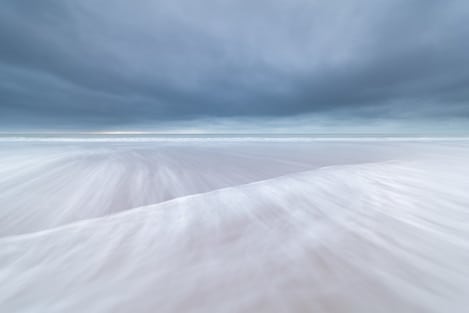
Considering that I was born and bred 45 miles from the nearest coastline I have a very strong affinity to the sea. All my friends are fully aware of my love of the coast and that I can happily spend hours sitting on a rock, or a bench, watching the sea ebbing and flowing across the shore. The sea constantly changes and whenever I travel to the coast I can never be sure of what I will experience, even after planning and consulting weather forecasts and tide tables. I love being out with my camera photographing mountains, rivers, lakes and woodland but I have discovered that my real passion is for the North East coast and the sea.
To my eye Jenifer Bunnett produces inspirational coastal photographs and studying them is very useful to me as I develop as a seascape photographer. I enjoy browsing through social media and I discovered Jenifer’s work whilst searching #seascapes on Instagram and I was led to her photograph ‘solitary.’ It depicts a lone groyne post surrounded by a flowing sea with a stormy sky in the background. It reminded me of my own favourite photographs ‘Bird at Blyth Beach’ which also features a single post out to sea although that is where the similarity ends. This encouraged me to visit her website and I unearthed her shoreline and sea galleries which are now inspiring my exploration of the North East coast.
Jenifer’s background in photography is completely opposite to mine. She spent her childhood learning darkroom skills and camera craft from her father. Her university education was also centred on photography as she successfully completed a BA in Photography and Film. My own interest in photography only developed when I was too old to chase a lacrosse ball but I wanted a hobby that enabled me to spend as much time as possible outside enjoying the countryside. Taking many of my holidays in the Lake District provided me with splendid vistas of mountains and lakes but it was only when I retired that I had the time to regularly drive east towards the delights of Flamborough, Whitby and the Northumberland coast.
Many of Jenifer’s photographs are of the sea reacting with the shoreline. They capture the swash of the wave as it travels up the shore and its return to the sea. I have spent many hours studying waves and how a tide develops on the shore. It isn’t straightforward at all as there are so many variables; the phase of the moon, wind speed and wave fetch, water depth, and the direction of the currents. Jenifer has clearly spent many hours learning the minutiae of her locations and waiting for the conditions which produce the patterns and lines in her shoreline photographs. It is impossible to take such intricate photographs without knowing your locations intimately.
My favourite photograph from her Shoreline collection is called Confluence. At first glance, it seems that there is just a single white wave starting its return to the sea but then my eye is drawn deeper into the photograph where there are actually many layers. Immediately behind it another wave is covering the beach and producing a beautiful diagonal across the foreground leading to a line of breaking waves and the sea. The band of the sea then leads to a glimpse of yellow light underneath the brooding storm clouds. The sky is an important element in all seascapes as there is rarely any major landmark or feature to provide a distraction. The strong sky stops the eye drifting out of the frame and draws me back to the strip of sea which is mimicking the colour and mood of the clouds. The other feature of ‘Confluence’ is that there is no sense of place. There are no cliffs or lighthouse to enable the viewer to recognise an actual place. There is no location for a photographer to go and stand; it is just the sea and the sky at one point in time. I am transported into Jenifer’s world for that instant. However, the moment has passed and can never return but it has been captured perfectly with a long exposure to enable the camera to track the waves’ paths.
How has this influenced my photography? Like many seascape photographers, I have learnt that you must know your locations thoroughly and be prepared to visit them frequently in order to get the photograph you really want. For me, the challenge of capturing a scene at Saltwick Bay is very satisfying. Apart from the real danger of being cut off from safety the tide rises and falls very fast and it is easy to spot a photograph too late. How many times have I stood on a spot pleading for just one more wave before an opportunity is lost? In her galleries, Jenifer demonstrates that there are many different facets to coastal photography and I am trying to widen my expertise and technical ability to enable me to portray what I am feeling. I need to use ultra fast shutter speeds to make breaking waves look like ice and sculptures but longer exposures are required to emphasise and draw the lines and flow of the sea on the shore.
Like all seascape photographers, I feel a sense of awe when I am at the coast and I am watching the force of the sea crashing or gently seeping into the shoreline. We are privileged to be there to try and capture the essence of each unique moment. And then to share.
The sea, once it casts its spell, holds one in its net of wonder forever ~ Jacques Yves Cousteau
Read more about Jenifer’s work at:
- http://jeniferbunnett.com
- https://www.facebook.com/JeniferBunnettPhotography/
- https://www.instagram.com/jeniferbunnett/
Authors Note
This article is dedicated to Aunt Cis, aged 102, who was responsible for my love of the outdoors and my photography. RIP.
Subscribers 4×4 Portfolios
Welcome to our 4x4 feature which is a set of four mini landscape photography portfolios submitted from our subscribers. Each portfolios consisting of four images related in some way.
Submit Your 4x4 Portfolio
Interested in submitting your work? We're on the lookout for new portfolios for the next few issues, so please do get in touch!
If you would like to submit your 4x4 portfolio, please visit this page for submission information. You can view previous 4x4 portfolios here.
Deigh Bates
Gorges of Steens Mountain
Harris Steinman
Scattered Light
Mark Naylor
2 minutes in Northumberland
Neville Prosser
The Coast
The Coast
This is a new as yet unpublished portfolio of my local area. I have photographed this piece of the coastal landscape for more than 30 years and I'm always surprised but what it reveals to me as time goes on.
I live on the NSW Central Coast, just over an hour from Sydney Australia. My reasons for making this new collection is for the simple fact I can never get enough people to commit to having their portrait made when I want, so I have to go out and look for other things, the coast is it.
2 minutes in Northumberland
After watching the seminar through this very magazine which was presented by Bruce Percy I visited his website straight away. I was, needless to say; blown away. Muted colours, subtle tones and pristine composition. Now, I know that my offerings are not this but I was inspired to use what I have learned over the years and turn my ideas into vision.
This was a recent (and first) visit to the Northumberland coast. The stunning outcrops and roads which are temporarily consumed by incoming tides begged to be captured in no less than 2 minutes(ish). I have to say that this can be a little unnerving when you try this with the tide still coming in, but alas, tide and time were against me.
These images were produced with the Lee filter and some post processing in Lightroom and Photoshop and this combination enabled me to make photographs that stirred my emotions. My hope is that other people are also stirred, and for some feel the way that I do when I see these colours and tones working together... Or i may be wrong?
Footnote: If you are going to try this; PLEASE, judge it for when the tide is going away from you! Happy shooting.
Scattered Light
Solitude is essential to many artists. Solitude results in an enhanced joining of the unconscious with a visual play of light, revealing textures, shapes, mood and awareness. These images were captured during a very specific emotional low point and reflect that period with my emotional state at that time.
Gorges of Steens Mountain
Capture One for Landscape – Part Three
In our third instalments of our Capture One for Landscape series, Joe looks at a few of his images from a recent trip to the Isle of Eigg in the Scottish Inner Hebrides. Along the way, he will be demonstrating some of the steps in his typical workflow and also his approach to post-processing images. (Watch Episode One here and Episode Two here)
If you have any questions about the video or general questions about Capture One, please add them in the comments below.
Beauty out of the fragments of life
It has never been easy to understand and define “beauty”. Throughout history Philosophy, Art and Aesthetics have provided to us with multiple understandings of the term. Beauty is inherently perceptual, complex and subjective by nature. Out the wide of range of definitions I quite like one from the philosopher George Santayana for its simplicity, in which he emphasizes that “beauty, is not a perception of a matter of fact; it is an emotion; an affection of our volitional and appreciative nature”. Although the intent of this essay lies far from engaging in a dense philosophical and semantical discussion on the concept of beauty in art, I introduced the above definition as a way to connect with the essence of this essay. Thus, in the following paragraphs, I will try to explain and share my learning experience of embracing a different (and difficult) approach to nature/landscape photography: to evaluate whether I can emotionally connect with “green” urban or semi-urban spaces and make images that can reflect that experience. Furthermore, the idea of this essay is to encourage the community of OnLandscape to share their own experiences or unique visions on this topic.
Damian Ward
For this issue, we’re talking to the man behind the black cat: Damian Ward. Damian lives north-west of London in an area that is not one of the UK’s more obvious photographic honeypots but does have some rather nice woodland and includes the Chiltern Hills Area of Outstanding Natural Beauty. By working locally he is able to fit image making around work and family life and has a connection with a place that he can trace back to childhood.
Would you like to tell readers a little about yourself – your education, early interests and career to date?
I grew up in a small Oxfordshire village, surrounded by countryside and woodland, so being outdoors and wandering around fields and woodland has always been something I like to do. I still live close by, so the woodland and fields of my early years often feature in my photographs.
Thoughts on Beauty
The great artists are the ones who dare to entitle to beauty things so natural that when they’re seen afterward, people say: Why did I never realize before that this too was beautiful?
~André Gide
If you are like most people, looking at the photographs on this page, you may not consider that there’s something very wrong with them, at least according to many contemporary art mavens. What’s wrong with them is that that they are beautiful.
In today’s art world, that something is beautiful, may be reason enough to disqualify it from serious consideration. Still, to the chagrin of some in the art business, most people consider beauty and art as almost synonymous. To wit, if I asked you to think of a favourite work of art, odds are you will think of a work of art you find beautiful, even if you are schooled in the arts and capable of appreciating creative works that are, by design, not beautiful..
Landscape Conference News
10 weeks to go until the conference now and things are hotting up. We’re now in the middle of arranging for the
We’ve just announced the schedule for the two days and made day tickets available. So if you can’t make the full weekend, please come and visit us for a single day. You’ll still be able to submit your image for the conference exhibition too! The price

Our final speaker has also been announced this week and I’m pleased to say that Nick White who we have interviewed previously about his Black Dots
Conference Exhibition
If you are attending the conference - don’t forget we need your image submission for the conference by 27th September. We’ll be sending reminder emails out this week as well.
Call out for final lightning talks
Finally, if you’re interested in giving a short
Why not watch some of the community talks from 2016 to give you an insight into topics & how they work:
Orkney and the Simmer Dim
I am a British freelance photographer living in Orkney, an archipelago of seventy islands lying ten miles off the northeast coast of Scotland, at the point where the Atlantic Ocean meets the North Sea. Of these islands, sixteen are inhabited and the capital city, Kirkwall, has a population of some nine thousand. I live on the largest of the islands, known as Mainland, where we have some of the best-preserved Neolithic sites in Europe, are world leaders in renewable energy research, and have the most northerly cathedral in Britain. Our beef and scallops are world famous, we have abundant wildlife and the islands are rich in myth and folklore.
Living on the 59th parallel does not come without challenges; we are three degrees of latitude north of Moscow and one degree south of St Petersburg, however, our seas are fed by the gulf stream, meaning that our climate is relatively mild, wet and very windy. Our winters are long - the days can be as short as six hours and the constant gales leave us scoured and battered. But in summer it does not get dark at all.
What a gift! Many artists come here for the exceptional quality of the light, and I am entranced by the perpetual twilight, or simmer dim as it is called here, that we experience for a month or so either side of the summer solstice.
It should be said that I really love my bed and I need plenty of sleep in order to avoid the grumps…however this can prove a challenge in high summer, even with black-out blinds, so I decide to fully embrace the simmer dim experience and stay up all night. The sun sets at around 10.30 p.m. at this time of year and rises again at about 4 a.m. so I pick a night that looks clear and set off to Birsay on the North West corner of the island, for an Atlantic sunset.
The arctic tern colony is never still. As most of us are winding down for the night they must be constantly delivering food to their tiny chicks whilst watching out for Orkney’s infamous bonxies - great skuas - who would as soon simply disrupt life in the colony as snatch a chick to feast on. Bully boy birds…not a pretty sight. But now the elegant terns are suffused by the softest pink light and the scene turns to magic before my eyes. This is the time for an artistic image - gorgeous low light, slower shutter speeds, and the chance to capture the essence of these hero birds.
Issue 164 PDF
William Neill – Retrospective
William Neill is no stranger to On Landscape, most notably because he runs his own On Landscape column for Outdoor Photographer (I promise I didn’t pinch the name William! I think we both got it from On Photography), but also as we’ve reviewed a few of his e-books previously. His e-books are relevant here as a reasonable amount of the photographs and a few of the themes within “Retrospective” draw from these books. This is in no way a bad thing though as they included a great deal of his best work and the themes tie neatly with the way in which he has always worked (and isn't that the whole idea of a retrospective). First a little background about William.
Always an ‘outdoorsy’ person, William really found the love for the land through personal tragedy, spending long periods in Glacier National Park, where he worked at the time, wandering and healing. Later, he found a job working for the National Park Service and then working as the photographer in residence for the Ansel Adams’ gallery (jump in at the deep end William!).
Through his work at the gallery in Yosemite, William met many of the eras greatest photographers (e.g. Don Worth, Ernst Haas, Alan Ross, Paul Caponigro, Joel Meyerowitz, Jerry Ulesmann, John Sexton) and his own work blossomed. Unsurprisingly, William worked with a large format camera but unlike Ansel, he embraced colour photography - and it suited him well.
Living with such easy access to the heart of Yosemite, it is no surprise that some of the most memorable images are of the valley, in large and in detail. However, the retrospective holds a couple of surprises if you don’t know his work. The Antarctic and Impressions of Light series are two avenues of exploration that have produced work with its own aesthetic. Personally, although the images are very well captured and composed, the Antarctic work is the weakest section in the book. This is probably as much to do with how much I enjoyed the rest of the book as to how different the section feels, they’re still excellent images after all. The Impressions section uses intentional camera movement to abstract the subject, leaving strokes of shape and colour that suggest rather than describe. I’m generally not a great fan unless these sorts of images have very strong form and suggested subject (i.e. not completely abstract shapes). In this case, the image of Horsetail Falls is the stand out for me.
The most memorable images, for me, are those that are imbued with William’s passion and knowledge of his locale, which means beautiful imagery of Yosemite and its surroundings. With echoes of Eliot Porter and possibly David Muench, these photographs of stone, wood and water give a window into a primal landscape - at times awe-inspiring but always captivating.
The book itself is well produced with detailed images and consistent colour all on a semi-gloss paper that suits the work well. The hardbound finish is tight and the tipped-in cover image of Cascade Falls a good taster of what is within.
If you’re a fan of the typical American landscape with a penchant for the Sierra Club classics, this is definitely a recommended purchase. Triplekite have sold out so if you want to buy in the UK, I would recommend Amazon, otherwise, if you're in the US, you can buy directly off William's website.
- Striated wall of an ice cave, Jasper National Park, Alberta, Canada 1995
- Morning Mist, Yosemite Valley, Yosemite National Park, California 2013
- Morning Mist Rising, Yosemite Valley, Yosemite National Park, California 2016
- Horsetail Fall, Yosemite National Park, California 2008
- Desert Varnish, Canyon De Chelly National Monument, Arizona 1983
- Clearing winter storm, Sentinel Rock, Yosemite Valley, Yosemite National Park, California 1990
- Burnt trees and shadows on snow, Blacktail Plateau, Yellowstone National Park, Wyoming 1993
- Cloud reflections and Mt Moran at the Oxbow Bend on the Snake River, Grand Teton National Park, Wyoming 1990
End frame: School’s Out, Ballachulish by Tim Parkin
You could be forgiven for thinking this is a set-up! In fact, it is quite the opposite. Tim Parkin rarely makes an image in black and white and does not normally include people. His photograph ‘School's Out’ is, therefore, a break in his usual style as part of his Lochaber 365 sequence (which has been on pause since April, back soon - Ed). So intrigued by this I kept returning to the image and, in the end, contacted him with the request that I might write this up as an ‘End-frame’ contribution.
‘Schools Out’ deserves examination in detail. There is much more to it than its being a straight record shot. Yes, it has a good sense of composition. The footpath is a natural leading line drawing the eye to the mother and child on their way home from school; small figures that might otherwise be overlooked, and ensuring that they become central to our thinking. The handrail on the steps occupies much of the lower half of the image. It would have been only too easy to omit this - a man-made object that spoils the view! Instead, it is used as a device that pulls us into the whole image and links the viewer with the scene.
The lower part of the image comprises a number of key components. The steps roughly cut into the hillside, where once there was probably only a slope, draw us down into the central area. Although they dominate the foreground they add strength to the middle and distance. To the right are the stems of last year’s bracken fronds sweeping downwards to counter the curve of the rail. The curves are in sharp contrast to the upright stems of the self-sown trees. Those on the left conveniently obscuring a bright sky that would have otherwise formed a natural distraction. In many respects, the vegetation is a contrast between the old and the new and yet they all remain stilled by the cold of winter.
As the layers of the image unfold we enter the middle, scrubland area. To do so we pass through a gate. Looking carefully you can see that this is not a straightforward gate and neither is it a stile. Both these features could have held us back and stopped us from entering the scene. This is a kissing gate - never open, never closed - it is an entry to another place. This is a land that is unclaimed by man. Possibly a wet area unsuitable for development, possibly unwanted by farmers. Those ‘islands’ of scrub are probably welcome havens for wildlife but suggest an area of uncertainty, neither one nor the other. A place where a young person should be accompanied. This is an area of transition, a place to move from security (so the title implies) to safety, from school to home, from child to adult.
Most landscape photographers spend their life trying to keep the built environment out of their images. On this occasion, Tim has included it to make a clear statement. Yes, it is the destination for the walkers, but on the other hand, it acts as a symbol. How small the homes look set against the dark, somewhat brooding, the barren slope of Beinn Bhan. How small man’s efforts seem against the snow-capped peak of Sgorr Bhan. How heavy the grey clouds seem as they, too, hang over the village.
Like so many elements of this image even here there is a paradox. It seems that the mountain furthest away is the one that sets the scale and because of the light on the snow our attention is drawn towards it. The almost central position of the peak has been carefully placed above the line of the path. We are being invited to walk, from the wasteland, through scrubland, on to urban land, only to continue to a barren land and, ultimately, a shining destination. Perhaps the whole image is an allegory. Above all, it is a landscape photographer's essay on nature’s dominance over humans.
Subscribers 4×4 Portfolios
Welcome to our 4x4 feature which is a set of four mini landscape photography portfolios submitted from our subscribers. Each portfolios consisting of four images related in some way.
Submit Your 4x4 Portfolio
Interested in submitting your work? We're on the lookout for new portfolios for the next few issues, so please do get in touch!
If you would like to submit your 4x4 portfolio, please visit this page for submission information. You can view previous 4x4 portfolios here.
Adam Pierzchala
Hidden Yosemite
Darren Rose
A Summers Evening
Gary Swann
Keynvor Atlantek
Paul Kiernan
Wicklow National Park
Wicklow National Park
I started out at 6 am for the Wicklow Mountains National Park which is south of Dublin and can be reached by car in under an hour from Dublin city. This is the largest National park in Ireland spanning 200 square kilometres of mountains, valleys, streams and rather precarious mountain roads.
On the morning of my visit despite the initial clear morning air when I reached the uplands a veil of mist covered the mountains giving very poor visibility and light. I reluctantly abandoned the trip but determined to capture the beauty of the area I visited again a week later at dawn. The stillness and loneliness of the mountains were awe inspiring.
The only sound was the cry of the peregrine falcon. As the sun came up the mountains revealed their splendour and the patient wait was rewarded with the beautiful colours of forest and fauna. Some mist still hung in the distant air giving a slight mystic feeling. I hiked up to the top of one of the peaks beside the deep blue Lough Dan and placing the camera on the tripod and the shutter was released to capture the sacred beauty of this most ancient landscape.
Keynvor Atlantek
Inspired by Rachael Talibart, my coastal photography has recently changed tack to focus on the ocean as a discrete subject. In doing so I’ve discovered a passion for wave photography. The ocean is in constant motion, interacting with light, weather and geology to produce unending moods, shapes and tones.
Released from the shackles of the tripod, I enjoy the freedom of shooting handheld and feel a greater sense of engagement with the elements. My aspiration is to try and capture the spirit of the ocean as I experience it.
These four images are from one exhilarating morning in Cornwall shooting the Atlantic Ocean (Keynvor Atlantek in Cornish).
A Summers Evening
Hidden Yosemite
In late May I had the good fortune if visiting Yosemite for the first time. Of course, I had to make some images of one or two iconic views - why resist temptation when presented with really good lighting conditions - but I also wanted to find cameo scenes that worked well in the conditions I had or subjects that others may have walked by.
Apart from some rather more intimate landscapes, requiring walking perhaps a few hundred metres from the car I also found others that were "hidden in plain view". The four here are a selection of those that took a bit of effort to find and make pictures.
Chiaroscuro: I was very taken by this convoluted tree with its cut-down companion and with a bit of post-processing I tried to bring out the silvery limbs against the dark woods behind.
The Light Beyond: I was struggling to get something at Siesta Lake but came across this dark and secluded part of the woods at one end. Walking just a few yards in and crossing a boggy patch suddenly took me a world away from the rest of the group. ICM helps to emphasise the slightly scary feel I had here.
Time and Motion: The Merced was rushing by while gusty wind shook the dogwoods on the other bank. A Little Stopper helped to bring out the dynamic nature of this cameo scene.
Trees: This was made not far from the Sentinel. I found this fallen tree while walking along the Merced river at El Capitan
The Fall 2017-2018
In August 2015 with a lull in commercial work, and a growing sensibility of photography becoming a medium in rush: we had seen the onset of Instagram, and especially in a commercial sense, experienced the term “content” be attributed to photography, instead of craft, I set myself the challenge of beginning a new project, something that would take time, something that would slow the pace down, and something that would allow me to be patient & observe. In 2016 I travelled to the snow covered alpine regions of Australia, to document ski infrastructure and the landscape, which would eventually be exhibited in November of that year as “The Fall”, to great success and an invigorated passion & outlook for the craft.
I was eager to continue this momentum, to throw myself into this project, however in a Southern hemisphere context, would need to wait until the following year to continue in winter.
It sparked an evolution in thinking, The transient nature of imagery sought in 2016’s expression of The Fall, and the tiny window in which this Winter imagery existed, lead a conceptual evolution for the body of work, to grander fascinations of seasonal change & metamorphosis.
What happens before the snow arrives? What does this landscape look like when it melts? What is the overriding narrative in this complete cycle? In one of the inexplicable timings in life, I had become aware of an inaugural residency at Falls Creek being offered, to assist artists with conceptual development and those working in an Alpine context. After presenting the idea of returning monthly to Falls Creek for 1 year to document the region, I was extremely honoured to be an inaugural recipient of the grant. The overall ethos for The Fall was for an enduring body of work and commentary on the world inhabited, to utilise the photographic medium’s ability to tell a story. There would be no greater story than to document and immerse myself in a location for a year. The 2018 exhibition marks a 1 year timeline, beginning from the first period of residency at Falls Creek in March 2017 through to March 2018.
Falls Creek is undoubtedly a stunning part of Australia. From the project’s very inception, I knew imagery would be simply stunning, graphic and minimal, and in the 2016 expression in Snow covered winter conditions indeed it was. Evolving to the year study, I endeavoured to let go of any premeditated imagery in my mind, and simply immerse myself in the location, to let the location tell me the story. All I had to be was present as often as I could, have a willingness to observe, be prepared and open to whatever the conditions may throw at me.
Minimum monthly trips were undertaken to Falls Creek, and on occasion up to 3 times per month, to document the experience, from subtle changes in climate & quality of light to the more tumultuous, the inhospitable and stark transformations. I got out of my comfort zone, hiked, Skied, camped amongst the snow – all pursuits I had previously little or no experience, but like the changing of the seasons, adapted to the environment evolving around me. My work evolved with it.
Through each session at Falls Creek, the imposing mountains could almost appear to be breathing, sensitive, exhibiting a pulse, and a temper. Where most of the human condition is chaotic & without reason, there is a certainty & purpose in the changing of the seasons. A metronomic rhythm to which all processes of life keep time.
My process has always been very meticulous, technique driven and faithful to the subject, to avoid making imagery over manufactured. Though your process can change quite a lot over a year. In Feb 2018, with the project nearly complete & most of my work already captured, I happened to stumble across some of Arthur Streeton’s works on a visit to the NGA. The tonality, colour palette & richness of the landscape, just gave me the final piece of the puzzle, of how to edit, how to curate the final collection from the extensive body of work, and how to faithfully convey the experience of the moment the photographs were captured.
Work on The Fall has continued to present day, beyond the year I had set myself. Each trip I gather new ideas, new ways of seeing and no two days let alone hours are the same – an overriding mantra in this entire project. The snow does not last, neither does the seasons, or the light.
The exhibition is on display at The Fox Gallery, Kensington, Austrailia and runs from 11 August – 2 September 2018.
Ethics in photography
The thorny issue of ethics and moral responsibilities in documentary photography, particularly in the case of photojournalism has been discussed many times. It has also created severe turmoil in the careers of long-established and respected photographers, who failed to comply with the expectations of the audience.
The reader might remember the polemic discovery of severe photoshop retouching in images of the former National Geographic photographer Steve McCurry. The case exploded following a post by an Italian photographer, who spotted on some exhibited gallery prints severe visual inconsistencies in some of the images that led to thinking of substantial image manipulation. Further analysis led to discover that in many of McCurry images, people had been eliminated, compositions had been cleaned and backgrounds strongly modified. The photographer, under logical attack, first claimed his ignorance about the fact his images were severely retouched, pointing to his own assistant as the real culprit and firing him. Then, he changed his discourse, claiming that he had “artistic freedom” to manipulate his images at will, since, after all, his images were not to be understood as photo-journalism, but as fine art photography.
This last detail is of special interest to me. Beyond considerations of the dubious (or not) reasoning inherent in such claims, McCurry explanations brought under the limelight a number of barbed issues. McCurry, a photographer best known for his image “Afghan girl”, made his reputation as one of the photographers for National Geographic. His career was built on the basis of images made to document and represent the identity of certain cultures and societies, illustrating articles supposed to transmit truth, as the reputation of a publication like National Geographic would let us think. It can be easily understood that if the polemic would have taken place at the time when he was part of the staff of NG, surely enough heads would have rolled.
Experiences of photographing a metropolis from a helicopter
Getting to take pictures of New York from out of a helicopter must certainly be the dream of many photographers. The flight itself is already a great experience. The removed doors of a so-called doors-off flight not only increase the release of adrenaline but, by their very nature, also improve the view and the possibilities for the photographer enormously. That New York from the air represents a stunning motif with enormous potential, does not require any great explanation.
Can there be anyone who isn’t familiar with those picture books full of images of the New York skyline. It does, however, require a good bit of planning to be able to enjoy the dream to the full and to come home with all the pictures you’d like to. I’d like very much to share some of the experiences I was able to gain from 3 flights over New York in February 2017. I wasn’t badly prepared, but I was by no means perfectly ready for what I awaited me. Very few of us are able to "practise” taking pictures from a helicopter flight. For this reason, this short report aims to be more than a suggestion that one takes a flight in a helicopter, but rather to also attempt to offer some welcome support to those willing to take the plunge; it is composed as a snapshot and makes no claim to completeness.
It all begins with booking and choosing the flight. On the internet, you will find many suppliers of flights who set off in Manhattan and offer the traditional route along the Hudson for 20 to 30 minutes or so. These are flights for tourists with closed doors, which are certainly worthwhile but not especially aimed at the needs of photographers. On more or less specified routes, you fly parallel to the city to some extent but not really over New York. Of course, in terms of duration and range, such flights can easily be upgraded, but generally speaking, the doors remain closed. Then there are several providers offering special flights for photographers.
“Doors-Off" flights offer the passenger an almost 180-degree view to the side of his or her seat and the chance to point their lens almost vertically downwards. They are often used by professional photographers, who are completing an assignment and thus have a clear idea of what they want to photograph from which perspective, from which height, in what light conditions and at what time of the day. More powerful helicopters, such as the Robinson R44 Raven 2, which fly more gently than smaller machines and can fly at higher altitudes, are used. And I can confirm that this model allows the photographer to get good results. I cannot offer model comparisons here.
My flights didn't set off in Manhattan but from Linden airport, 1101W Edgar Rd Linden, NJ 07036, southwest of Manhattan near Newark Airport. The approach to Manhattan takes 7 minutes. The small airport can easily be reached in about 1 hour by train from Penn Station followed by a short taxi ride. The providers of the flights are housed in inconspicuous hangars. I went for Core-Heli in Hangar 600. I had to be there one hour before the flight. The briefing by the pilot includes questions of safety, the flight path and communication on board. Understandably, the cameras had to be secured with fixing straps. In order to be able to use the cameras well in a sitting position, you should test the set-up beforehand. Sat there as I was with my 3 cameras, fastened to the left, right and in the middle, I got smiled at more than once. But it worked. Nothing is allowed on-board that might fall from the aircraft, such as a lens cap, for example. In hindsight, it seems to me that a lens change might have been possible. But I’d advise against it; even if the pilot turns a blind eye.
Clearly, you are strapped in, but you still have enough room for manoeuvre so that you can lean out and photograph down below. I was least prepared in terms of the flight path. The possibilities here are unlimited. If you want to circle the tip of the Freedom Tower from up close, photograph the Manhattan Bridge from different perspectives, target the Manhattan skyline from the south or Manhattan via Central Park while heading in a southerly direction, everything, or at least almost everything, is possible. As I was offered a "ride" as a free flight in the company of a professional photographer, I now know what good planning is all about. The professional had gone for the Flatiron Building from every conceivable angle. My good fortune, because the Flatiron Building is probably one of the most attractive buildings in New York. Of course, I had no influence whatsoever on the route taken. I benefited greatly from the pilot, who had a lot of experience with photographers’ wishes and to some extent made up for my lack of planning. Unfortunately, Mr Trump has instigated a no-fly zone around his Trump Tower, which the pilot has to observe strictly. The operator is very annoyed about this but I wasn’t really so bothered; probably because I can’t really comment on something I missed out on. Without this zone, I probably wouldn't have been able to photograph an army helicopter hovering in the air in front of a row of houses. The microphone and headset communication onboard work quite well. In terms of what you want to do when up in the air, you have to think about what the pilot is actually able to deliver. A talk is given with this in mind before the flight. However, it is better to arrive at the airport with a detailed idea in your head and to discuss this with the pilot.
During the flight, you can make amendments but determining a completely new route costs time and money and might not even be possible if there isn’t enough fuel. If you want to take a flight and get to see a lot and have sufficient time to take photographs, you should allow at least 1 hour and preferably 90 minutes. Obviously, clothing is important too. I flew at minus 5° and at plus 15° for up to 2 hours of flight time. So you have to wrap up very warm and in windproof clothing. The hands, feet and head should also be well protected. This is also inspected critically before setting off. Do this and surviving a helicopter trip in February is not impossible.
Heading out from Linden Airport, you approach Manhattan from a south-westerly direction. If so desired, the first view will be the skyline with the Statue of Liberty in the foreground. I primarily made use of a Nikon D 600 with the 20 mm type lens from Sigma, but also a Pentax 645Z with a 35mm lens. The wide angle also came into play for the view of Manhattan from Brooklyn; something which I can recommend. The southerly view north of Central Park is also worthwhile. It is essential that you circle the Freedom Tower and the Empire State Building. I captured the latter from the tip of the building with the moon shot in the background.
Here, I mostly used a Nikon D 810 with the 85 mm from Sigma, but also the Pentax. Brooklyn Bridge and Manhattan Bridge are extremely photogenic from many different angles and can be photographed well with an 85 mm lens. The view of Manhattan from a westerly direction, with the southern tip just in the right half of the image and with the sunset in the background, is one of my favourites. This is just a small, highly subjective selection of views and lenses which you can choose from. Of course, light conditions and the time of day play an important role. I experienced wonderful sunsets and afternoons with milky light. The flights were at 2 pm, 3 pm and 4:30 pm. If you select a late flight, the ISO values in terms of exposure times reach between 1/1000 and 1/2500, which is no longer really fun. With my equipment, a flight after 5.30 pm in February, oriented towards the sunset, would be of limited value.
The high light intensity of the Sigma lenses is a real plus for photographing from a helicopter. I used the Sigma lens open or in an aperture range of up to 2.8. The Pentax was only to be used with an open aperture if you wanted to keep the ISO number down. I didn’t detect any shaking with either of the Nikon, while I at best achieved mixed results with the Pentax. However, the sharp photos taken by the Pentax are of breath-taking quality. I’m also excited by the results with the Sigma 85 mm. The D 600 with the 20 mm lens also delivers really good photos, as my 120 cm x 80 cm format prints prove. In my experience, you should not work with an exposure time slower than 1/1000. From my point of view, fixed focal lengths starting from 15 mm to 20 mm and going up to 85 mm are to be recommended. If necessary, a focal length of up to 135 mm might also make sense. But no focal lengths longer than this. Overall, I am satisfied with the images I collected, but it is also clear that, with even better preparation or with a professional, I would have got even more out of the 3 flights.
The internet search for a flight had led me to an agency which I initially and incorrectly took to be the operator of the helicopters. I recognised this error when booking the 2nd flight on site, which was significantly more favourably priced than the first booking via the agency. I’d also like to offer two tips, given to me by the owner of Core-Heli. You should only book with an operator, who is also the owner of the aircraft and is itself responsible for the maintenance. When searching the internet, you should always enter the name of the company plus ‘accident’. One crash on the record sheet is one too many if you want to have confidence in them. Better to be on the safe side says the expert. Of course, the whole thing is a very expensive fun, which you will however probably only be able to enjoy once in your life. But it's worth it, no question!
Brian Kosoff
Brian Kosoff has described his default setting as being beauty, but in contrast to the many landscape photographers who go to great lengths to exclude obvious signs of man from their images, Brian embraces these and imbues them with an elegance that defies their often humble origin. Best known for his film-based black and white landscapes, he likes the way that monochrome strips an image down to its basic elements of light, composition and form. In contrast, his colour work is digital, and explores themes of motion and, in “Warning Signs” and “End of the Road”, our own mortality.
Would you like to tell readers a little about yourself – where you grew up, what your early interests were and how you became interested in photography?
I was born in Manhattan and raised in Brooklyn New York near Brighton Beach and Coney Island. It was a great place for a kid to grow up, and its close proximity to the beach and the Atlantic Ocean was one of the few places where one could see an actual horizon in NYC. I attribute my appreciation of open spaces, vast horizons and possibly why I favour wide panoramic formats to having grown up in the visually congested environment of NYC.
My uncle, who was a hobbyist photographer, sparked my interest in photography. He shot mostly slide film with a Nikkormat and every time there was a family function at his home he would put on a slideshow of all the family and vacation photos he had taken. At about age 15 I bought my first camera and pretty quickly became obsessed with photography. I converted my bedroom into a room in which I could block out all the light and make a darkroom. It didn’t have running water so I had to wash prints in a tray in the tub in the bathroom. I discovered that the worse the weather the more interesting the photographs, so I would venture out on the stormiest of days to shoot photos, come home and process film and then spend the night in my darkroom printing.
How crucial to your future direction was the art program at high school? Many of us were directed away from art at school, so this sounds like a wonderful thing.
Rombalds Moor ~ Intimate and Vista Photographs
MUSINGS
A quiet place to cleanse and heal the soul.
Green verdant ferns unfurl new life.
In sunshine the Skylark, suspended overhead, flutters in the air, radiating a beautiful warbling song.
Big boots crunching and grinding on crumbled Gritstone bedding.
Rain washed Peat, with microscopic flecks of glistening Quartz.
Nesting time and the Curlews glide on the eddy, making their distinguished, haunting two note call.
I squelch through boggy Peat to reach the Cotton Grass.
Above the sweeping Bog cotton, a low-lying Stratus layer, and higher up, radiating lines of Cirrus.
August warmth, the fresh scent of Heather with colours of soft Pink and Purple and Magenta.
Large, solid, dark rounded blocks of Gritstone, interrupt the horizon, once climbed upon, I find pot holed pools and strong Westerlies blow rain against my face.
Grey, damp and motionless calm, interrupted by fast-moving grouse, making comical call sounding like “go back, go back.” – say it fast!
A freezing night, the dogs walk on iced puddles, making loud cracking noises.
Distant vertical grey cloud streaks, the onset of large snowflakes floating in the air, gently falling … time to walk home to a log fire.
Ebb and Flow
In April 2015, my life took an unexpected and devastating turn. Two weeks prior to my 14th wedding anniversary and four weeks prior to my 40th birthday, my husband (who had also been my best friend for 22 years) and I decided to separate. After experiencing an outrageous amount of success throughout my charmed life, the word “failure” had never entered my vocabulary, and I felt like I had failed at one of the most important things to me in my life. My soul died.
As the emotional storm tossed me into a whirlpool of despair, I sought to redirect my pain into a new dream. I decided to stand-up-paddleboard (SUP) the 141-mile length of Lake Powell, a reservoir along the Colorado River on the Utah/Arizona border. In November 2015, my 64-year-old mother and I launched on a 14-day journey. However, like my marriage, it too did not go according to plan.
On the fourth day of our trip, we encountered unpredicted crosswinds that stirred the lake waters into five-to-six-foot swells.
As one wave after another slammed into my paddleboard, I watched the swells toss my mother’s kayak against the sheer 400-foot cliffs bordering the lake for almost two hours. Small grottoes threatened to swallow her and her kayak whole with each outgoing wave and then smash her with the next incoming one.
Issue 163 PDF
The Collodion Artist
The wet plate collodion process dates back to the middle of the 19th Century. During that period you had a couple of choices if you wanted to engage in that new-fangled photography thing. Firstly you could go French and produce an ultra sharp (and small) Daguerreotype, a one-off ‘print’ that couldn't be reproduced, or you could produce a much softer and textural salt print or calotype.
The ideal world, though, would be a combination of the sharpness of the Daguerreotype with the reproducibility of the salt print.
Around 1850, collodion was discovered, made by dissolving guncotton in ether and alcohol (which is why you should buy your collodion off the shelf instead of making it yourself). Collodion was the perfect support for photosensitive materials as it dries to a ‘skin’ which will stick to most materials, even glass.
End frame: Cedars and rock circle, Merced River, Yosemite National Park, California, 1986 by William Neill
So there I was minding my own business when an opportunity came my way. Those nice people who run on landscape asked if I could contribute an article for the end frame feature. This came as something of a surprise, particularly as these articles seem to be written by people with an in depth knowledge of what they want to write about.
I always assumed that the authors came from a background in writing or had some qualification and experience in such matters. Beyond the should I do it and could I do it thoughts came the question of which one image to choose. How to select just one photograph singled out from years of
interest in photography and in a time when we are close to drowning in a flood of increasingly dynamic, saturated and for want of a better word, shouty images. My own preferences are away from the visual fast food and towards something more subtle and enduring. Being forced to sit down and think about it there is certainly no shortage of images I could choose that are memorable and somehow significant to me. To choose the greatest
one of all is an impossible and pointless feat so I decided instead to pick one from the many that have really caught, and more importantly kept, my attention.
Subscribers 4×4 Portfolios
Welcome to our 4x4 feature which is a set of four mini landscape photography portfolios submitted from our subscribers. Each portfolios consisting of four images related in some way. You can view previous 4x4 portfolios here.
Submit Your 4x4 Portfolio
We're on the lookout for new portfolios for the next few issues, so please do get in touch!
If you would like to submit your 4x4 portfolio, please visit this page for submission information.
Anthony Shaughnessy
Rich Grey
Ian Smith
One Fine Day
Leonardo Papèra
Untamed Patagonia
Phil Corley
Dancing Birches
Dancing Birches
I have been recently working with Paul Gallagher on fine tuning my photography and Paul suggested I should look at working more in woodlands and in black & white.
To be honest I am not someone who likes photographing woodlands as I find it difficult to find a composition with all the chaos presented by all those trees - surely a lone tree is enough in an image ? Give me big views and fine light and I am happy; woods on a bright sunny day and I am well out of my comfort zone! However; I found the bright sunlight worked well, providing great side/back-lighting that complimented the fresh green foliage of early summer.
This series of 4 images were made at Hodge Close Quarry in the English Lake District and the combination of sunlit leaves with a stiff breeze gave me an impression of the trees dancing, so I utilised a 6 Stop ND to try and capture the movement; which I think worked.
Untamed Patagonia
Four pictures to represent the wilderness of Patagonia; in particular, Torres del Paine is for sure one of the highlights of this incredible region of Sud America. With this photos I want to picture all the possible situations that you can find in this land, from cloudy sunsets to incredible sunrise, to end with some incredible starry nights! The mountains that you can find here are probably between some of the most majestic ones that you'll ever see on the whole planet, rising fiercely towards the sky.
One Fine Day
As landscape photographers we live in search of good light. When that light presents itself we get very excited. This was the very day the that nature delivered.
This is Simrishamn in the south east corner of Sweden where I live with my family. Photography is my daily routine as this region is well known for its incredible light.
Rich Grey
I like taking tripod-mounted sunset shots as much as the next landscapist but grey days can be liberating. Walking around hand-held without worrying about chasing the changing light, you can really free your mind to find shapes in the landscape. I also love the way soft, grey, damp days make the colours so much richer.
A Look at the Resurgence of Wet Plate
Whilst putting together this issue, including Joe Cornish's article on Sally Mann and my own article on the second life of wet plate, I asked Alex Boyd, a well-practised collodionist himself, about what it was about the medium that attracted so many people - Tim Parkin.
I was one of the many photographers who visited Sally Mann's exhibition at The Photographer's Gallery in London in 2010, and while an admirer of her Immediate Family work, was more drawn to What Remains, her quiet meditation on landscape, death and the process of decay. The prints were reproductions of glass plates she had produced while working in the field, and along with their compelling subject matter they revealed the signs of their creation - of unpredictable chemical processes, of tired hands, a concentrating eye, and of the landscape around her which stuck to the plates in the form of dirt and dust. To my mind they recalled the records of Tom Waits with all their scratches left in - everything compelling captured within the frame.
Tales of Abruzzo
I started photographing years ago, as it was just a passion that would allow me to bring home memories of what I was living.
Over time I grew up, changing my mind. I began to appreciate the precious good of “time”, to get the better of the most particular moments, transmitting them firstly in my mind and then to my camera. I appreciate the calm of nature, trying always to learn what it has to teach.
By nature I am a solitary explorer, I love self-challenges. That’s why I do love high mountains (even though the Scottish coasts are ones of the most amazing in the world!). Mountain is so proud, tall, impervious, seductive and mysterious, always ready to be hiked.
Going along across the paths in a wood, feeling the effort running on my back, stopping to catch the breath and admire the landscape that changes around. In silence, sometimes I observe what seems to be a motionless atmosphere. But it is not. Distant sounds, creaks of branches, footsteps of animals that mark the rhythm of nature, the real one. It is reuniting with what we are, hiding from the technological chaos created by man and returning to develop our innate curiosity through the five senses.
I live in Rome and work as an ICT developer. I am often thinking about changing my life, but it is only the lack of courage that still prevents me.
For this reason, as soon as I can, I run away towards what I consider as an ‘open window of the soul’. With photographic backpack always ready, I get in the car, and I run looking for new emotions.
Floral Portraits
Although I'm essentially an avid photographer of the wilder landscape, in recent years I have become captivated by the more cultivated and tranquil charms of Thorp Perrow Arboretum, Bedale. My visits there began over 30 years ago when it was first opened to the public, but in the last 5 years my relationship with the arboretum has developed to the point where it really is my second home. During this period, I've made more than 150 visits and enjoyed over 700 hours there with my large format camera, shooting exclusively on 5"x4" transparency film.
The current exhibition reveals a small section of that broader work, concentrating exclusively on flowers, their remarkable diversity and individual characteristics. I am very much indebted to Jo Rose, curator of the Joe Cornish Gallery, for suggesting that I focus exclusively on flowers as the theme for the exhibition to complement their summer promotion of the UK cut-flower industry. The selected images do not encompass the huge range of flowers that can be seen at Thorp Perrow, they are simply my most-loved genera and species.
I like to think my approach to floral studies is much the same as any portrait photographer, in that I aim to capture them looking at their finest, in their natural environment and with favourable lighting. For me, this usually entails shooting within a couple of hours of sunrise when the flowers are in prime condition and before the wind rises: wind movement is the most difficult aspect to contend with in close-up large format photography, especially when exposure times are rarely less than 1 sec. My ideal weather conditions are gentle overnight rain followed by the faintest trace of the early morning sun, but if I find these elements together with the perfect subject then I do consider it a real privilege.
I firmly believe that knowing one's subject well and being passionate about it are key factors in any form of photography and my floral portraits are mostly the result of numerous visits to some of my favourite plants, shrubs and trees, often over several years. They frequently involve lengthy set-up/composition times and extensive waits for the rain to stop, the wind to drop, or the best light. Occasionally, however, they arise from chance encounters with unfamiliar subjects and magical lighting conditions and it's moments such as these that sustain my passion for Thorp Perrow.
I would like to express my gratitude to all of the Ropner family for their consent to hold this exhibition, their support in my photography at Thorp Perrow Arboretum and for their dedication and enthusiasm in restoring and maintaining this special environment for visitors to enjoy.
Floral portraits: Rod Bennington
Saturday 28 July - Thursday 30 August 2018
Joe Cornish Gallery, Northallerton
Karl Mortimer
It’s quite possible that we could interview several Karl Mortimer’s – the woodland wanderer, the quarry ghost, or the new minimalist. And that’s without mentioning his alter ego (if you follow him on social media, you’ll know what I’m referring to). Working my way through his website it appears that a more graphic emphasis is coming into his work – his use of the square format, the negative space in his compositions, and his macro minimals. So will the real Karl Mortimer please stand up?
Would you like to tell readers a little about yourself – your education, early interests and career to date?
Monday to Friday most weeks I’m a freelance business consultant, sat in an office with minimal natural light, coaching and mentoring senior managers, helping them develop a strategy or running those hellish workshops with stomach curling icebreakers and team building exercises. I arrived here via a circuitous route starting initially as a geologist, re-educated in IT, with a few brief years as a ‘techie’, before following the standard routes into management and then ricocheting into organisational and transformational change management. It’s no wonder I like to get out with the camera, is it?
So in an attempt to balance the rat race with my own sanity I occasionally manage to spend some time with the camera in hand and exercise those creative impulses and muscles.
How did you first become interested in photography and what kind of images did you initially set out to make?
I first got my hands on a camera as part of my geology studies, using it to document my field studies of outcrops and other geological features. It was an old 35mm Praktica that I foolishly offloaded in a car boot sale some years later, but that simple little camera was how I learned the basics back in the day, a needle to indicate exposure and a split prism for focusing. That largely simple approach to my photography persists to this day strangely when I think about it. I probably use less than 2% of any of my camera’s functions on a regular basis when making my work.
Sally Mann
If it is true that we admire the quality in others of which we are most in need then embarrassingly for me, that virtue is courage. Perhaps by writing about Sally Mann I hope to acquire some, through osmosis perhaps, or maybe because her controversial reputation means that any appreciation of her work moves the writer into the firing line.
I have now read her memoir, Hold Still, twice and am pretty sure I could re-read it several more times, never be bored and continue finding new depths and insights. Courage is a such a characteristic of her art that I hope I have learned more about it, both creatively and personally. How many books can move the reader to laughter, tears, shock, physical pain, surprise, delight, frustration, wistful reflection and wonder?
Even if we are visual artists mainly, the pages of Onlandscape have proved for years that photographers can write as well as anyone. (Perhaps that’s just as well in an era when “Everyone’s a photographer, Darling”.) In the foreword of Hold Still Sally Mann claims to be no intellectual, yet this is the work of a brilliantly talented writer. Her story-telling instinct and luminous use of language is equal to the task of weaving key passages in her own life with those of her ancestors and contemporary family. In her case, fact really is stranger than fiction.
There is an epic cast of characters, family, friends, heroes and villains. The three main heroes are Sally’s tall, handsome, philosopher husband Larry (Mann); her aloof, complex, artistic and fascinating father, local GP Dr Bob Munger; and the Munger family’s long-suffering black housemaid Virginia Carter (Gee Gee) who’s self-sacrificing saintliness and superhuman resilience is balanced in equal measure. There’s also a beautiful vignette of her neighbour and confidante, the painter Cy Twombly. Of the villains? Well, here she is more restrained, but the power of these portraits gains from what is left unsaid.
Sally Mann’s fame, and notoriety exists in part because of a body of work from 1991, called Immediate Family. For this long-term project, in which her children are the unifying theme, she used black and white film, a 10x8 inch camera, and deployed the same methodical, tripod-mounted, one frame-at-a-time approach familiar to many of us when making landscape pictures. (Not so familiar for documentary portraits though, when a compact and possibly flash would appear to make sense.) This laborious technique reflects her total dedication. She had the privilege of time and the privacy and pleasure of her family farm as a backdrop. So far so straightforward. But these enigmatic, ambiguous, curious, somewhat sensual, sometimes-staged (sometimes-not) pictures appeared in a world traumatised by revelations of abuse and exploitation, an existential crisis about childhood that remains with us today. Unwittingly, Immediate Family released a cultural firestorm. On the one side were art lovers defending her freedom of expression; on the other were moral guardians for whom any image of a child is potential evidence of evil-doing or psychological-illness.
A Fool’s Errand
A unique style emerges in photography by ignoring it, concentrating on the subject, and allowing care, passion and knowledge to bubble to the surface through a lot of hard work over a long period of time.
~Bill Jay
A common trope in photography is that you need to find your vision (or voice, or personal style, or some other personally-unique quality). Logically speaking, this is an impossible task since, if a person’s vision is different from other people’s visions, then there is nothing out there for one to find. And if you search within but don’t know what your own vision is, how will you recognize it when you find it? If this sounds a bit like a Zen koan, it’s for a good reason. As explained by D.T. Suzuki, “We look for its [Zen’s] secrets where they are most unlikely to be found, that is, in verbal abstractions and metaphysical subtleties, whereas the truth of Zen really lies in the concrete things of our daily life.” Vision, personal style, voice, etc., are not things that you find; they are things that you are.
I never looked for, let alone found, a personal style or a vision. I always assumed that, by virtue of it being my vision and nobody else’s, there is no point in looking—I already have it. So long as I create my photographs according to my own instincts, interests, and aesthetic sensibilities—rather than attempt to imitate others—whatever vision I have will naturally ensue out of my work. Rather than criteria by which I create photographs, I think of my vision simply as a byproduct of creating photographs. Put another way: style, vision, voice, etc., are not things I strive for; they are things that, if I properly express myself in my photographs, other people may find in my work.
Holding an Exhibition
“What’s this then?” said the man who’d poked his head around the gallery door. “We’re just hanging an exhibition, it will be opening tomorrow morning” I replied.
“Is it paintings or photographs?” he asked.
“Landscape and still life photography” I said.
“That’s not proper art then is it” he said before walking off.
I recently held my first solo exhibition since returning to landscape photography at the Colonnade House Gallery in Worthing, Sussex. The gallery is part of a large art deco building regenerated by the local council into a creative hub and gallery spaces. Perhaps naively when I booked my slot six months in advance I had very little idea of the sheer amount of work involved in planning and preparing to fill 348 square feet of blank wall and floor space.
When I began to make plans for the show it seemed that an exhibition could hold two pure functions, commercial or artistic. Dominating the preparations was a constant tension between these considerations. Every decision about the exhibition involved weighing up a fine balance between them.
Unusually the opportunity of exhibiting at this venue came before the idea of holding an exhibition to show a specific body of work. The first decision that had to be made then was on the type of work I would exhibit. Would a portfolio show, displaying my ‘best’ but unrelated pictures, or a themed show displaying a consistent body of work be better? From a purely commercial point of view displaying pictures that had already sold well, alongside popular images of landmarks made more sense. From an artistic point of view, a themed show would hang together better in the gallery space. It would also be more visually appealing through a consistency that would lead the visitor around the gallery space.
While keen to sell work through the exhibition and use it as an opportunity to increase print sales through my website, I felt uncomfortable with the idea of a purely commercial show. While all art is subjective, landscape photography and the vast differences in the treatment of subjects by individual photographers within the genre is particularly so. What one photographer might consider being their best work, or the work they are most proud of, does not necessarily appeal to others. Buying a framed print to hang on the walls of your home or workplace is a deeply personal experience. Alongside an appreciation of the subject and the photographer’s personal vision, home décor such as wall colour and furnishings influence a buyer’s decision. The mantra that your ‘best’ work will sell falls flat when challenged by people’s individual tastes.
I decided then on a themed show based on a monthly series of nature writing and landscape photography essays that I publish on my website called ‘Echoes from the Landscape’. The inspiration behind the series is to give the viewer a more rounded experience of the physical and emotional experience of spending time in the landscape. This would provide a visual consistency, a narrative for the visitor to follow and a through connection from the gallery to my website. To satisfy the need for a supporting commercial element to the exhibition I could place unrelated work in print racks or as greeting card designs to display my wider portfolio.
With this decision in place, I was able to move on to plan the layout and select prints for display. This was done via low tech 1:10 scale drawings of the floor space and walls. I then arranged cut out scale sketches of prints, helpfully coloured in crayon by my toddler. This guide proved invaluable both in choosing which prints would hang together in terms of colour, subject and shape, and later on during the time-consuming process of hanging the exhibition. I was then able to make test prints of my selection and check the final layout.
When it came to framing work there seemed to be a clear decision between two options. A traditional approach of framing in a uniform black, or frame as I do in my online print sales in oak or black to suit the individual print. A traditional gallery approach would favour the cleaner visual of a line of matching black frames. Unusually here, however, the commercial and the artistic came together. Rather than sacrificing displaying a print in its best format for uniformity, I reasoned it would be better both artistically and commercially to choose frames on an individual basis.
The opposite was true of the decision to use standard or anti-reflection glass. Commercially, anti-reflection art glasses make no sense. They are very expensive, often doubling the cost of a frame. Most people who buy a print won’t consider the huge difference between a standard and an anti-reflection glass. Artistically though the glass will make the print look at its best. Colours and detail are sharper and clearer. If a viewer can read the picture at its best they are more likely to want to buy it. With this in mind, I accepted the reduced profit margin and chose to frame using the anti-reflection glass.
There were so many logistical considerations that choosing which pictures to display and how to frame them turned out to be only a quarter of the workload of exhibiting. How to take card payments, ordering business and greeting cards, ensuring I had enough stock, ordering bags for prints and cards, promoting the exhibition and dressing the rest of the gallery space were all tasks to complete and decisions that had to be made. Even relatively simple tasks such as ensuring each print were labelled required research, testing and making. In the early hours of the day the gallery opened, I found myself retrieving labels that had been left outside to dry, blown around the garden and spray mounted themselves to several bushes.
Promoting the show through invitations, local magazines, tourist websites and social media was one of the most time consuming parts of the process. Despite feeling at times like efforts to attract visitors this way were in vain it did prove to be worth the time invested in it. Throughout the two weeks, lots of people came in and said they had seen the exhibition advertised and promoted on Instagram, Facebook and in the local press.
Walking into the gallery on the day set aside to hang the exhibition was a daunting experience. Looking at completely blank walls and an entirely empty gallery space while hoping that your plans were correct and you have enough work to fill it could make even the most confident photographer nervous. Nearing the end of the six-hour hanging process it became clear that the layout meant there would be a large hole left in the display near the end of one wall. Toward the end of the printing process, I had changed the size of some Foamex backed panels that displayed the nature-writing element of the exhibition. Luckily I had prepared a spare framed print that fitted perfectly into the empty space.
A very large curving art deco window fronts the main gallery at Colonnade House. In a traditional gallery, this window would account for a third of the available wall display space. The gallery advised on creating matching sized framed prints that can be hung back to back in the window to overcome the loss of a third wall. While this can attract people to come into the exhibition, too many pictures would obscure the view through to the rest of the work. A clear space to see exactly what they are entering into can also make it more inviting for people who would find the experience of visiting an art gallery slightly intimidating. To avoid obscuring this view too much and to carry the theme across the gallery space while still creating an inviting display, I decided to dress the windows with coastal plants and a herring net borrowed from a local fisherman. Pulled from a fishing locker on the beach the day before, the net also bought an authentic smell of the sea into the gallery.
“Look at this place” said the man looking through the window on the third day of the exhibition to his wife
“Is it photographs?” she asked.
“What a load of rubbish” he said, “that’ll never make any money, it will be closed down in a week”.
Once opened the exhibition was a hugely rewarding experience. The ethos behind Colonnade House and its staff, to help and support artists to exhibit, made showing my work less of a daunting first step than it otherwise could have been. As encouraged by the gallery I chose to sit in at the exhibition for as many days as possible. Taking the time and opportunity to meet and talk with people about the pictures and nature writing was a real privilege. It was also nice to overhear comments people made when they didn’t realise that the work was mine. The most common question I was asked throughout the fortnight was whether the prints were paintings or photographs. As this is the effect that I try to create when photographing it was hugely reassuring to hear.
In the Instagram age of saturated and over polished sunsets where it can be equally tempting to over edit and frustrating to witness others do so, it was great to hear people praise the pictures for their natural quality. Printing, rather than viewing on a screen, is the true test of an images quality and its ability to engage the viewer. Resisting the urge to overproduce pictures to attract ‘likes’ online was rewarded by prints with real depth that captured people’s imaginations. The exhibition also served as an excellent advertising opportunity to make people aware of my website and how to buy prints online. Despite days of endless rain, the fortnight was a real success. Prints sold and lots of other opportunities to work with people arose through it. It was also lovely to meet other artists working in the community and learn from their experience of exhibiting and selling.
Knowing how much work is involved from conceiving an exhibition to the opening, would I do it again? I’ve already booked my next two.
Al Brydon
Back in May 2013, Al Brydon was our featured photographer in issue 58. We caught up with Al to hear more about how his 'The dark project' panned out, his new project 'Solargraphs', and his forgotten 20 rolls of film he re-exposed...
CP: You talked about “downgrading’ to your Holga camera and from that, the Holgaroid series developed, tell us more about that. Is the series still ongoing? Do you still use the camera? Have you downgraded again?
AB: Yep. I thought I couldn't reach a new camera based nadir until I did. It got even simpler to the point where I was making cameras out of empty beer tins with a tiny hole for a lens. More on this later though.
Holgaroids was never really meant to be a series. I'd been working on a fairly intensive body of work for roughly two years and I saw the Holgaroids as a way to decompress and simplify my practice. I bought a Polaroid back for that particular camera and just started to make the work.
So much of the work I make is about walking. 'The lost art of walking to nowhere ' became a bit of a mantra for the series as it progressed and I realised it had become something other than a few Polaroids. I'd had been reading Moby Dick by Herman Melville and there was a particular line that I kept going back to. ‘It is not down on any map; true places never are.’ The quest for beauty (or what I think of as beautiful) just made finding it all the more unattainable. It became clear I was looking for something else but that would only be found when I stopped looking.
I finished the series some time ago and gave away the Polaroid back to a friend. She's now creating her work with it and the world keeps turning exactly as it should.
CP: You were working on ‘The dark project’ when we spoke last. How has that project panned out?
AB: It's still ongoing. I originally called the series 'Acyrologia' but found I couldn't pronounce it with any regularity and people quite rightly kept asking what it meant. It was a title too far so it's been scrapped. I think titles and words are what I struggle with the most and I've generally struggled with this body of work on many occasions. I even published it as finished way before it ever was and subsequently removed it from my website until I could think about where it should go.
It was rushed into something it wasn't meant to be. Photographers rarely seem to talk about their failures and mistakes (for obvious reasons I guess) but for the work to become what it has finally become these mistakes had to occur. I gave it a rest for a year and started shooting for it again last winter. I still struggle with it but I love that it isn't easy. Everything about it is difficult and frustrating. Also, enough time has elapsed for the initial reasons for making the work to have distorted or evolved (depending on how you look at it) into something completely different. I continue to be compelled to make work at night or dusk. Aside from the aesthetic of the photographs, there's something challenging about the process that I clearly enjoy. I usually work very quickly when I'm out but making work for this series takes planning and a level of pre-visualisation I am still unaccustomed to. It's very different to everything else I've done and I've started to include work made during the day too. Hopefully, it'll keep evolving and I'll have something to show you all at some point.
CP: Your Solargraphs series - is that a recent project you’ve been working on? What was the appeal of this project?
AB: Ah, the Solargraphs. They are kind of my main focus at the moment due to the impending book later this year from J.W Editions. For those of you who haven't a clue what a Solargraph is, allow me to furnish you with a bit of info.
A solargraph is a pinhole camera. I make mine from old beer tins with a pinhole placed half way up the can. I then insert a piece of 5x7 standard darkroom paper and tape a makeshift lid on. These are then gaffer taped to something static and left to expose for anywhere between two weeks to a year. Then if I've hidden them well enough and they've not been tampered with I pick them up and hope they've worked.
As with the Holgaroids, these were never meant to be a series. Then again we're something I liked to do when one series had been finished and I was kicking my heels waiting for the next one to spring out of the muddle which is my thought process. That was the initial appeal but the more work I made the 'how' became less important and the 'why' became the all encompassing reason. I started to wonder what the landscape looked like when I wasn't there to experience it. As the exposures for these range from a few weeks to over a year, it is essentially a different Al collecting the can than the Al that had left it. This is in itself pleasing. Plus what's implied in the photographs but isn't actually visible is for me personally is important too. All the animals and insects, other people, any movement other than the arc of the sun (and sometimes moon) isn't actually visible in the finished photograph but it's in there somewhere. I don't want to give too much away. If you're interested you'll just have to buy the book. Or don't see if I care. I do care. Buy the book! I need new socks.
CP: 'Based on a False Story series' -Twenty rolls of film found in a draw and no recollection of what was on them. How did you feel when you re-exposed them and reflected on what you’d taken. Did you feel that you’re photography have evolved if so in what way?
AB:
This body of work came about when I found around twenty rolls of previously exposed film in a drawer. They'd been exposed between ten and fifteen years ago. I thought about just getting them processed but then struck upon the idea to re-expose them essentially creating a photographic collaboration with my former self.
It was an odd sensation re-exposing them. I felt I was destroying the past. I didn't really know what was on them but I knew there were going to be some irreplaceable photographs in there somewhere. Friends no longer with us etc. I think that the decision to create something new from this destruction was completely the right one. My life now couldn't be more different than the one I led then. It felt like the right thing to do. There wasn't really any pressure in making the new photographs. I just tried to imagine my younger self walking with me while I was making the work and what we'd talk about. Would we have even got along? I could photograph whatever I felt like. It almost didn't matter. It's only when I started to get the work back from the lab that I realised what I had. Total serendipity from a destructive process. I wanted to continue that destruction so after I got the films I kicked them around my cellar for a bit. The scratches and dust offering yet more abstraction and confusion.
I loved the fact there was a finite number of films. Once the last one was gone that was it and the working connection would be severed and I was left with a body of work. I did, however, keep one film back that I will re-expose in another fifteen years time.
As for my work evolving, I'm certainly hoping so. In some cases 15 years had elapsed between each click of the shutter. I must admit it's difficult to express how it has evolved. I always feel like I'm just beginning with photography., I like feeling this way. I never want it to feel like a journey completed. There's something to be learnt from everyone and I want to keep learning. That quest for 'fame and glory' certainly diminishes as the years zip by. Ego's deflated (in some cases) and I find myself just wanting to make the work. That's it.
CP: You said in your featured photographer interview “Retrospective revelations about what I was thinking can be fairly illuminating and may then influence the next set of photographs. Building upon old ideas and taking them somewhere else seems to have allowed an evolution to the work.” Based on the last story, do you think your reflections on this have helped shape your recent work?
CP: All the work I've ever made has informed the current or recent work. It can't do. You can only draw on your own life and experiences when creating something you feel is important enough to share with other people. I find myself thinking again that one of the most basic human needs is to be understood. We're all as confused as each other. If I can get just one person to engage with a piece of work I've made then I've made a connection with that person. That's all I can hope for. Even if no one looked at the work I'd still make it of course. But it's my own work first and foremost. If you don't fall in love with your own work how can you expect anyone else to?
Q - In your featured photographer interview you talked about a collaboration with JM Golding on the 'Tales from a non existent land', which was something that you were working on. Tell us more about this project now it’s finished.
AB: It ain't finished. In fact, we've just done another roll. We recently exhibited a few pieces stateside which seemed to go down well. I've talked about making connections with people and this photo series has done just that and more.
The premise was thus. We each would expose a roll of film (Jacki in California and myself in the UK), mail the film to the other person, and re-expose the film we had received. Neither would know what was already present in the latent images on the film. We agreed on a few general parameters such as using Holga plastic cameras and making the exposures at the film numbers rather than in-between but that was it.
These cameras are at best unpredictable and obviously, we were unaware of what each other were photographing. It sounds so hit and miss but it really worked. So we started to create an imagined world that only exists in these photographs. I'd try and imagine Jacki walking with me while I made me exposures for the project. It was really all about a connection with a person I had never met. On the last roll, we agreed to listen to the same album by 'A Winged Victory for the Sullen) while we were photographing to see how that would affect the work produced. Eventually Jacki came to visit me and we were able to walk together for the first time and of course, we did a roll of film each.
I'm incredibly grateful to be able to work with Jacki and she's become a very close friend. And it's all been made possible by a £30 plastic medium format camera and two people's willingness to collaborate. If you happen to be in California some photographs from the series are being exhibited at the Adobe Art Gallery in Castro Valley. Do pop in.
CP: You mentioned that becoming a father had meant putting a few things on the back burner. What other changes in your art has this influenced?
AB: Aside from the continuous pink fog of tiredness? I'm certainly more risk averse these days but I think the most noticeable change has been the massive acceleration of time. There is maybe an urgency to make work while I am able. A few years ago I worked on a series called 'As we Wander' which in a nutshell was about the last photograph I'll ever make. There has to be one. There will be a time when I'm unable to do what I do.
It isn't a bad thing just the way of things. When I was younger I thought I was invincible and without faking up a rampage led my rather chaotic life accordingly. Now things are a little more relaxed. Another change or realisation occurred when I bought my boy a digital camera. At the end of the day when he was safely in bed, I'd go through his pictures to see what he'd been doing. He simply photographed what was important to him. I learnt a lot from looking at his photographs.
CP: Your part of the collective called ‘Inside the outside' with founding partners Joseph Wright, Rob Hudson and Stephen Segasby. Tell us more about the role of this in your work.
AB: ITO was effectively born in a horrible pub in London one drunken afternoon a couple of years ago. I don't recall a great deal about the evening. Coked up Chelsea fans wanting to thrash yours truly and angry air hostesses rolling on KFC floors. It started exactly as it should have.
We all wanted a vehicle for sharing work from other photographers we love and for the exchanging of ideas and concepts. If you visit the ITO website there are free articles written by photographers who've been gracious enough to share their work with us.
The four of us are all very different but I think this is why it works as a collective.
As for how being involved with the collective has affected my own practice I think working so closely with three other photographers whose work makes me want to make better work has zipped me off in all sorts of different directions. I love looking at someone else's work and thinking 'I wish I'd made that'.
It a wonderful thing to be able to work with other people but at the same time, there's the realisation we don't want to get swallowed up by this. We are individuals with individual ideas. When we come together good things seem to happen. We'll keep at it.
Putting on the exhibitions has been the most enjoyable aspect for me personally. Our first one at the Photo parlour Nottingham went better than I could have ever hoped for and the same exhibition then travelled to London to be shown at MMX Gallery. We have the next show this year with new work at a gallery in the Midlands. I'll keep you posted.
CP: How have you found collaborating with other photographers for your exhibition?
AB: It's been an utter privilege sharing work from the amazing photographers who have shown with us plus we learnt so much for the first two exhibitions. For the next one, we've been a little more curatorial with who and what we want to show. Just come along to the show and say hello.
CP: You feature other photographers articles on the website - how do you find curating the content on there. Is there a theme to the work you publish?
AB: I think the main premise with ITO was to show work from other photographers. There's so much good stuff out there. So many people making thoughtful and engaging work. It's just a case of approaching said people and asking them if they'd like to contribute. Simple as that. If they say no or they haven't got the time its no bother. Finding good work isn't a problem. Sure there are a lot more photographers nowadays but it if you're making compelling work I like to think one if us will find you at some point. I like the premise of a photographic community and a supportive one at that. That's one of the things I personally wanted to achieve with ITO.
CP: What projects are you working on now?
AB: Solargraphs. The evolution of 'The Dark project I mentioned earlier. I also started a series early this year making paper negatives from positive 35mm slide film which seems to be called 'Currently Untitled'. I've also been shooting some post-industrial 5x4 mono stuff but have put it on the back burner while I concentrate on the above.
I still utilise Instagram on a daily basis although that fulfils a different need to the other project work. The ITO collective shot some disposable cameras last Winter for an upcoming zine we've been planning on doing and the collaboration with Jacki in the States rumbles on. I've also been shooting graveyard bins in my local cemetery. Busy busy.
CP: How has your post processing workflow changed, if at all
AB: If I ever get a workflow I'll let you know.
CP: Thanks so much for your time Al, and it's been great to catch up after 5 years.
Issue 162 PDF
Realism and Honesty in Photography
There is no truth in photography, only honesty- Giles Duley
The role of realism in photographs, as discussed in Guy Tal’s recent article on the morality and realism in photography, is as provocative as it is elusive. Guy’s article, whilst impeccably written and well received, stimulated debate and discussion both on our website and amongst many of my colleagues. I wanted to express some of the ideas and reactions I had on reading the article and try to dig out what it is about an “anything goes” default position that I find disturbing.
Post processing - the red herring
The most obvious and first point to discuss is possibly the biggest red herring in the whole discussion of truth/realism in photography, and that is post-processing. There seems to be a widely held view that no post-processing is equivalent to truth and the more post-processing you do, the more your work veers away from reality. This view is responsible for more arguments and dissent in the photographic community than any other.
The problem with this argument is that some photographic post-processing can make images more truthful and some images with no post processing can be quite deceiving. For instance, the use of white balance to make an image match what the eye saw brings an image closer to a representation of reality whereas images rendering weak aurora displays as vivid green have led many an arctic visitor to feel deceived and ultimately disappointed (more about this in a future article about the ‘truth of aurora photography’).
Another example of the way a straight photograph lies is the use of wide angle lenses. The eye does not see like this and early viewers of photography were confused at the resulting images. However, using warp distortions to fix the perspective of a fisheye lens could be perceived as making it more truthful.
In short, global vs local post-processing, cloning vs none, saturation levels etc are not 'bad' in and off themselves. It's always contextual.
Modern viewers of photography are a lot more savvy about what is ‘normal’ in terms of post-processing. We see so many images that have graduated filters to make the sky a bit darker, sun stars due to lens aperture choices, seeing into shadows that would perhaps be almost black in real life. This has been going on since the early days of photography and yet we don’t think these are ‘lying’ as such.
So, what is a better foundation on which to discuss the role of ‘truth’ and photography? In my opinion, a much better criterion is, perhaps, the perceived feeling of deception in the viewer.
Feelings of deception and the implicit contract
This negative reaction is at the heart of most of the arguments we end up having when we’re talking about realism and photography. This is obviously subjective and will vary from person to person. However, let's analyse some situations from this perspective. Before we do, let me be clear that I don’t intend to relate any feeling of deception in the eyes of the viewer with an intent to deceive by the photographer!
There is a term used to describe the expectations of a viewer when presented with something. This term is the “implicit contract” and in legalese terms, this is the ‘fair’ expectation that what you are being presented with meets certain criteria even though there is no explicit contract.
For instance, when people first found out that many of the photographs on the fronts of fashion magazines had been manipulated heavily to make the models seems slimmer and smoother of skin, the typical person felt cheated or deceived to some extent. There was a broad assumption that what was presented was inherently truthful. Even though there was nothing in the magazines that promised to represent their models truthfully and no intent to deceive, there was an implicit contract between the magazine producers and the readers that this was so and when this contract was broken, the magazine’s readers felt deceived.
This implicit contract is really all about managing viewer expectations. If you think your audience is going to expect a ‘straight’ photograph and you present them with a heavily post-processed one, they will possibly react negatively when they find out. Likewise, you can post a straight photograph of an amazing sunset on a website known for it’s OMG! Wow! Digital Art concoctions and you shouldn’t be surprised if people yawn at your photo in comparison with its neighbouring confections.
So, were a photographer to want to honour this ‘implicit contract’ with their viewers, the biggest hurdle to overcome is to work out what their audience accepts as ‘non-deceptive’ photography. This raises a pretty big hurdle - what does the average person think photography really is!
What an Audience expects from Photograph
One of the aspects of Guy’s article revolves around the definition of photography, calling on dictionary and encyclopedic quotations. These sorts of definitions should be handled with caution as there is a great deal of difference between the ‘bounds’ of what ‘could’ be considered photography and the general layperson’s idea of what photography is.
In fact, in other artistic practices, there are quite rigid guidelines that bound what makes a watercolour or an oil painting. Some purist watercolourists would baulk at the use of gouache to lift their whites (body colour) and the addition of oils to a watercolour painting would cause apoplexy in some quarters.
So perhaps we need to call some works that have been heavily manipulated and ‘painted’, “mixed media” or “digital art” instead of photography? Personally, I don’t think it matters. Arguing the bounds of word definitions is a form of sophistry that has never really solved anything. However, I do think that there is a point at which many people would say an extensively processed image breaks the accepted idea of what a photograph is. Whether this then becomes Mixed Media or Digital Art is irrelevant but they certainly warrant an explanation if the images appear in the context of photography and we want to manage our audience's expectations.
The Variation in Audience and Context
There is a small problem in trying to work out where these boundaries sit anyway. For example, different audience groups will have different levels of acceptance of manipulation/deception and additionally, the context in which the image is found further informs the audience's expectations. For instance, an older audience may well expect a photograph to be fairly ‘straight’ whereas a younger audience may accept that photoshopped pictures are becoming the norm.
Also, if an image is found in a guidebook for a national park, the images therein would be thought to have a level of veracity that perhaps would not be expected in a wordless ‘fine art’ portfolio.
In my conversations with Guy Tal, he suggests his audience just accept his work and don’t approach the details of their creation critically. However, whilst his audience would not really be surprised by typical Lightroom adjustments and some Photoshop work, the wholesale removal, addition or rearrangement of fundamental elements in the image would perhaps be ‘Beyond the Pale’. Whereas fans of Art Wolfe’s or Steve McCurry’s work would be a little more forgiving (see here and here)
Creating and Informing Your Own Audience
What Guy has done is to work hard at building an audience that has an understanding of where his work is coming from. He has taken them on a journey where they accept the work he creates because it is Guy they have invested in and not necessarily the work itself.
Artists may still find it difficult to carry all of that audience with them should they change approaches suddenly, however. (witness the crying and wailing that went on as Radiohead developed their sound over their first five albums).
Is there a problem with breaking an audience's implied contract?
A bit of a cop-out answer to this one. “Not Necessarily”. For one, most people who view your images won’t have a chance to compare things with the location or object you’re are photographing and so they won’t ever feel deceived. However, should they feel like this on one of your images, they will start to doubt the others in your portfolio. This isn’t the best way to develop a relationship with your audience.
If you’re happy with what you are doing and are not pretending that what you are presenting is anything other than what it is (both implicitly and/or explicitly) then no one is going to be harmed.
In fact, the biggest issue regarding this management of expectations is when presenting images in public forums alongside other images. For instance, if you are presenting images on a group website where the usual working practice is ‘straight’ photography, you might want to think twice about managing expectations if your work departs from this norm (i.e. make a note of how it was created). Also, if you are a straight photographer and wish to post on a forum that typically posts work tending toward the‘digital art’ category, don’t be surprised if you don’t get as many wows and omgs as anybody else on the website.
Work out your relationship with what your pictures are of...
If what your photograph is ‘of’ is important and you wish to portray how this is important to your audience, I believe that a certain level of respect for both the subject and your audience can go a long way. Anything that breaks the perception of truth in your photographs is a crack in your audience’s relationship with both yourself and the subject of your photographs.
Suggestions
Given the ability for most individuals to decide at what point the manipulation of a photograph has begun to deceive, and then a point at which it exceeds the bounds of their acceptance of what a photograph is, we can say that for a particular population, there is a rough consensus of what is acceptable photographically.
The problem is that this is a very ‘soft’ definition. Some people can accept a large amount of manipulation without feeling deceived. Some people have a very sensitive trigger and feel deceived at even a slight saturation adjustment. The majority of the population fits in the middle ground between these two extremes though and in most cases, the photographer themselves instinctively knows when they have gone so far as to ‘disturb’ the typical viewer.
It doesn’t take much imagination to pretend you’re in a gallery, explaining your photograph to the local ranger or guide and imagining their reaction. If you can imagine yourself explaining your work to these people, who know your subject so well, without feeling embarrassed in any way then you’re probably on the right track (or you’re a sociopath!).
The Three Levels of Honesty in Photography
I wanted to have a think about what an audience might think of as an ‘honest’ photograph .
Straight Out of Camera
The first is where the picture is used ‘as is’. I.e. The transparency or a ‘straight’ print from a negative. This is the ‘gold standard’ and yet isn’t quite as honest as it seems. Only the transparency is untouched really (and then you'd have to choose E100G which isn't available anymore - Velvia 100 is out of the question). The ‘straight’ print is still a choice of contrast and tone (never mind compensating development etc) and in the world of digital, it should be fairly obvious that this doesn’t really exist. It could said that ‘as untouched as possible’ works is for digital if you take a "straight out of camera" photograph e.g. perhaps only global adjustments. Not a realistic approach at the end of the day though.
Journalistic Ethics
The second is the level of reality that is demanded by the documentary and journalistic establishments. A good reference for understanding these is the World Press Photo PDF on The Integrity of the Image .
The Public’s Perception of Photographic Honesty
The third is the level which I’m talking about here which is subjective and pivots on whether the viewer would feel deceived if they knew the full provenance of an image. This last is a tough one to define but people inherently know it themselves when they encounter it.
This isn't to imply that photographs that don't fit the above are dishonest - as I've said previously, it's all about context. An example raised in discussion with another photographer is whether an ICM photograph that was generated on a computer from old 'straight' photos is dishonest. Well, encountered on it's own there are no issues as there is no context to suggest anything either way. If it was shown alongside other work that was ICM then there is the scope for an audience to feel deceived? Why should the way the image is generated make a difference to the audience? Well, that's at the heart of the nature of photography. The end result doesn't stand alone, it has the baggage of creation, assumed or explicit.
Conclusion
I just want to end by saying that I don’t think any level of manipulation of a photograph is inherently wrong. The artist should have full creative freedom in the production of their works and if that includes the radical changes to the subject of the photograph then it is important that this is respected.
There are no hard lines implied by any of my ideas but for there is an implied contract between the photographer and the viewer (depending on context, and audience as above) that goes something like this… “Here is something I saw and then photographed” with the hopeful reply from the viewer “I believe you”. In other words, even in the images where I have extensively post-processed them, I strive to remain honest and hope that my audience understands this.
I'd like to know whether you have boundaries in your own photography and how you manage audience expectations. Let me know in the comment section below.
End frame: Boreray, St Kilda by Scott Robertson
We live in an age of unparalleled consumerism and gluttony, but the human race's insatiable appetite isn't just limited to the physical. It extends to the digital world as well. We are bombarded with dozens of gorgeous images every day on social media, leaving us always craving the next grand vista or the next moment of magical light.
So when I was contacted by Charlotte from On Landscape to cover one of their End Frame articles I thought choosing an image would be the easy part. How wrong I was. Over a month later I still hadn't made a decision, but it wasn't for the reason you might expect.
Obviously, the choice was overwhelming, but the vast majority of these were images I'd seen in the last few weeks. How could I be sure that these images would stick with me when so many before them hadn't? Very few images these days stick with you, so it takes something truly special to etch itself into your mind.
The one set of images that I kept coming back to in my mind was Scott Robertson's series from Boreray, a small island just north of the incredibly isolated St Kilda archipelago in the Outer Hebrides.
When I say isolated I mean it in the truest sense of the word. St Kilda hasn't been home to a permanent population in almost a hundred years now and it sits over 40 miles away from the rest of the Outer Hebrides. I have never been to the St Kilda archipelago, but thanks to Scott's enormous efforts I feel like I have.
Subscribers 4×4 Portfolios
Welcome to our 4x4 feature which is a set of four mini landscape photography portfolios submitted from our subscribers. Each portfolios consisting of four images related in some way. You can view previous 4x4 portfolios here.
Submit Your 4x4 Portfolio
We're on the lookout for new portfolios for the next few issues, so please do get in touch!
If you would like to submit your 4x4 portfolio, please visit this page for submission information.
Charlotte Bellamy
The first sign of spring
Gaetana Ebbole
Trees of the Marsh
Kent Burkhardsmeier
North Dakota Storm
Paulo Valdivia
Discovering Edinburgh’s urban woodlands
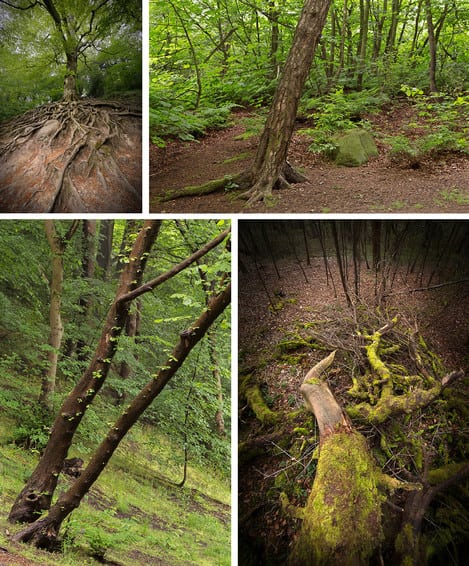
Discovering Edinburgh’s urban woodlands
In the last year, I’ve been discovering some captivating woodlands within the urban area of Edinburgh, Scotland. For multiple reasons, all related to the hectic dynamics of my PhD, I did not have the chance to visit, or even discover, these places. But in the current final phase of my studies, these places have been fundamental for improving my mental and spiritual well-being.
Visiting these woodlands started as an essential need for maintaining a sane self, just that. I, therefore (wrongly) assumed I could not find any real peace or even having a chance to do expressive photography in these woodlands, like those I can find in remote areas of southern Chile, my home country. However, the visits had become something more. Without noticing, I began forging some sort of bond with these local woodlands.
As I developed this special affection for these forests, I remembered a quote from Henry Peach Robinson, of his book “Letters of Landscape Photography” (y.1888). He paraphrases another person, saying: “Each of us is constituted with a special idiosyncrasy related in some mysterious way to a certain class of natural scenery, and when we find ourselves in a scene answering to our idiosyncrasy, the mind feels itself at home there and rapidly attaches itself by affection”.
I don’t know if these four images make justice to the mysterious beauty of these woodlands. I’m not certain if these images can be sufficiently expressive of my emotional responses to the qualities of these areas, and particularly to the peace of them. For now, I just want to honour them for their existence. For now, I know one thing for sure: in these woodlands, my mind feels at home.
North Dakota Storm
I left North Dakota as a teenager to attend the University of Colorado. For a long time, I didn't think much about North Dakota - it was a rural, sparsely populated area in the USA. But as I aged and travelled around the world, I began to recall fond memories of my childhood - the simpler things of life. Now I go back to capture images that touch a memory while growing up in North Dakota.
This past winter, I made several trips back to Bismarck - where I grew up. During one of my trips, there was a typical winter snow storm. I gathered my gear and headed out along the Missouri River bottoms. Typically during a winter snow storm, the wind is blowing so the snow appears to be coming down horizontally. Because visibility is limited, traffic is sparse. A blanket of snow muffles all sounds adding a sense of peace and serenity. During this storm, I captured the solitude of a typical North Dakota winter storm.
Trees of the Marsh
The trees of the marsh always are changing shifting with the light and the seasons. I frequently go to Huntley Meadows Park in Fairfax County Virginia, a wonderful retreat with a lovely lake and marsh.
Most people go to see and photograph the birds I go to see and photograph the trees and other plants living in the water and on the higher ground.
The first sign of spring
Here in The Netherlands I am out walking my dog every day. I have the time to notice the changes in nature as the seasons change. This year after a very long and cold winter, the arrival of green in the woodland where I walk filled me with so much energy. Inspired by the work of Doug Chinnery (and have been lucky enough to attend one of his workshops) I have been experimenting with ICM. Having started with complete abstract ICM, I have found that in woodlands I want my images to look a little different to 'all the other up down ICM images' so I found that by retaining some detail it added interest, but with enough movement to add a feeling.
I find ICM photography to be therapeutic, challenging, rewarding and frustrating all at once! Every time you move your camera, the image is different - that can be wonderfully refreshing, but downright annoying if you are trying to replicate something you have already captured and love. After much practice and experimentation, I have found a set of camera settings that seem to work well for the style I am trying to create. As a 'traditional style' landscape photographer i already understand the importance of light and composition to create the final image, although it took me a while to realise the importance of these in ICM, but now that is stuck as well and it makes a huge difference. For a couple of these images i saw the location, then stood there waiting for the sun to fall just where i wanted it - one very bored dog!
When I find a location that i am inspired by i will return when the lighting and weather are optimal. Looking at images from various shoots at the same location helps me really identify what makes the images I love to stand out from others that are ok but missing something.
These 4 images I created in the Veluwe National Park in The Netherlands in April. For me, the contrast of the bright green of the new leaves against the brown of the trunks is integral to the images. Whether it be branches of the trees or the fresh ground foliage. With a slight camera movement, the bright patches of sun on the floor of the woodland turned to sparkles, which add to the feeling of spring magic.
These 4 images are part of an ongoing study of the woodlands in the Veluwe National park throughout the year.
Reflective photography and the essence of place
Rereading my last article for On Landscape on The Impact of Photography on Impressionism, I was struck by a thought relating to the idea of the essence of place. I wrote there:
One of the features of a successful landscape photograph is that it seems to capture some essential feeling of place. We can often recognize this in a photograph, even if it is of a place we do not know well. As landscape photographers we will often endeavour to encapsulate that essence – the atmosphere, spirit or soul of the place, and our feelings towards it – in a single still image, even if that image is not necessarily as the scene appeared to the photographer in reality.
I have been fortunate to have taken pictures in Mallerstang, the headwater valley of the Cumbrian River Eden, for the last 20 years, albeit as an “off-comer”. So the thought was: what does it mean to have captured the essence of a particular place like this one?
Mallerstang, also known locally as the Magic Valley, lies between Wild Boar Fell to the west and Mallerstang Edge to the east and was made part of the Yorkshire Dales National Park in 2016 (although it has never been in Yorkshire, and before the formation of Cumbria in 1974 was part of Westmoreland). At the head of the valley you can stand on the three way drainage divide between the Eden, which flows north to Carlisle and the Solway firth; the Lune which flows south and west to Lancaster and Morecambe Bay; and the Ure, which flows east down Wensleydale to the Ouse, Humber Estuary and North Sea. It shares the geology of the Yorkshire Dales, with carboniferous limestones, gritstones and shales, but runs north-south rather than east-west, and the geology has been subject to a bit more faulting than some of the other Dales.
Floris van Breugel
Not everything that comes out of America these days concerning the environment is uplifting (the same can be said of many countries) but I hope that our feature with Floris van Breugel will brighten your day. His photographs offer a different perspective on the American landscape that emphasises biodiversity and includes a sense of scale and delicacy while hinting at the epic adventures that may be had there.
Would you like to tell readers a little about yourself – your education, early interests and career to date?
I’ve always had an interest in exploring the outdoors and creating nature related art. At first, that was drawing and painting (birds in particular), and I used photographs from books as source material. That got me interested in eventually taking those images myself, but bird photography (especially 20 years ago) was prohibitively expensive. As digital cameras got better, I eventually did make the transition to photography as my creative outlet.
In the meantime, I studied engineering and did my PhD in control and dynamical systems applied to understand insect behaviour and neurobiology. I am currently a post-doc in biology, data science, and applied math, at the University of Washington, and will be starting as an assistant professor in Mechanical Engineering at the University of Nevada, Reno, next year.
How did you first become interested in photography and what kind of images did you initially set out to make?
I started out with an interest in photographing birds, but quickly gained an interest in a broader range of images like landscapes and abstracts.
Who (photographers, artists or individuals) or what has most inspired you, or driven you forward in your own development as an artist and photographer?
There are too many to name, but two that do stand out are Guy Tal and Marc Adamus, both of whom I’ve been lucky to spend some time with.
I’m also inspired every year by the images in the BBC Wildlife Photographer of the Year, and the European Photographer of the Year awards. Many of the most creative images seem to come out of Europe – they don’t get caught up in big majestic landscapes like we Americans tend to.
Tell us a little more about your local area and the places that you are drawn back to?
I grew up in California and spent winters camping in the deserts (Death Valley), and summers backpacking in the Sierra. These two climates – the deserts and the mountains – have been my favourites that I keep coming back to. I like the stark simplicity, geometric patterns, and strange rock formations of the deserts, and the wilderness feeling of the mountains.
Are you able to devote time to photography on a regular basis or do you mostly make images when you travel or plan longer camping trips?
I wish it were more regular. I mostly make images when I travel or go on longer trips. I have on occasion made images I like near my home, but I usually find it hard to get in the right frame of mind unless I’m out in the wilderness somewhere.
What is, for you, the appeal of landscape photography? How much is down to the outcome (the image) and how much to the experience of wilderness and the sense of adventure?
I like photography in general because it gives me a chance to make art while exploring nature outside. I’ve gravitated mostly towards landscape photography because it doesn’t require as much patience as wildlife photography. I spend a lot of my time exploring – wondering what the view would look like from over there, then going there, getting distracted by something along the way, etc. I find that having a goal of making some kind of image helps motivate me to get out and explore, but once I’m actively out there, I find all sorts of other things that interest me.
There’s often a story behind your images and you often give details about the flora or allude to the science involved. To what extent – and how – does your knowledge and experience as a scientist inform your photography?
I try to combine my photography and scientific background as much as I can. For trips to new places, it means that I am motivated to learn about what I have seen and photographed. Then, when I return, I have new knowledge to help me inspire ideas for new images.
That way I’m not stuck making the same images as myself, or everyone else, every time. Last year I finished up a scientific research project about the alkali flies of Mono Lake and took some time to build a photography portfolio to tell the story, which helped me see Mono Lake in a new way few others have thought about (you can see many of those images here https://www.biographic.com/posts/sto/scuba-flies).
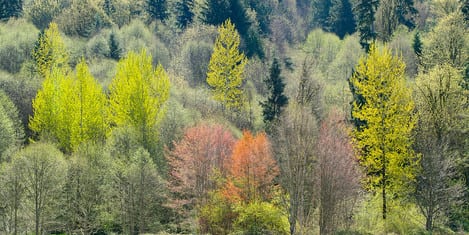 I find the attention you give to the biodiversity of a place particularly interesting. We’re used to seeing the landscapes but it’s wonderful to get a feeling for the richness of flora and fauna, and the way that this changes with the season. What impact do you hope that this will have on the viewer?
I find the attention you give to the biodiversity of a place particularly interesting. We’re used to seeing the landscapes but it’s wonderful to get a feeling for the richness of flora and fauna, and the way that this changes with the season. What impact do you hope that this will have on the viewer?
I always like to include ephemeral accents to my images, like flowers, spring greenery, morning dew, autumn foliage, fresh snowfall, or wildlife. I like the challenge of finding such accents, and I think it lets me show the complex relationships of natural systems.
Aside from the physicality of your adventures, you also suffer from a pollen allergy so I guess it could be said that you really do suffer for your art?
I suppose that’s true. However, I actually find it obnoxious when photographers focus on the suffering they endure. Whenever I feel like I’m suffering, I just think about some of the great historical explorers, like Ernest Shackleton and his crew aboard the Endurance who spent two years self-rescuing from Antarctica. Nothing I, or any photographer I have ever known, has experiences that compare in any way. So, let’s just focus on the beauty and wonder instead.
You often include some small plant in the foreground to emphasise the scale of the mountains (Early Bloomers) or the breadth of the view. It’s a very effective compositional tool and gives the impression that even if you’re not shooting an intimate or abstract view, detail remains important to you. Can you talk a little about the cameras and lenses you like to use and how they influence the images that you make? Has this changed over time?
I currently have a Canon 5D Mark IV, and an assortment of Canon lenses. I mostly use zooms (16-35mm, 24-105mm, 70-200mm, 100-400mm), and also have a few primes (15mm fisheye, 100mm macro, 500mm). My most used lens is probably the 16-35, as it lets me compose wide angle views to incorporate small accents like flowers in the image, but it’s also long enough to work as a somewhat “normal” lens. I try not to let my lens dictate the image – when I see a scene, I choose the lens to fit the scene.
Would you like to choose 2-3 favourite photographs from your own portfolio and tell us a little about why they are special to you?
It’s very hard to choose favourites! I like a lot of my images for very different reasons. But, I’ll choose three that illustrate some of the components I strive for in my images.
This is one of my oldest photographs, from Sequoia National Park in the spring of 2008. These trees are so incredibly huge it’s impossible to describe the experience of being among them, and getting the scale to come across in a flat image is very hard. I was really lucky on this afternoon to capture two mule deer in the meadow. That fact that the deer are so small and inconsequential really makes the image for me. In addition to the deer, I really like the warm afternoon sunshine, which adds a lot of depth. Making effective images with direct sunlight, especially in a forest, is challenging, but I find that when it works, it works so much better than flat light. There is just more life, depth, and colour.
I love photographing strange things and patterns that make you wonder and question what it is that you’re looking at. These flowers are one example of such a scene. The density of flowers was just perfect, and the contrast between the yellow stalks, purple flower tips, and white buds, keeps me coming back time and time again.
I think this snow storm scene might be one of my most creative images, and it highlights how I really enjoy playing with light to create a dynamic image. Here I used my headlamp to illuminate the snow forest and falling snowflakes for a few minutes. I haven’t done much light painting like this recently… I should give it another go sometime!
What part does processing/editing play in realising your vision? Can you give readers an insight into your workflow?
Processing is certainly a big part of making my images come to life. It’s gotten a lot easier over the past decade, and now I can get 90% of the way there just processing the raw image in Adobe Camera Raw. The main adjustments I’ll make are balancing the shadows and highlights and getting the colours to where I want them. Then I’ll make some localised adjustments in Photoshop. I really like adding some extra warmth to the highlights of my images, especially ones that feature direct sunshine. I find this adds a little extra depth.
How important a part of the process for you is printing an image and what, for you, makes a good print?
I spent a lot of time learning to print early on and used to have my own printer for making prints. But, as life got busier, I decided that printing was not as important to me as making images and processing them. Since I know what paper I like, and I use a calibrated workflow, I trust others with calibrated printers to do a good job. I do still have a small printer and will sometimes make a test print if I’m not quite sure how something will come out.
Do you have any particular projects or ambitions for the future or themes that you would like to explore further?
Many years ago I photographed the synchronous fireflies in Tennessee, and I would love to revisit that both photographically and scientifically. In general, non-traditional light sources like that are really intriguing to me.
I read that you’ll be moving from Seattle to Reno next year – how might this alter things for you photographically in terms of the places that you’ll have access to or the amount of time you’ll be able to devote to your interests?
In terms of locations, I can’t think of a much better spot for my interests, so I consider myself lucky to end up there. I’ll be right next to the Sierra Nevada and the Eastern deserts, two of my favourite places. Plus, I’ll still be within a long but reasonable drive from the southwest and northwest. I will miss the wild coastlines of the Olympic Peninsula, and the ruggedness of the Cascades, but it’s a sacrifice I’m okay with. As far as time, unfortunately, I will probably have less time as a new faculty member at the university, but I hope to continue finding ways to combine my research with photography as a tool for outreach.
If you had to take a break from all things photographic for a week, what would you end up doing? (i.e. do you have other hobbies or interests)
Recently I’ve gotten interested in woodworking. I’m currently finishing my 3rd piece, a live edge coffee table made from four slabs of black walnut. It’s nice to learn something completely different, very practical, and that I can work on without having to drive a few hours.
What was the last image (by another photographer) that stopped you in your tracks?
This image simple blows my mind: http://www.patrikbartuska.com/?photo&id=89
Is there someone whose photography you especially admire that we may not have heard of and whose work you would like to see featured in a future issue?
Theo Bosboom consistently produces create images of scenes many of us would walk right past.
Thanks very much, Floris – I’m sure readers will enjoy looking through your images which benefit from being seen large as there’s a wonderful emphasis on light, season and texture. You can find more of Floris’ photography on his website https://www.artinnaturephotography.com/
And as we too enjoy Theo Bosboom’s images you can read the interview that we did with him here: https://www.onlandscape.co.uk/2015/09/theo-bosboom/
Yan Preston – Photographic Projects
In 2005, with my immigration from China to the UK, I committed to my wildest dream - to change my career from an anaesthetist to a photographer. I still remember the accelerating excitement at the time as well as the disbelief when someone referred me as a photographer. I was doing my first-ever assignment, shooting photos of four beautiful horses on the moors near Oldham.
Thirteen years on, my life now is certainly evolving around photography - projects, shows, publications and commissions. Out of the many projects I tried, most were abandoned for one reason or another. But some stuck around and demanded everything from me. For example, between 2010 and 2014, for my ‘Mother River’ project, I photographed the entire 6,211km Yangtze River in China at precise 100 intervals with a large-format film camera. From 2010 to 2017, I investigated urban replantation and ecology recovery in China by photographing transplanted old trees. This year, I’m publishing both projects with Hatje Cantz. Meanwhile, it is time to reflect. Why projects?
Although I never asked the question, now it seems a fitting time to answer it. Projects, for me, are long-term engagement with a given subject. It is a project because it can’t be worked out in one go. There is something complicated enough that it needs to be explored from all angles. Only then can I draw an understanding which will then direct my photography (shooting, editing or presenting). Let’s take Mother River as an example — one would not easily commit to such a punishing project without thinking about it a lot.
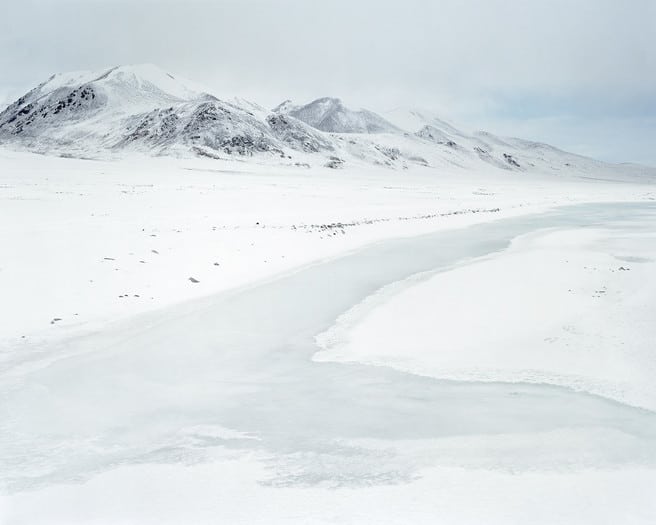
Y2 100km from the river source. 16 Nov 2013. From Mother River series (2010-2014) by Yan Wang Preston.
The Yangtze River is seen as the Mother River in China. It is the absolute national icon, with its images printed on our money, written in poems, sung in songs, and built-in as part of the enduring folklore, myths, legends and television adverts. As a native Chinese person, I regarded it as my own Mother River and the symbol of my motherland. It is part of my national and personal identity.
In 2009, after four years living in the UK, I was going through a kind of identity crisis. I needed to go back to China and to re-connect. The Yangtze was a popular topic then, with its Three Gorges Dam being filled up. A wave of photographers went to make work about the dam, the river and China. I remember seeing images by Edward Burtynsky and Nadav Kander. Rather than impressed, I felt confused. Why were they so different from the Mother River images that I had in my mind? Meanwhile, why only the Three Gorges? They are less than 200km long and the Yangtze River is over 6,000 kilometres. If someone really claims to have portrayed China through photographing the Yangtze River, surely he/she needs to go a bit further than that? I started brewing a tiny idea in my mind: what about going back to photograph the Yangtze, the whole of it? Since everyone was going to the hot spots on the river, shall I try something different, for example, photographing the entire river with some kind of equal intervals so I could avoid all those popular destinations?
This idea was exciting but also scary. The Yangtze is big. So I started preparing for it. I photographed our sweet River Ribble with a trial Point System. Having divided the 121.6km river into eight 15.2km sections on Ordnance Survey map, I found and photographed each point. It was a very interesting experience! I came to an understanding that this way of photographing was very fun. It was like playing a hide-and-seek game with the river. I also realised that this system was not about being ‘objective’. After all, there was no ‘exact’ location to find since all data precision was relative. Meanwhile, my interpretation of both the location and the view was by default subjective.
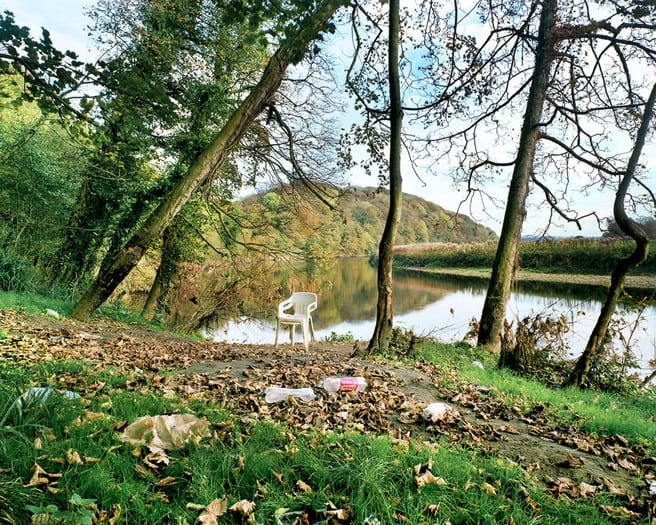
River Ribble Point 7 91.2km from the river source. From River Ribble series (2009-2010) by Yan Wang Preston.
The Ribble is about one fiftieth of the Yangtze in terms of length. In order to lock myself into a system, I got my family’s support and enrolled on a PhD in Photography course at the end of 2010. My proposal was to photograph the Yangtze River with equal intervals. But I couldn’t answer exactly why, how, or what it would mean to do so. Little did I know how epic the next few years would be. I would have to do experiments and research.
In November 2010 I made my first trip to the Three Gorges on the Yangtze. I found the area a world of destruction, just as how Burtynsky had photographed it. This was devastating. Remember, the Yangtze was more than just a river to me. It was a symbol of my perfect motherland. I could not understand the world in front of me, and I felt that I could not see the river. This was absurd, since the river was right there! Consequently, this trip provided one of the most crucial questions for the next few years. Why is there such a big difference between the Mother River in my mind and the reality? And crucially, where did I get all those ideas of the Mother River from? What does the Yangtze mean to me? Why did I refuse to accept it as merely an environmental victim?
In March 2011 for my second trip, I spent one month doing a residency in Chongqing, a mega city sitting on the Yangtze with 30 million people. I had time to visit the river casually everyday. Despite the banal riverscape and the overpowering skyscrapers along its banks, a world of life began to emerge. There was fisherman, vegetable farms, tadpoles, swallows, butterflies and families. Perhaps the river was not as dead as how they were saying. But I still was not satisfied. I decided to do an expedition. To go to the source of the Yangtze River. Hopefully over there, 5,400 meters above the sea level deep into the Tibetan Plateau, I would have no distraction but only the Mother River. On the 16th November 2011, after an exhausting and painful expedition, I finally reached the home of the Yangtze. It was white out. So bright that I could barely open my eyes. But the view was so perfect for the Mother River in my mind. Pure. Grand. I made several pictures of only one view. That was enough.
On my way back I indulged more action. Seeing the river was not enough. I wanted to touch it. So I found a perfect spot (in terms of the landscape backdrop) and made a stone circle on the frozen river. River stones are symbolic in China, representing the gentle but persistent power of water. I held the stones for 10 seconds each in order to symbolically connect with the river’s power. I then made a landscape picture on my large-format camera. I went even further to make a red circle on the river, with my bare hands. That was an immersive experience!
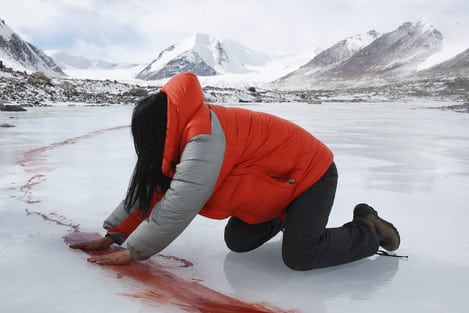
Making a red circle on the frozen Yangtze River headwater. 19 Nov 2011.
From Yuan series (2011) by Yan Wang Preston.
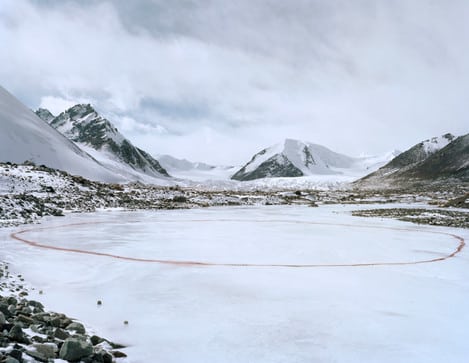
A red, hand-drawn circle on the frozen Yangtze River headwater. 19 Nov 2011. From Yuan series (2011) by Yan Wang Preston.
In August 2012, for my fourth field trip, I decided to push further with this idea of having an embodied engagement with the river. But instead of holding and cherishing stones, I wanted to ‘destroy’ them. I went to Yushu, a Tibetan town, and carved 127 stones before leaving in the rive forever. The chosen location was very different this time —-a completely banal and industrial spot.
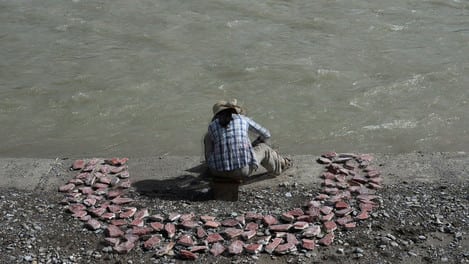
Carving 127 stones by a Yangtze tributary. August 2012. From Yuan series (2011) by Yan Wang Preston.
In the same month, I did the final ‘embodiment’——to swim in the river. Then I came home to West Yorkshire and reflected hard. I digested my own experiences, but also read and researched a lot. An important question was the environmental concerns about the Yangtze. So many people saw it as a victim and saw modern China as a traitor towards its traditional values. However, environmental historians provided another vision of traditional China. For example, according to Elvin (2006), the 18th century China’s environmental degradation was far worse than western Europe at the time! This discovery had a direct impact on my pictorial strategy. I decided not to make misty mounatin-and-water type of pictures. I did not want to fall into the trap to place modern and traditional China in binary.
Meanwhile, I looked at many photographers work, such as Thomas Joshua Cooper, Kate Mellor, Jem Southam, Stephen Shore, Joel Sternfeld, Ai Weiwei, Xu Bing and Zhuanghui. I remember one day I came to a sudden realisation while writing about Sternfeld’s work. Yangtze, as The Mother River, was mythic! In China, it was routinely represented by celebratory images of very few selected places, such as the Three Gorges. Outside of China, it had the added critical representation, but still centred around the Three Gorges. But the river, as how I had found it in my last four trips covering many locations, was far more complex than these two opposing views. It was about life and the ordinary, multilayered landscape created by us and the river together. That was what I was going to photograph!
In 2013, I committed to the idea of photographing the entire 6,211km Yangtze River at precise 100km intervals. In March, I made the major pilot trip and photographed from Y9 to Y25. In June, Y25 to Y38. From September to October I travelled from Y39 to Y62, only to discover that I loaded the films back to front in the whole of these two months! I reshot from Y52 to Y62 immediately before going back to the Tibetan Plateau to photograph from Y4 to Y8. (I already photographed Y1, Y2 and Y3 in 2011.) Then on the 16th November 2013, exactly two years after I reached the source of the river, I stood in the water at the river mouth and made the last shot. But the game was not over yet. In May 2014, while being 5 months pregnant with my daughter, I made one last trip to re-shoot from Y39 to Y51. Meanwhile, for many reasons, I missed two Y15 and Y16, so we now have two blank pages in the picture sequence.
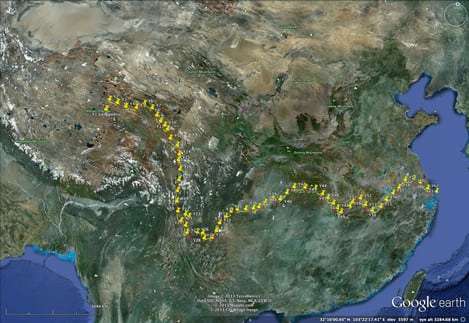
The Y Points as how they were marked on Google Earth. These provided the initial GPS coordinates and locations maps for my following trips.
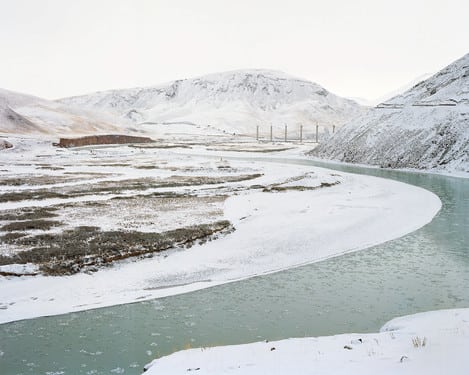
Y8 700km from the river source. 11 Nov 2011. From Mother River series (2010-2014) by Yan Wang Preston.
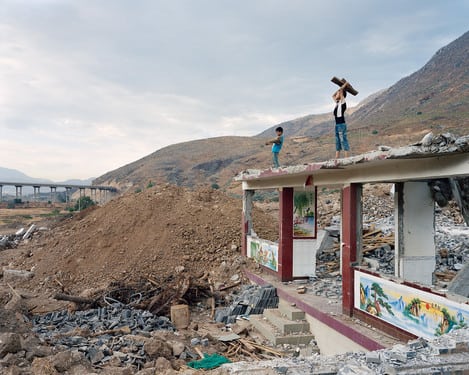
Y25 2,400km from the river source. 5 Jun 2013. From Mother River series (2010-2014) by Yan Wang Preston.
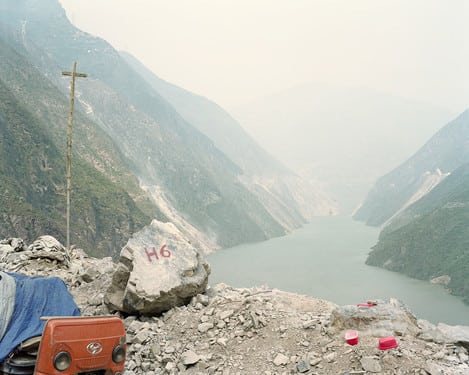
Y32 3,100km from the river source. 16 Jun 2013. From Mother River series (2010-2014) by Yan Wang Preston.
The trips were designed according to seasons, geology, and the safety of travels. For example, the headwater area is a whole bogland in the summer, impossible to travel by car. It would have been extremely difficult to reach my first 10 Y Points in the summer. November is the window season, when the land is just frozen enough to travel with relative ease (well, it’s suffering really, with low oxygen, low temperature, sandstorm, snow, ice and a lot of anxiety). In deep winter, the land would be covered in thick snow, making travel impossible too. The next thirty Y Points go through gorges as deep as 3,000 meters, so I needed a dry season to avoid any wet and slippery condition. After Y38 in Chongqing, the Yangtze enters the Three Gorges with dense population, the travel gets easier but photography gets harder. Too many elements!
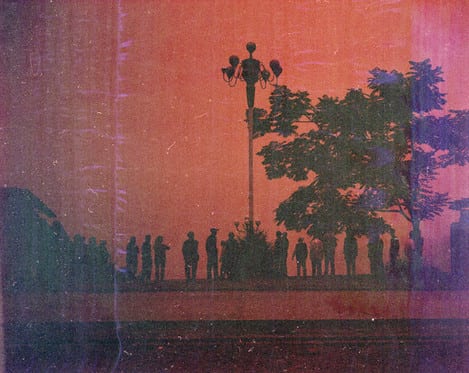
Y41 4,000km from the river source. 16 Jun 2013. Film loaded back-to-front by accident.
From Mother River series (2010-2014) by Yan Wang Preston.
Mother River was completed in 2014. Since then it has won awards and been shown in many venues such as the 56th Venice Biennale, Chongqing China Three Gorges Museum, Gallery of Photography Ireland and Impressions Gallery. (You can visit my website www.yanwangpreston.com to see all the pictures and exhibition installation images). But the game is not over yet. I’m still yet to publish the book as the ultimate legacy of the project. This is again a monumental effort. For the quality and size of the book that I want to make, a lot of money is needed. I decided to launch a Kickstarter campaign, partly to raise funds, partly to offer this amazing journey to my backers. There is still time to pledge (until 30th June) and the link is here: http://kck.st/2L8WCyM
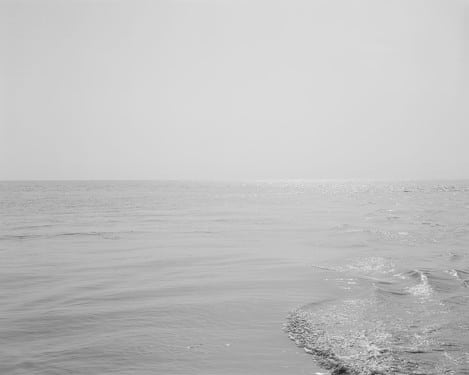
Y63 6,200km from the river source. The river mouth. 16 Nov 2013.
From Mother River series (2010-2014) by Yan Wang Preston.
I’m pretty certain that not all projects are as hard as Mother River. Looking back, it was questions, curiosity, and obsession that took me through the process. The actual doing was more to do with pain, tears, dust, sweat, and the occasional blood. But I have learnt so much from doing it. It was like jumping into an ocean and try to swim towards an unknown shore on the other side. If you’re open-minded and give yourself to it, there will be reward. But ultimately, the reward is the experience, knowledge and skills that you gain in the process.
Thanks to Yan Preston for this look into her Mother River project and the thinking behind the work. You can read more about Yan's work in the interview we made with her last year (here) and we look forward to seeing the final result from Hatje Kantz!
Liquid photography
I recently read an essay by Luciano Concheiro, called "Contra el Tiempo" (Against time), where he mentions something we all know, but that needs to be put under the limelight from time to time:
If I were forced to identify one feature that defines the age, I wouldn’t hesitate for a second: I would choose ‘acceleration’. That is the phenomenon that largely governs how economics, politics, social relationships, our bodies and minds now work. The increase in speed is the prism through which, without relying on reductionist perspectives, we can see —and maybe understand– better the world in which we live in today.
This text reminded me of the theories developed by the Polish sociologist Zygmunt Bauman, and particularly about his concept of "liquid modernity", that he coined to define the new constant and incessant changes taking place nowadays in the major foundations of society, traditions, economy and politics. What he saw as the major trait of our modern times (or post-modernity) was the quick, incessant and accelerating change taking place all around, that demolished, without proposing solid alternatives, the pillars that for centuries had helped us create a sense of order and the moral, intellectual and spiritual foundations on which to build our own identity. With the quick dissolution of long established solid values into a shapeless bubbling soup, "constructing a durable identity that coheres over time and space becomes increasingly impossible". According to Bauman, "we have moved from a period where we understood ourselves as “pilgrims” in search of deeper meaning to one where we act as “tourists” in search of multiple but fleeting social experiences".
I could not avoid making a direct connection with landscape photography when reading this last sentence, particularly when tourism nowadays frequently translates into the realization of a series of selfies in a number of prescribed locations and their distribution in so-called "social" channels. Indeed, when it comes to photography, this same fast paced culture of immediacy, speed and acceleration have also shaped not only the way we photograph but also the way we consume photography and the motivations and aspirations we have of the medium when we embrace it. In a way, the liquid modernity seems to also have attained photography, making it as liquid as a bath of Rodinal, and this, at different levels.
Norfolk
Norfolk and parts of Suffolk have been my home for periods totalling over thirty years. In that time, the population has risen dramatically as the popularity of both has grown. There were times when there were beaches and parts of the countryside that were empty of all, bar those who were ‘in the know’. Despite this growth, there are still areas where you can wander, be alone with your camera to find some solitude. It is these areas that I try and photograph.
The essence of landscape photography in these areas, and in particular Norfolk, for me is waiting for light that transforms these particular landscapes throughout the seasons. Many people associate Norfolk with a boring flatness, quaint old windmills and big skies. This view usually derives from a limited understanding of this large county situated in the east of England. The landscapes are in fact much more varied and much more exciting for any landscape photographer who takes the time to look and explore and who doesn't just want the classic wind pump shot with the sun setting behind it.
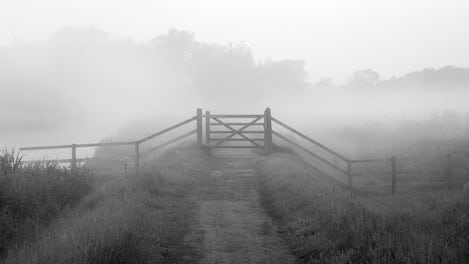 The Norfolk coastline is dynamic, changing slowly over time but also sometimes very dramatically and quickly. The cliffs at Hemsby on the north-east coast are a prime example of rapid change as large sections have completely fallen into the sea almost overnight. The Broads, by contrast, formed by the flooding of peat pits, joined by intersecting and meandering rivers, provide a gentle under-stated atmosphere.
The Norfolk coastline is dynamic, changing slowly over time but also sometimes very dramatically and quickly. The cliffs at Hemsby on the north-east coast are a prime example of rapid change as large sections have completely fallen into the sea almost overnight. The Broads, by contrast, formed by the flooding of peat pits, joined by intersecting and meandering rivers, provide a gentle under-stated atmosphere.
The quality of the light can change dramatically depending on weather conditions and seasons. Autumn, spring and summer mists frequently cloak the Broadland rivers. These provide for some transient and quite magical landscape photography opportunities which require gentle and subtle processing in order to capture the real feel of the landscape. Bordering these slow flowing rivers are habitats of reeds and grasses which sink their roots into the peat below. From a distance, these look fragile and brittle which belies the hidden strength of this vegetation. There’s a reason that Norfolk thatch for roofs is still being made from Norfolk reed. In the very early dawns of June, before the pleasure boats begin to travel up and down the rivers, this habitat is also abundant with silver thread spider webs glistening with dew coating the spider silk.
For photographers who don't want to carry a huge pack of equipment, a good 24-70mm lens or equivalent with a few key filters such as a medium 0.9 Lee grad and a 0.45 hard grad can capture a variety of scenes along the broads with ease. I use a Nikon 810 and a Fuji XT2 with a 16-55 mm lens. Both equally do a great job.
The often over-looked north-east coast is ideal for capturing dawn’s first rays as these beaches are some of the most easterly in England. Beaches such as at Overstrand and at Mundesley beach with its distinctive timber groins reaching far out into the sea provide many opportunities to experiment with different captures of the sea complemented by the sometimes pastel, or more dramatic colours of dawn skies. Long exposures can be particularly effective in this situation. The cliffs along this northeast coast, made up of glacial silts, sands, clays and gravels are highly vulnerable to coastal erosion by the North Sea. Nevertheless, these provide the photographer with a range of textures, patterns and forms to work within a landscape composition. You will probably also find that along this area of the coast, you are less likely to have to fight your corner with another ten photographers, unlike at some other iconic locations in the UK. Areas such as these do make the photographer work hard and sometimes break the ‘rules’ of photography to create an individualistic shot. It takes planning and sometimes a few return visits to get the shot as there are no dramatic mountains or valleys waiting for you. It is, however, worth the time and the experience of being often alone, and is something I cherish. When I am out here, I look for patterns and textures in the skies which will complement the simplicity of aspects like groins and shingle beaches.
The North Norfolk coast, by contrast, is well known and well shot, often in locations that require only a short walk from your parked car, for example, Burnham Overy, Brancaster Staithe and Thornham. These are beautiful locations and well worth a visit if you haven't been. However, there is a lot more to the North Norfolk coast than just a sailing boat in a muddy creek. It is worth making the moderate to long walks out to the coastline which has remained unspoilt because of sand and shingle beaches separated by intertidal mud flats and salt marshes- so no building possible on here to date! The coastal marshes have been described as the finest coastal marshes in Britain. These change in terms of height, colour and texture and are interspersed with creaks and salt pans giving a variety of tone and character. This provides the photographer with a plethora of opportunities to photograph minimalistic detail, abstract impressions and large open vistas.
 For those who want to capture some vivid colour in their landscape then make sure to visit in July when the sea lavender is a haze of purples and mauves. The miles of sand dunes after the salt marshes are home to marram grasses which again can be a real playground for any landscape photographer as they can be the foreground, the centre or the backdrop for your coastal shot. Occasionally you may be lucky enough to catch some of the very high tides along this coast which literally flood the carparks and roads that you drove on the day before. When this happens, the area is transformed and is reminiscent of 17th century Flemish landscape paintings full of small wooden jetties and fishing boats underneath textured skies.
For those who want to capture some vivid colour in their landscape then make sure to visit in July when the sea lavender is a haze of purples and mauves. The miles of sand dunes after the salt marshes are home to marram grasses which again can be a real playground for any landscape photographer as they can be the foreground, the centre or the backdrop for your coastal shot. Occasionally you may be lucky enough to catch some of the very high tides along this coast which literally flood the carparks and roads that you drove on the day before. When this happens, the area is transformed and is reminiscent of 17th century Flemish landscape paintings full of small wooden jetties and fishing boats underneath textured skies.
More than ever before, everyone is able to take a photograph. Social media sites literally overflow with millions of photos posted daily. I am not going to criticise those that want to record and maybe revisit places they have been and share these with others. But I do think that the essence of an engaging landscape photo and what sets serious landscape photography apart from ‘snaps’, is a photo that makes the viewer look again, examine in detail and more importantly conveys an emotive element within the photo. Many of the photos I have shot in Norfolk are simply composed and contain a limited range of colours and hues (apart from the full-on sea lavender sunset ones which there is a place for, even though perhaps at present not fashionable!). This I believe conveys the outstanding elemental beauty of Norfolk. The photos I have included in this article have been shot inland, on The Broads and on the North East and North Norfolk coast throughout the year.
Later this year my work will be exhibited at Aldeburgh Gallery http://aldeburghgallery.co.uk/ Suffolk where I will be focusing on the ‘elemental’ in the landscape.
Unique Photography Collaboration
Explaining the light is always the hardest thing to teach as a workshop leader. Interpreting it as a photographer is even more difficult. But there’s safety in numbers. There’s strength in unity, and depth can be achieved if we commit to an idea. If we bind together and unite behind a concept, the sum of the parts is always much greater.
Cooperation, commitment, reaching out to a wider community is what drives the IrishLight Collection concept. The setting is the Irish landscape, but we very much consider this an international idea inspired by the worldwide community we see on our workshops, in magazines, online and at exhibitions.
From a personal perspective, I am an artist, a photographer, an organiser within the community, and a workshop leader. I run the IrishLight photography festival amongst other photography related activities.
As a workshops leader, I have been exposed to the amazing talent and dedication that exists in the landscape photography community. I always felt there was something that could be harnessed. Raw energy, commitment, obsession. IrishLight draws on these ideas, bringing workshop outcomes and images to a wider audience, for a wider purpose.
The Concept
Teams of photographers attend various workshops located around Ireland, led by Ireland’s foremost landscape professionals, shooting different locations simultaneously under one unifying theme.
The aim, a beautifully crafted hardback book plus exhibition showing the light unfold. A genuine timeline and unique collection of images created by the workshop participants. Profits from the book sale and exhibition in aid of charity.
2016 – A Beginning
The first time we brought this concept to fruition was in 2016. We started big and decided to tap into Ireland’s most recognizable landscape resource, ‘The Wild Atlantic Way’. A stretch of road that runs along Ireland’s west coast taking in some of the most dramatic scenery Ireland has to offer.
We ran simultaneous workshops with 32 participants stretching all the way from Donegal in the North, to Cork in the South. It was fascinating to see the results. Being able to actually measure and observe how different the light could be in locations just 100 miles apart. There’s a reason for the ‘Wild’ in “Wild Atlantic Way’. The weather is unpredictable, varied and often dramatic. Just how us landscape snappers like it. Anyone for clear blue skies? No Thanks!
2017 – Making it Happen
Since 2017 we have successfully published the first IrishLight collection in book and exhibition format, raising vital money for our charity partner the Samaritans, we have shot ‘The Island’, where our participants we’re located on remote islands off the Irish coast, to be published September 2018, and we have brought out a brand new concept for the IrishLight programme 2018. Phew, that’s it, it’s been busy!
2018 – Whats Happening This Year!
Roll on 2018 we will once again have all participating photographers
out shooting different landscapes simultaneously under one unifying theme.
The theme for this year's workshops/exhibition/book is:
Rebels and Kings - September 27th - 30th
All workshops will be based in Cork and Kerry. The Rebel County and the Kingdom. Some of the finest scenery in Ireland seems to warrant a detailed study and we think it will make for a fantastic project. Signing off with some images from our workshop leaders from locations that will be visited as part of this year's event.
Find out more about IrishLight at irishlight.ie.
Photography, Chance and Solitude
Critics of landscape photography, and there are many, argue that it romantically pedals a dangerous myth that the natural environment is an unspoilt, Garden of Eden and that it adheres to outdated philosophical and aesthetic models such as The Sublime and The Picturesque. Undoubtedly this can indeed be found in some ways of working, but it is a gross simplification to assume that all landscape work is rooted in these traditions.
In 1966 John Szarkowski Director of Photography at the Museum of Modern Art in New York, made a significant contribution to the critical discussion of photography in general, with the publication of the book entitled The Photographers Eye.
Writing at a time when the medium was still struggling to be taken seriously within the art world, Szarkowski hoped that the book would “…contribute to the formulation of a vocabulary and a critical perspective more fully responsive to the unique phenomena of photography”.
Having recently visited the Andreas Gursky retrospective exhibition at the Hayward Gallery, in London, it occurred to me that viewers could be left with no doubt whatsoever that photography as a medium has come a very long way indeed since the publication of Szarkowski’s book. In addition, anyone that scratches the surface of contemporary photographic criticism in an attempt to learn more about this fascinating medium could be forgiven for thinking that perhaps less ‘vocabulary’ might now be something of an issue.
In The Photographers Eye, Szarkowski outlines what are for him, five key characteristics of photography, that mark it out as being unique among media; these are The Thing Itself, The Detail, The Frame, Time and Vantage Point. Clearly all of these key characteristics are worthy of much consideration, however, it is perhaps The Thing Itself that might be of particular interest to the landscape photographer.
By this I mean that unlike other ways of making images, photography has an umbilical link to the real world; to ‘The Thing Itself’, to that river, that tree, to that sky at that moment, on that day; Without the landscape itself, the landscape photographer is nothing. Szarkowski is right when he says that “Photography deals with the actual; the photographer must not only accept this fact but treasure it; unless he does, photography will defeat him.’
This, of course, can be said of all photography – as we need ‘things’ to photograph, whereas musicians and painters can conjure up images and evocations of both places and events without the need to travel any further than their studios. This is, thankfully, beyond photography, and is, therefore, a defining aspect of this fascinating and often frustrating medium of ours; in short, we need to get out!
The term landscape photography is broad, and once we begin to explore it, we find there are many different approaches:
For many, the aim is the description. Indeed, the camera has multiple functions in our everyday lives that go far beyond the boundaries of art, from NASA satellites to police speed cameras, from what we buy and sell online to our passports and family albums etc. All of these things testify to photography’s unsurpassed and extremely accurate ability to describe the world. The often favoured large format film camera provides detail (another of Szarkowski’s key characteristics) in abundance, as does any decent RAW file, and this technical clarity of vision for many never fails to fascinate.
However, while it is true to say that for some photographers it is enough to produce a clear and accurate description of a place visited, and to enjoy developing the associated technical skills in order to achieve this, I believe that for most landscape photographers, description is not the only aim. I suspect that the majority of landscape photographers attempt to communicate something of the subjective, lived experience, or encounter with a place.
With my own work, I am less concerned with description. My current projects LOCUS and Elsewhere form an ongoing exploration of both the solitude and sense of intoxication experienced when time is spent alone in a rural environment. All of the images use multiple exposure to sidestep what I call the blunt instrument of description, to create a more complex, visual experience that evokes the curious and visceral sensation of being alone. Perhaps the word synergy opens up a way of articulating this idea:
Synergy: The interaction or cooperation of two or more organisations, substances, or other agents [exposures] to produce a combined effect greater than the sum of their separate effects.
There are two separate lives to a photographic image, the time that the exposure is made, and the time that the print is made. Both are vital, yet very different. For me, as described above, the former can be an overwhelmingly sensual and intoxicating experience. The land (and the necessary camera equipment) can be physically demanding; My blood rushes a little quicker; I look and listen keenly to everything around me; I smell the land changing through the seasons. I find myself totally absorbed in the moment, often losing track of time completely. Analogue, rather than digital helps here because there is no screen on the back of the camera to immediately review an image once it has been made, allowing me to remain in the present, and sustain what are often intense experiential encounters with the land.
The process of reviewing images that have been made in this way is a completely different thing altogether. Using film to create multiple exposures produces images that don’t exist in the ‘real world’. The technique often generates very busy and complex images that have a large element of chance: one exposure sutures with another, highlights filling in shadows, obscuring details, colliding to create new places. What I look for when reviewing the images is for something that resonates with or evokes something of the sense of ‘being there’, of being alone for a long time, quiet, and utterly lost in thought.
Whichever type of landscape photography you favour, understanding what you like about the medium and the process and what it can achieve will enhance your understanding and your pictures and appreciating that there is more than one way to approach landscape can only add to our understanding and appreciation of this genre.
Issue 161 PDF
Capture One for Landscape – Part Two
In our second and third instalments of our Capture One for Landscape series, Joe looks at a few of his images from a recent trip to the Isle of Eigg in the Scottish Inner Hebrides. Along the way, he will be demonstrating some of the steps in his typical workflow and also his approach to post-processing images. (Watch Episode One here)
If you have any questions about the video or general questions about Capture One, please add them in the comments below.
- Before
- After
End frame: The Arctic National Wildlife Refuge, Alaska (2009) ~ Sebastiao Salgado
There are not many photos that will make you look so stunned that you remain in mute amusement and you have to keep coming back to them even after a long time. Something like that happened to me at the photograph from Genesis's book by Brazilian photographer Sebastiao Salgado.
Salgado was born in Aimorés, 1944, in the state of Minas Gerais, Brazil. He began to work as an economist, often travelling to Africa on missions for the World Bank. He switched to photography in 1973 and in 1979 he joined the international cooperative of photographers in Magnum Photos. He is particularly noted for his social documentary photography of workers in less developed nations and he has been a UNICEF Goodwill Ambassador since 2001. Salgado works on long term, self-assigned projects many of which have been published as books – at least that describes Wikipedia.
His story touches me personally and I find many parallels for him. I also got to photography as a second subject, and I work on my defined and long-term projects. In my photographic beginnings, most of my photos have been shot in black and white, and I have stayed there for some time after switching to digital photography. Black and white photography has enormous charm and is not as loud as colour photographs. The spectator can concentrate better on the shot. Missing colourfulness enhances the viewer's imagination, and if the shot succeeds, the resulting work is a thrilling experience - not just because of the technique and processing of the shot, but also because it has a huge imaginative potential inside of it.
His project Genesis consists of a series of photographs of landscapes and wildlife, as well as of human communities that continue to live in accordance with their ancestral traditions and cultures. The project is conceived as a potential path to humanity’s rediscovery of itself in nature. While looking at this picture you have exactly this deep feeling. A deep valley, where the river is cut into the bottom and flows somewhere in the distance where awake elements are waiting for it. You can feel the depth and breadth of the valley, its old age as if it were from time immemorial as if we were looking at the moment of the birth of our planet. It is as if the ancient and mighty forces of nature still prevailed in their original form. The whole book of Genesis will give you such feelings. The visitor's feelings in the huge gallery of nature. You are looking at the works of the greatest masters, admiring the gentle yet energetic brush strokes or sculptures created by wind, frost and water.
Having dedicated so much time, energy, and passion to the making of this work, Salgado calls GENESIS “my love letter to the planet.”
And what is the outcome from it for me or for the other photographers?
Salgado worked on his project for 8 years - this is pretty long, isn’t it? But isn’t it also right? Ansel Adams once said it was important to return to one place repeatedly. For me, I would add that this is true not only physically but also virtually. It is important to return not only to the same place but to persist in one topic for as long as it is finished. Whether it's a big project like Genesis or perhaps a landscape around a small lake. This also includes the subject of the project as such. Much has been said and written about the photo being created in the photographer's head long before the camera trigger is pushed. It does not mean just how I think of a specific shot, but also what experiences, models, and stimuli we are gradually collecting. Salgado has been working on projects that have been related to the environment and the human community for years. There is nothing more beautiful and uplifting than when I can gradually fulfil the chosen theme with my work.
Salgado’s work for me is not only a show of amazing talent for scene selection and general processing of a large topic into one project, but also a demonstration of great technical work, simply a photographic craft. Whenever I look at his book in peace and with a glass of good wine I realise that nothing is free and that I must never forget the hours of work on self-improvement of my own skills. Who would not want to achieve similar artistic and technical self-esteem and lightness? And all at once underlined by the pure rendering of shapes, contrasts and the story in black and white. Simply beautiful!
Subscribers 4×4 Portfolios
Welcome to our 4x4 feature which is a set of four mini landscape photography portfolios submitted from our subscribers. Each portfolios consisting of four images related in some way. You can view previous 4x4 portfolios here.
Submit Your 4x4 Portfolio
We're on the lookout for new portfolios for the next few issues, so please do get in touch!
If you would like to submit your 4x4 portfolio, please visit this page for submission information.
Clayton Hairs
Intimate Australia
Daniel Howarth
Woodland Seasons
Helen Storer
Blue hour at Brancaster Staithe, Norfolk
Roman Gieruć
Just breathe

